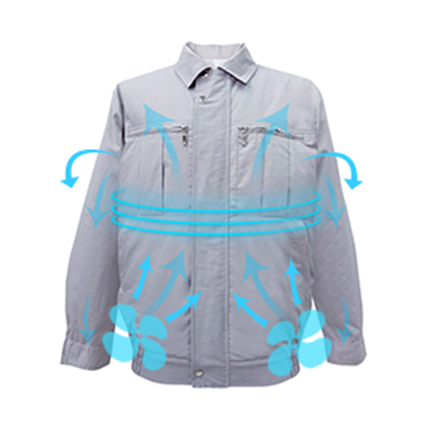
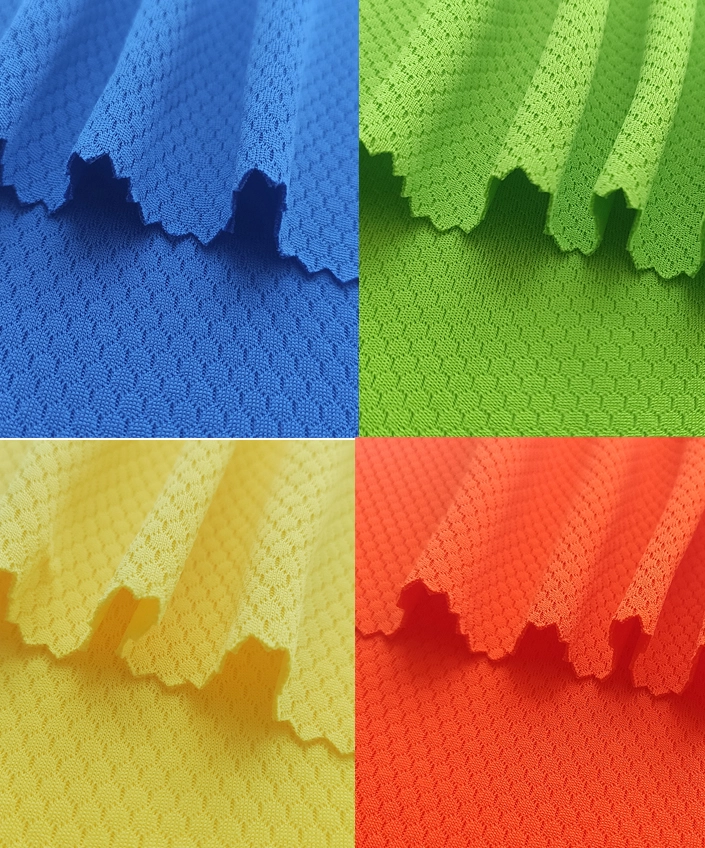
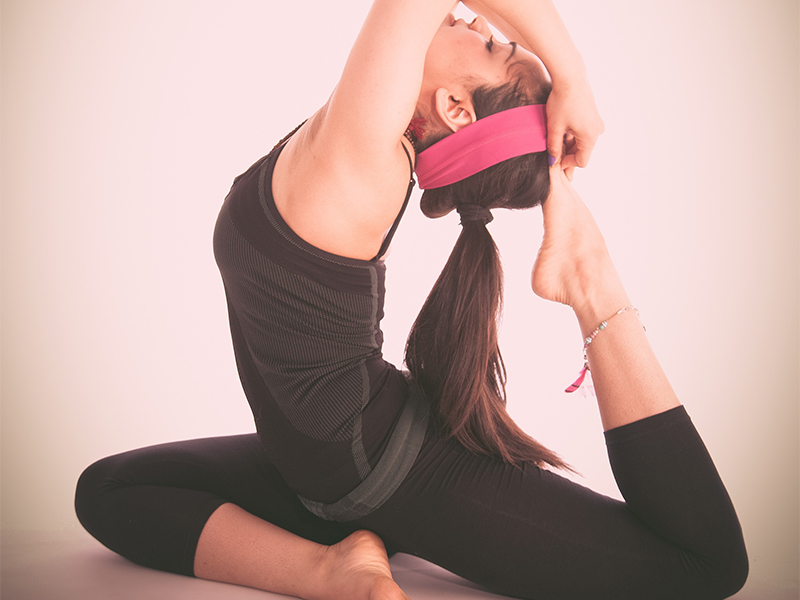

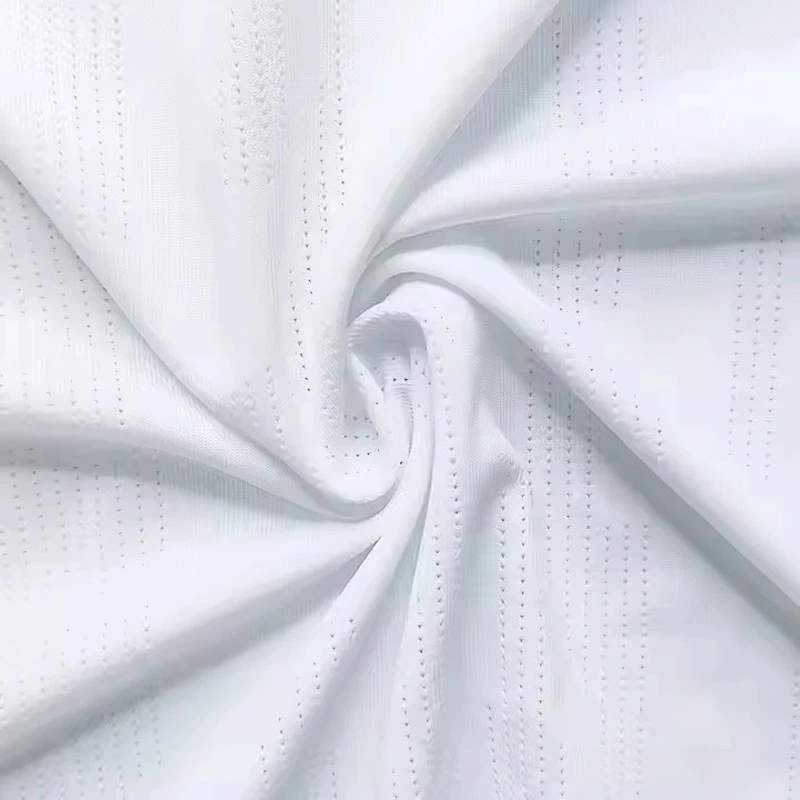
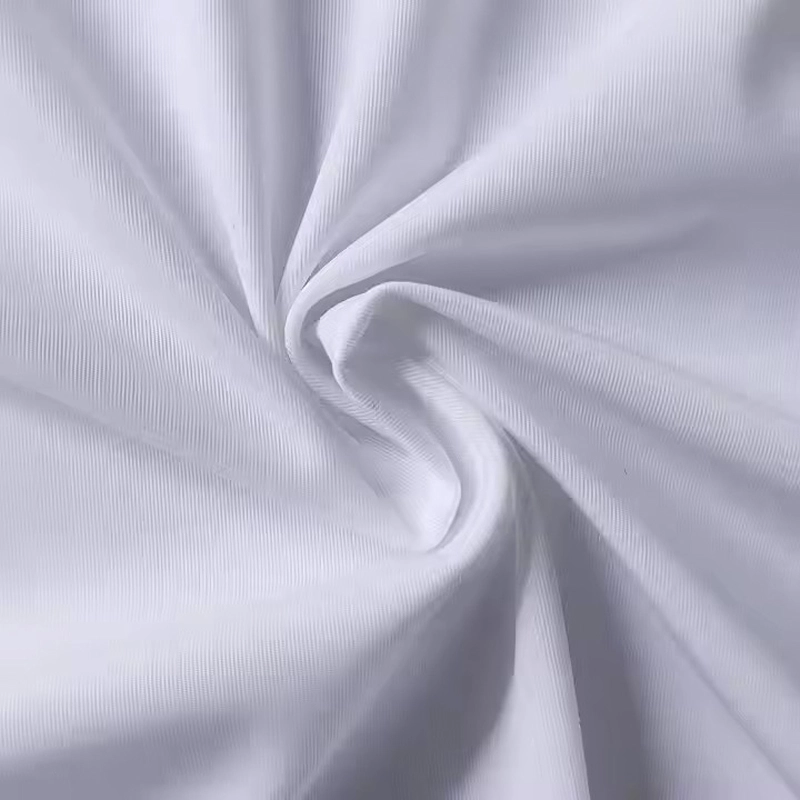
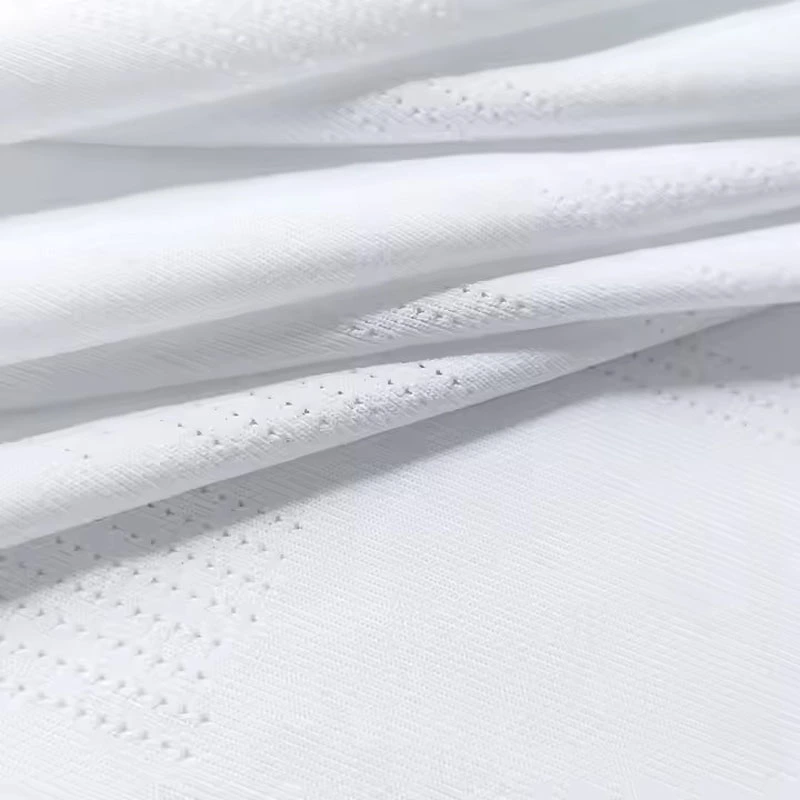

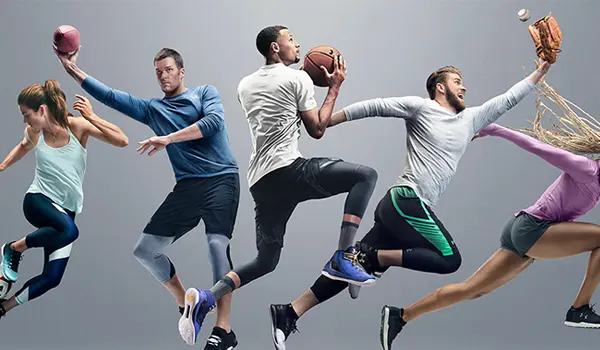


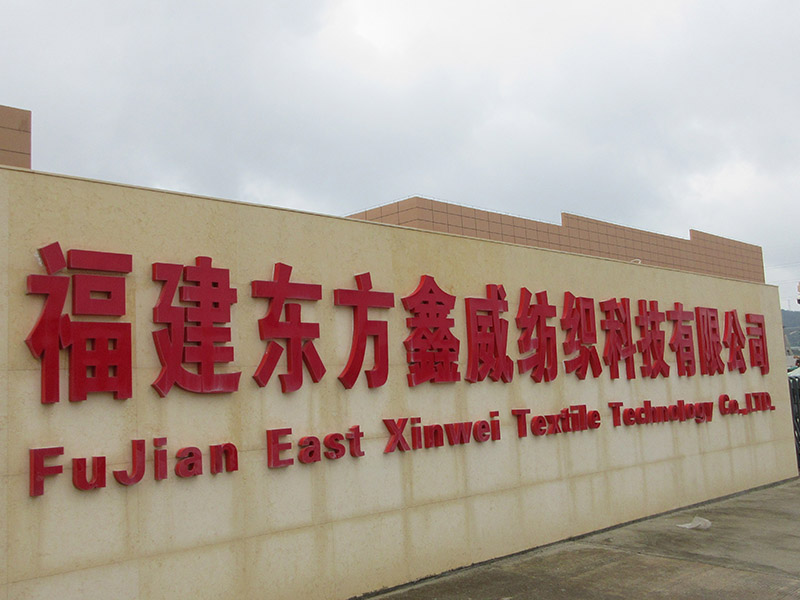
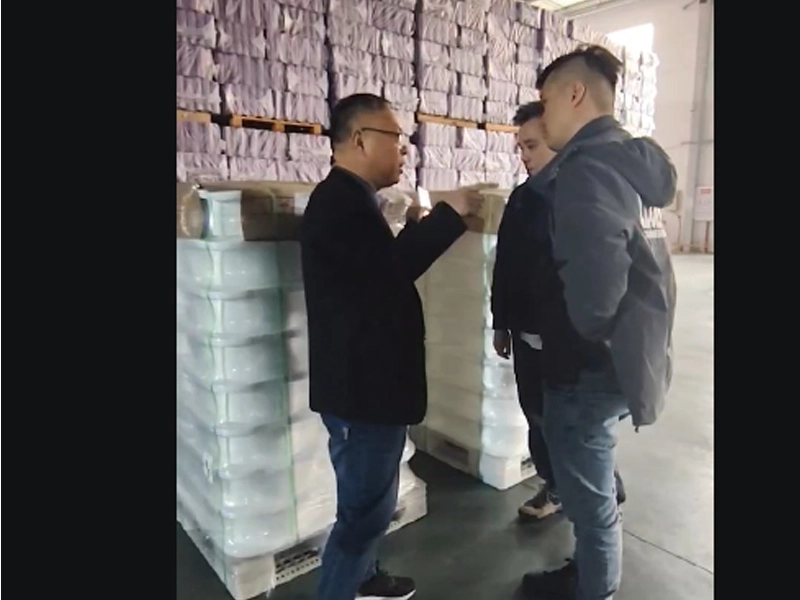
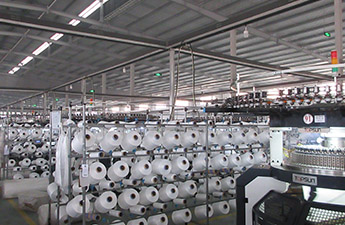
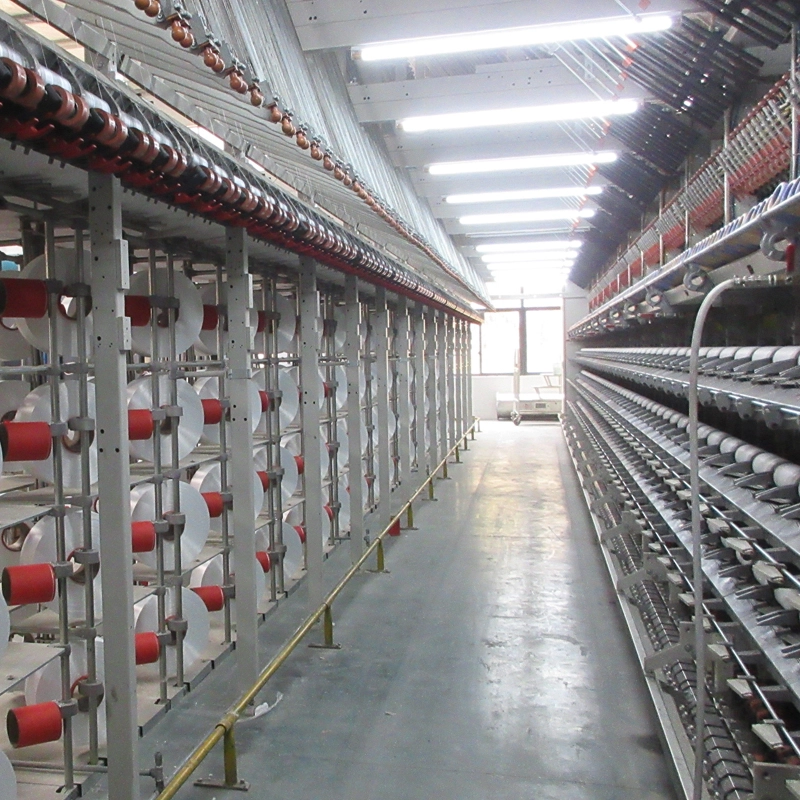
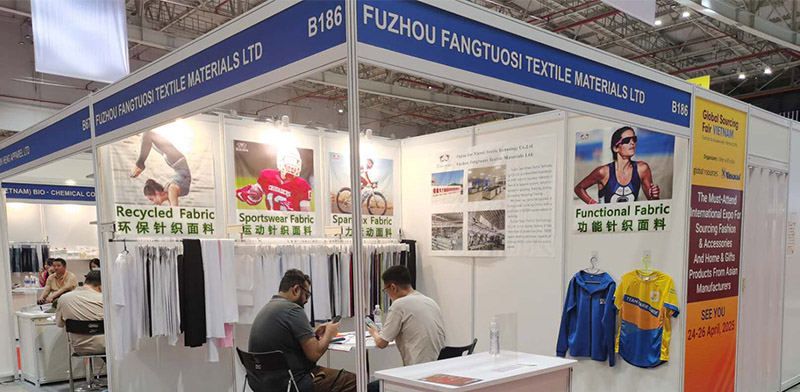
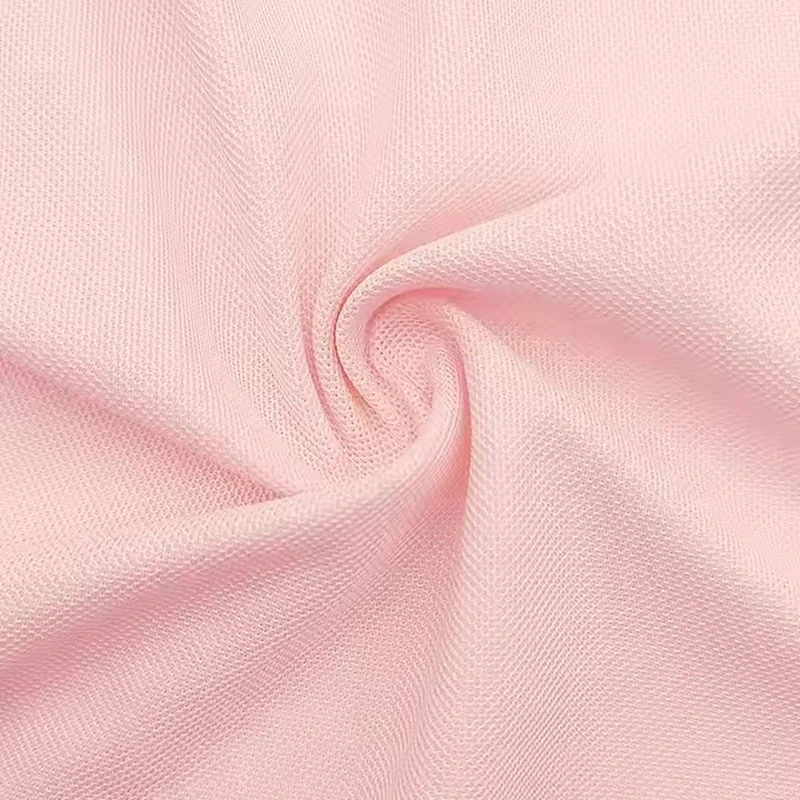

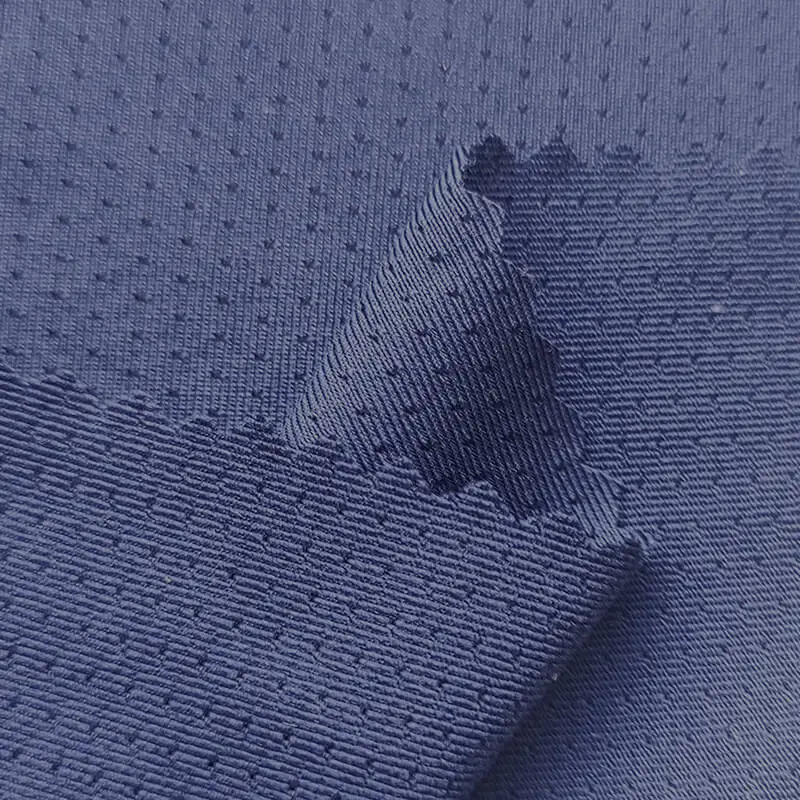
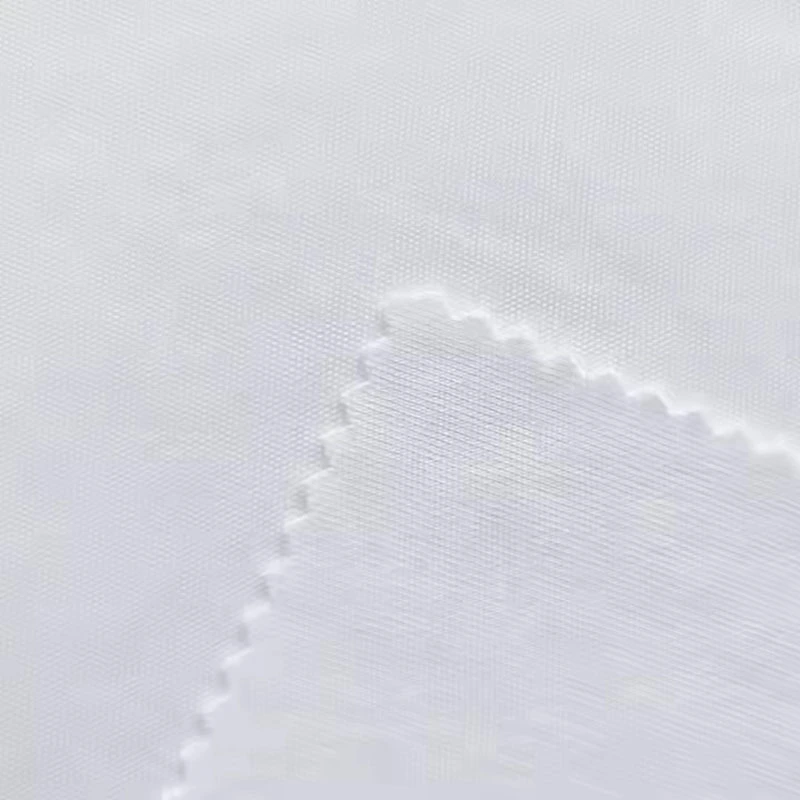
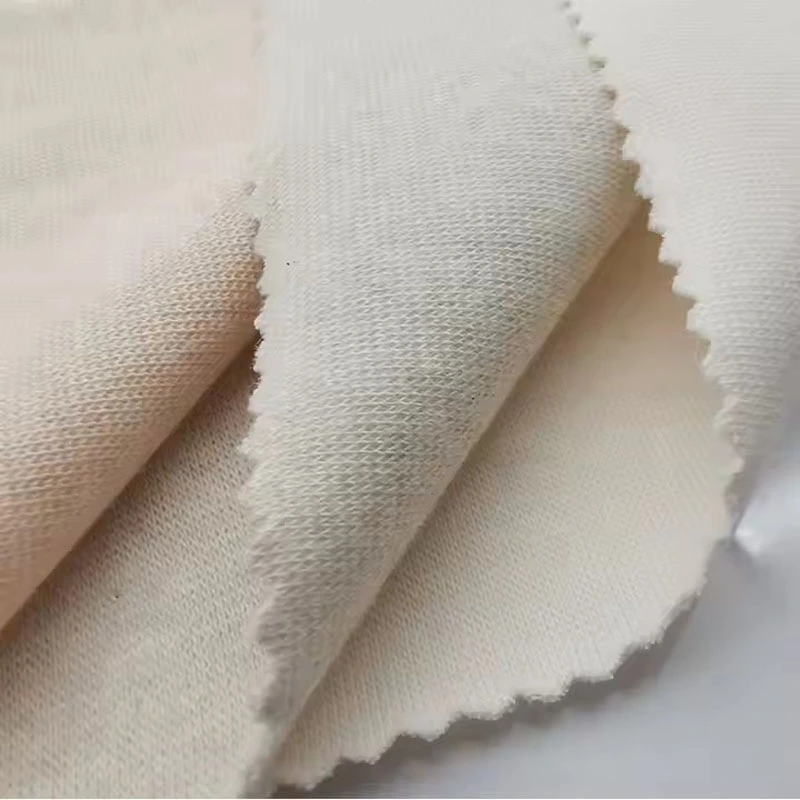
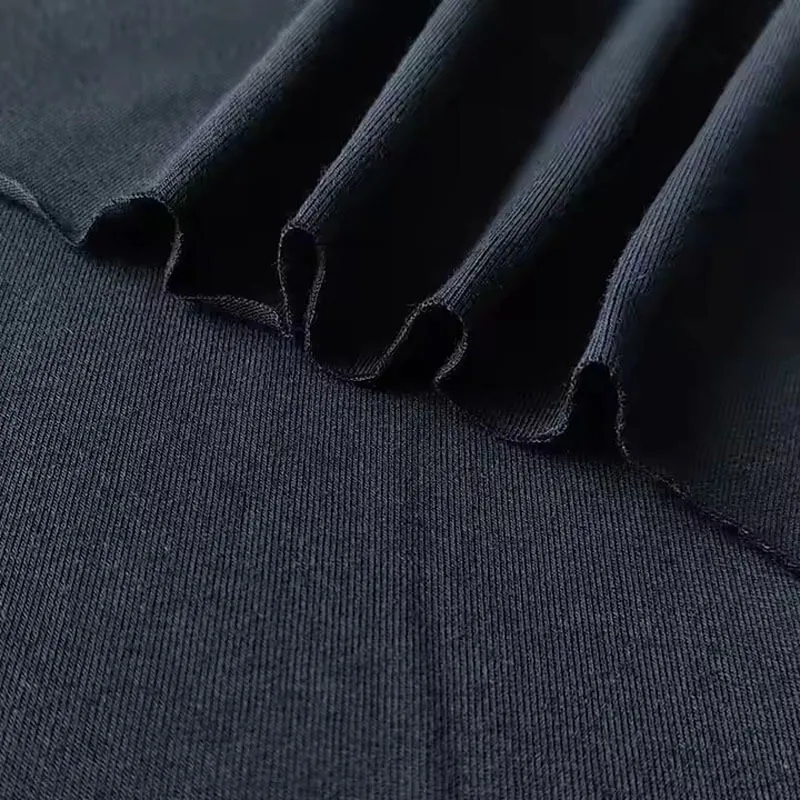
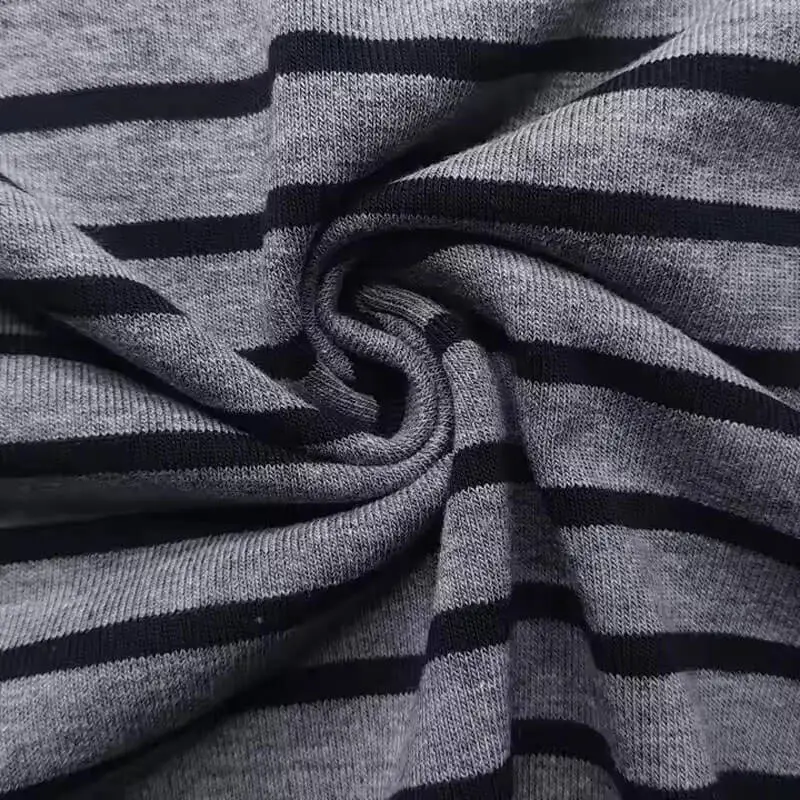


























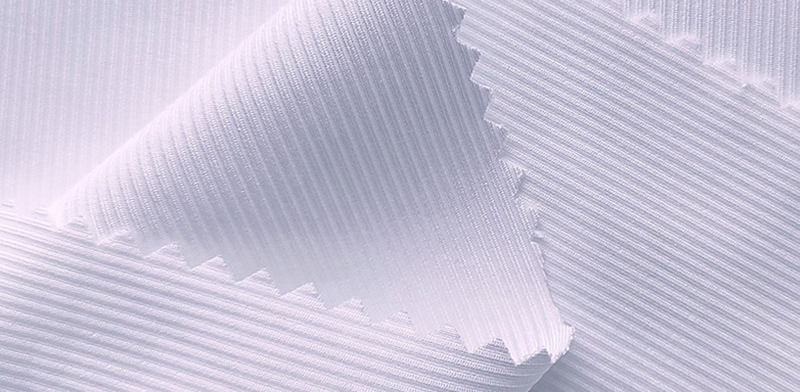
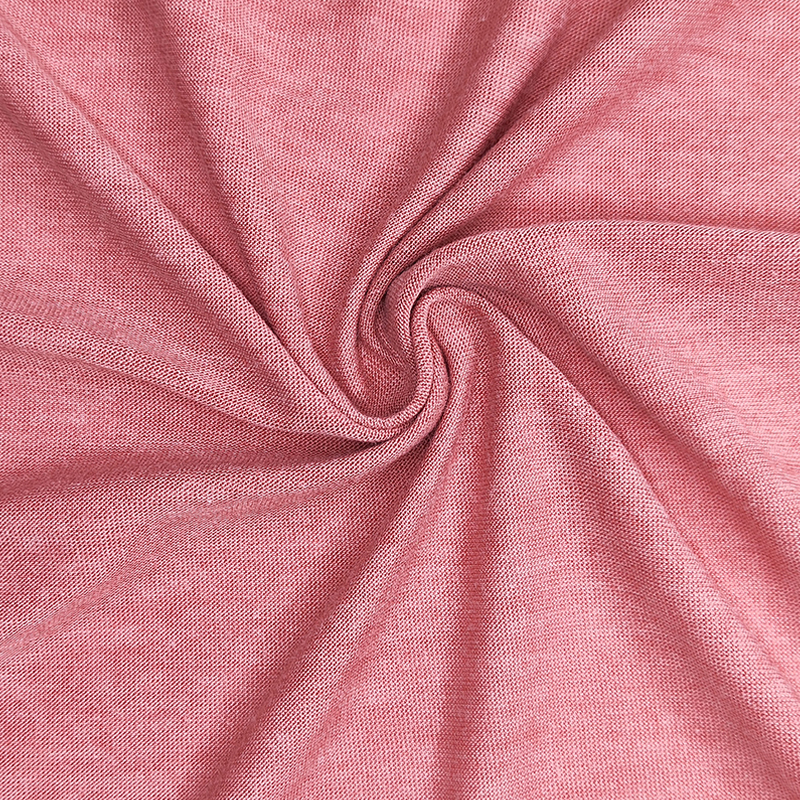
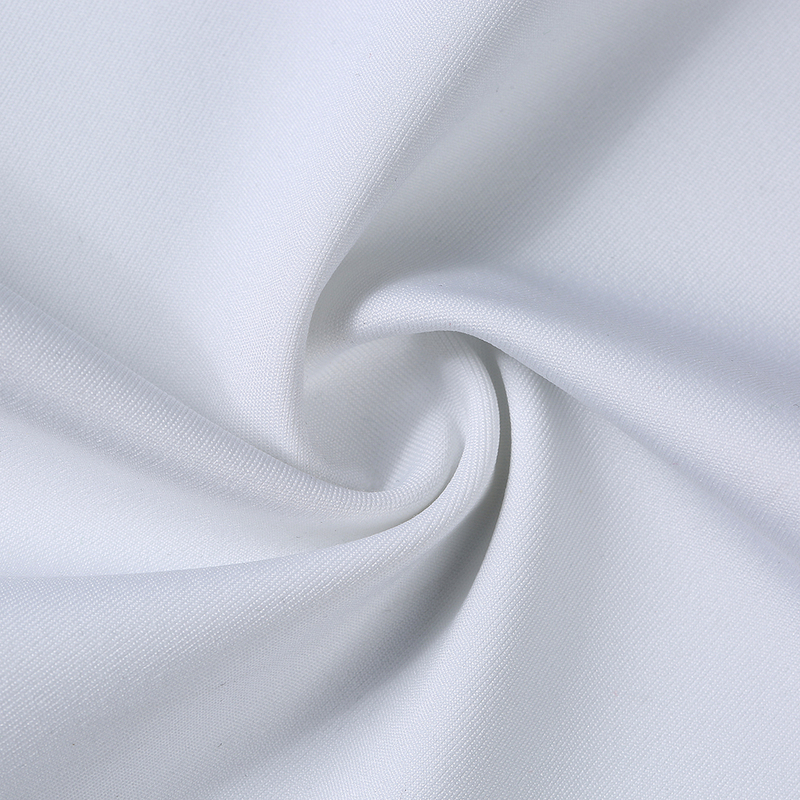
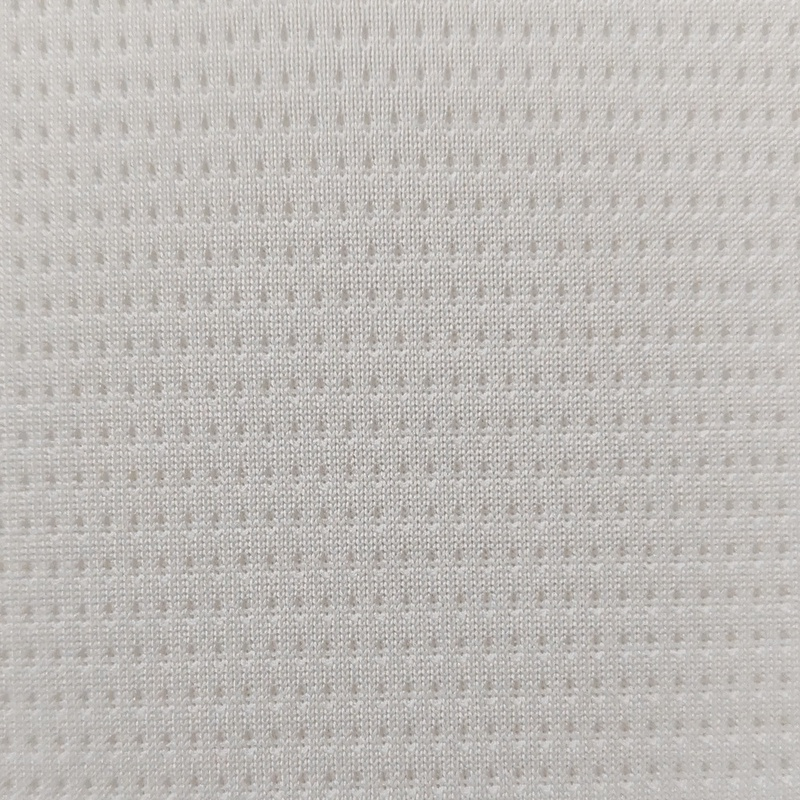
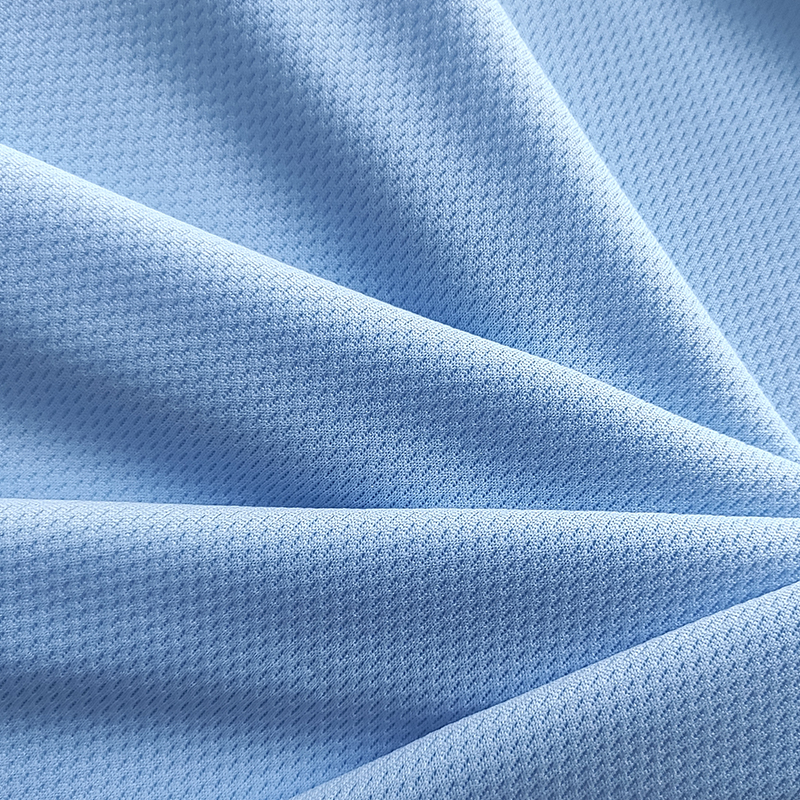
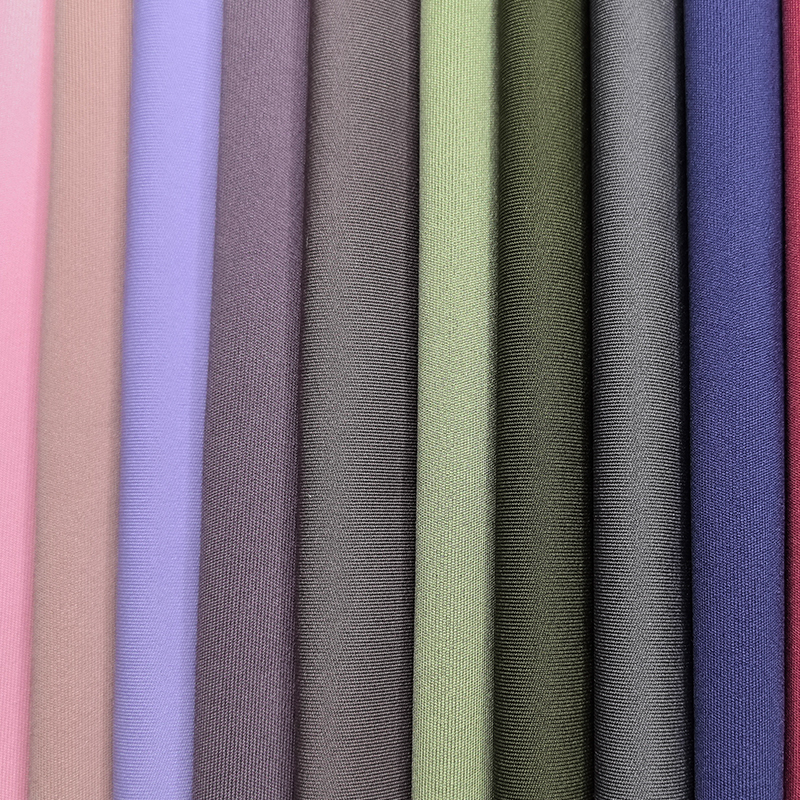
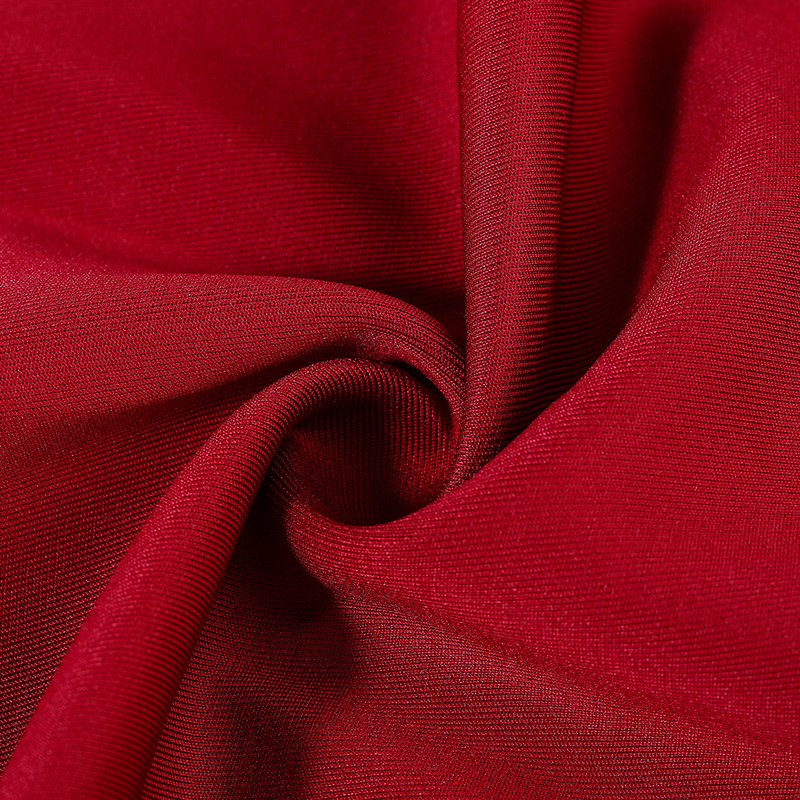
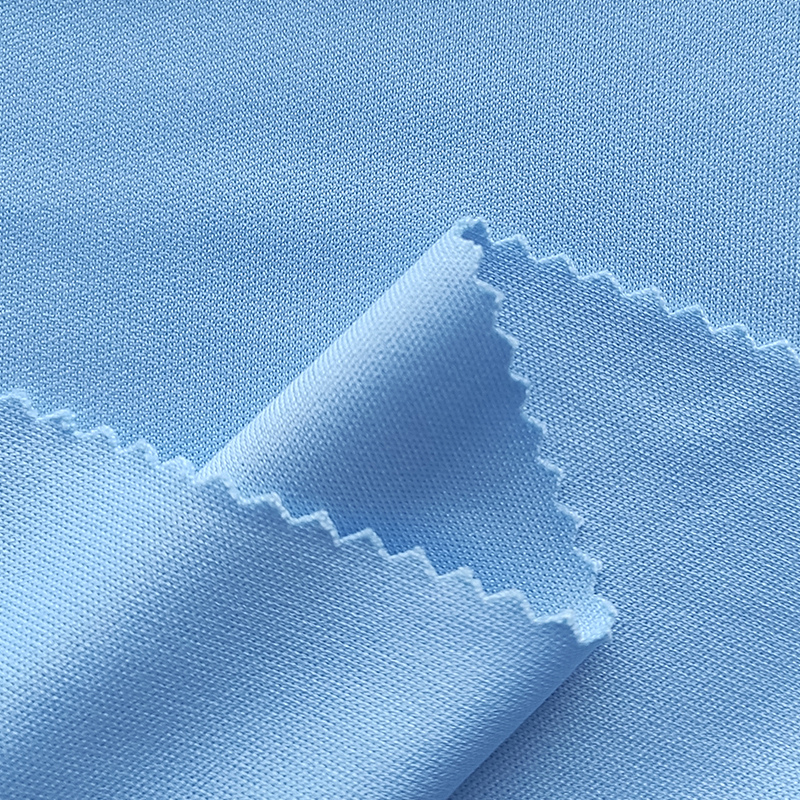
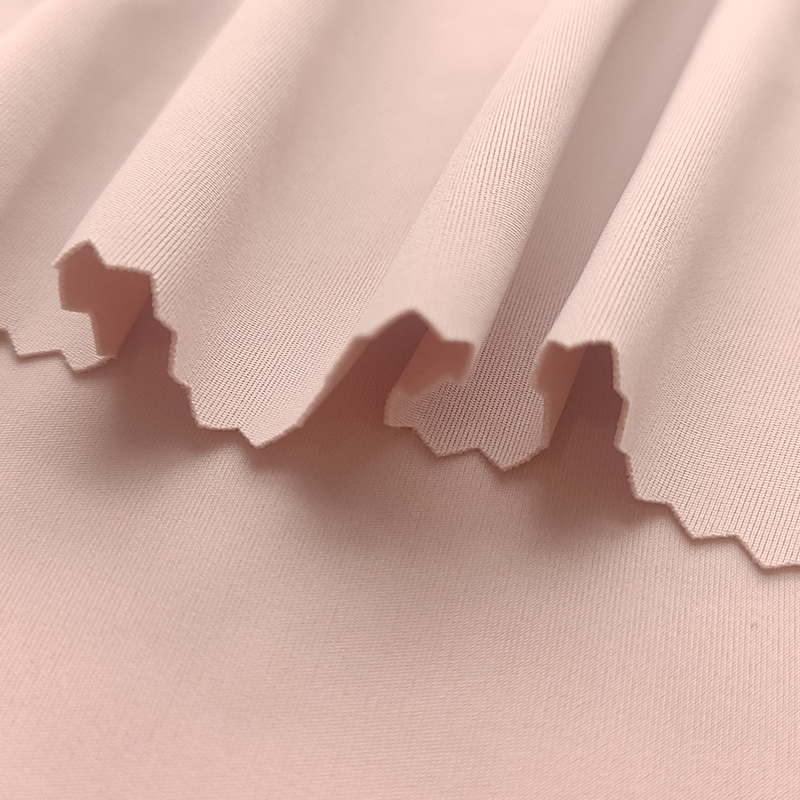
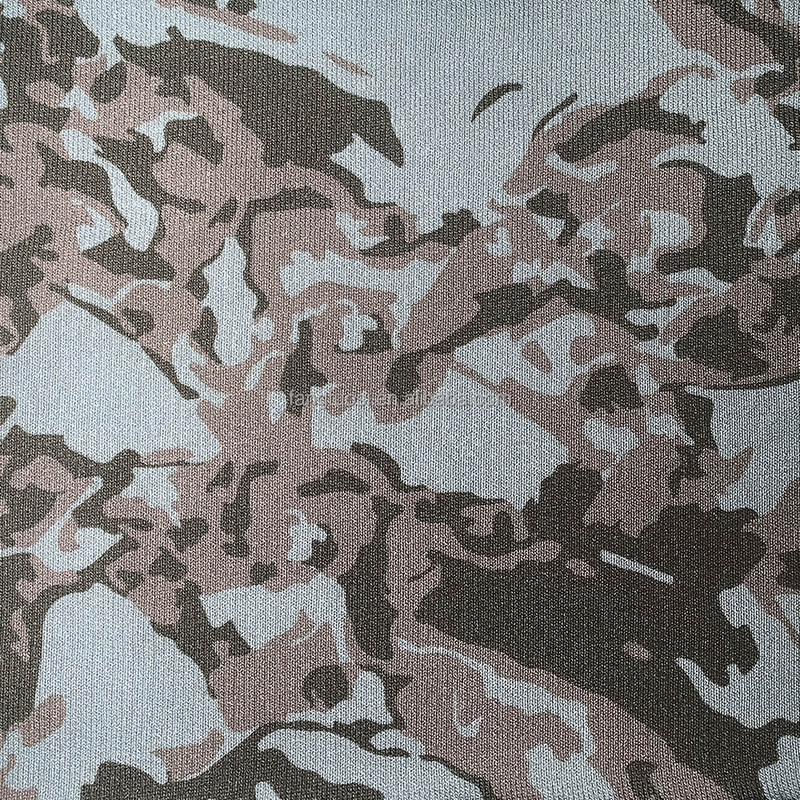

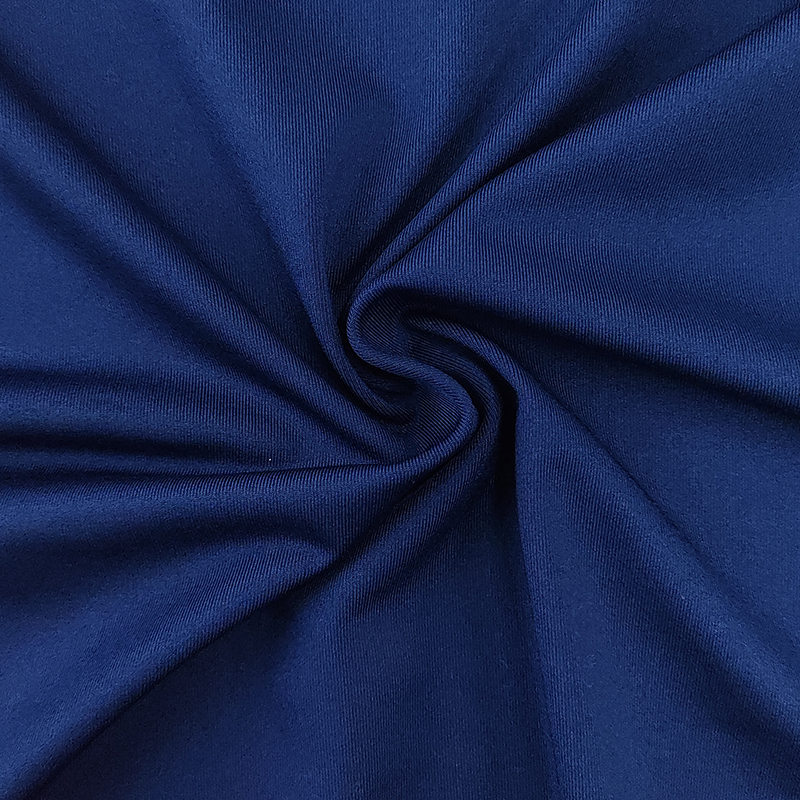
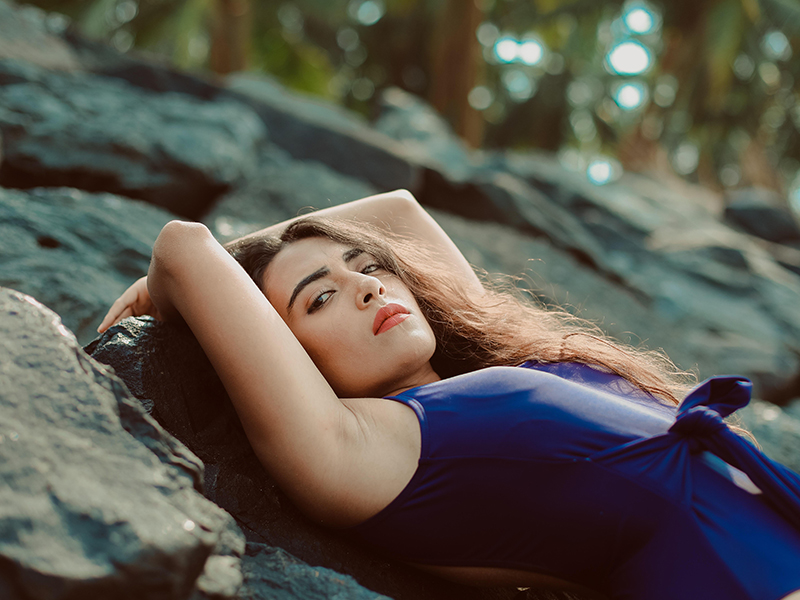

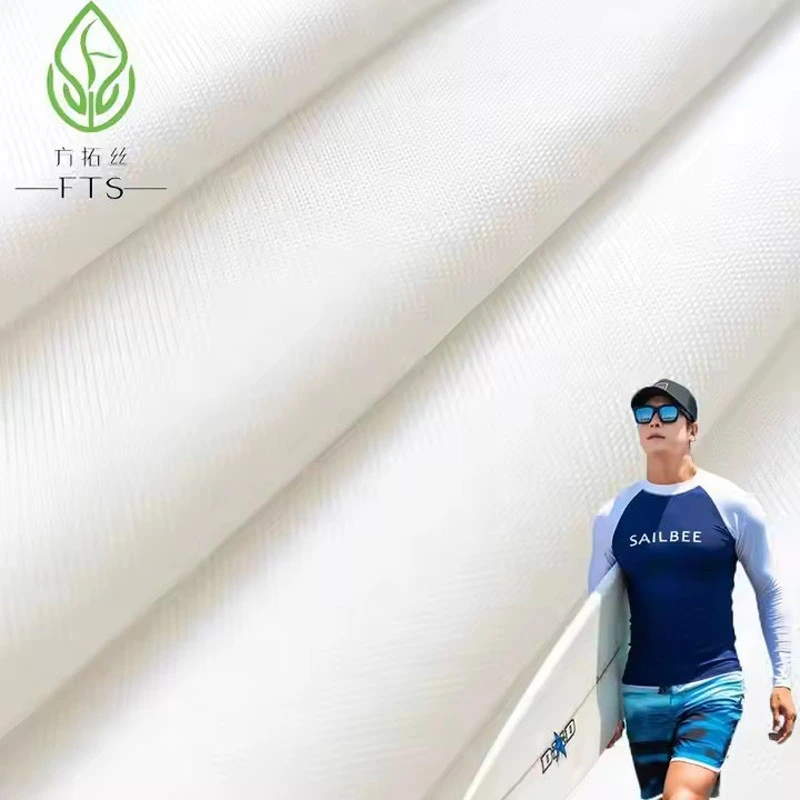
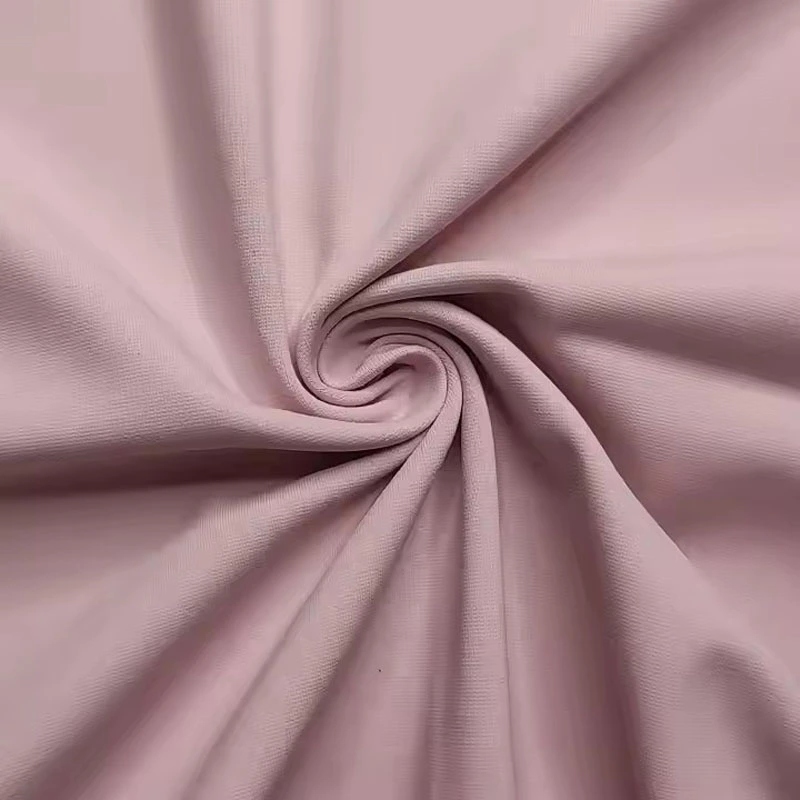
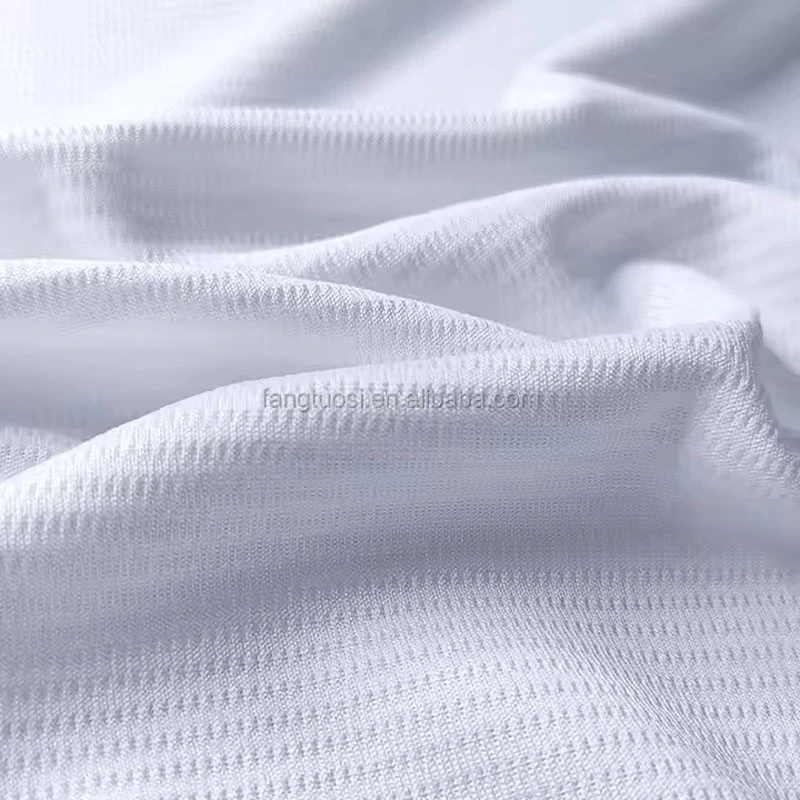




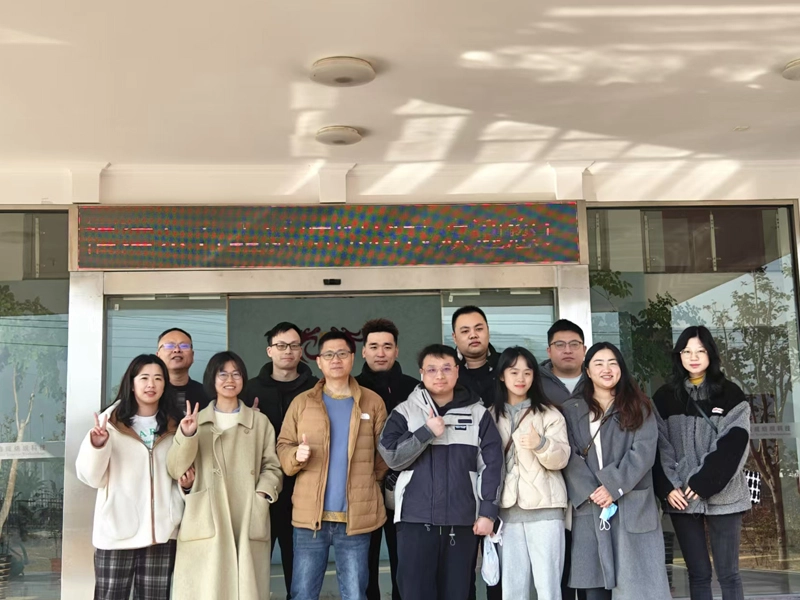
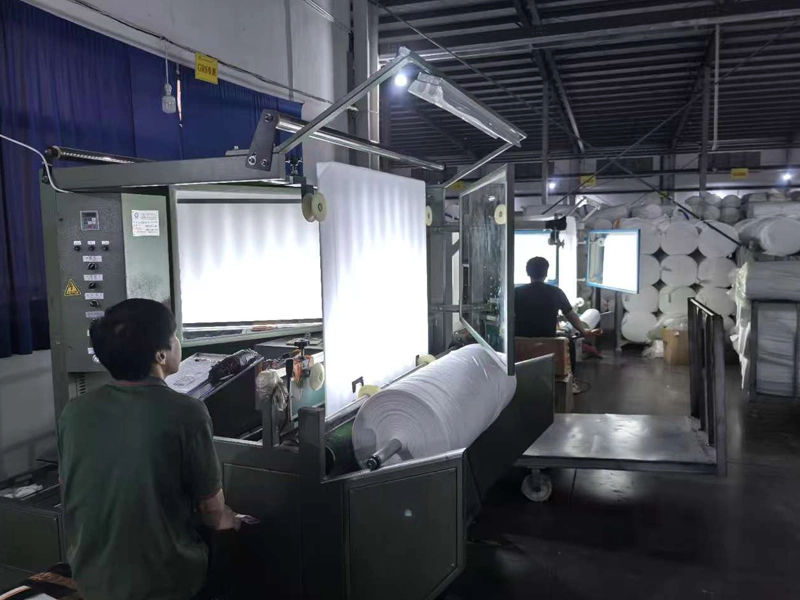
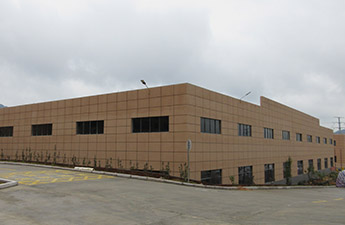
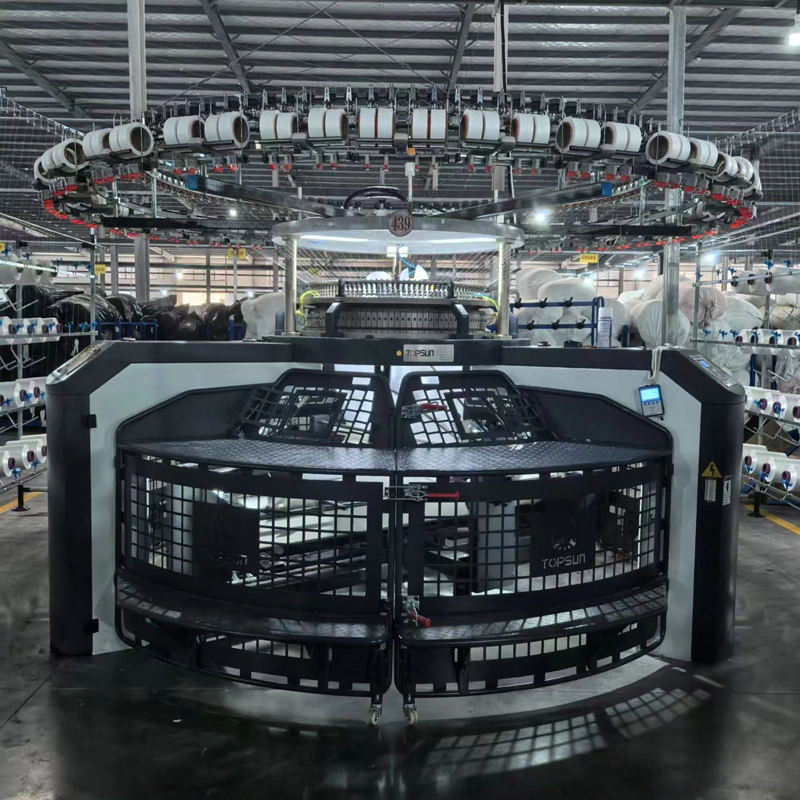
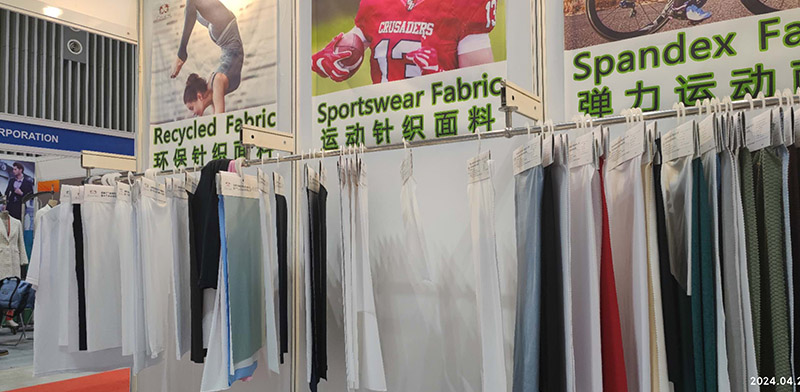
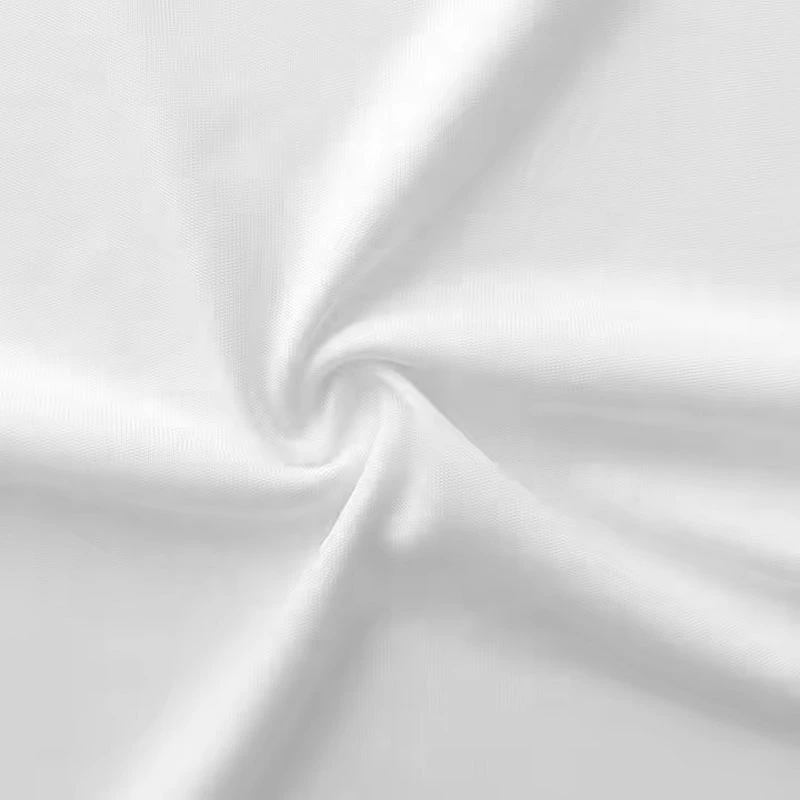
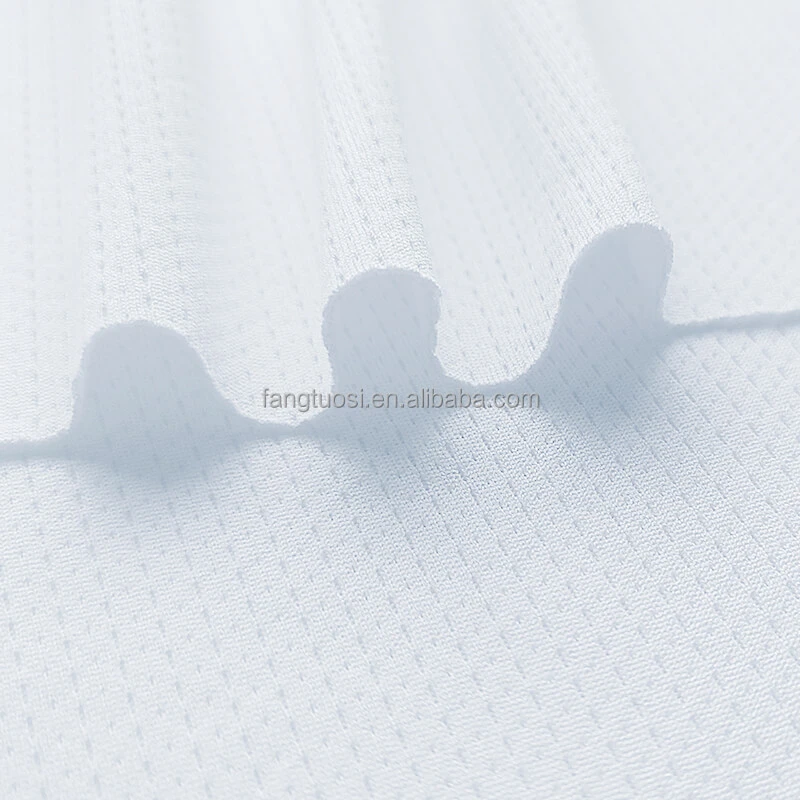
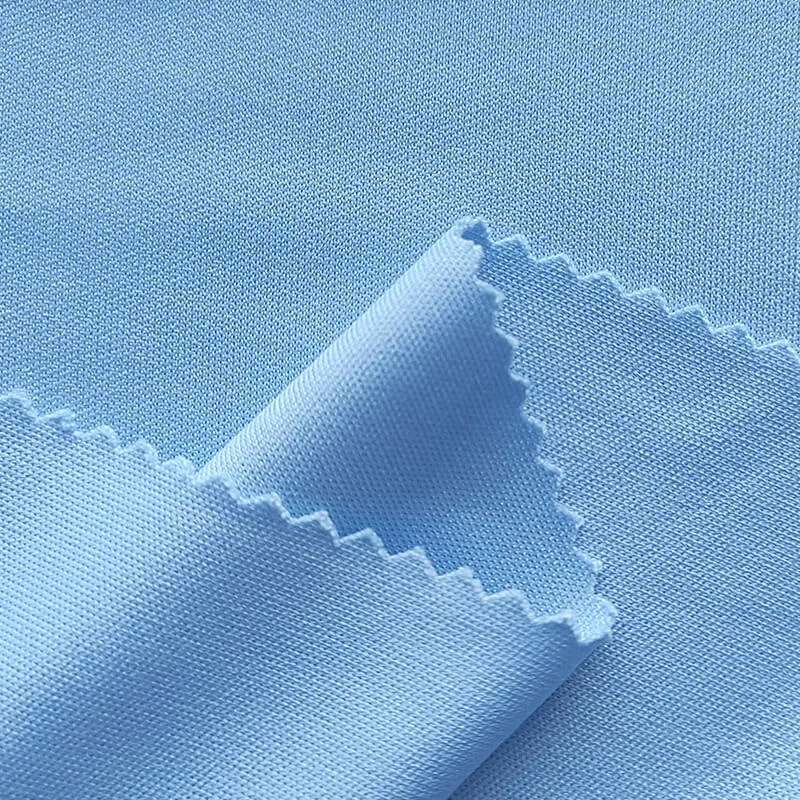
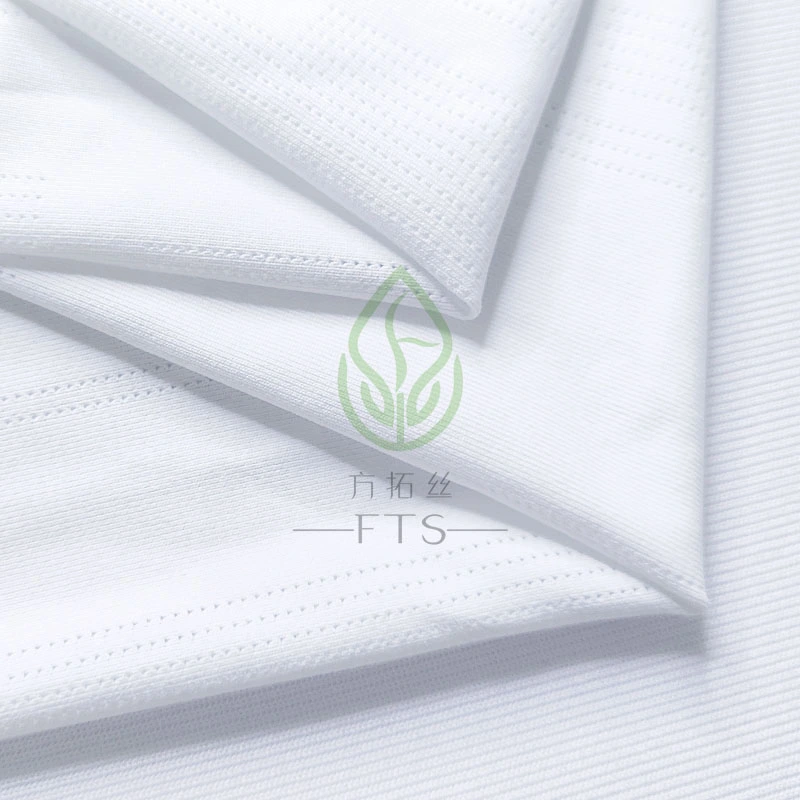
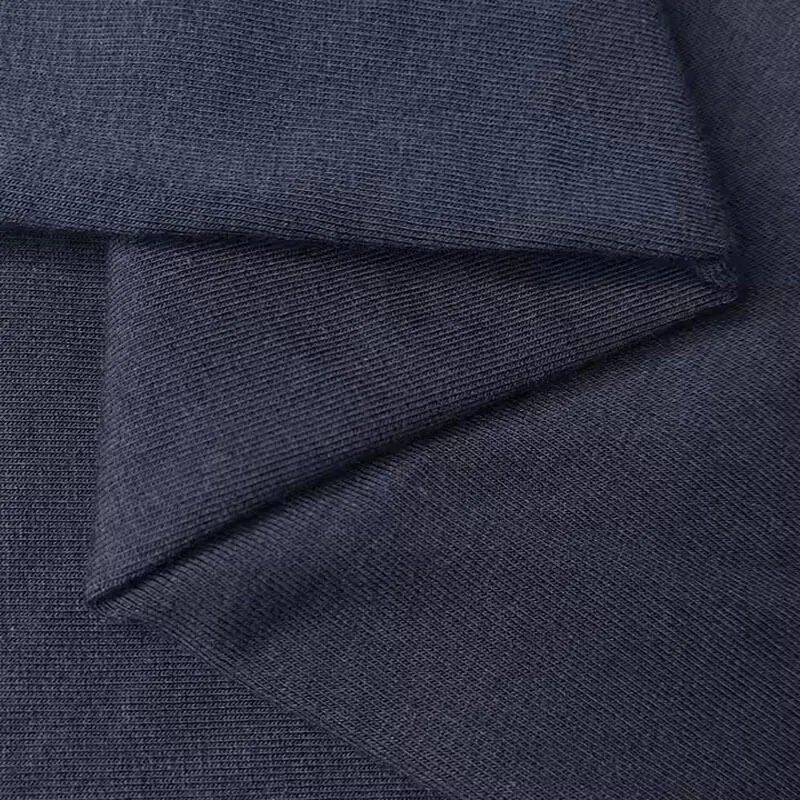
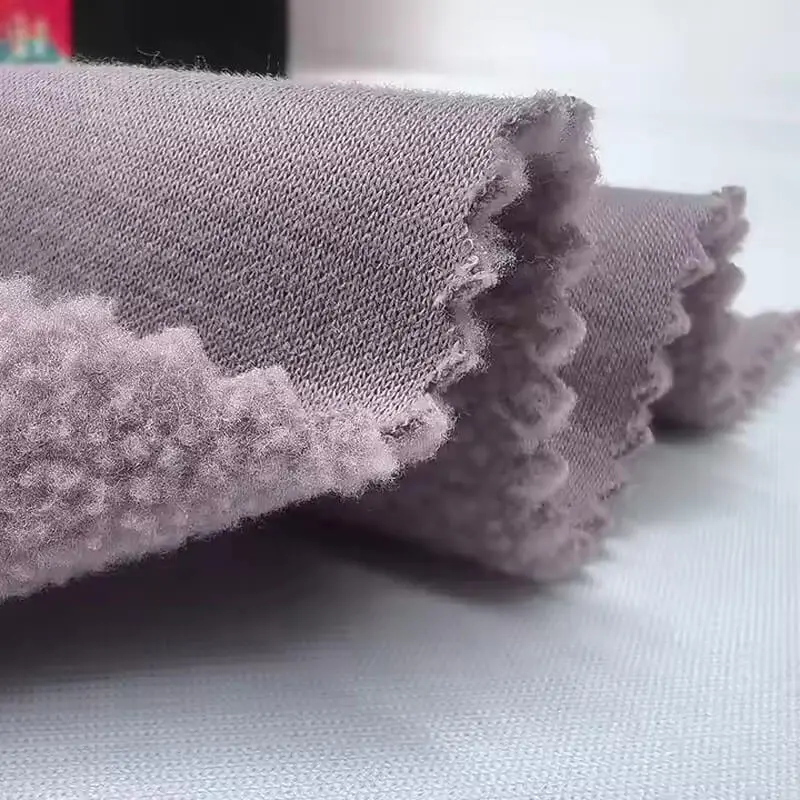




























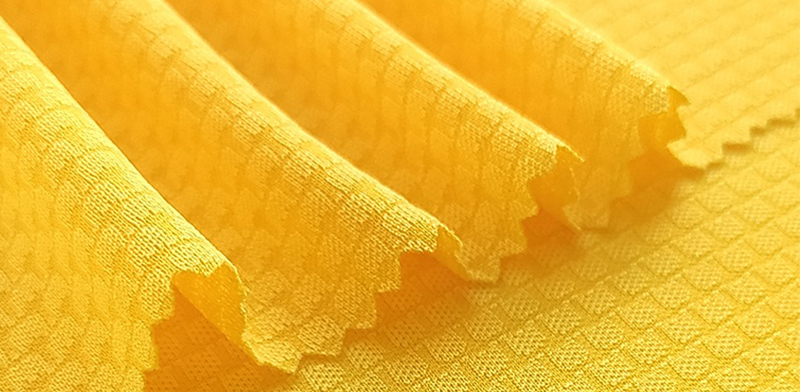

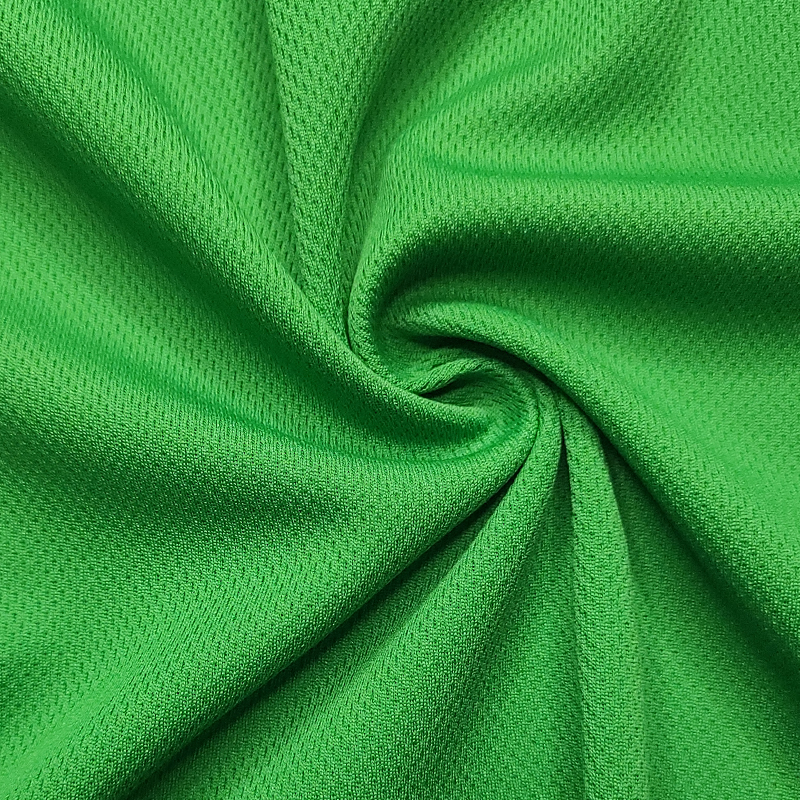
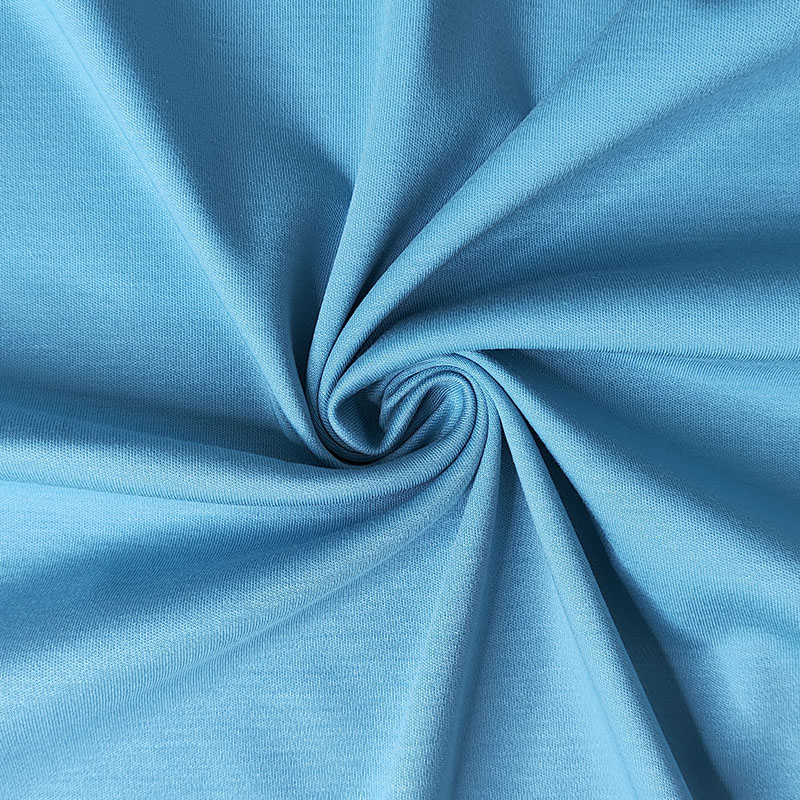
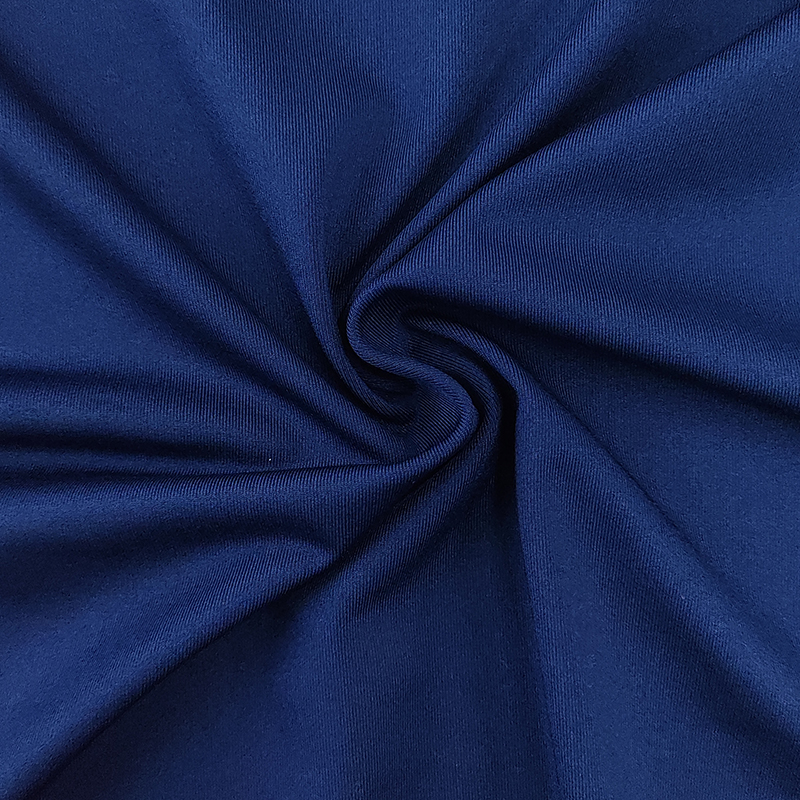
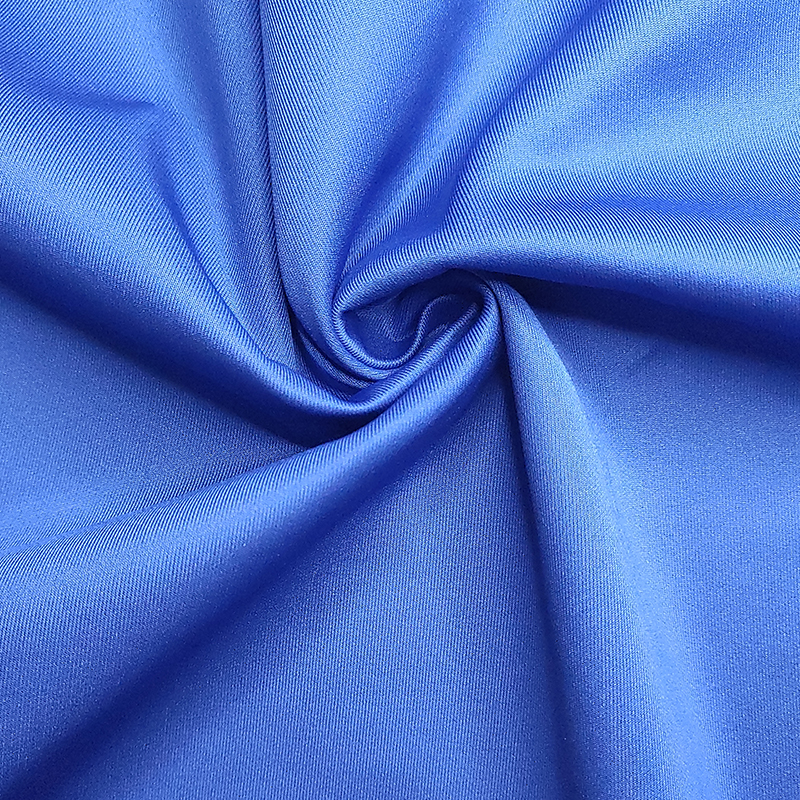
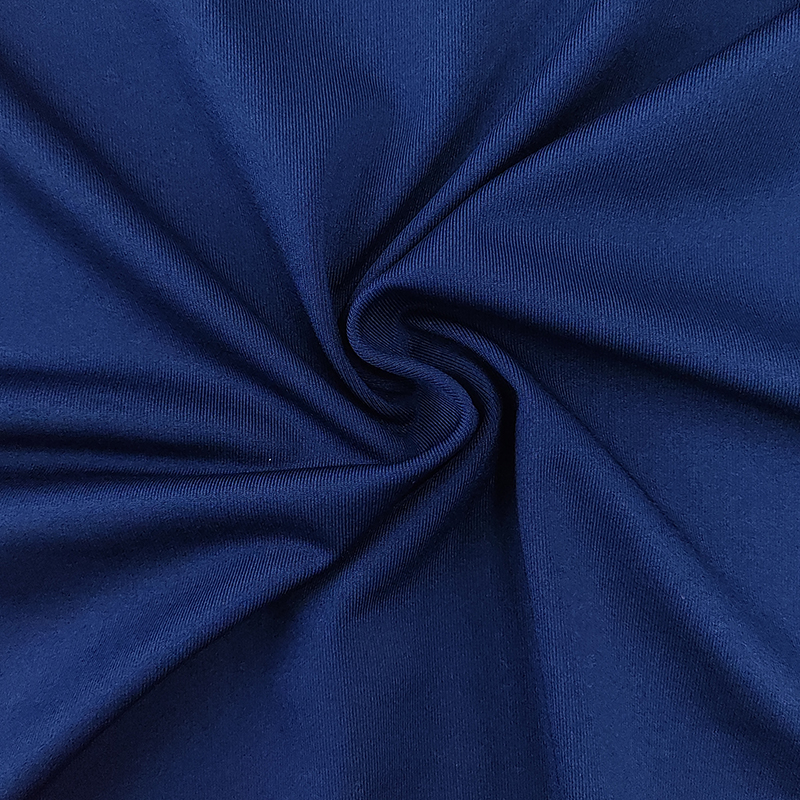
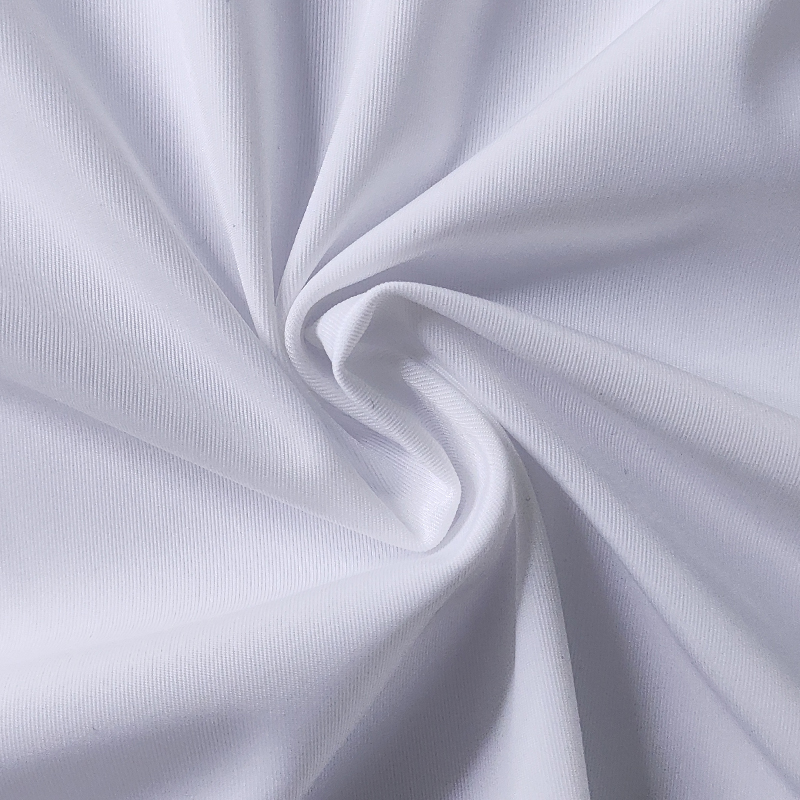
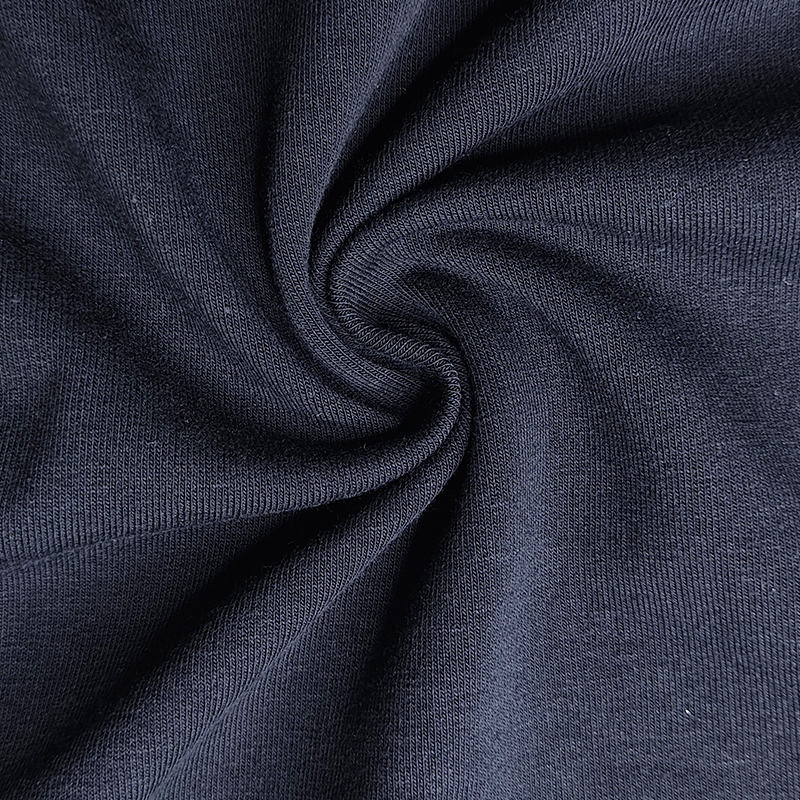
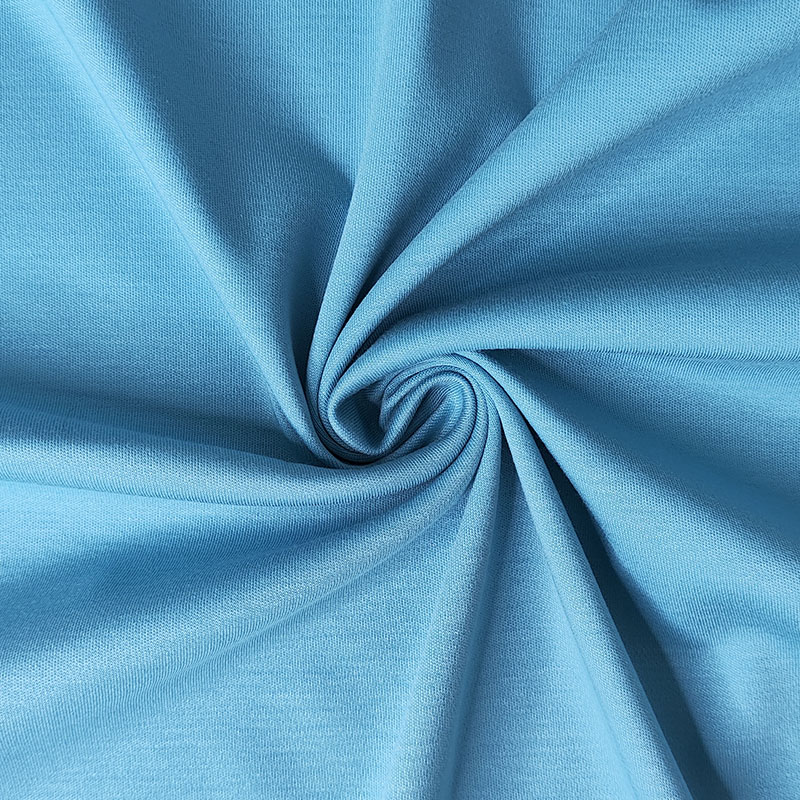
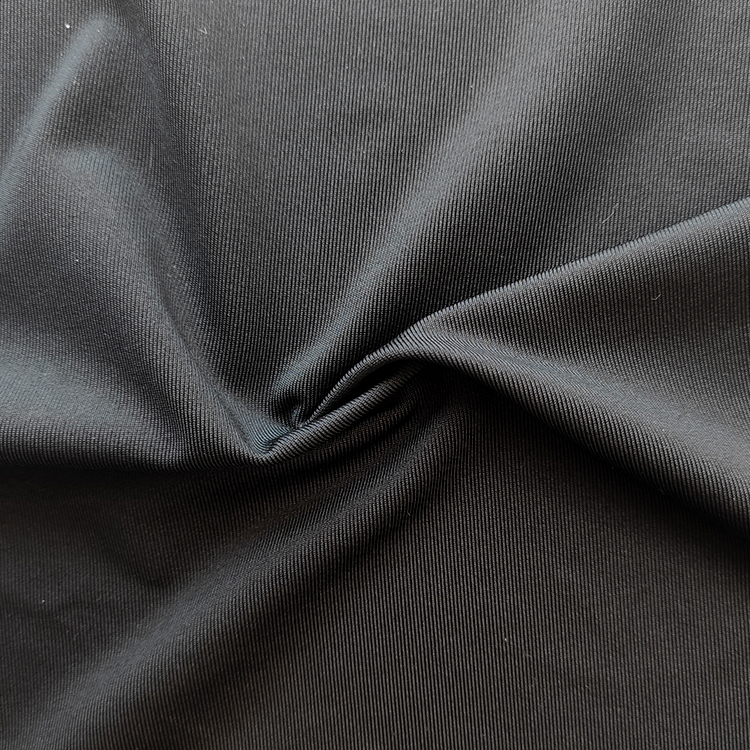


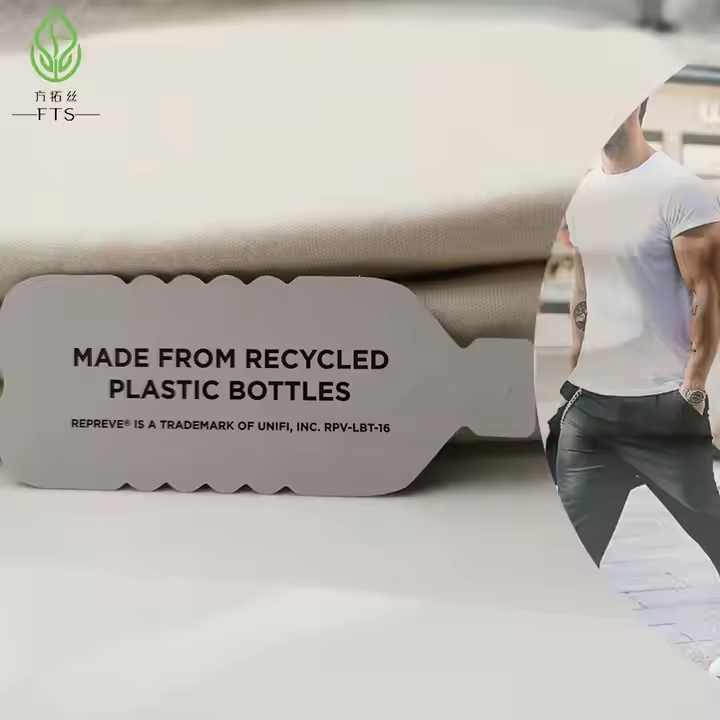
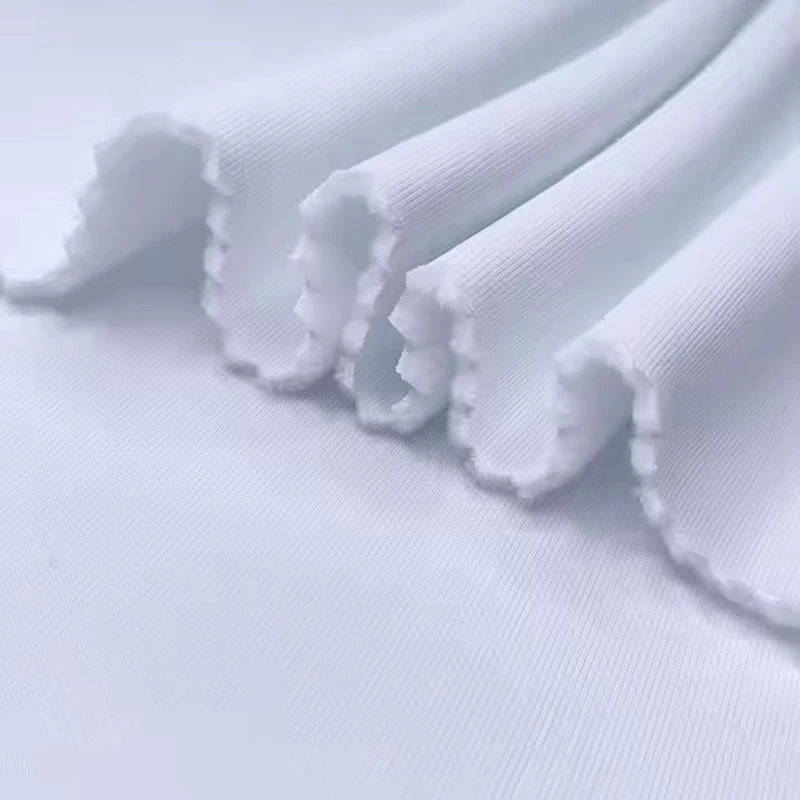






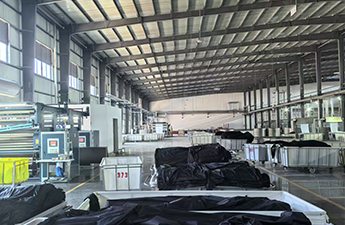
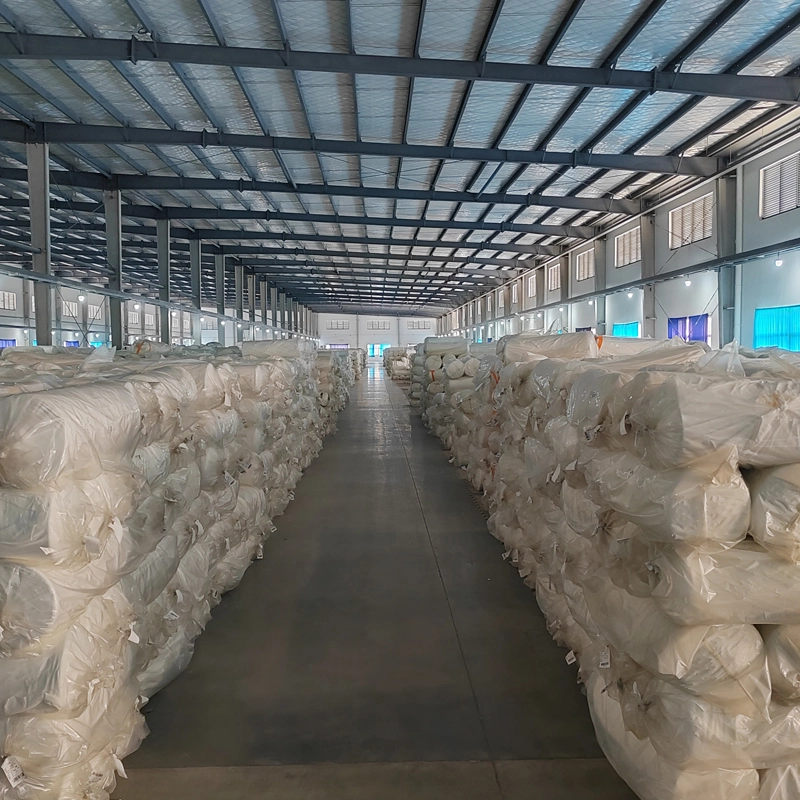
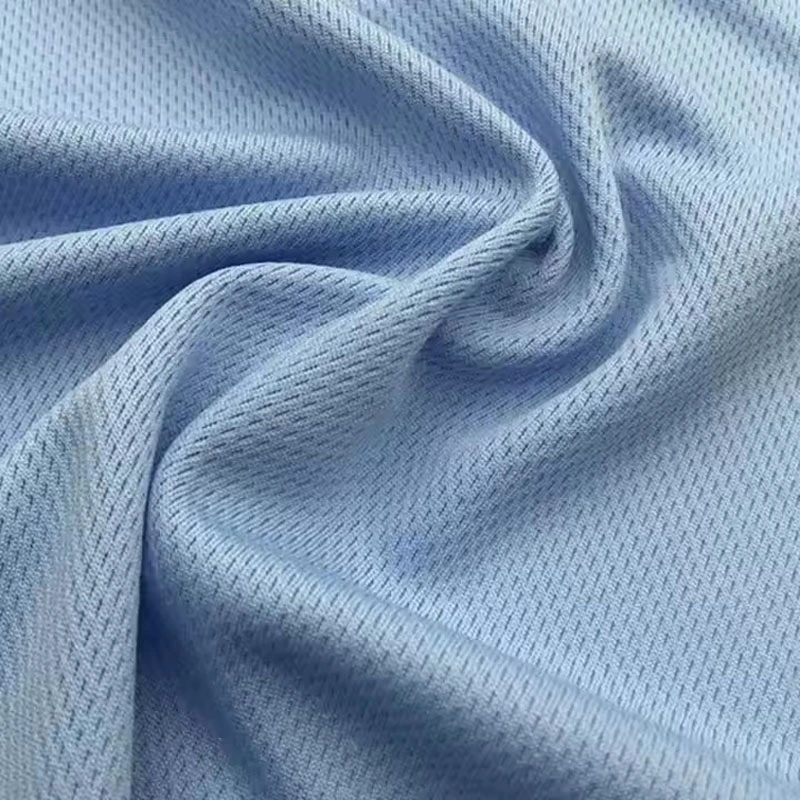
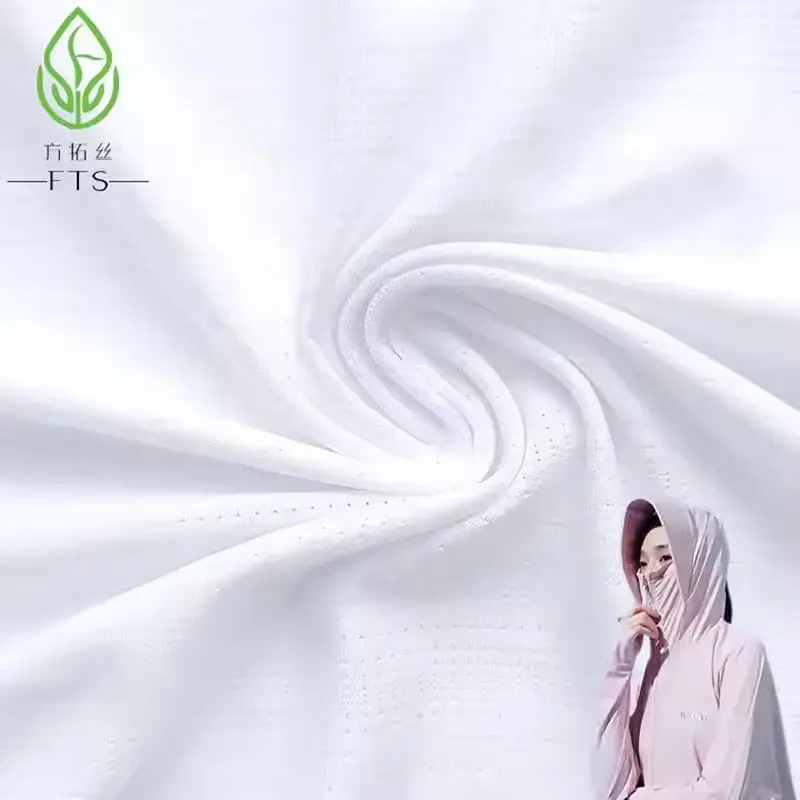

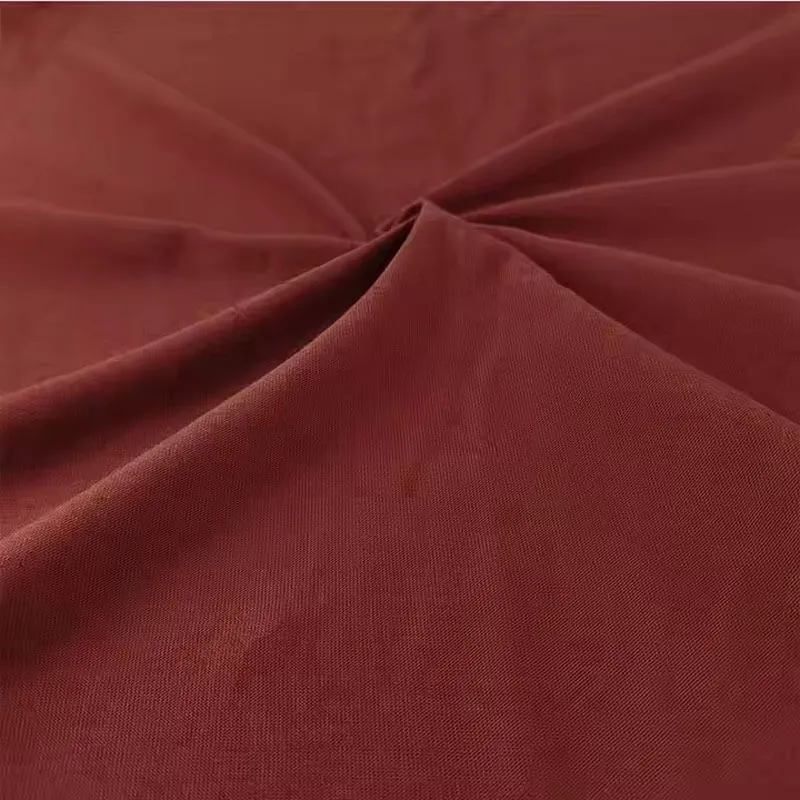



























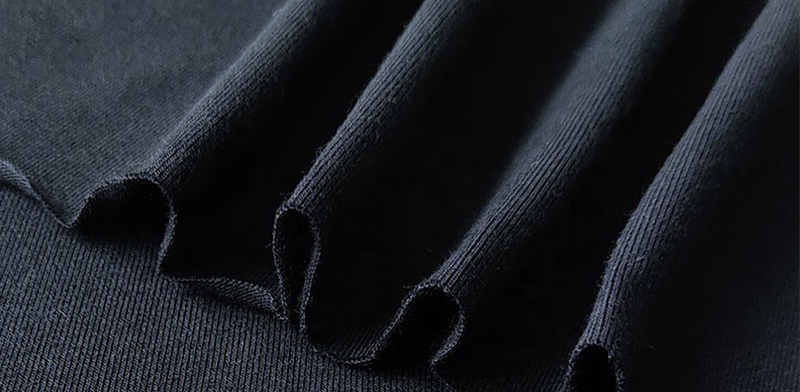
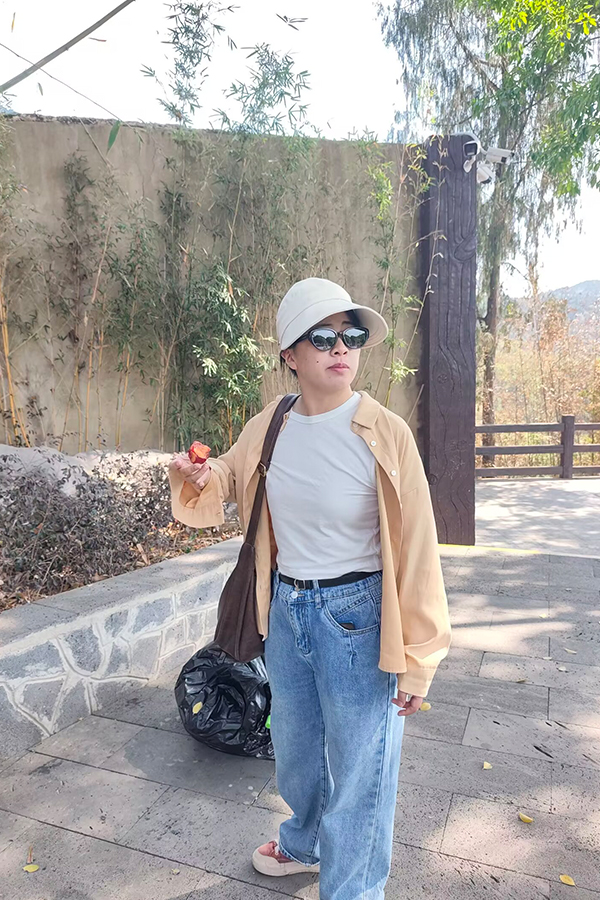
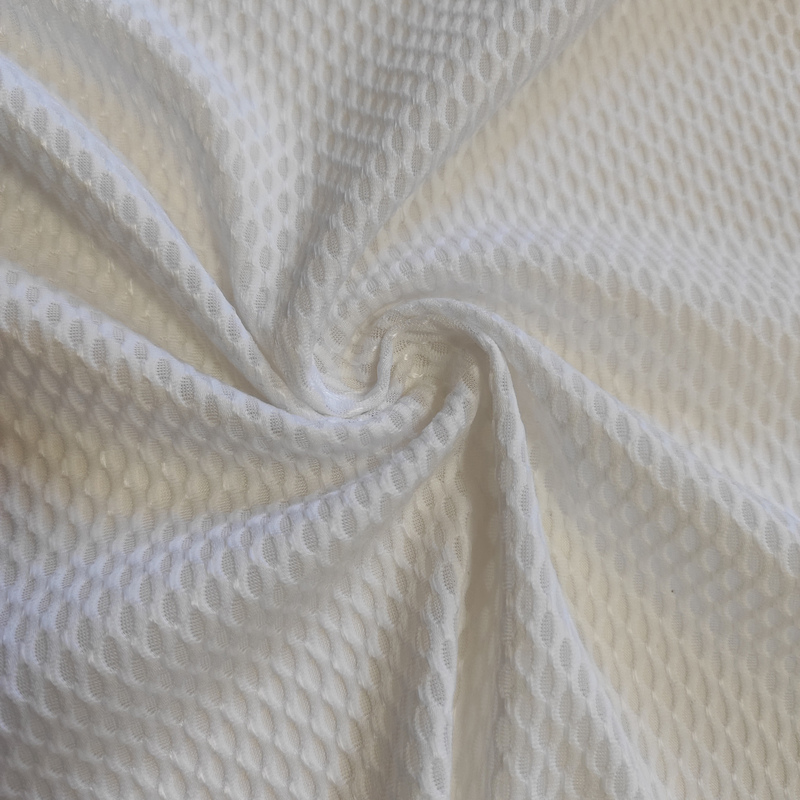
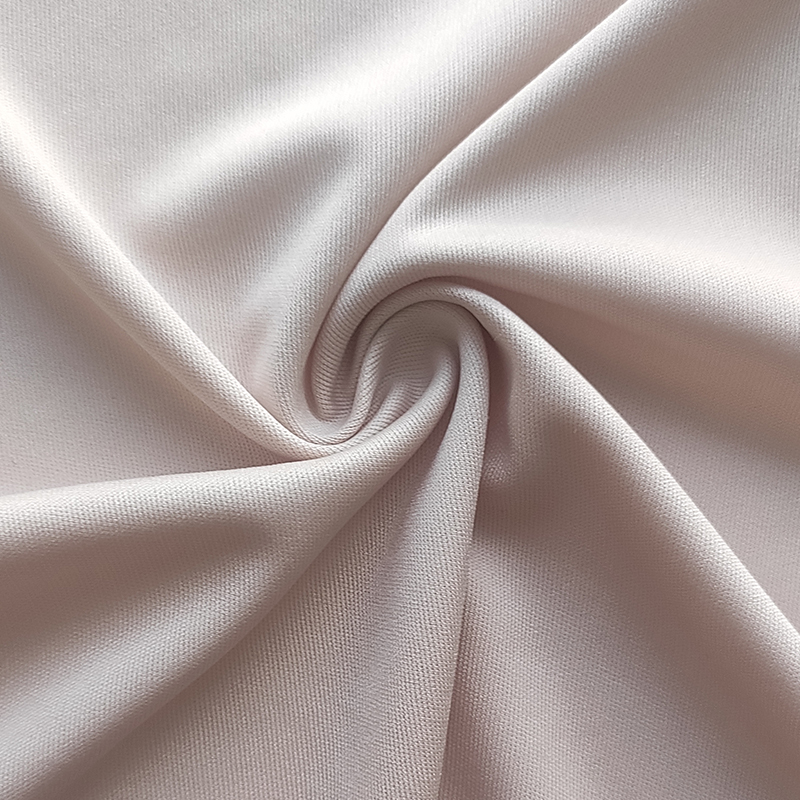
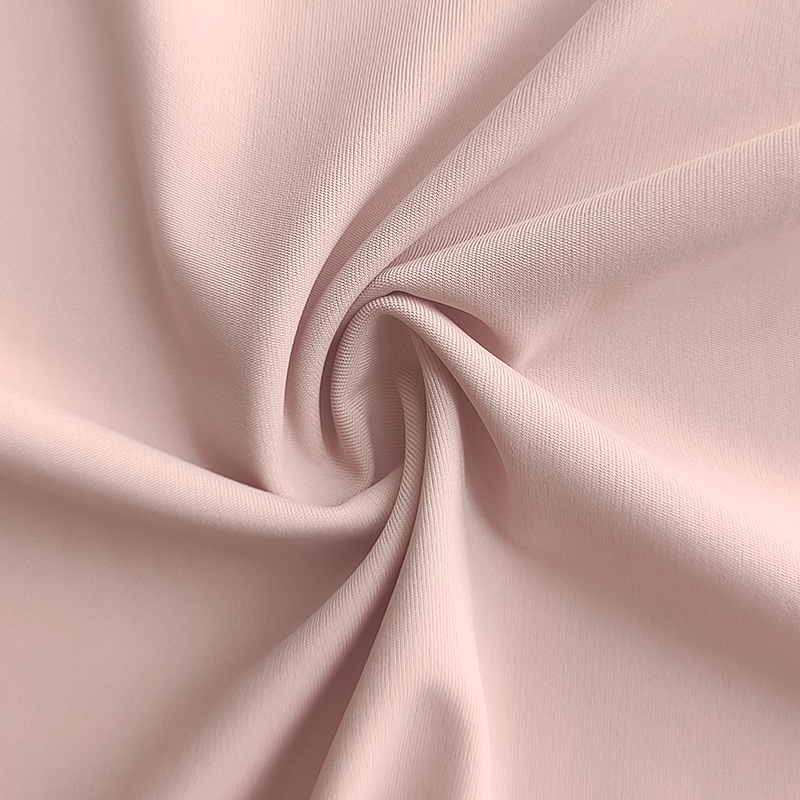
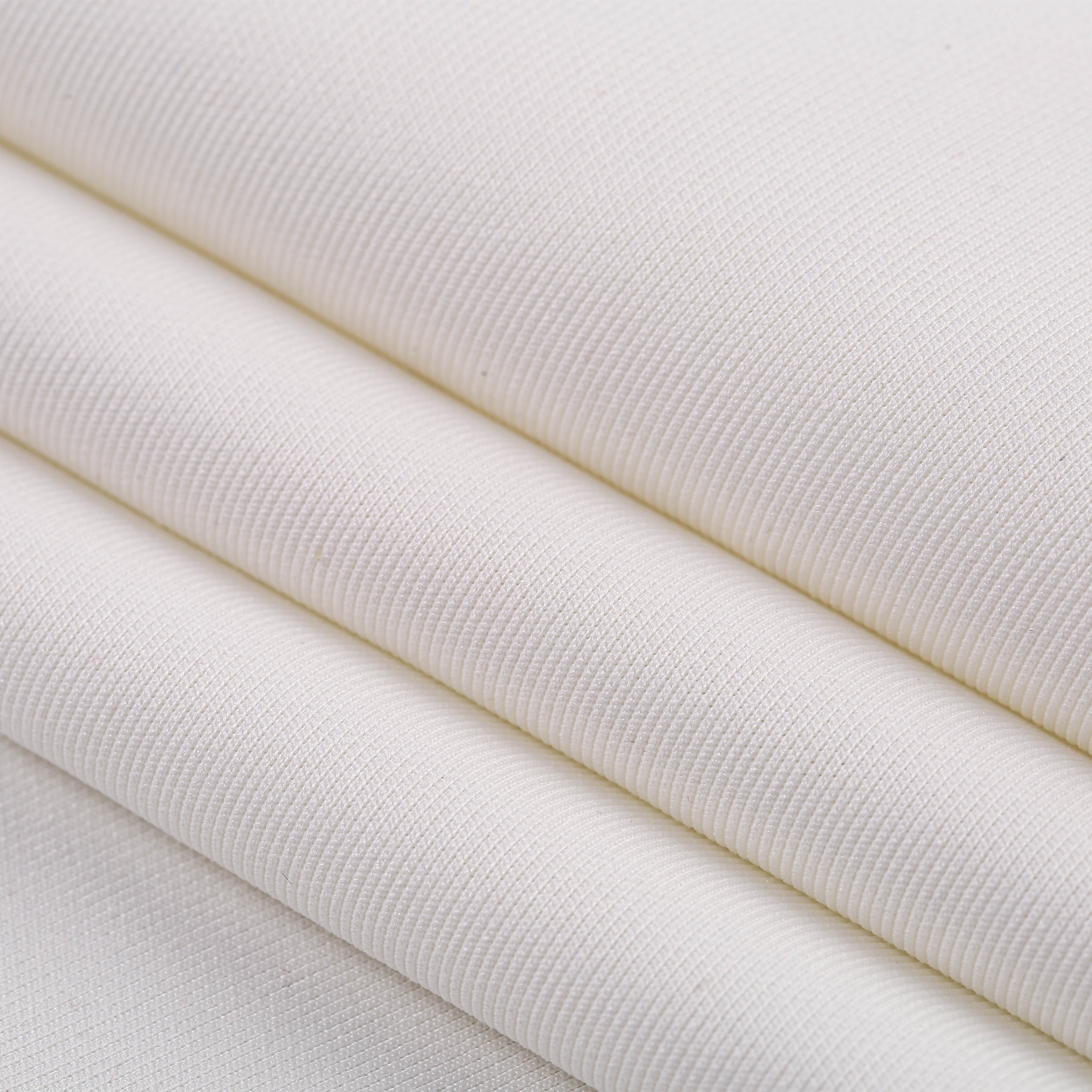
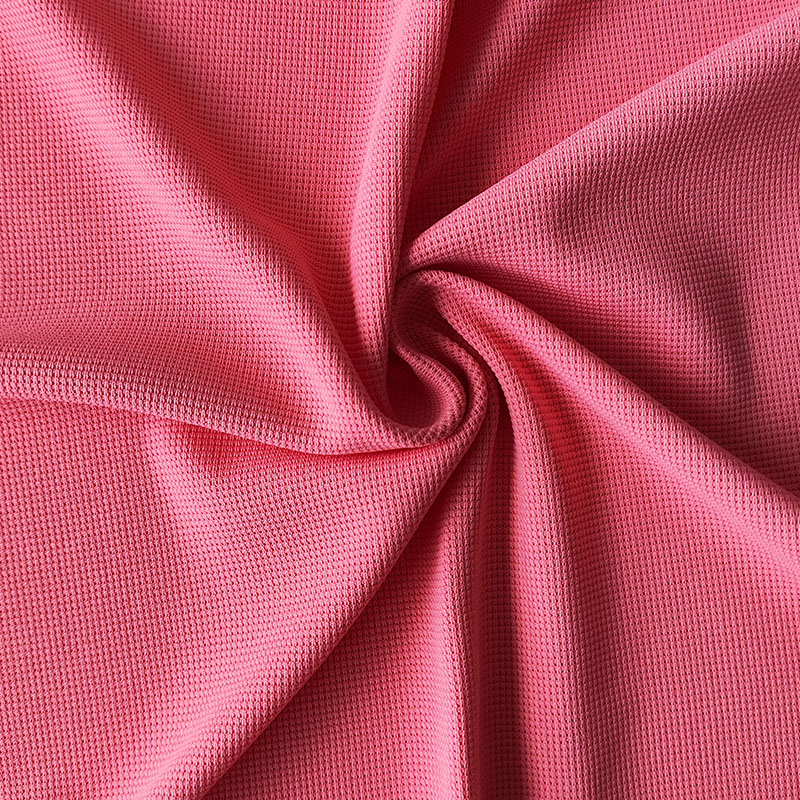
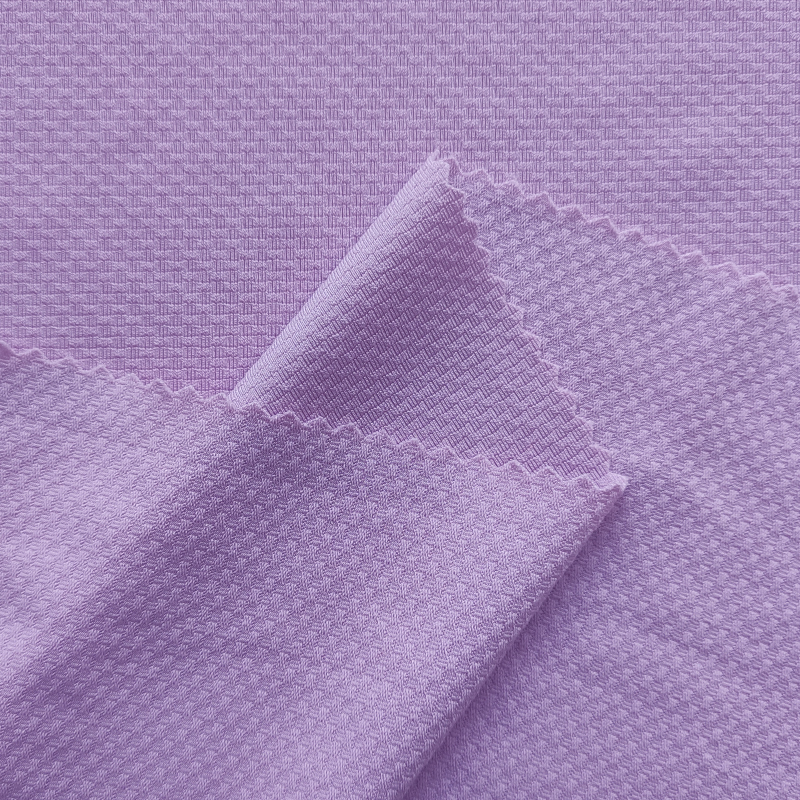
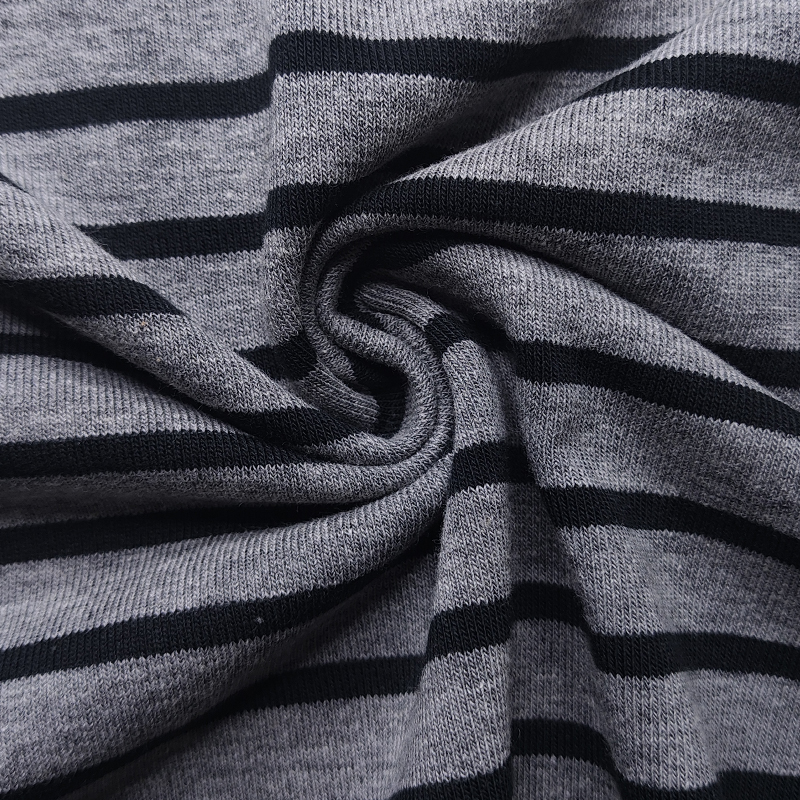
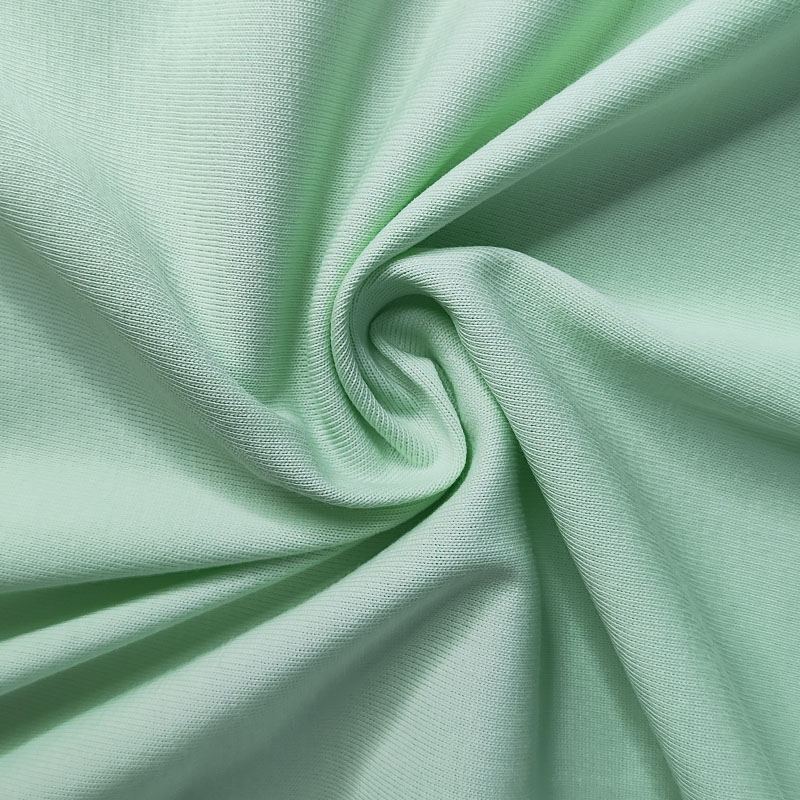

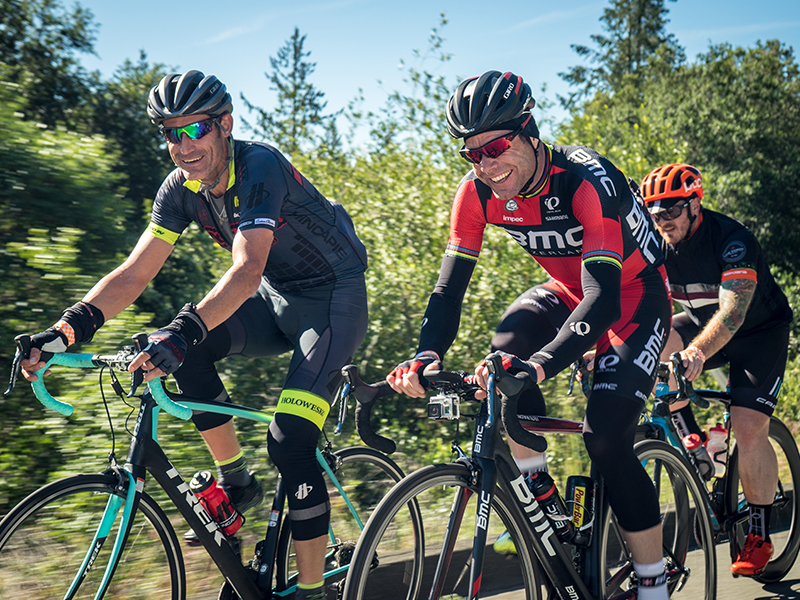



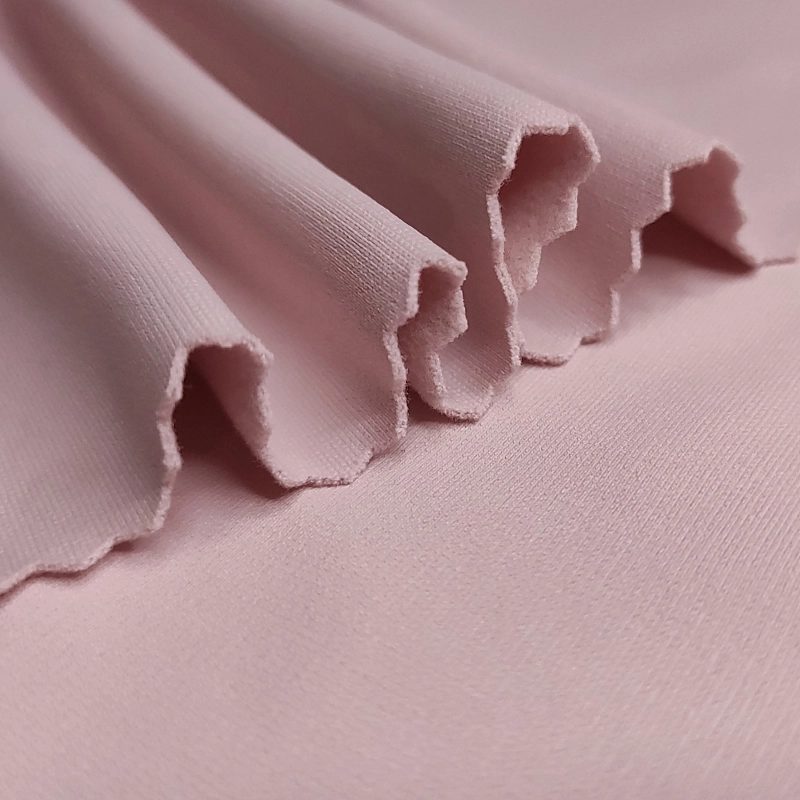
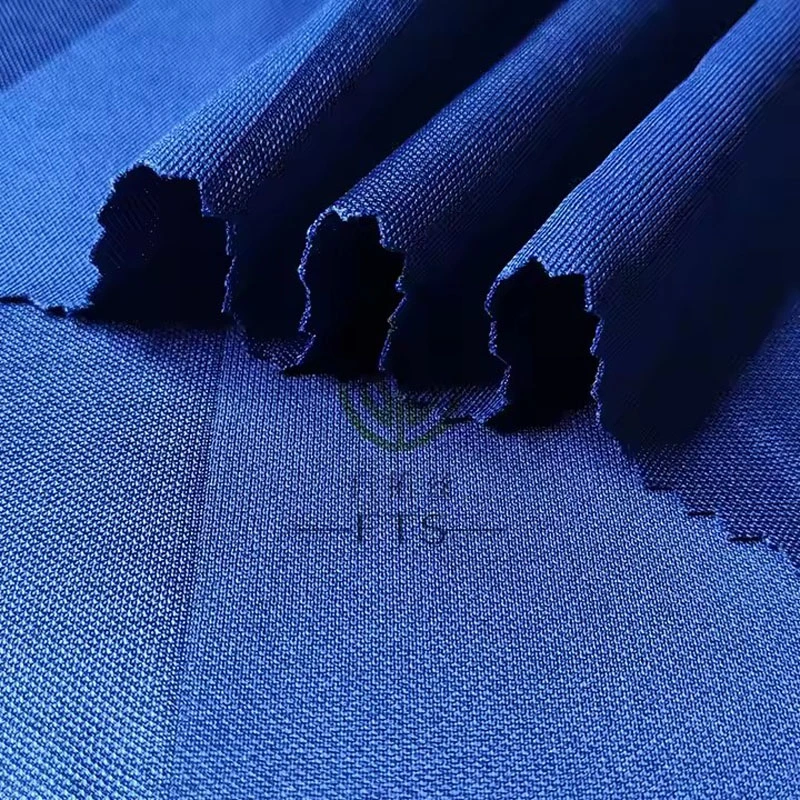



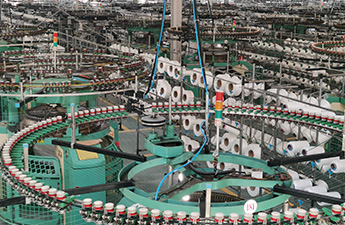
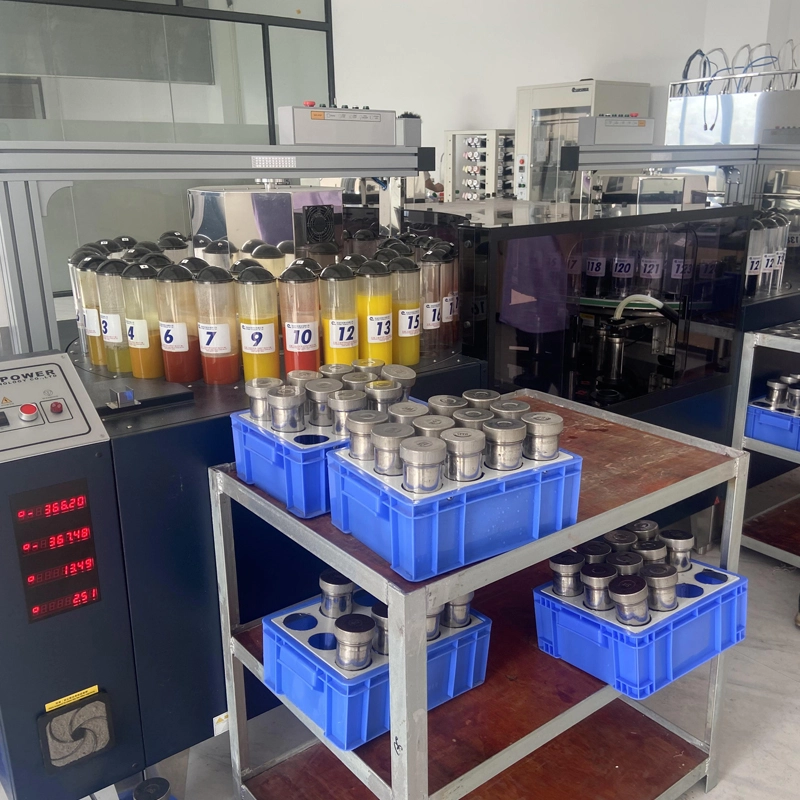
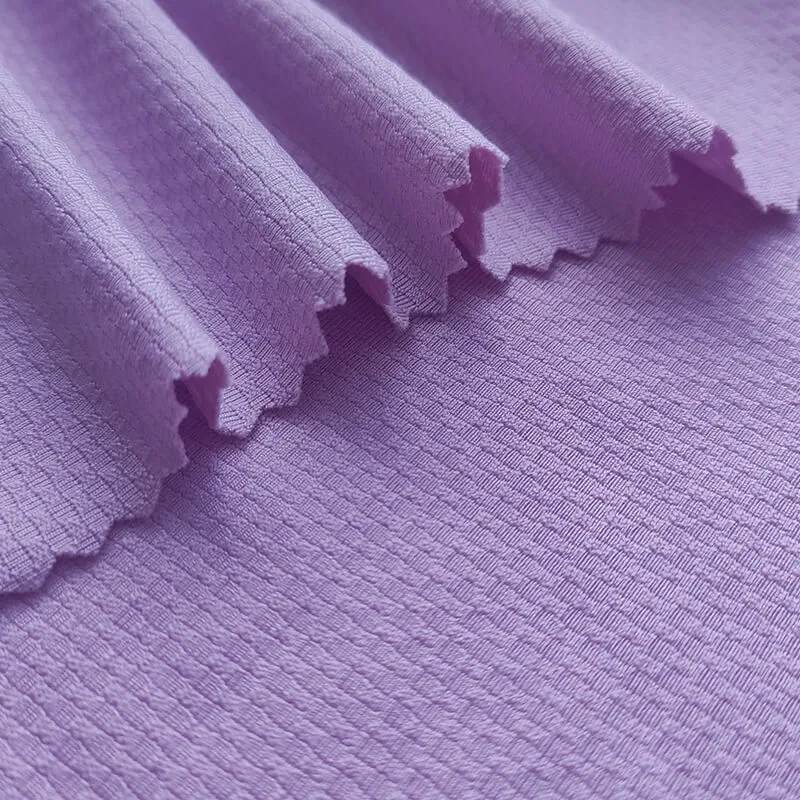
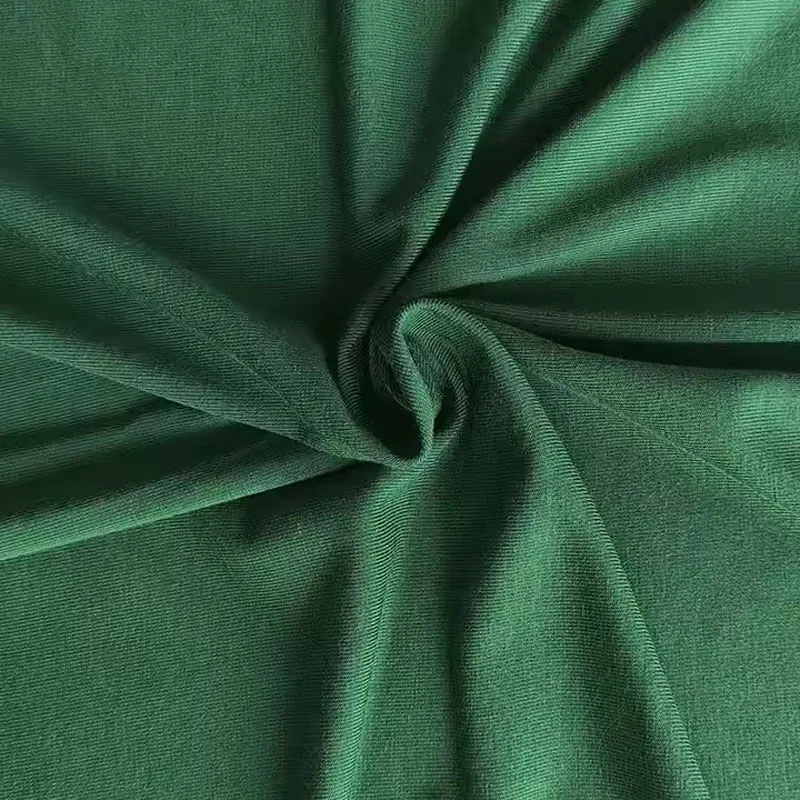

























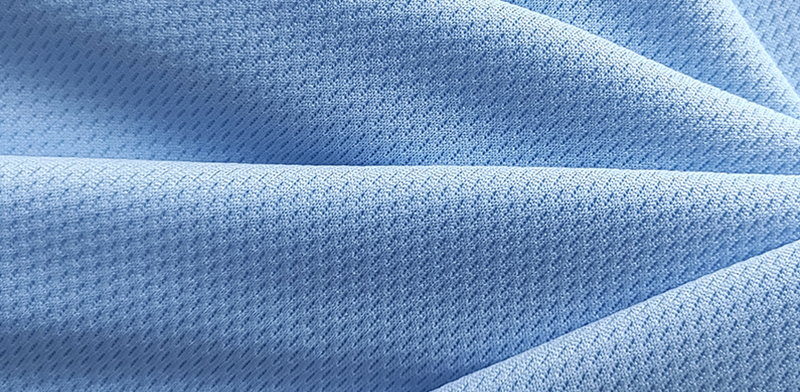
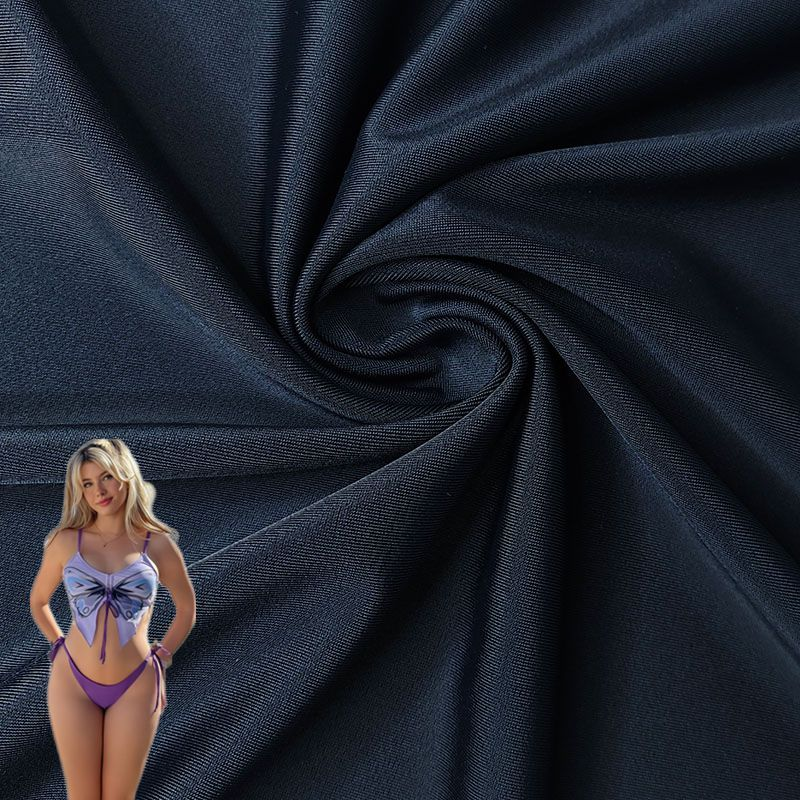
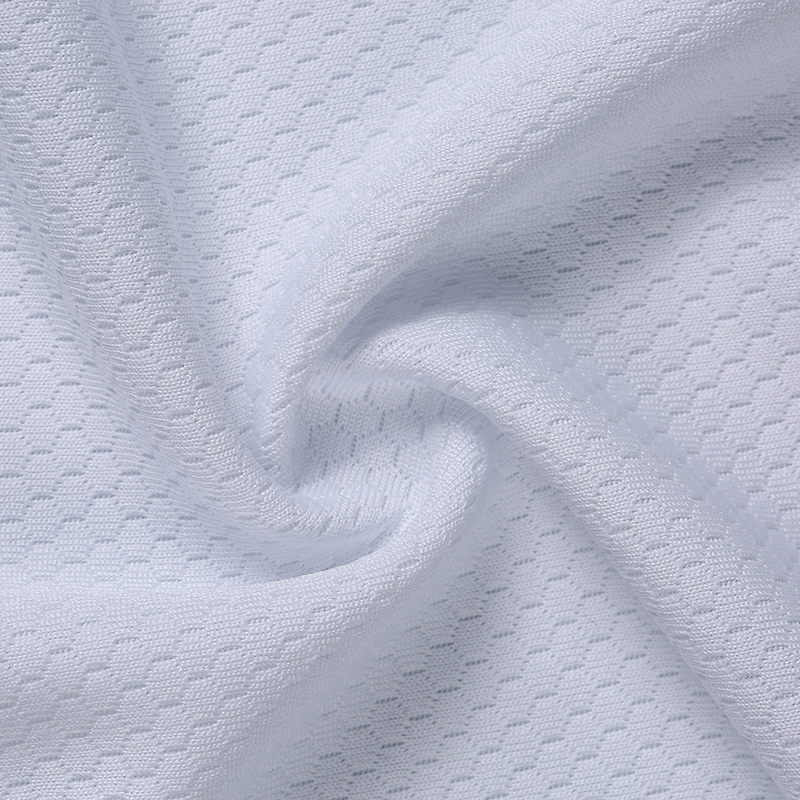
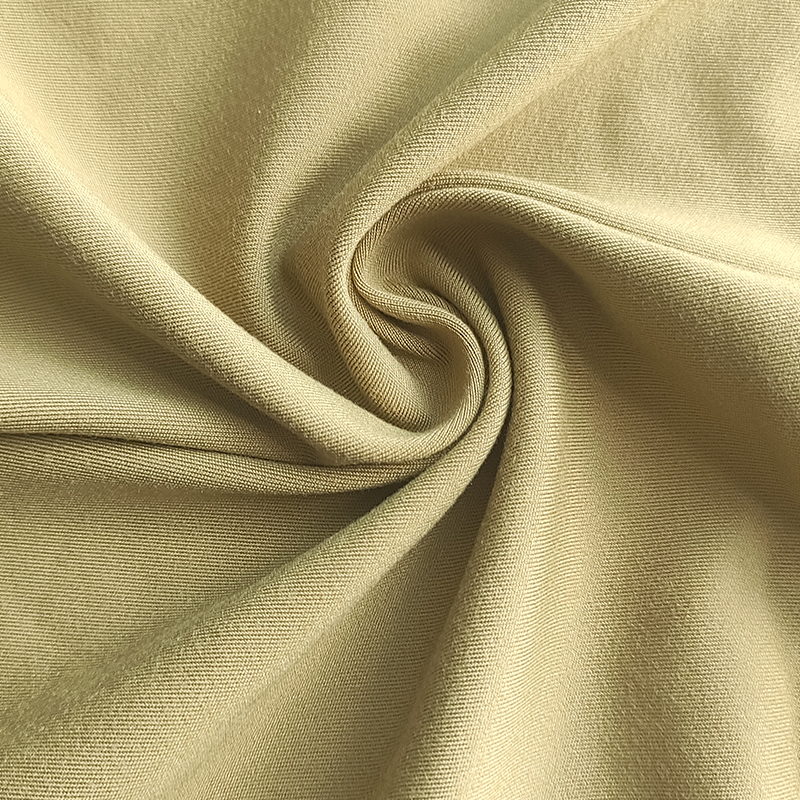
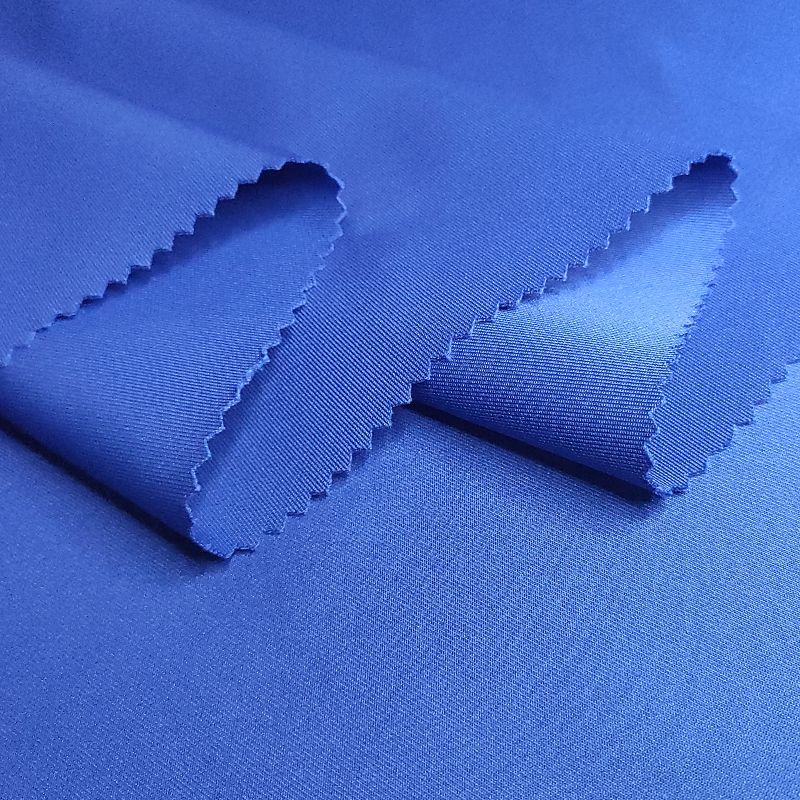
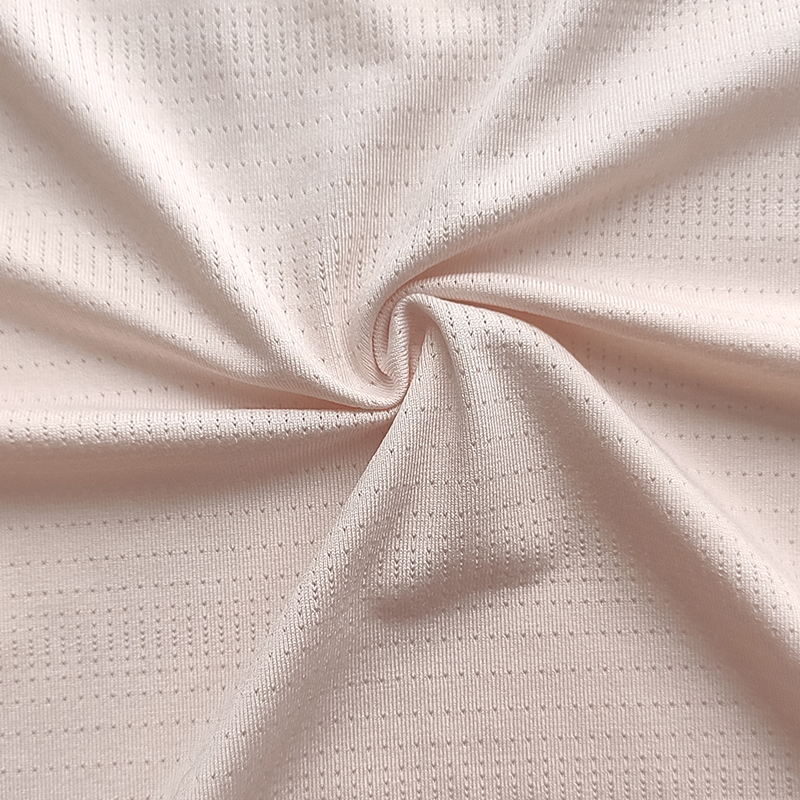
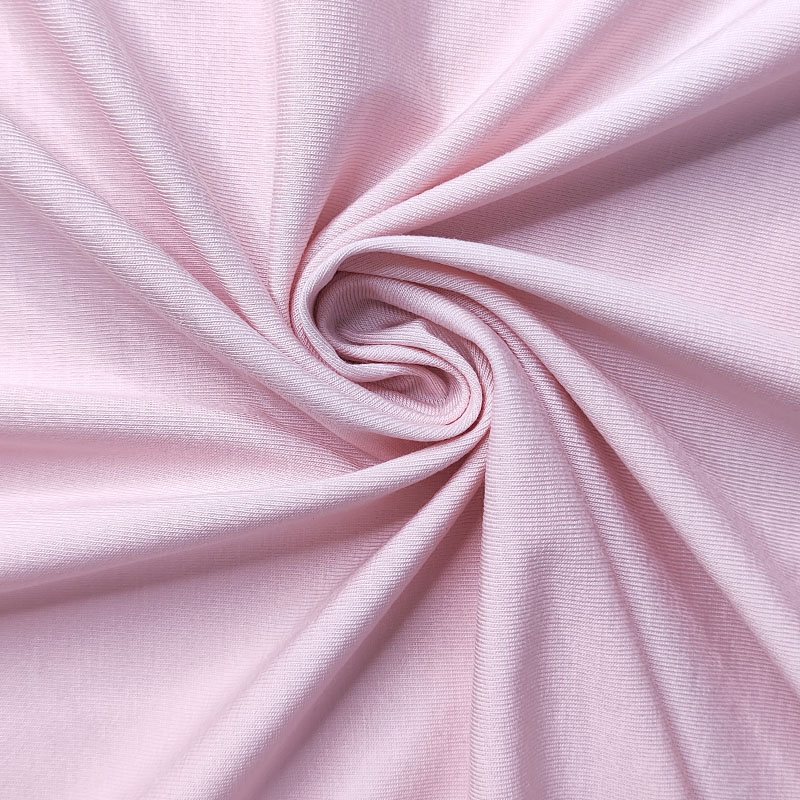
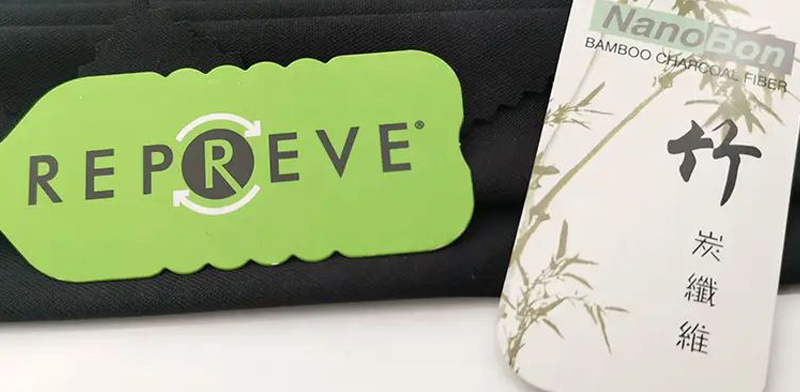

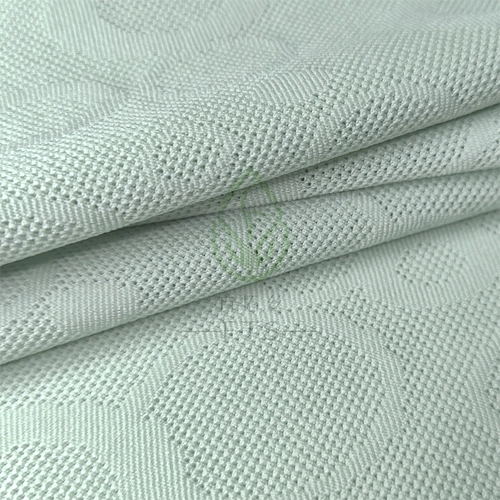
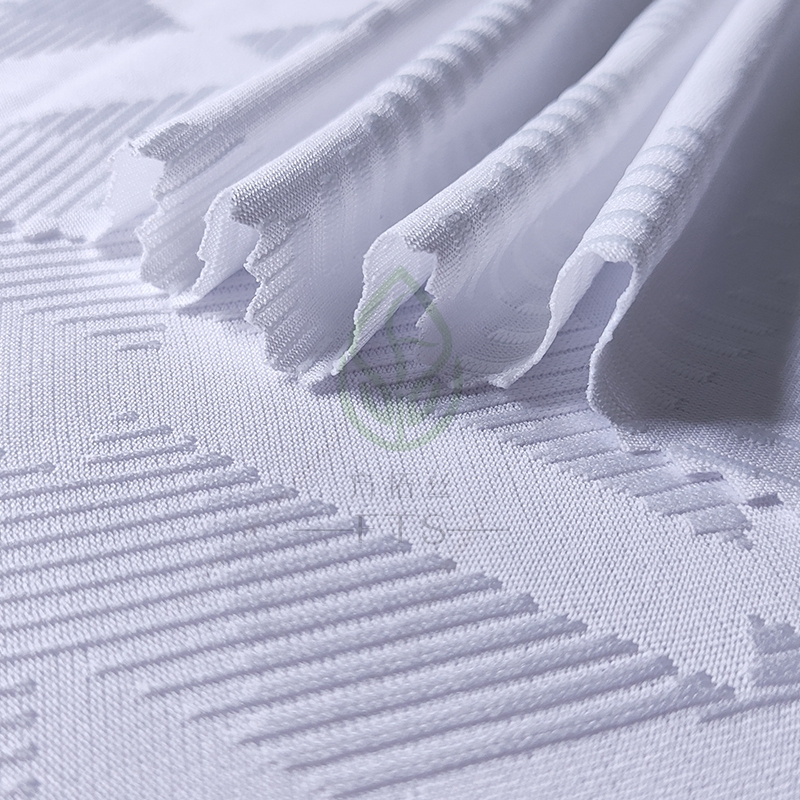
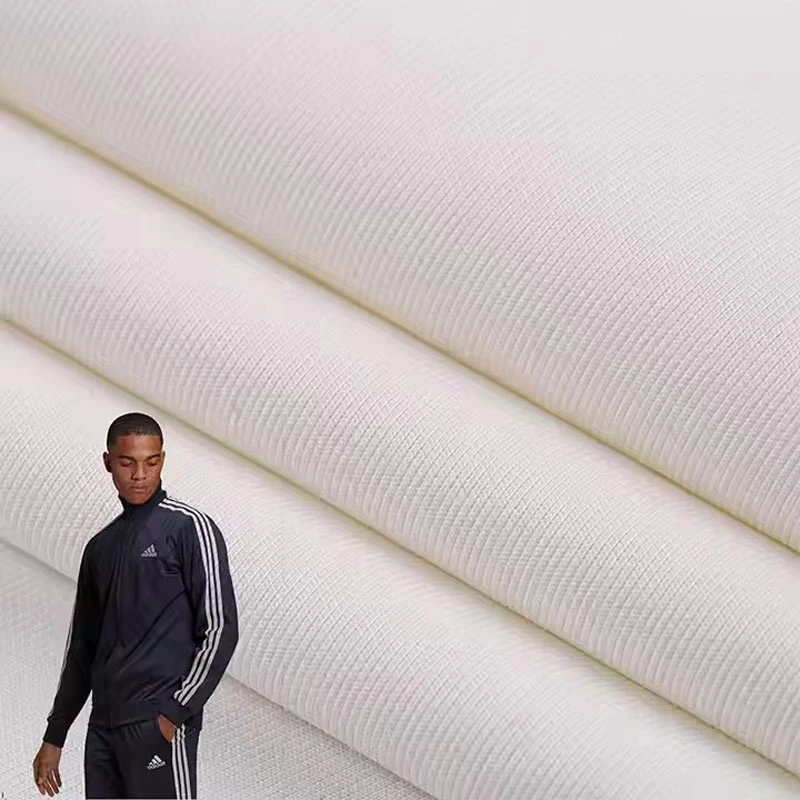
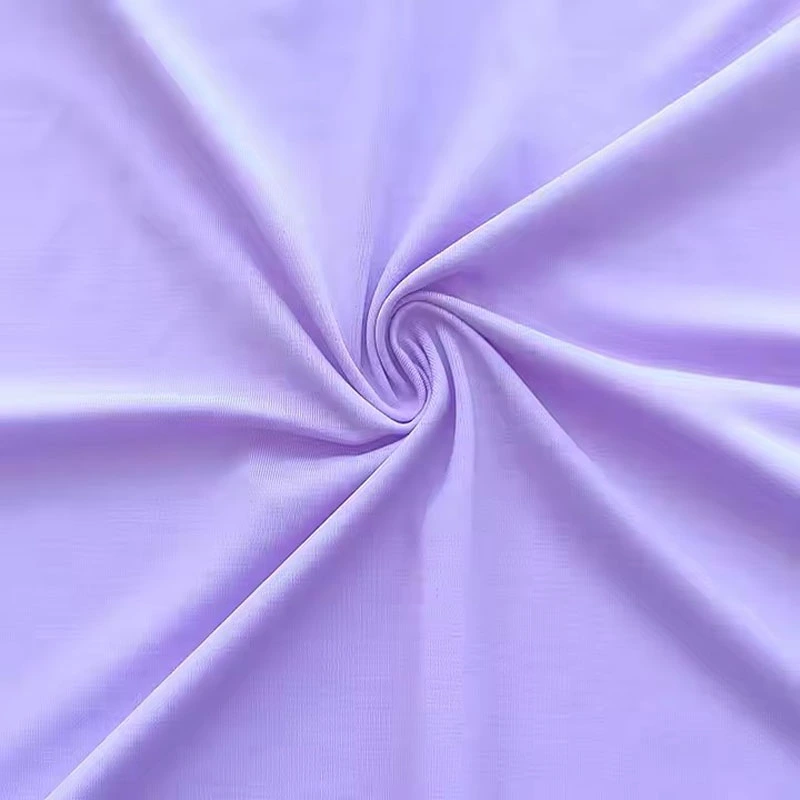
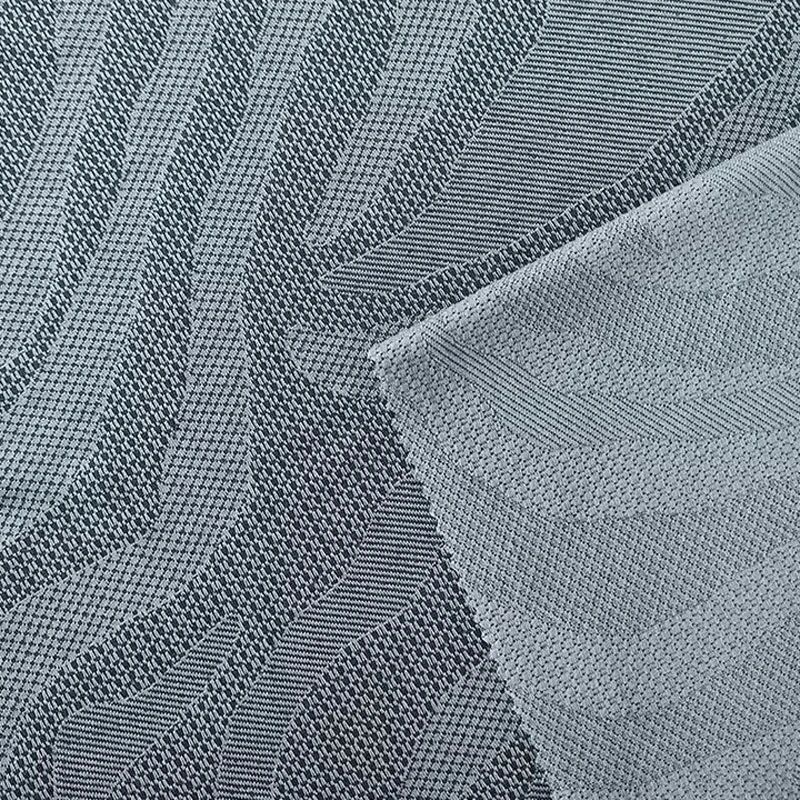



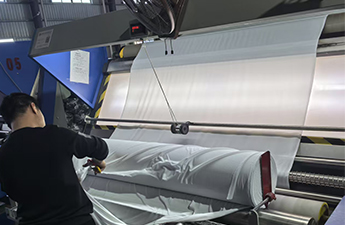
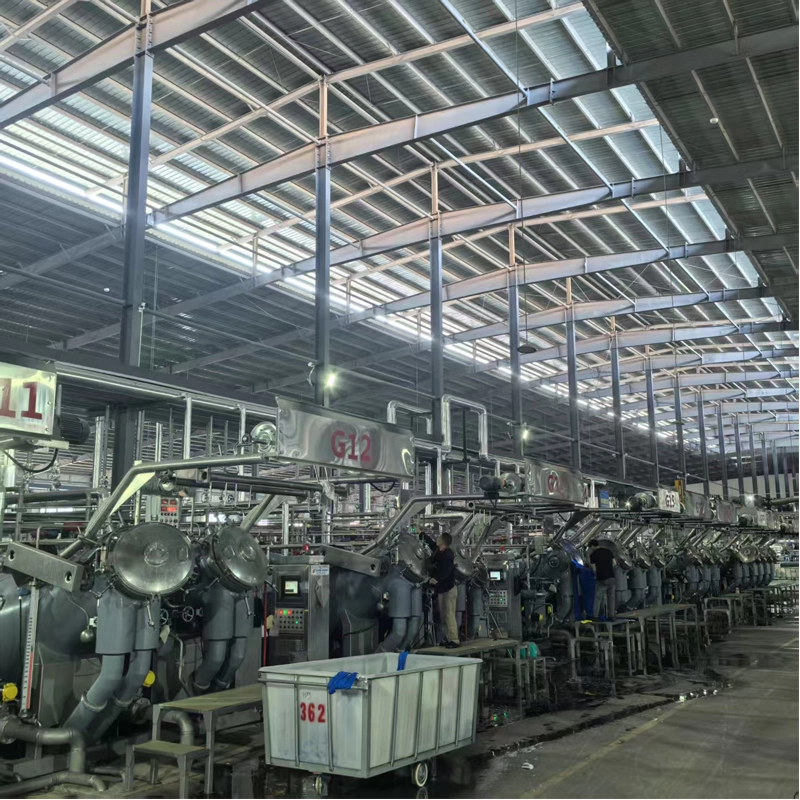




















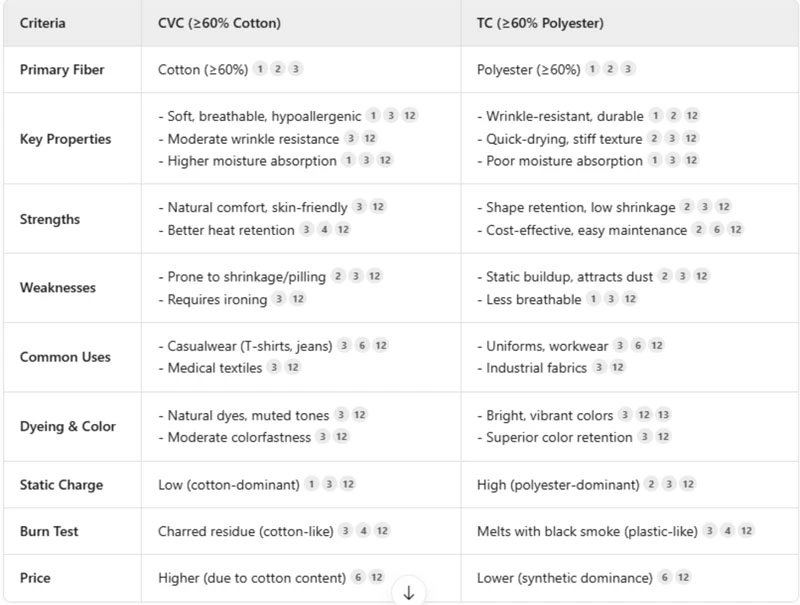

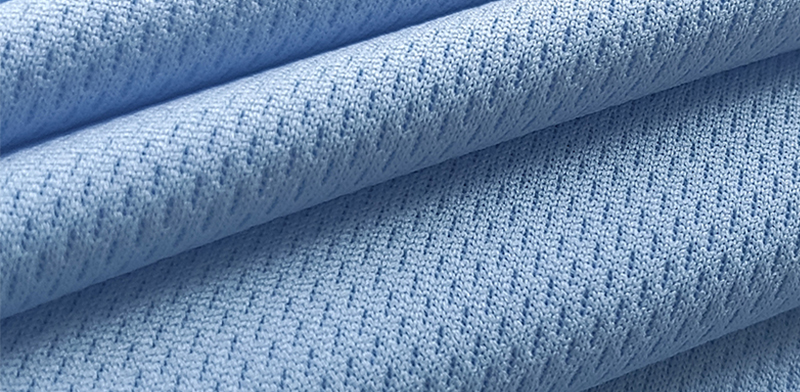
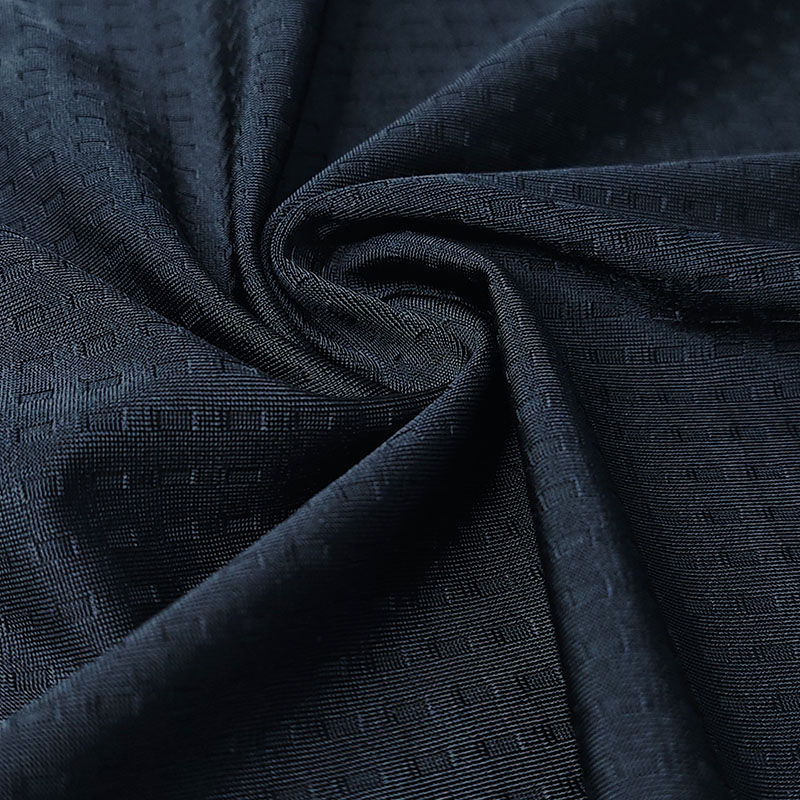
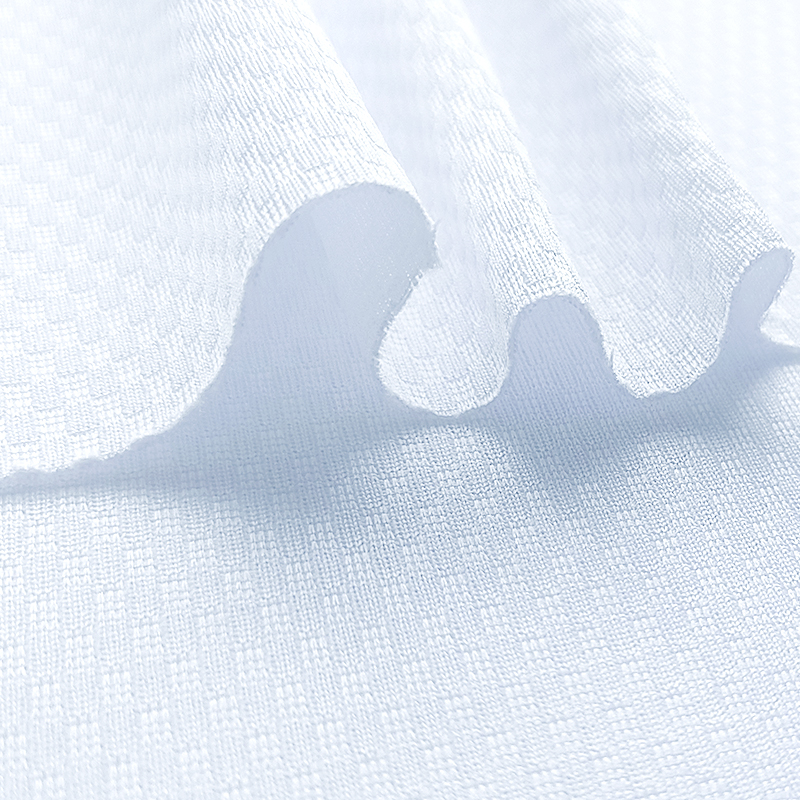
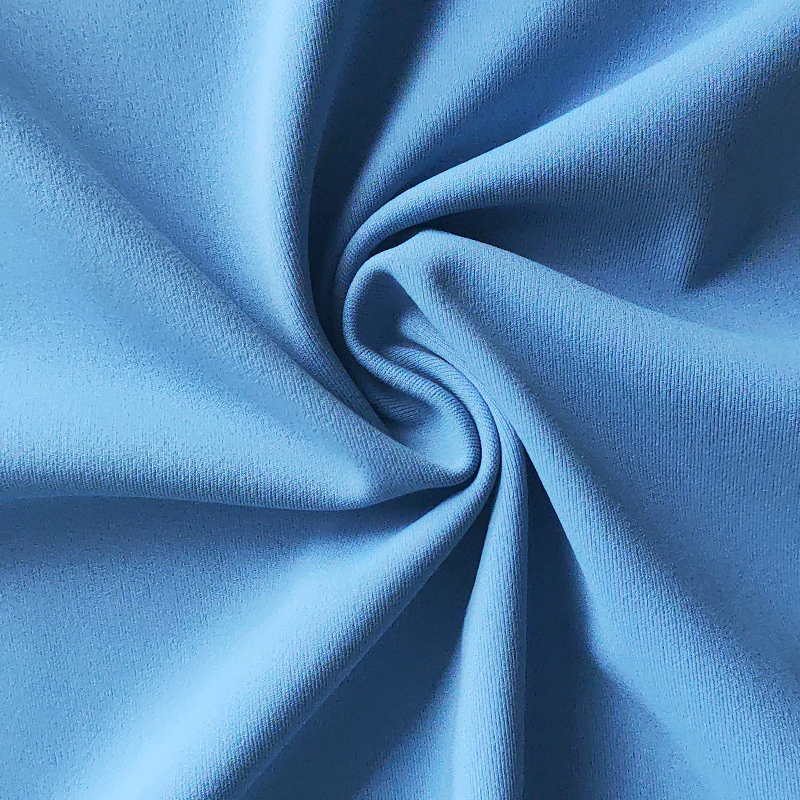
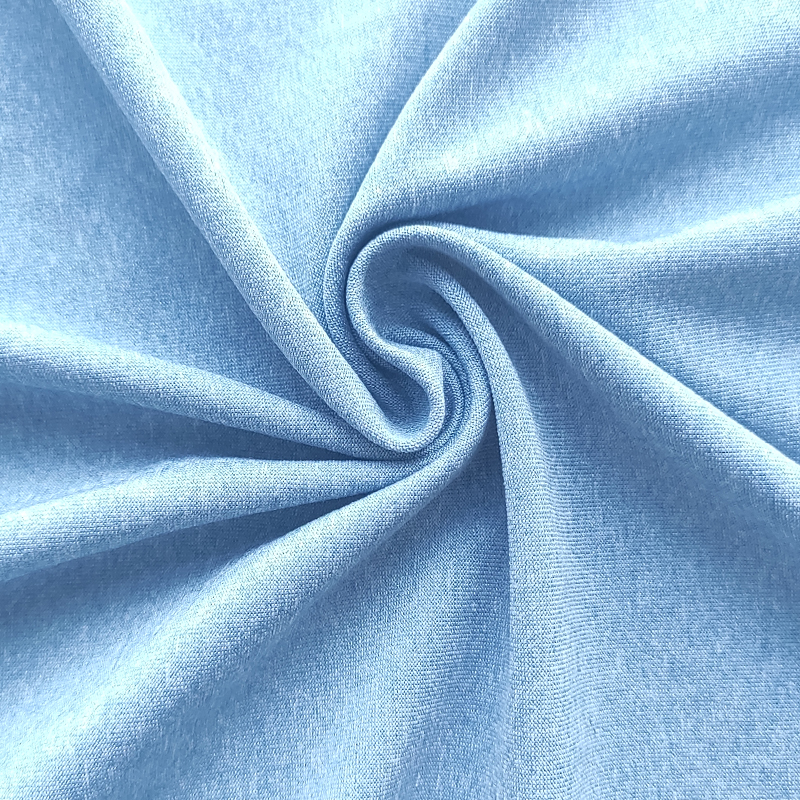
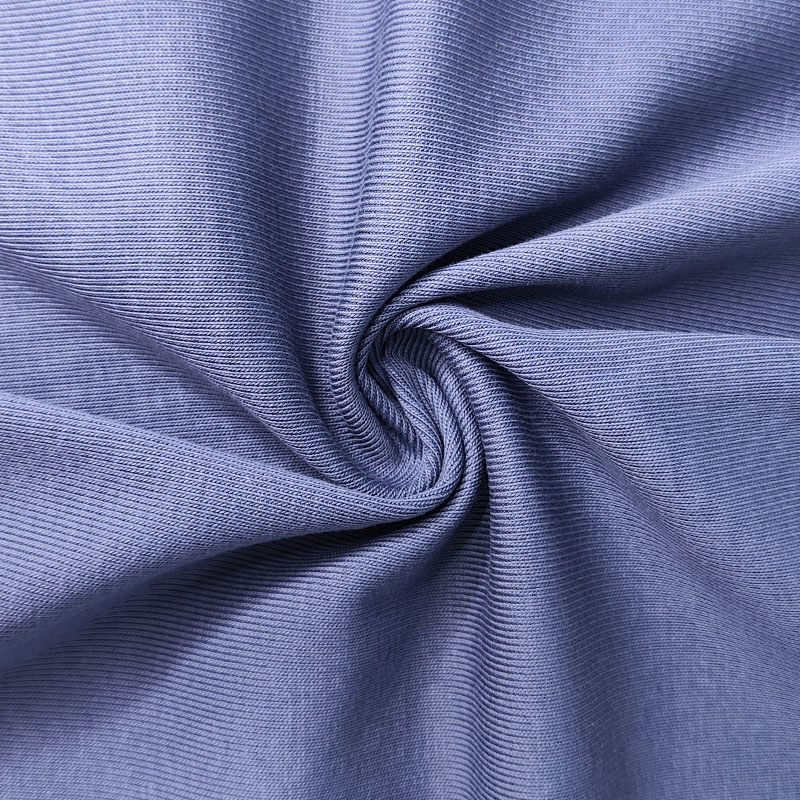
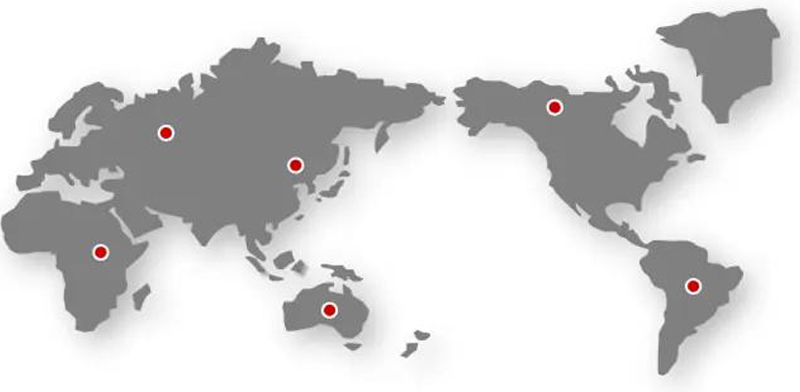

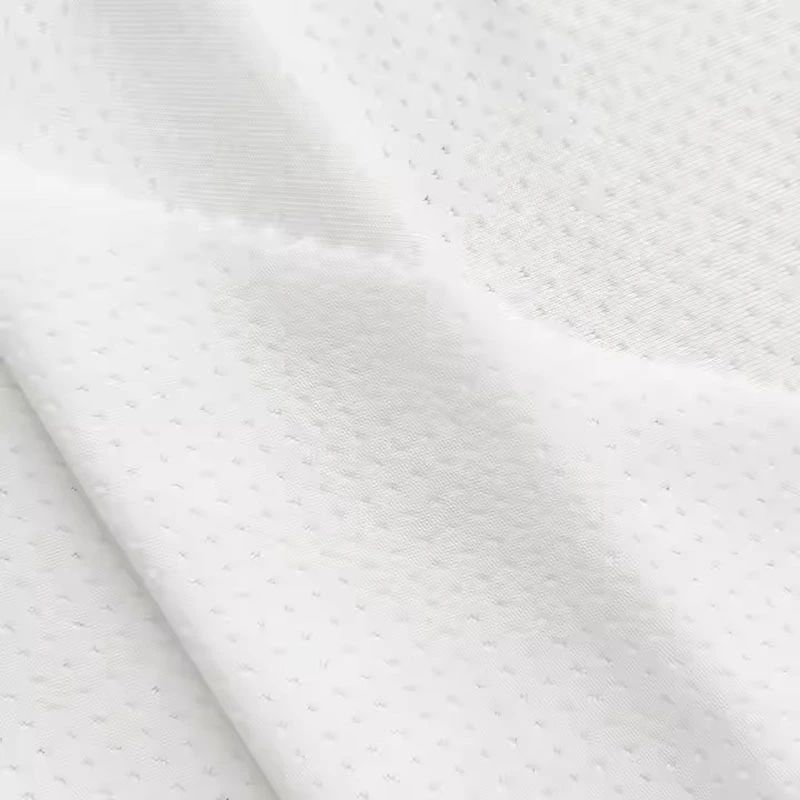


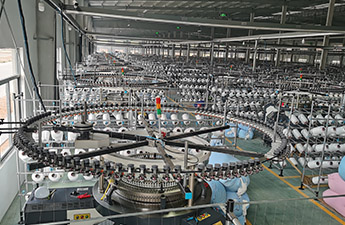
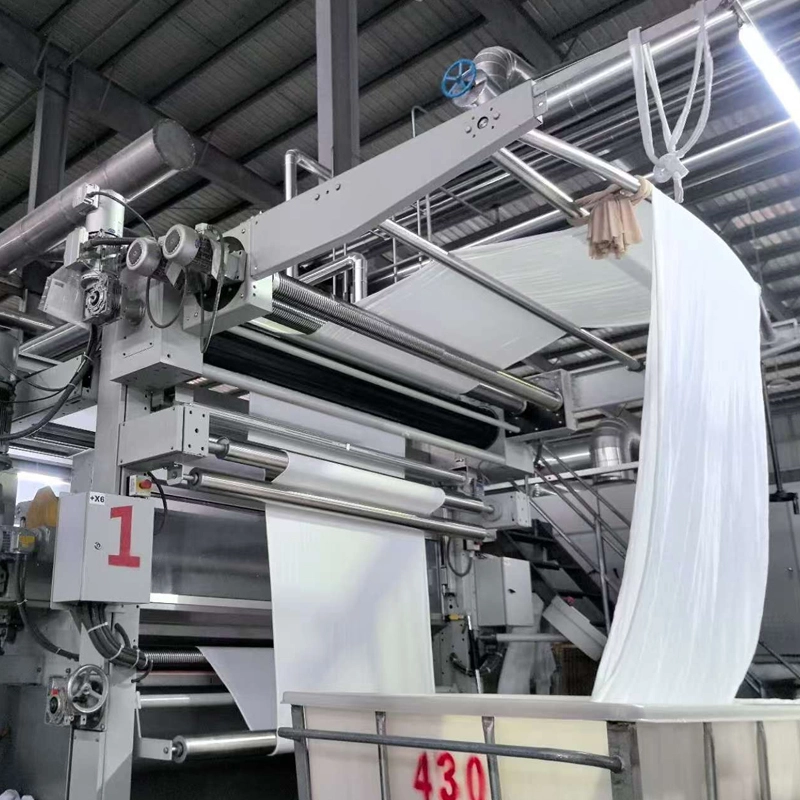


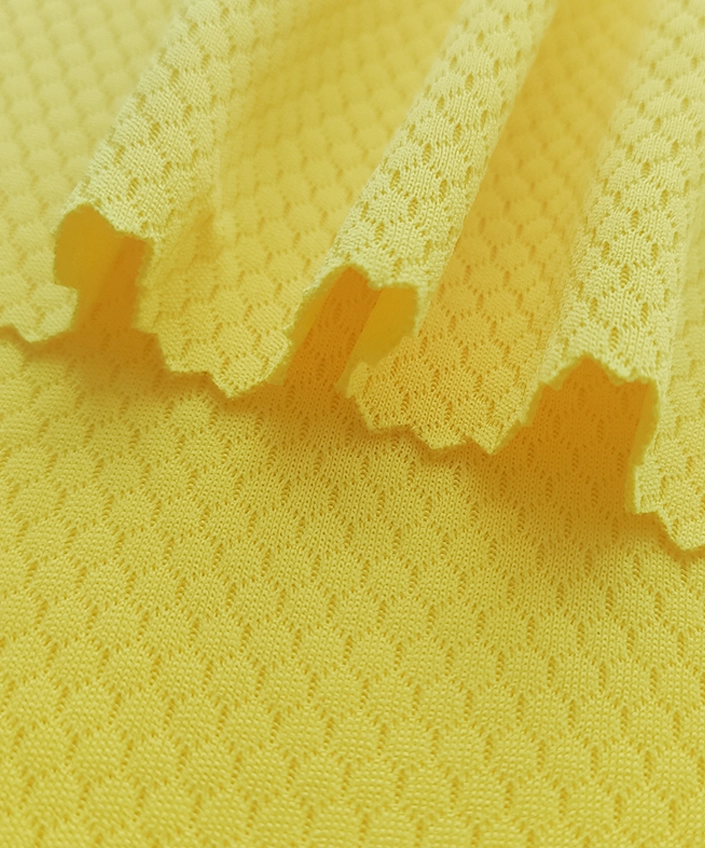









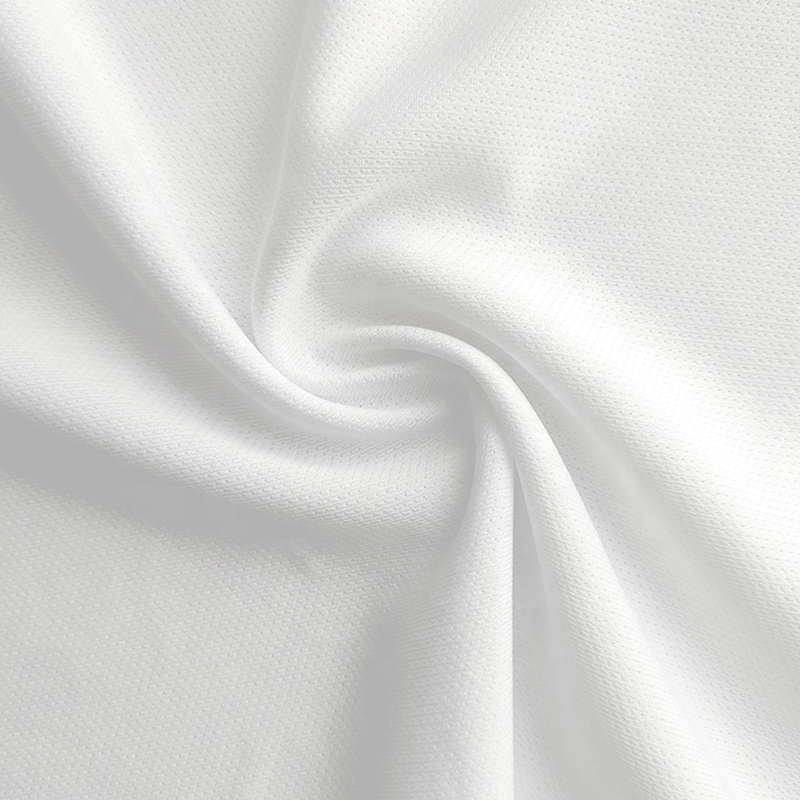
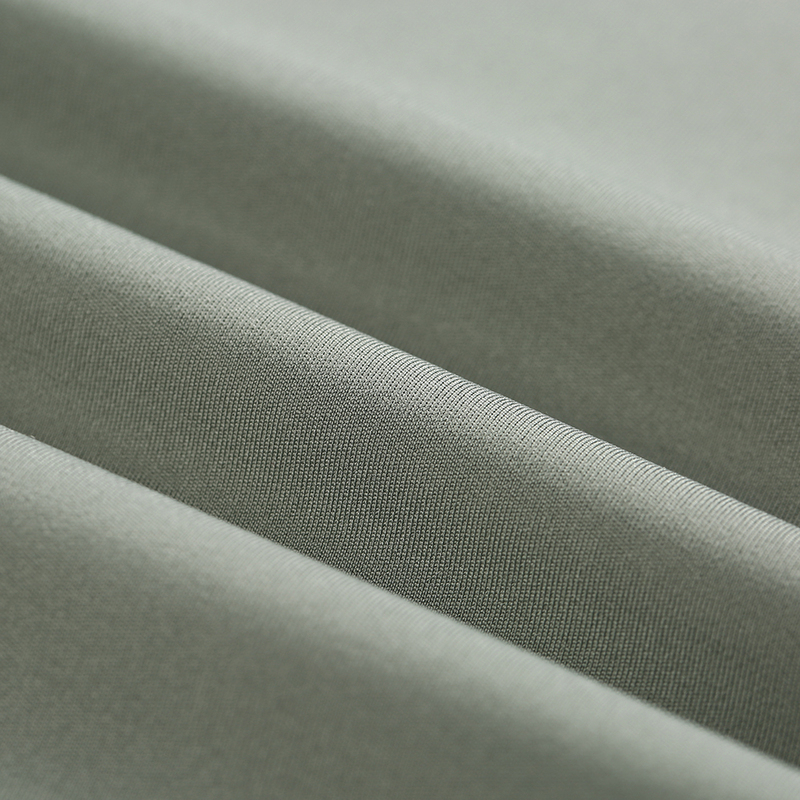
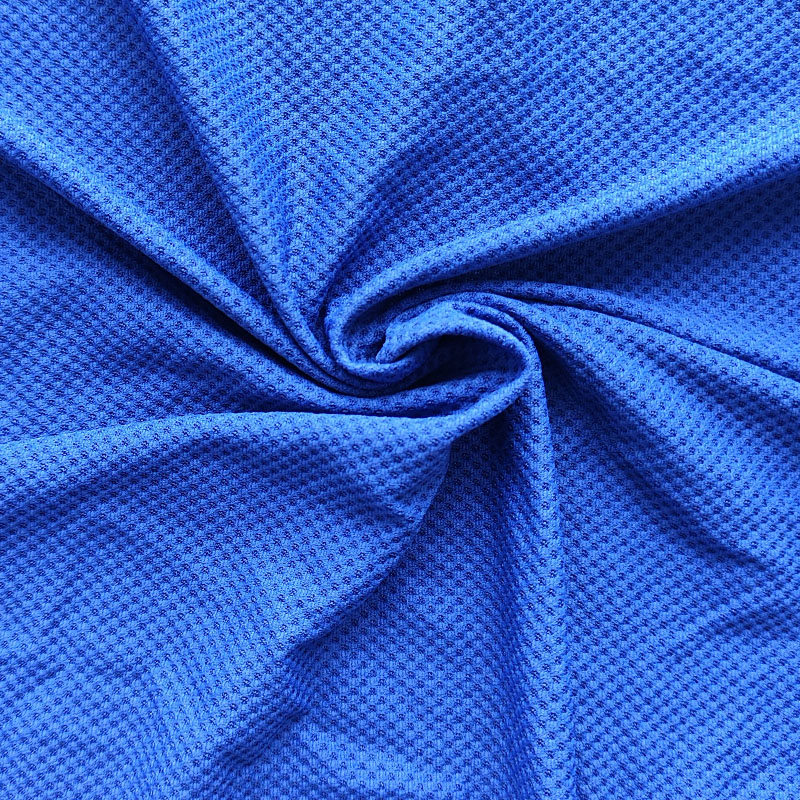
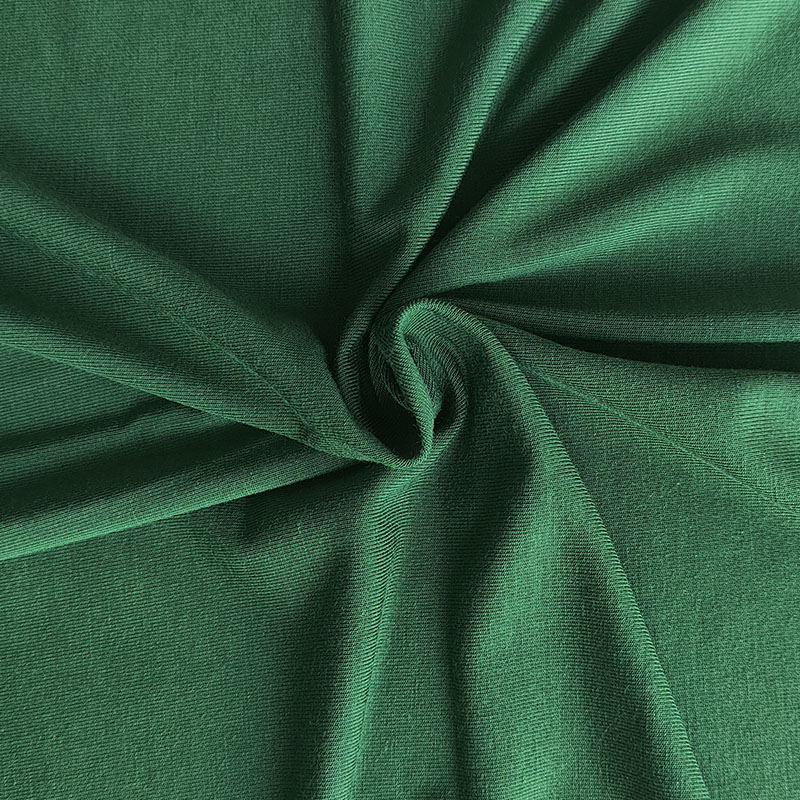
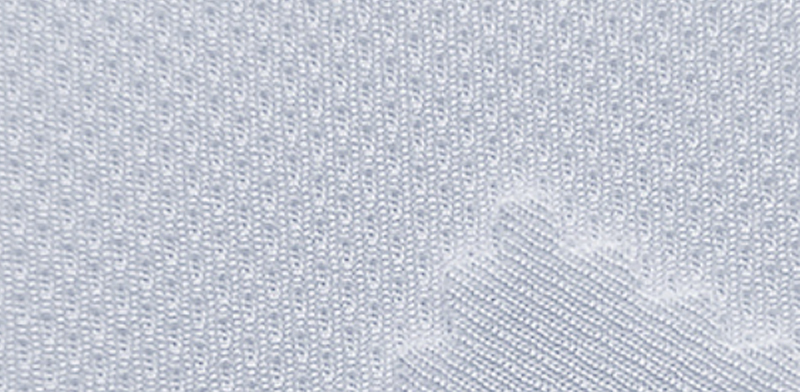
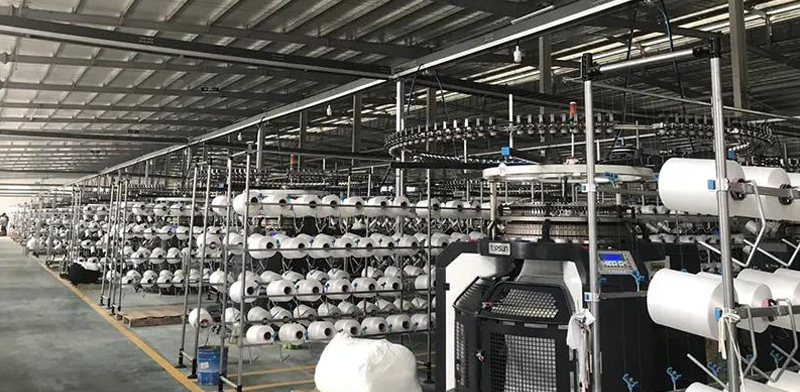
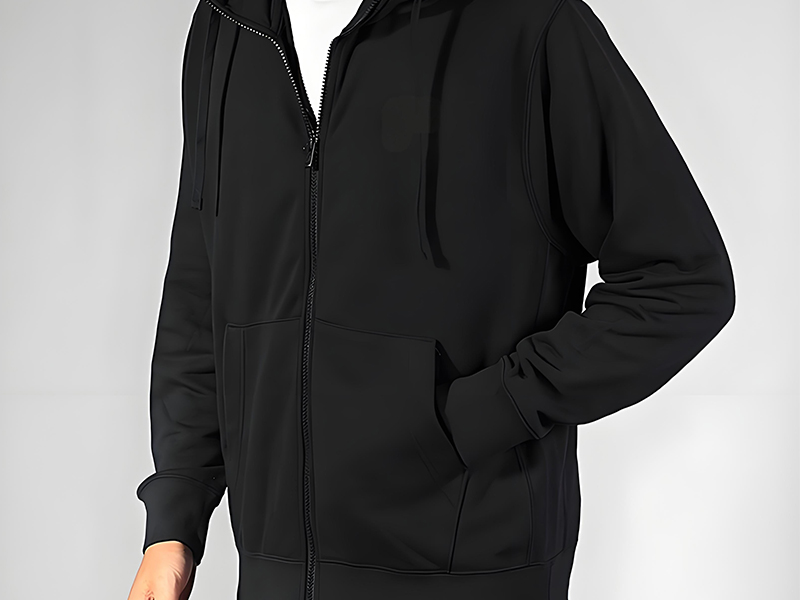



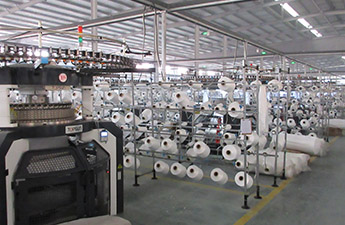









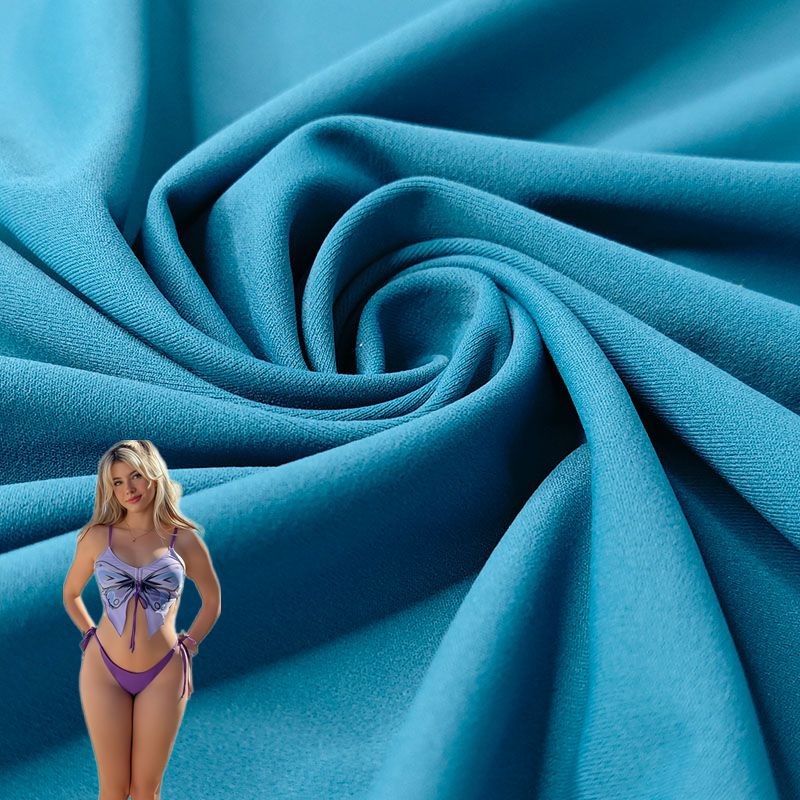
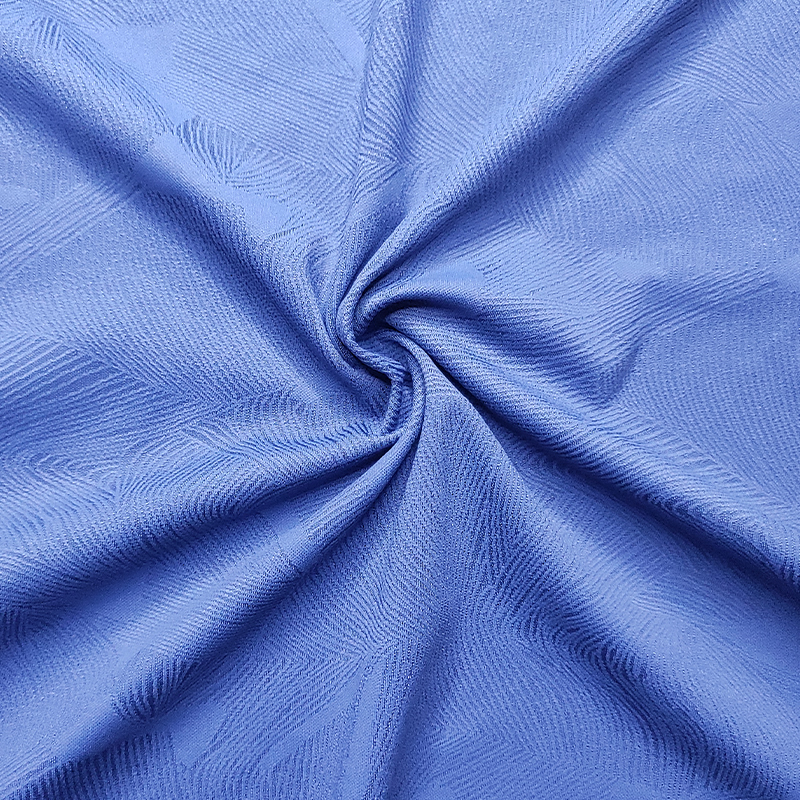

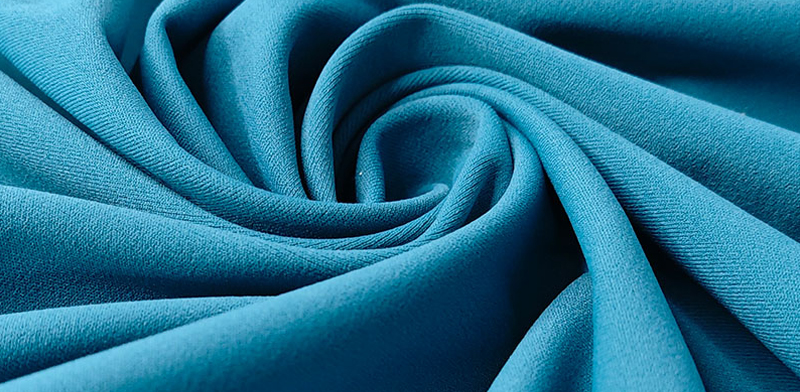
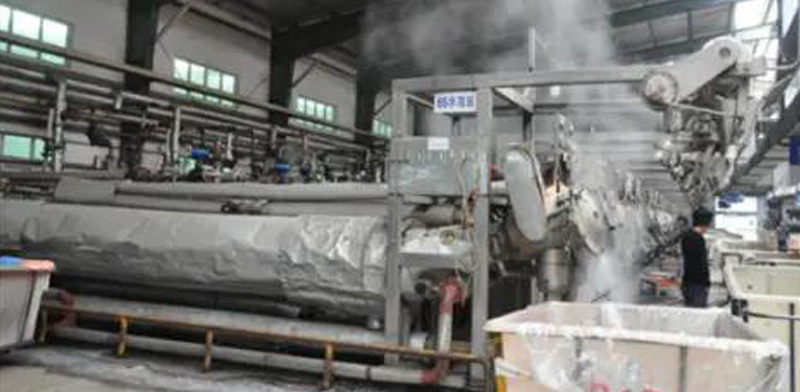
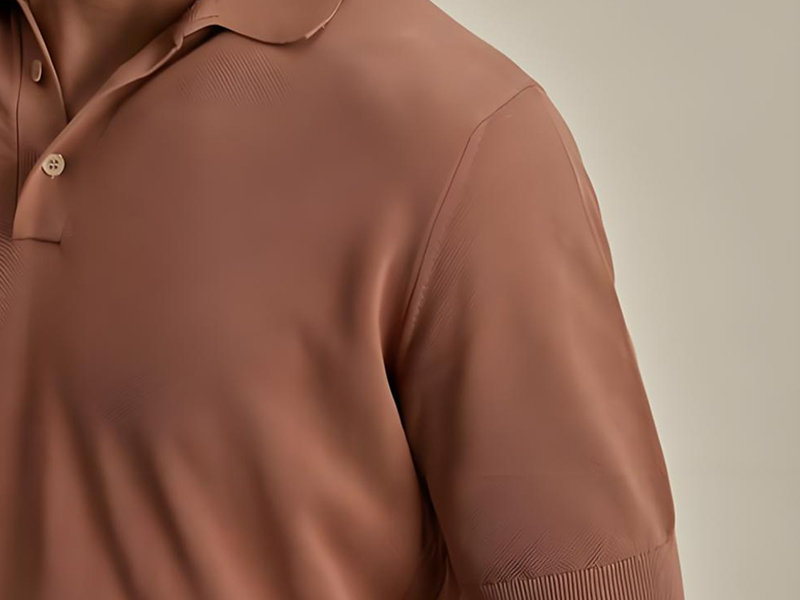


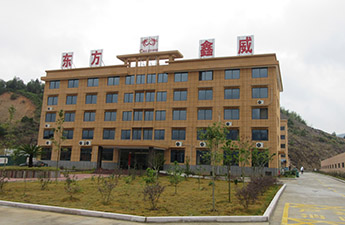
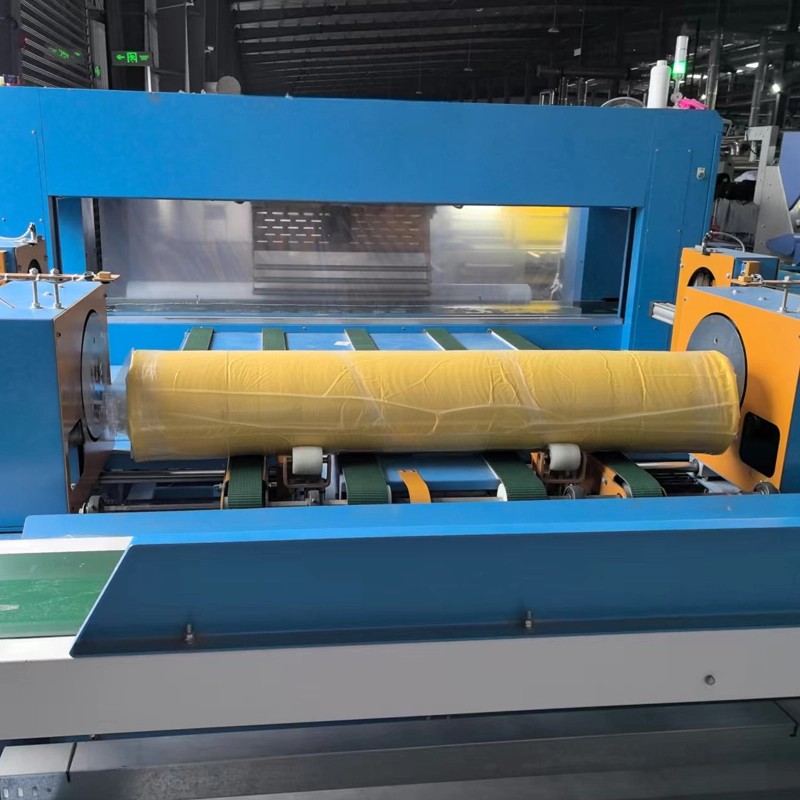




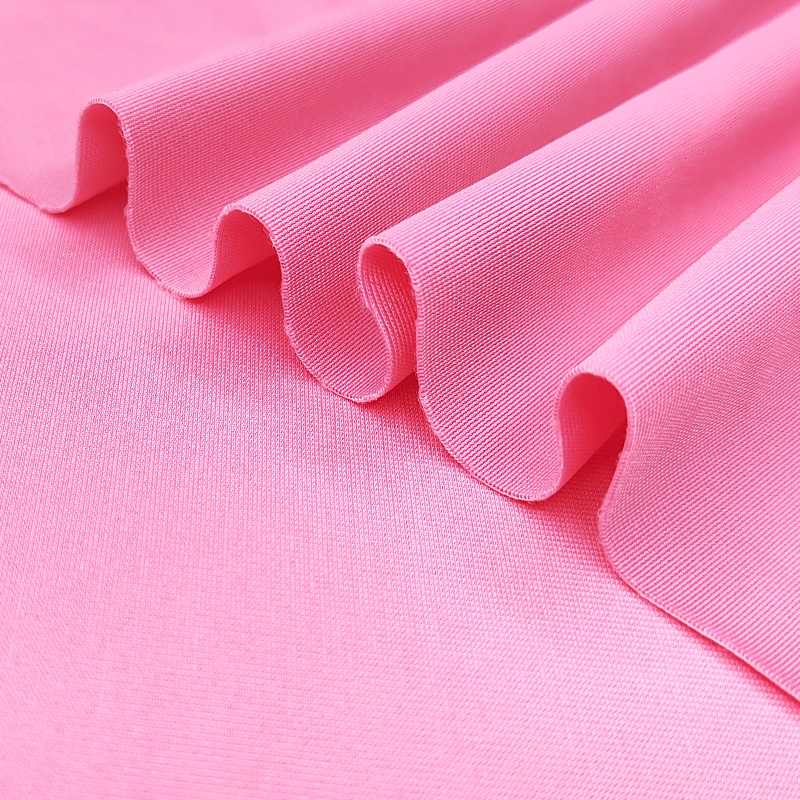
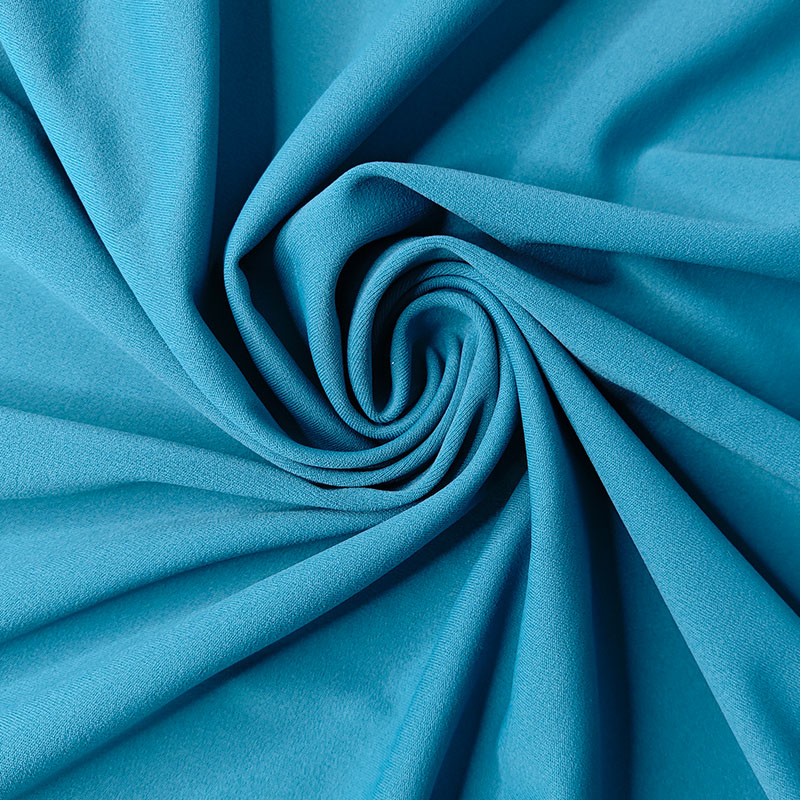
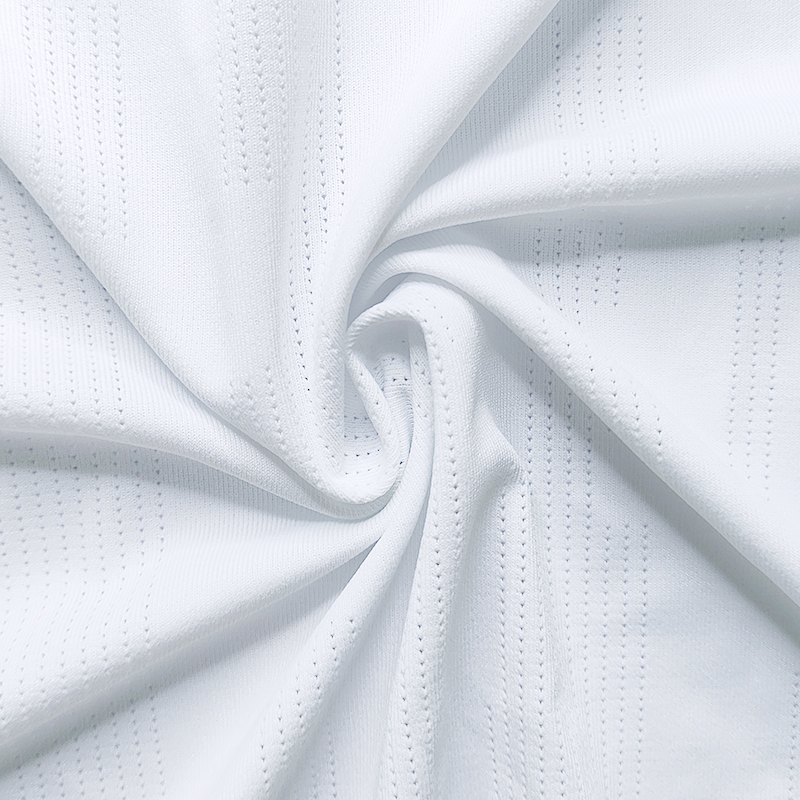
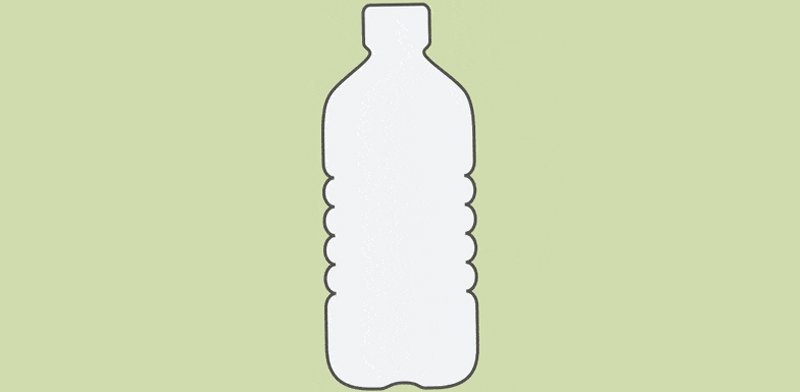
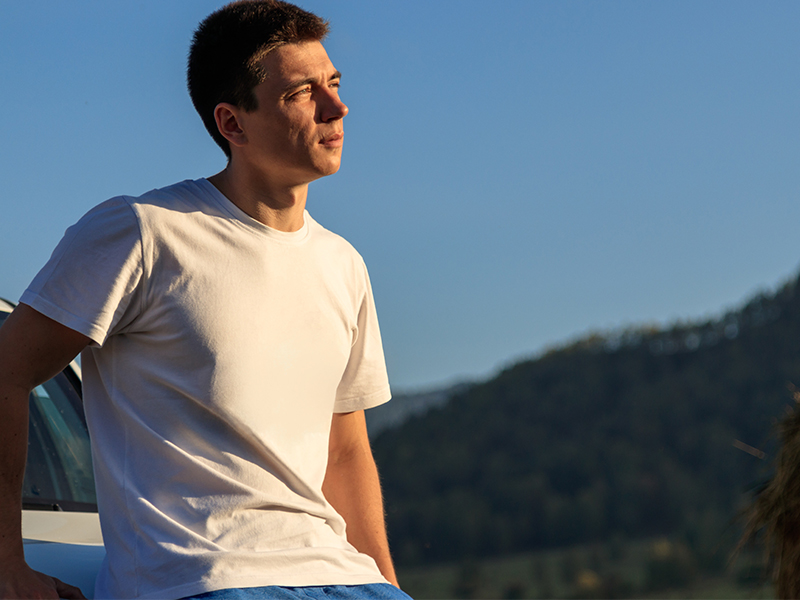
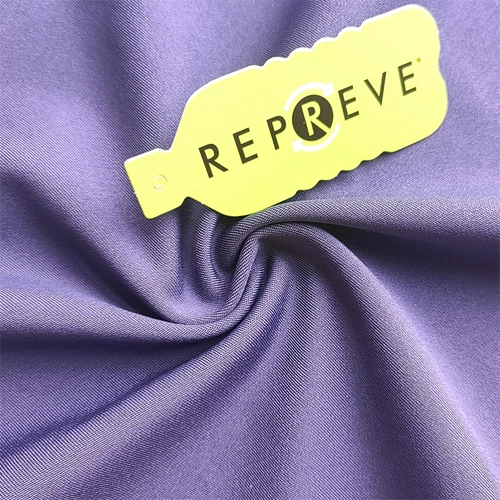



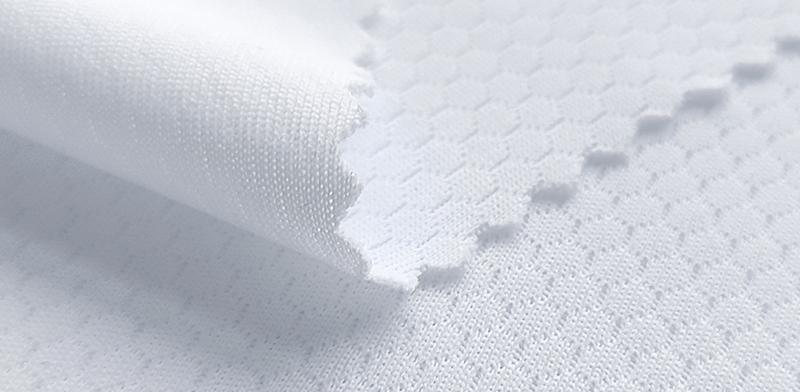

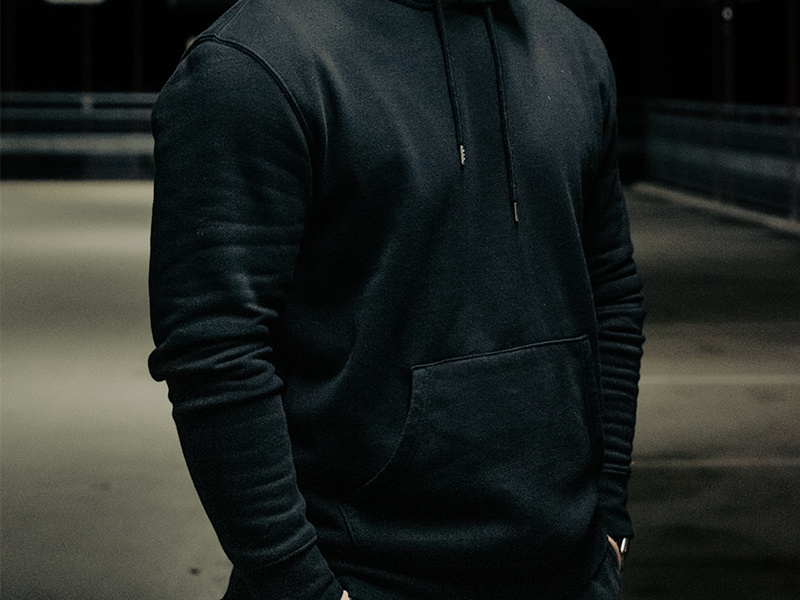
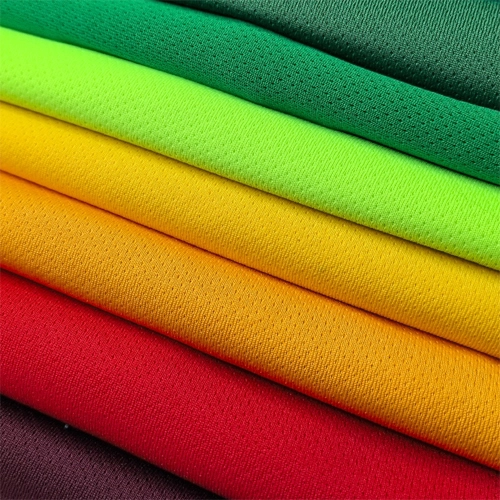
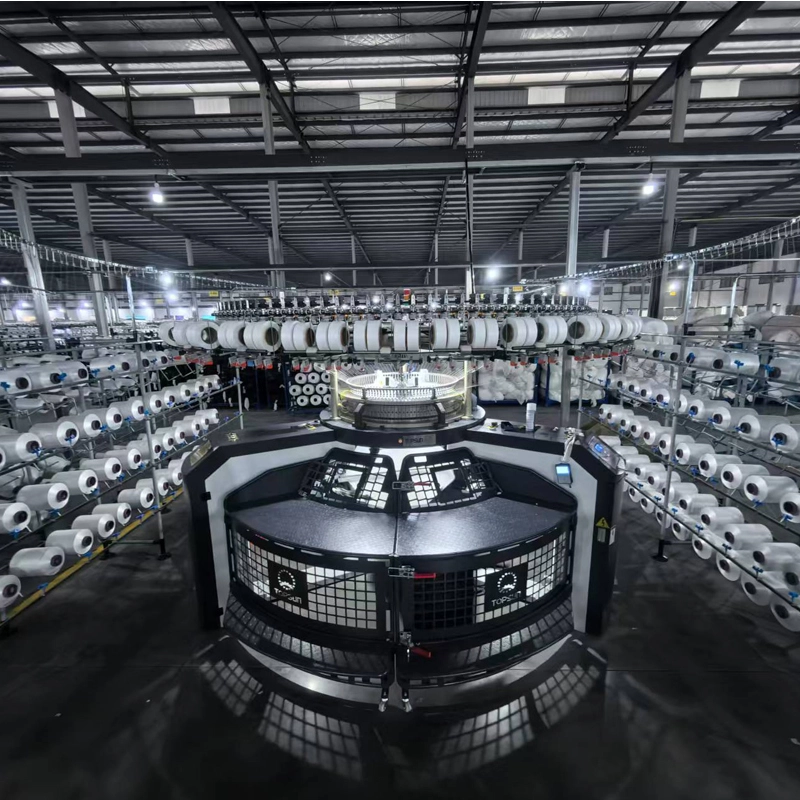
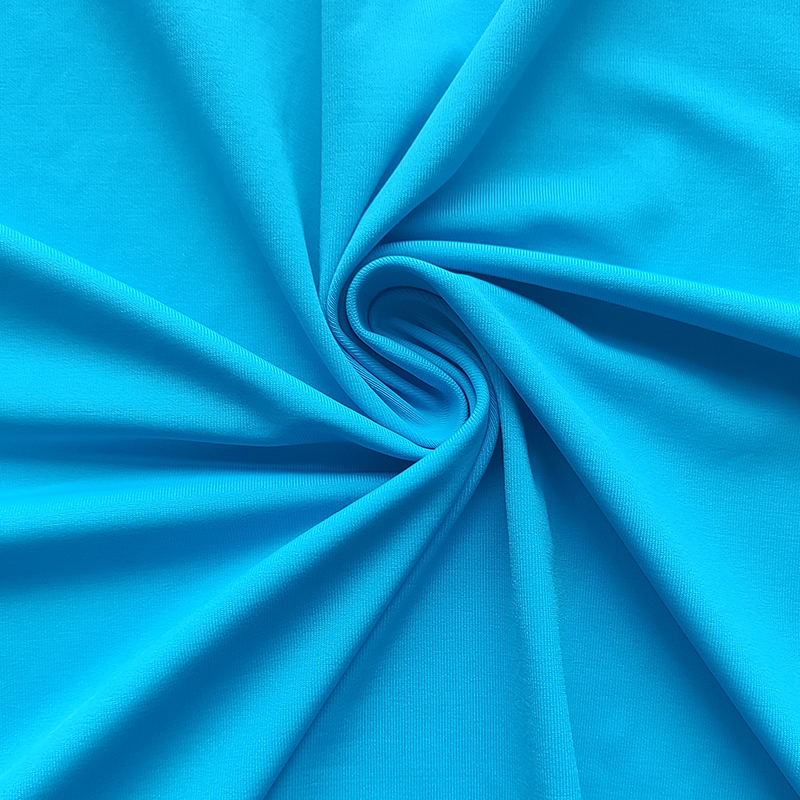
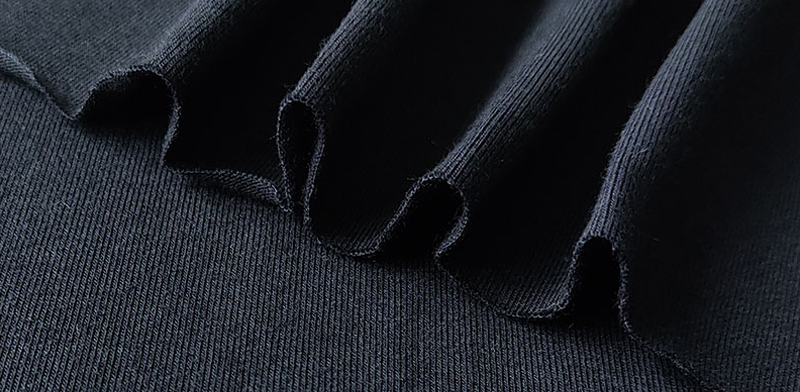

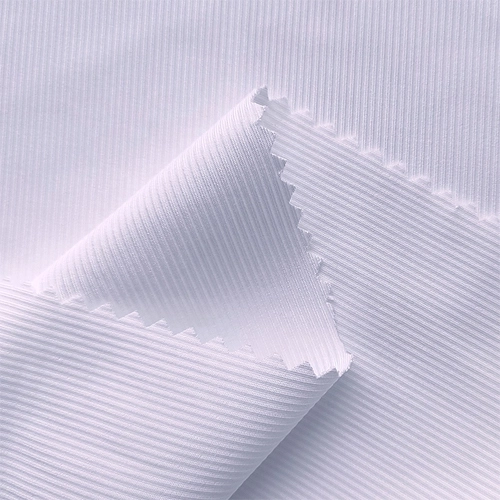



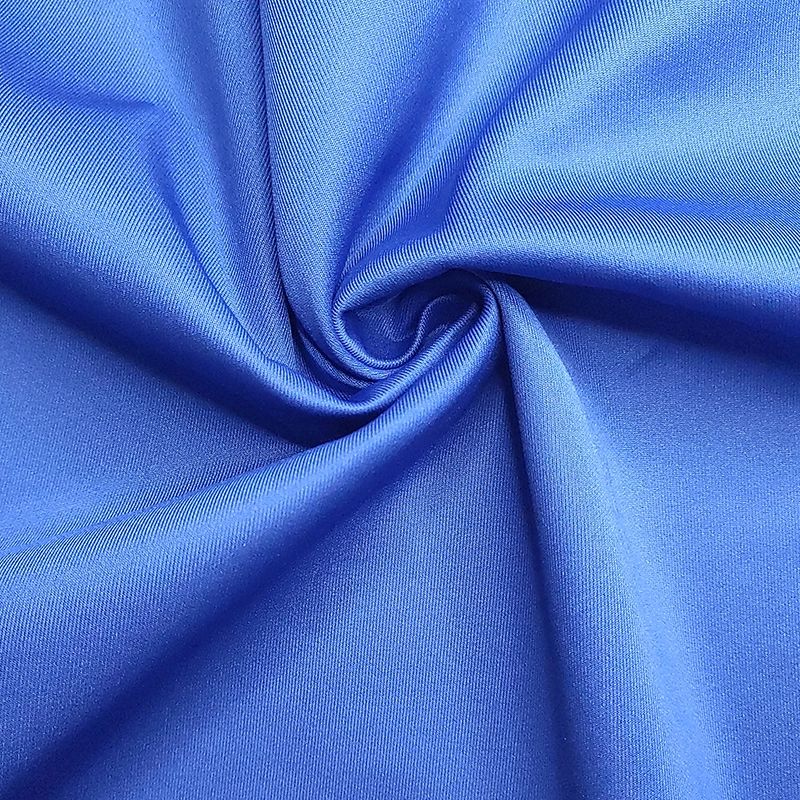
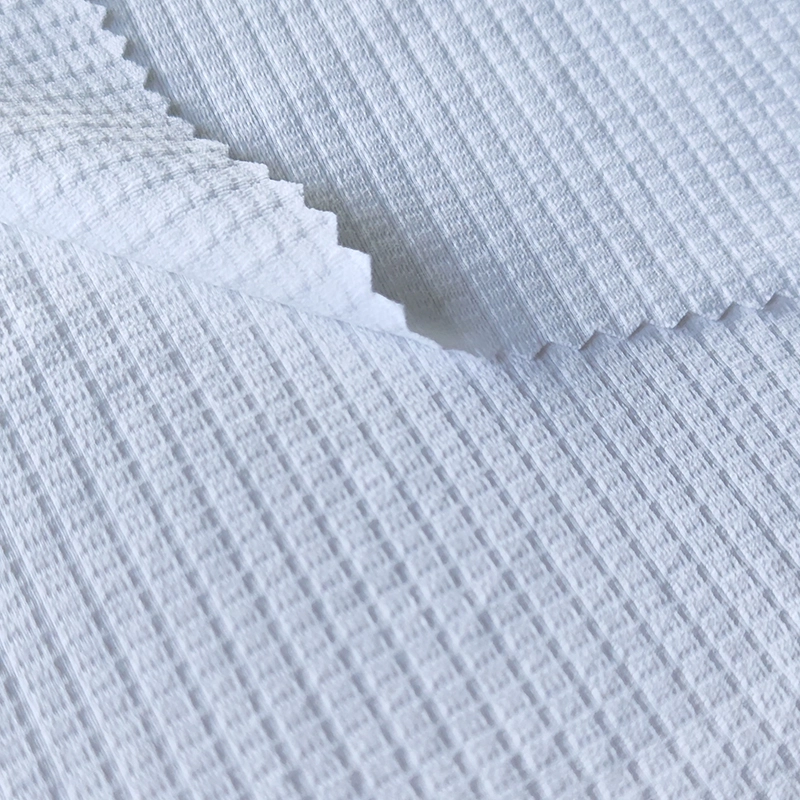
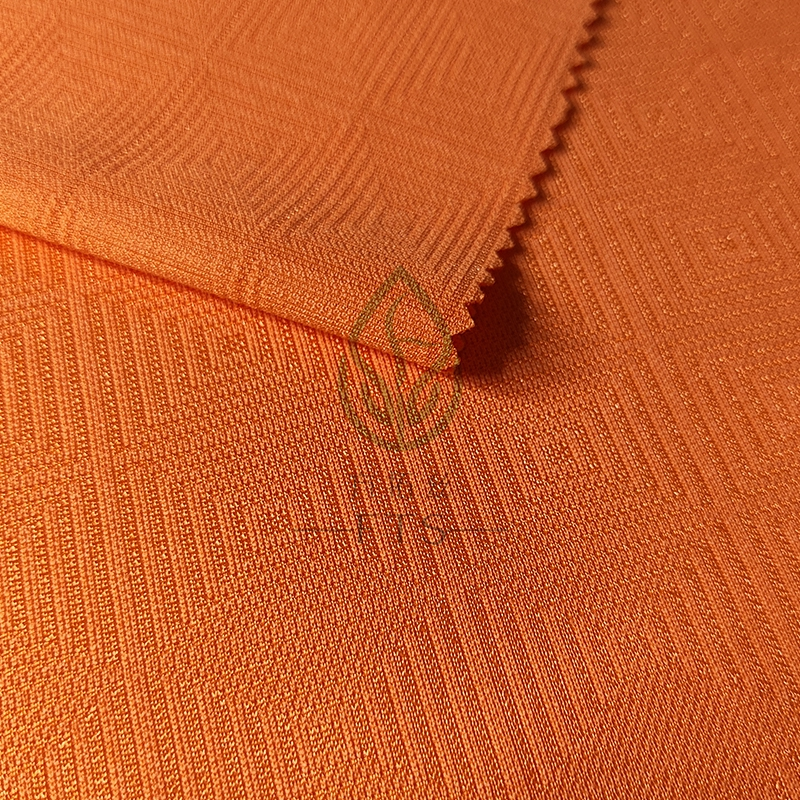


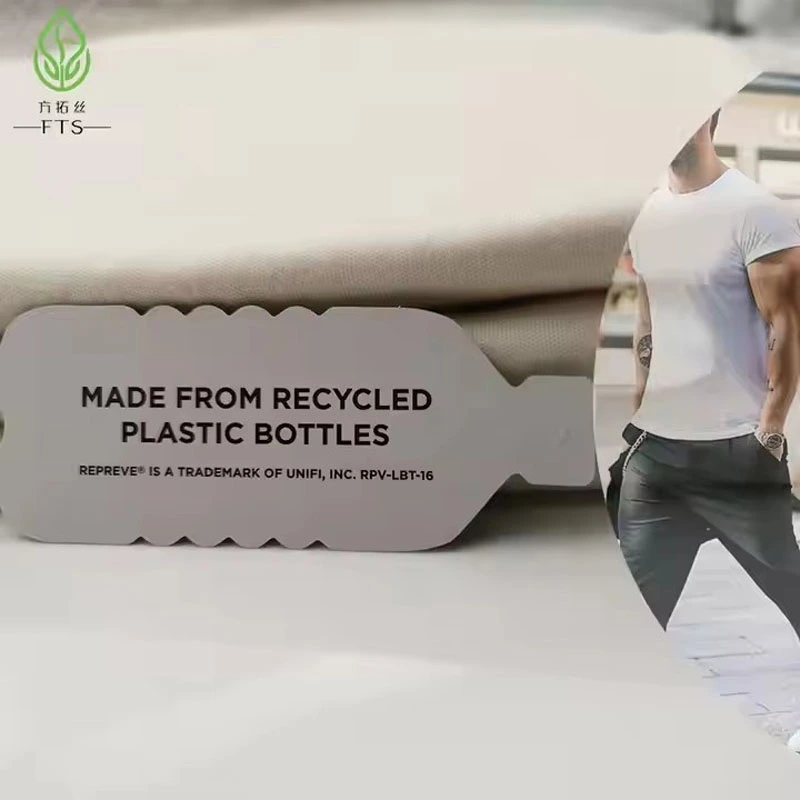
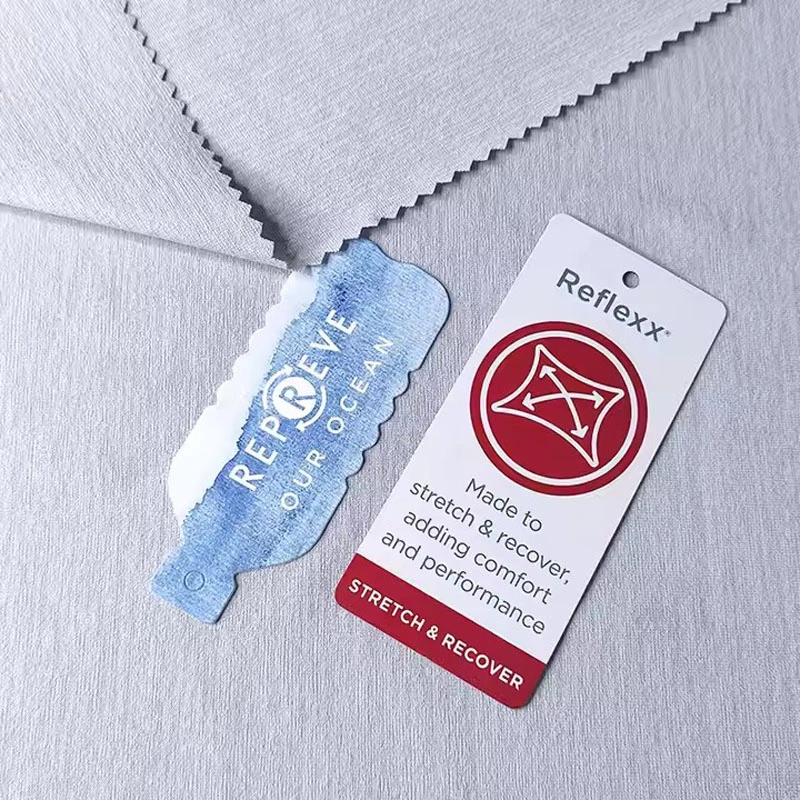
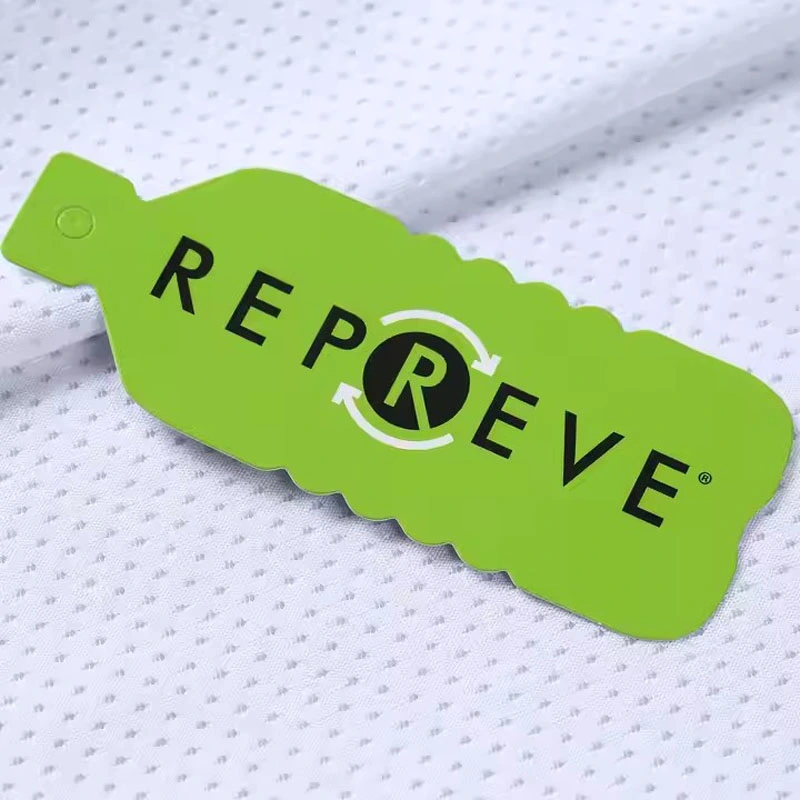
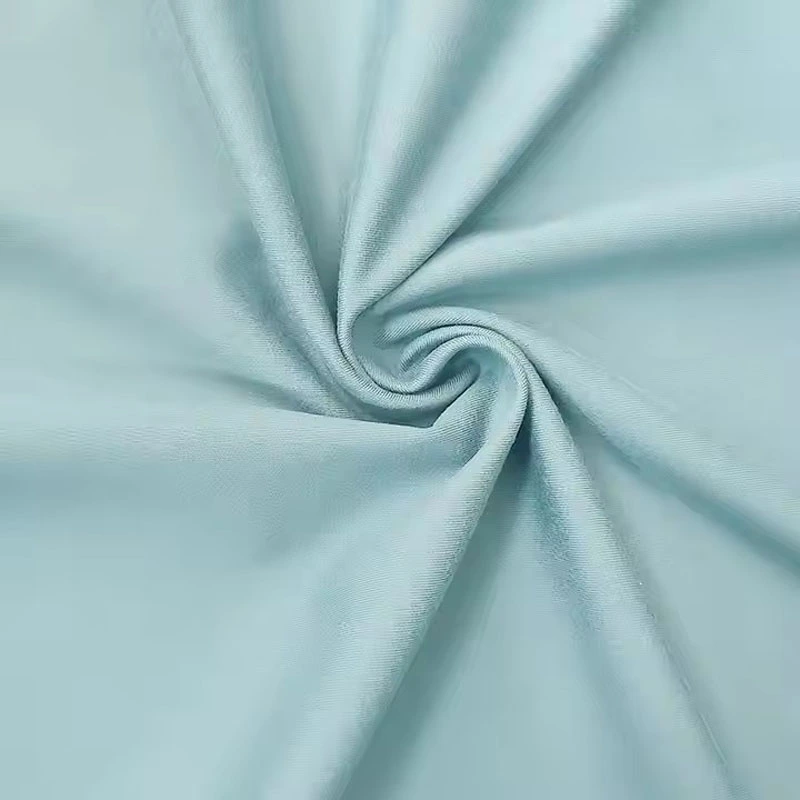
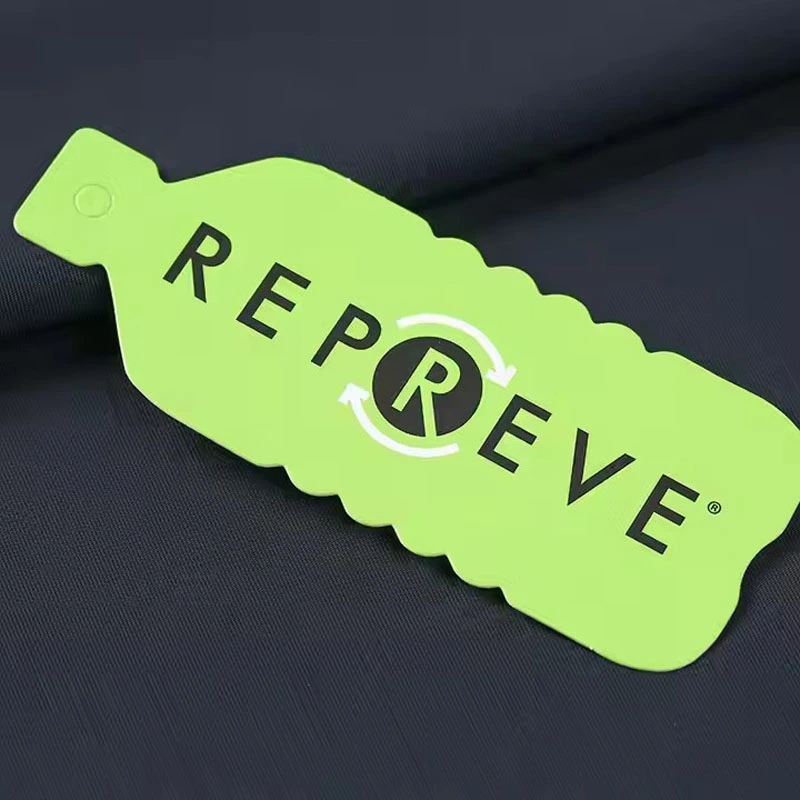

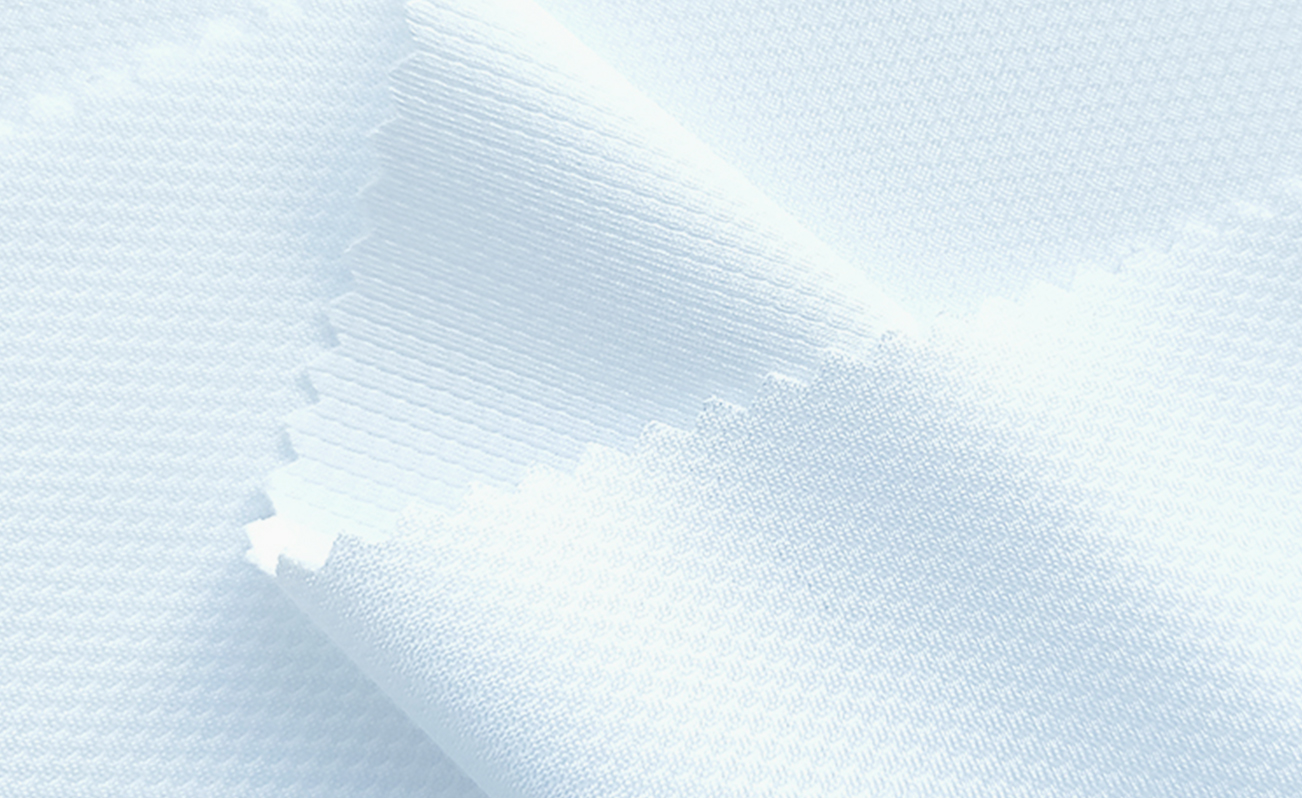

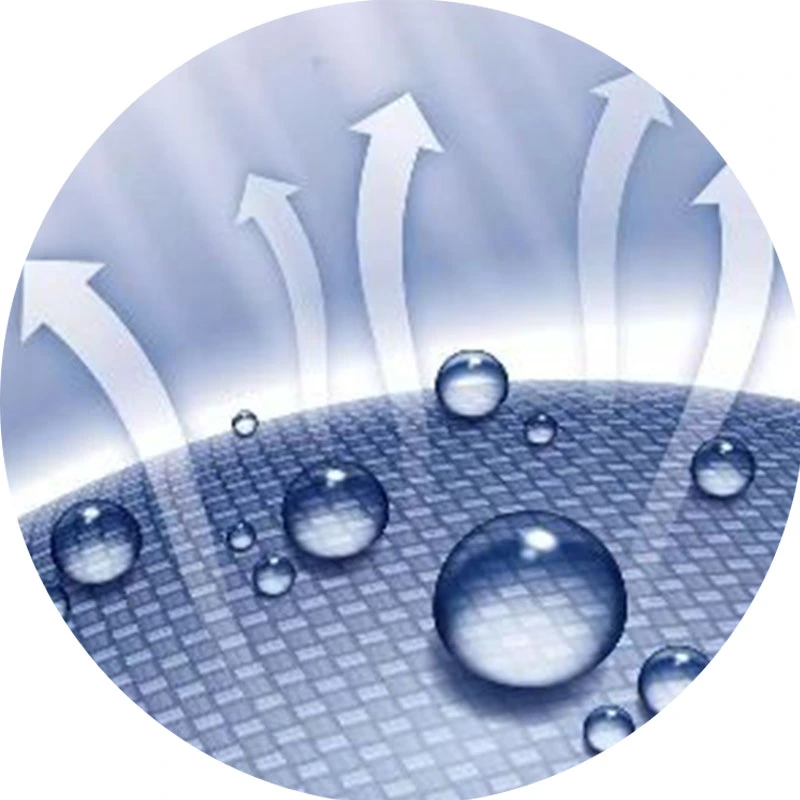
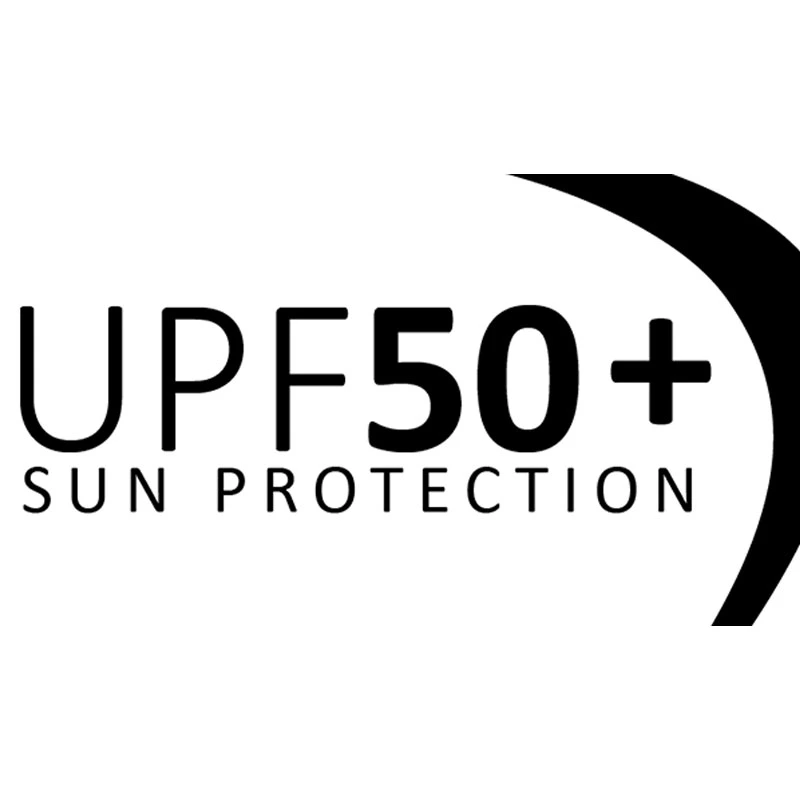
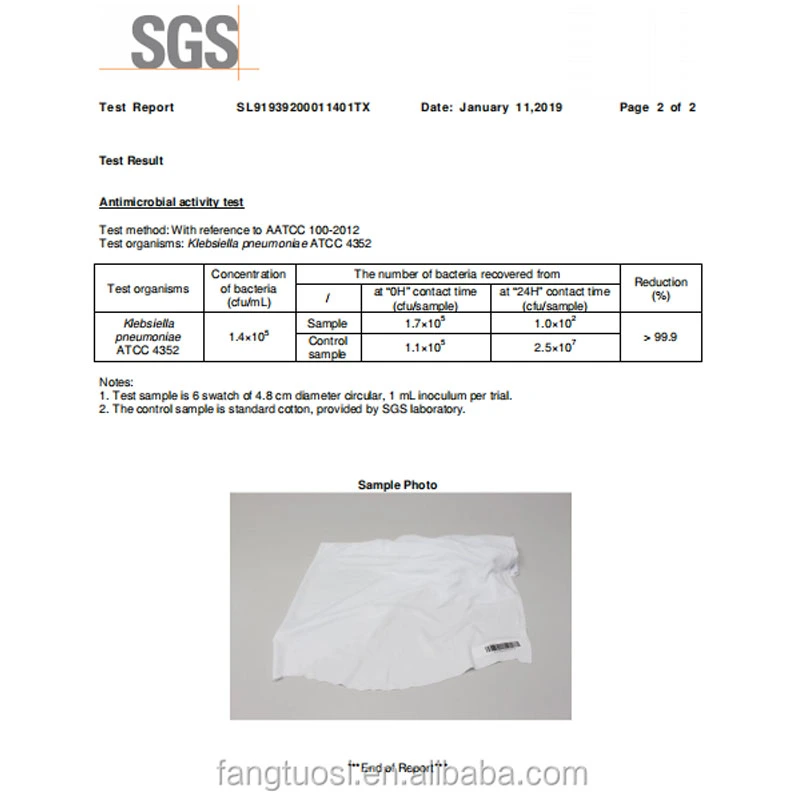
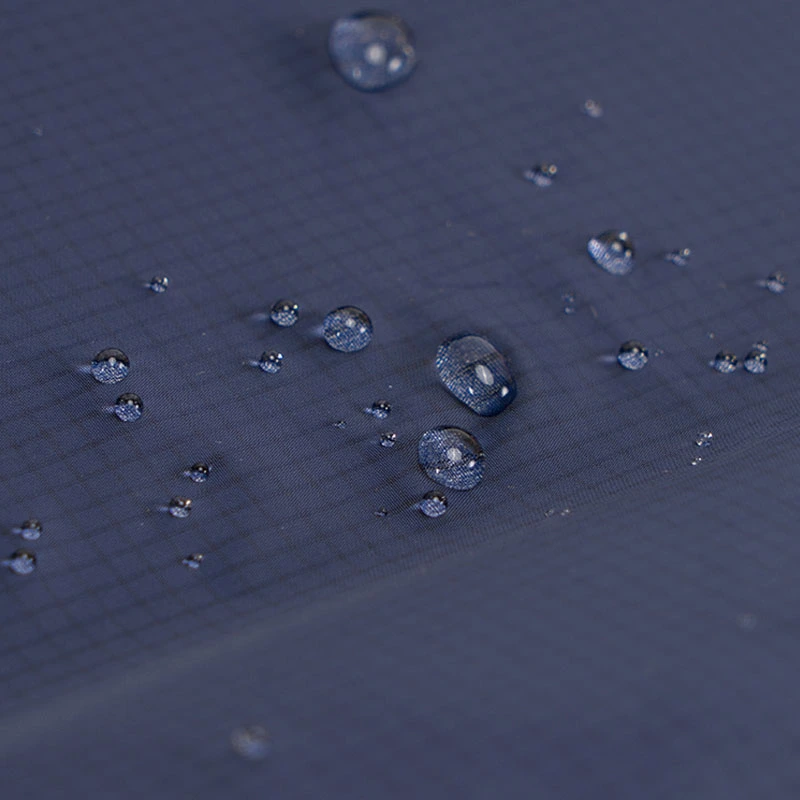
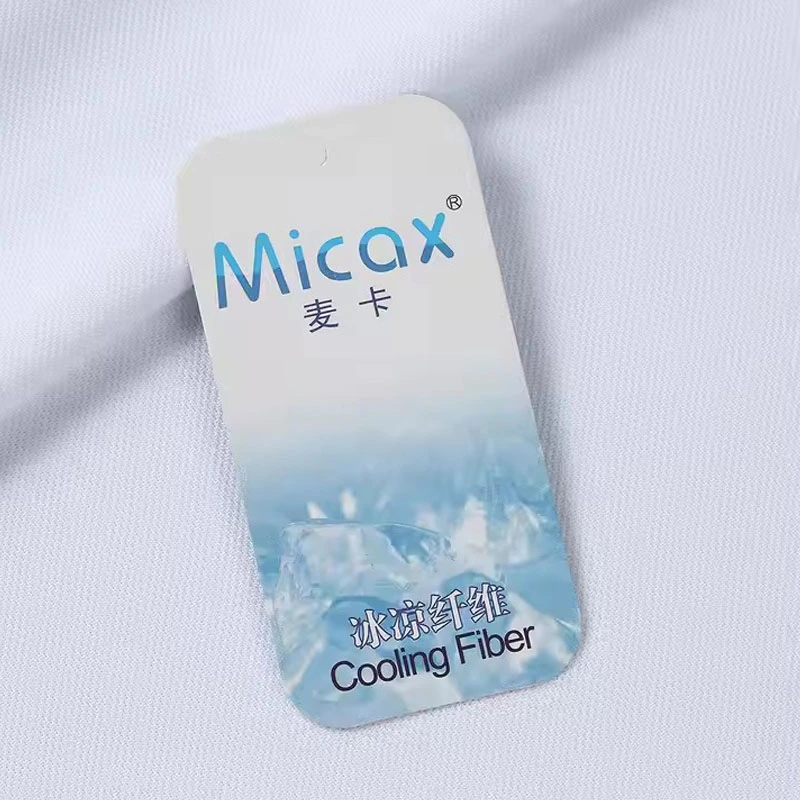
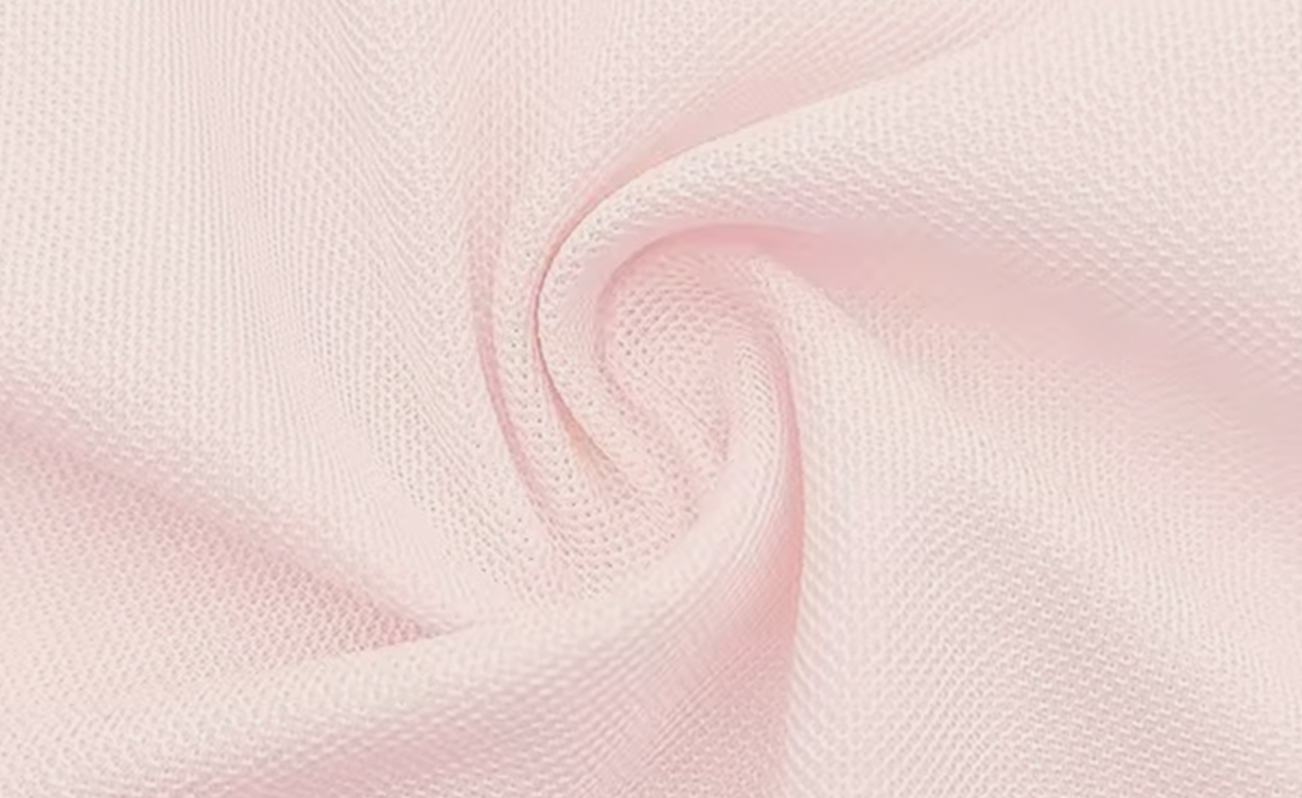

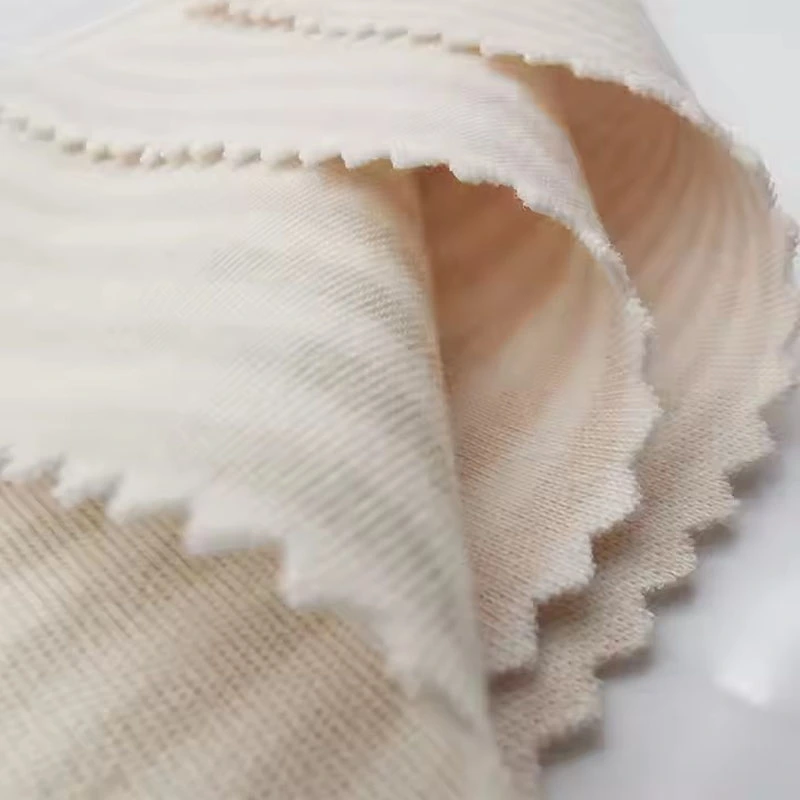
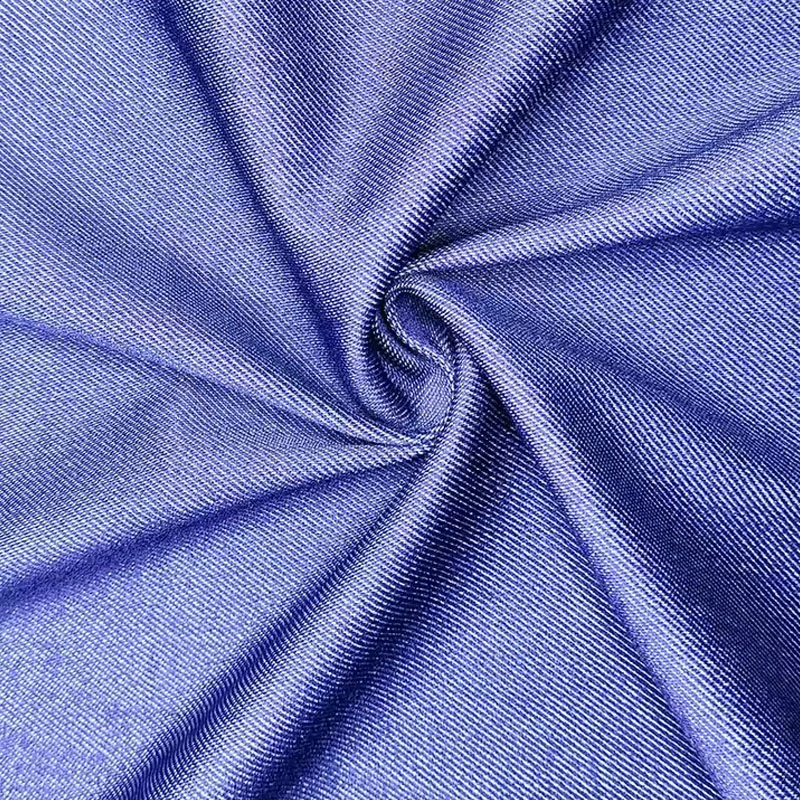
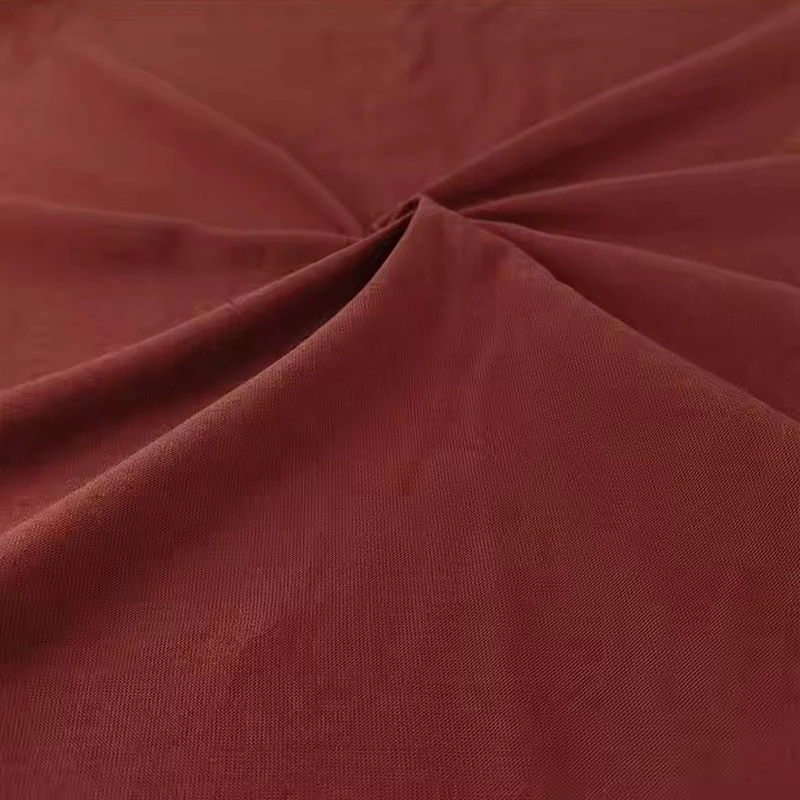
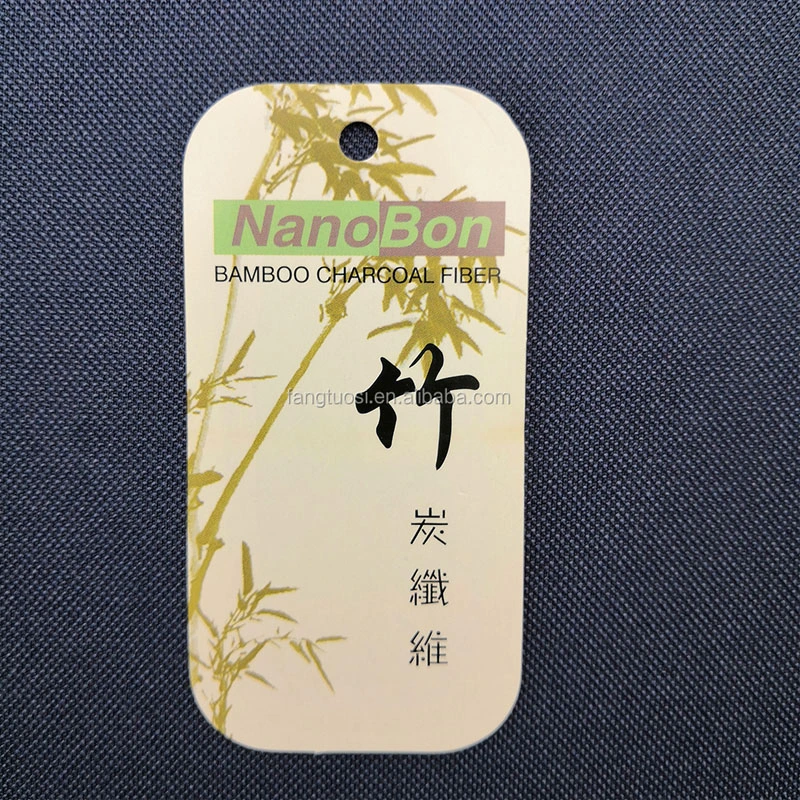













Recycled Nylon → Luxury swimwear, high-end yoga leggings.
Recycled Polyester → Mass-market sportswear (jerseys, hoodies) with carbon footprint transparency. with eco-friendly appeal via recycled lines.
Because it’s one of the most produced and consumed synthetic fabrics in the world, polyester is readily available in a wide variety of styles, weights, and finishes. Whether it’s smooth, textured, or mesh, polyester can be produced in many forms to suit different needs.
clothing fabrics
As a fabric manufacturer specializing in polyester-ammonia and nylon-ammonia blends, our yoga apparel textiles are engineered to deliver performance, durability, and style for yoga pants, sets, tank tops, and more. While seamless knitting is outside our current capabilities, we excel in producing versatile, high-performance fabrics tailored for both athletic and lifestyle wear.
Our Polyester spandex blends (80-85% polyester + 15-20% spandex) prioritize moisture-wicking and shape retention, ideal for high-intensity yoga sessions. The polyester base ensures colorfastness and UV resistance, while spandex provides 4-way stretch for unrestricted movement. For premium applications, Nylon spandex blends (70-80% nylon + 20-30% spandex) offer superior softness and abrasion resistance, mimicking the luxe feel of high-end brands like Lululemon. Both fabrics are lightweight (180-220gsm) and feature quick-drying properties, critical for hot yoga or outdoor practices.
Breathability: Laser-cut ventilation zones and mesh panels enhance airflow, reducing heat buildup during poses like Downward Dog or Warrior II.
Compression & Support: High-spandex variants (up to 30%) provide muscle stabilization, while flatlock seams minimize chafing.
Eco-Conscious Options: Select fabrics integrate 30% recycled polyester or OEKO-TEX-certified dyes, aligning with global sustainability trends.
Our fabrics accommodate diverse styles:
Yoga Pants: High-waisted designs with tummy-control panels and reinforced gussets for durability.
Tank Tops: Breathable racerback cuts with moisture-wicking linings, compatible with sublimation printing for vibrant patterns.
Yoga Sets: Coordinated leggings and bras using matching blends for aesthetic harmony and functional synergy.\
All fabrics undergo rigorous testing for chlorine resistance (for blended-fiber longevity) and UPF30+ UV protection, ensuring compliance with international sportswear standards. Dimensional stability is maintained even after 50+ industrial washes, with color retention rated at 4-5range.
Athleisure Brands: Customizable fabrics for seamless integration into yoga-to-streetwear collections.
By merging technical precision with scalable production, we empower clients to create yoga apparel that balances performance, comfort, and sustainability. For swatches or tailored solutions, contact our team to explore how our Polyester spandex and Nylon spandex fabrics can elevate your product line.
Engineered with breathable bird-eye texture for enhanced airflow and rapid moisture evaporation, this lightweight jersey fabric is ideal for high-performance sportswear like football jerseys, training suits, and gym apparel. Made from GRS-certified recycled polyester, it combines UV resistance (UPF 50+) and abrasion-proof durability, supporting eco-conscious brands with OEKO-TEX dyeing and vertical production.
Jacquard-knit fabric combining polyester's durability with spandex elasticity for multidirectional stretch and team jersey customization. Textured weave enhances airflow and resists pilling during rigorous use. Moisture-wicking properties maintain dryness, while colorfast fibers ensure vibrant print retention. Lightweight construction supports athletic mobility without compromising shape integrity. Suitable for high-performance sportswear requiring abrasion resistance and design versatility. OEKO-TEX certified for safe, long-lasting wear.
Lightweight nylon-spandex blend fabric in a single jersey knit, offering softness and balanced stretch for athletic comfort. Smooth, breathable structure supports unrestricted motion during high-intensity activities. Resists chlorine and saltwater exposure, ensuring durability in active environments. Quick-drying efficiency maintains dryness, while abrasion-resistant fibers retain shape through repeated use. Certified for safe skin contact. Ideal for sportswear requiring lightweight flexibility, long-lasting wear, and adaptable performance.
Jacquard-knit fabric combining polyester's durability with spandex elasticity for multidirectional stretch and team jersey customization. Textured weave enhances airflow and resists pilling during rigorous use. Moisture-wicking properties maintain dryness, while colorfast fibers ensure vibrant print retention. Lightweight construction supports athletic mobility without compromising shape integrity. Suitable for high-performance sportswear requiring abrasion resistance and design versatility. OEKO-TEX certified for safe, long-lasting wear.
Nylon (polyamide) is petroleum-based with silky smoothness(ECONYL® recycled from fishing nets) offers closed-loop potential), while polyester (PET) combines strength with recyclability (e.g., GRS-certified REPREVE from plastic bottles),dominates mainstream eco-applications.
Polyester, nylon, and blends with spandex or Lycra are commonly used for moisture-wicking properties.
Polyester is incredibly strong and resistant to stretching, shrinking, and abrasions, which makes it highly durable.
Virgin PET chips or recycled flakes (e.g., REPREVE® from plastic bottles) are purified and dried (≤50ppm moisture) to ensure melt-spinning stability.
Fujian East Xinwei Textile Technology Co., Ltd as a vertically integrated textile leader, we unite spinning, weaving, and dyeing under one roof, operating 78,000㎡ dyeing facilities (12 lines, 4,000+ tons/month) and 83,000㎡ knitting mills (400+ circular machines, 15,000+ tons grey fabric/month). Our GRS, OEKO-TEX, and ISO-certified production ensures premium sportswear fabrics (recycled polyester, nylon blends) with 72-hour rapid prototyping. Serving global brands across 30+ countries, we specialize in eco-friendly, high-performance materials for yoga, cycling, and team sports, exported primarily to Asia and North America. Committed to “Quality First, Excellence Always”, we deliver innovation from yarn to finished fabric with end-to-end traceability.
Before dyeing, whether the cloth surface is defective such as: oil needle, horizontal strip, vertical strip, missing needle, broken yarn, broken holes
East Xinwei founded Dongguan office founed---Established in China's manufacturing hub, this office leveraged Dongguan's strategic location near Guangzhou-Shenzhen economic corridor to access global supply chains, aligning with the city's emerging role in electronics and textiles.
Yarn Texturizing: Textured yarns are processed via advanced texturizing machines to enhance elasticity and durability.
Our award-winning fabric combines 70% nylon and 30% spandex, engineered for superior softness, abrasion resistance, and antibacterial performance—key traits for sportswear, intimate apparel, and athleisure. The integration of eco-friendly fluorine-free waterproofing technology reduces environmental impact while enhancing durability, aligning with global sustainability trends.
100% polyester pique fabric engineered with a textured knit for accelerated moisture dispersion and airflow enhancement. Lightweight structure balances breathability with durability, resisting pilling and deformation during repeated use. Chlorine/saltwater-resistant fibers ensure performance retention in harsh outdoor conditions. Non-abrasive surface minimizes friction during high-intensity activities. Designed for sportswear requiring rapid drying, long-term wear resilience, and adaptability to extreme environments.
UPF50+ certified polyester fabric with honeycomb knit structure for enhanced airflow and lightweight durability. Engineered moisture-wicking properties accelerate drying during intense activity. Resistant to chlorine, saltwater, and UV degradation, maintaining performance through repeated use. Smooth, abrasion-resistant surface minimizes irritation. Ideal for high-exposure sportswear requiring breathability, sun protection, and long-lasting structural integrity.
Polyester-spandex blend jersey fabric with waterproof coating, offering balanced breathability and weather resistance. Four-way stretch enhances mobility without compromising structural integrity. Durable construction withstands repetitive movement and outdoor conditions. OEKO-TEX certified for safety, resistant to abrasion and surface wear. Suitable for high-activity sports shirts requiring water protection and flexibility. Maintains shape through extended use.
Lightweight polyester jersey fabric engineered with advanced cooling technology for temperature regulation during outdoor activities. Moisture-wicking properties enhance breathability and quick-drying performance. Durable construction withstands repetitive motion and maintains shape integrity. OEKO-TEX certified for safe skin contact, resistant to UV degradation and abrasion. Ideal for high-intensity sportswear requiring comfort and long-term durability in varying climates.
GOTS-certified 100% organic cotton jersey fabric, specifically designed for infant apparel. Hypoallergenic and free from harmful chemicals, ensuring safety for sensitive skin. Soft, breathable knit structure provides comfort while maintaining durability through repeated washing. Compliant with international organic textile standards for sustainable production. Ideal for baby bodysuits, t-shirts, and eco-conscious clothing lines requiring non-toxic materials.
Soft, breathable cotton-spandex blend with four-way stretch for comfort and mobility. Single jersey knit construction ensures smooth texture and durability through repeated washing. Hypoallergenic and Oeko-Tex certified for skin safety. Ideal for everyday t-shirts requiring flexibility and shape retention. Resists pilling and maintains color vibrancy over time.
Blended fabric combining polyester's durability with cotton's breathability in a striped French terry knit. Brushed inner loops provide thermal insulation and moisture absorption, ideal for hoodies and athleisure wear. Resists pilling and shrinkage while maintaining shape through repeated use. OEKO-TEX certified for safety. Suitable for casual and sportswear applications requiring softness and structural resilience.
Recycled fabrics, such as rPET (from plastic bottles) and regenerated fibers from textile waste, drastically reduce reliance on virgin resources.
Function fabrics now combine smart fibers(e.g., energy-harvesting, self-powered textiles), nanomaterials(MXene, graphene), and conductive composites(liquid metal-reinforced PU/CNT structures). These enable real-time sensing, adaptive thermal regulation, and wireless communication for IoT integration.
Function fabrics excel at maintaining optimal body temperature and managing sweat. For instance:
Phase-change materials like EvenTemp™ use microcapsules to absorb or release heat, balancing warmth and cooling during activity.
Moisture-wicking synthetics (polyester, nylon) draw sweat away from the skin, while breathable membranes(e.g., CAMEL-TEX) allow vapor escape without compromising waterproofing.
Far Infrared (FIR) technology in bioceramic-infused fabrics enhances blood circulation, reducing muscle fatigue and accelerating recovery.
Function fabrics now combine smart fibers(e.g., energy-harvesting, self-powered textiles), nanomaterials(MXene, graphene), and conductive composites(liquid metal-reinforced PU/CNT structures). These enable real-time sensing, adaptive thermal regulation, and wireless communication for IoT integration.
Made of cellulose (87–90%), with natural impurities and moisture .
Fibers form fluffy, round bolls after seed maturation, which are mechanically processed into yarn and woven into fabric
Cotton allows air circulation, absorbs moisture (up to 8–10% of its weight), and feels soft against the skin, making it ideal for everyday wear and sensitive skin . Its hypoallergenic nature reduces irritation, even for infants or eczema-prone individuals .
Spandex adds 5–20% stretch to the fabric, allowing garments to conform to body contours while retaining shape after movement. This makes it ideal for activewear, swimwear, and form-fitting casual wear.
The spandex component (typically 5–20% of the blend) provides exceptional elasticity, allowing the fabric to stretch up to 500–700% of its original length while maintaining shape recovery. For example, sports bras with 20% spandex adapt dynamically to body movements during high-intensity activities like yoga or running, ensuring unrestricted motion and muscle support. This elasticity is critical for compression gear, swimwear, and leggings, where flexibility and a snug fit are paramount.
Spandex provides 500–700% elasticity, enabling the fabric to stretch in 4 directions while maintaining shape recovery. This ensures swimwear and athleisure garments (e.g., leggings, rash guards) move seamlessly with the body during activities like swimming or yoga, reducing friction and enhancing mobility. For example, a blend with 18% spandex offers compression-like support for muscle stability without restricting movement
Nylon spandex is the top choice for swimwear due to its chlorine resistance, quick-drying properties, and ability to retain shape in water. Its 4-way stretch ensures a snug, body-conforming fit, ideal for competitive swimsuits and casual beachwear. For example, blends with 20% spandex provide compression and flexibility, while specialized treatments like PBT coatings enhance resistance to pool chemicals.
Jacquard fabric is created using a specialized loom (or a Jacquard attachment) that controls individual warp threads, allowing for raised motifs, reversible patterns, and detailed designs like florals, damasks, and geometrics.
Unlike printed fabrics, the patterns are woven into the material, making them durable and resistant to fading.
Quick-drying fabrics often incorporate microscopic pores or grooves in fibers (e.g., polyester or nylon blends) to create capillary action. These pores, smaller than water droplets but larger than water vapor molecules, allow sweat to spread across the fabric’s surface and evaporate rapidly . For example, GORE-TEX-like membranes use this principle to balance waterproofing and breathability .
For example, Nike’s Dri-FIT technology uses a microporous structureto pull moisture to the fabric’s surface, outperforming traditional cotton, which retains moisture and causes discomfort. This feature is critical for sports like running and yoga, where prolonged dryness enhances performance
UPF50+ blocks 98% of UV radiation, surpassing lower-rated fabrics (e.g., UPF30 blocks 97.4%) and offering 20x more protection than untreated cotton (UPF 5-8).
It provides full-spectrum defense against both UVA (skin aging) and UVB (sunburn) rays.
UPF50 fabrics are primarily made from synthetic fibers like polyester or nylon, which inherently have dense molecular structures that naturally block UV radiation.
Advanced treatments such as titanium dioxide (TiO₂) or zinc oxide (ZnO) coatingsenhance UV absorption by reflecting or scattering harmful rays.
Chemical Agents: Silver ions (Ag⁺), chitosan, and quaternary ammonium salts disrupt bacterial cell walls or interfere with metabolic processes. For example, silver ions embedded in fibers release over time, achieving >99% bacterial reduction.
Physical Barriers: Superhydrophobic surfaces (inspired by lotus leaves) prevent bacterial adhesion by trapping air layers, while graphene’s sharp edges rupture microbial membranes.
Natural Compounds: Bamboo fibers contain "bamboo kun," a bioactive agent that inhibits bacterial growth by 70–99%.
Mechanism: Fabrics are coated with antibacterial agents (e.g., silver ions, quaternary ammonium salts, or chitosan) via dipping, spraying, or padding. These agents disrupt bacterial cell walls or metabolic processes.
Example: Chitosan, derived from crustacean shells, binds to bacteria’s negatively charged surfaces, causing lysis.
Durability: Post-finished fabrics may lose efficacy after 10–20 washes if exposed to anionic detergents.
Blocks water penetration through coatings (e.g., polyurethane) or membranes (e.g., Gore-Tex®), with hydrostatic head ratings up to 20,000 mm, ensuring dryness in heavy rain or snow.
Seam-sealed construction prevents leaks at stitching points, critical for extreme environments.
Microporous Membranes:
Gore-Tex®: Uses PTFE membranes with 0.1–5 μm pores to block liquid water while allowing vapor escape (>10,000 g/m²/24h breathability).
eVent®: Features direct-venting technology for faster moisture expulsion (5,300 g/m²/24h breathability), ideal for high-intensity activities.
Polyurethane (PU) Coatings: Cost-effective and lightweight, modern variants like Aquatex® enhance flexibility and abrasion resistance.
Hydrophilic Solid Films:
Sympatex®: A polyester-based film that transports vapor via molecular diffusion, excelling in humid environments (hydrostatic head >20,000 mm).
Radiative Cooling:
Fabrics like POM nanofibers reflect >96% of solar radiation while emitting infrared heat through atmospheric transparency windows (8–13 μm), achieving sub-ambient cooling even in direct sunlight . Bioinspired coatings with CaCO₃/BaSO₄ microcrystals amplify solar reflection and infrared emission, reducing temperatures by up to 8°C compared to untreated fabrics .
Phase-Change Materials (PCMs):
Hybrid designs integrate graphene or wax-based PCMs to absorb and release heat dynamically, stabilizing skin temperature during temperature fluctuations .
Reflect sunlight & emit heat via infrared.
Cotton’s soft, breathable fibers allow air circulation, keeping skin cool in summer and warm in winter. Its hypoallergenic properties make it ideal for sensitive skin, reducing irritation and allergies. Innovations like RESTech COTTON™ enhance softness by 40% while maintaining durability, ensuring comfort for daily wear.
Natural Softness
Hypoallergenic Properties
Combines 95-98% cotton with 2-5% spandex.
Athletic apparel: Ideal for yoga pants, jogging suits, and cycling shorts, as its elasticity (5–8x stretch) supports dynamic movements.
Swimwear: Blended with nylon or polyester, it provides form-fitting designs resistant to chlorine and saltwater.
Performance socks: Enhances fit and breathability in high-end socks, reducing friction during sports.
Workwear: Flame-resistant uniforms (e.g., welding protection), anti-static overalls.
Casualwear: T-shirts, jeans, yoga pants.
Medical Textiles: Hypoallergenic scrubs, patient gowns.
Sportswear: Lightweight hoodies, gym socks.
Underwear: Soft, skin-friendly basics.
The soft, smooth texture of bamboo fibers (with rounded cross-sections) reduces skin friction, ideal for sensitive skin. Blended with cotton (e.g., 95% cotton + 5% bamboo), it retains cotton’s gentle hypoallergenic feel while enhancing durability.
Bamboo grows rapidly (3–5 years to maturity), requires minimal water, and thrives without pesticides. Blended with organic cotton, it reduces water usage by 60% compared to conventional cotton.
Nylon Spandex, with its exceptional stretch and durability, is a fabric celebrated for its versatility. Whether you own activewear, swimwear, dance costumes, or everyday clothing made from Nylon Spandex, proper care is essential to ensure these garments maintain their flexibility and style. In this article, we'll discuss how to care for Nylon Spandex garments, keeping them in top condition for years to come.
The first step in caring for any garment, including Nylon Spandex, is to read the care label. The label provides specific instructions on how to clean and maintain the item. It's essential to follow these guidelines as they are tailored to the particular fabric blend and garment type.
For most Nylon Spandex garments, hand washing in cold water is the preferred method of cleaning. Use a mild detergent designed for delicates or activewear. Avoid harsh detergents, as they can damage the elasticity of the fabric.
If you're in a hurry or have many similar garments to wash, you can use a gentle machine wash setting with cold water. Be sure to place your Nylon Spandex garments in a lingerie bag to protect them from friction and stretching during the wash cycle.
Never use hot water or expose Nylon Spandex garments to high heat. Heat can damage the spandex fibers, causing the fabric to lose its stretch. Stick to cold water for washing and rinse thoroughly to remove all detergent.
Fabric softeners may leave residues that can affect the fabric's elasticity and moisture-wicking properties. It's best to skip fabric softeners when caring for Nylon Spandex garments.
The most crucial aspect of drying Nylon Spandex garments is to air dry them. Avoid using a dryer or direct sunlight, as excessive heat can harm the spandex fibers. Lay your garments flat on a clean towel to dry, ensuring they maintain their shape and elasticity.
When storing your Nylon Spandex garments, fold them neatly rather than hanging them. Hanging can lead to stretching and distortion of the fabric. Store them in a cool, dry place away from direct sunlight to prevent fading and damage.
When wearing Nylon Spandex, be cautious of rough surfaces that could snag or damage the fabric. This is especially important for activewear, as abrasion can impact the garment's longevity.
If you wear Nylon Spandex activewear frequently, it's a good idea to rotate between different pieces to give them time to recover their shape between uses. This can extend their lifespan.
Blended fabric combining polyester's durability with rayon-cotton's softness in a breathable single jersey knit. Moisture-wicking properties enhance comfort during physical activity. Four-way stretch ensures mobility while resisting pilling and shrinkage. Maintains shape integrity through repeated washing. OEKO-TEX certified for skin safety. Suitable for sportswear t-shirts requiring balanced comfort and performance durability.
Made from recycled plastic bottles, this eco-friendly fabric delivers softness and full flexibility for yoga, swimming, or gym workouts. The polyester-spandex blend offers natural stretch and shape retention, adapting seamlessly to body movements. Breathable and moisture-wicking, it ensures comfort during intense activities while reducing environmental impact. Certified for safety and durability, it's perfect for leggings, swimwear, or athleisure that values sustainability without sacrificing performance.
100% polyester vertical mesh fabric features a tightly knitted, lightweight structure with vertical mesh patterns, ensuring durability and breathability for sportswear and outdoor gear. Its moisture-wicking and quick-drying properties enhance comfort during high-intensity activities, while UV resistance and colorfastness maintain performance under sun exposure. The vertical mesh design promotes superior airflow, reducing heat buildup. Ideal for jerseys, activewear, and accessories, it resists abrasion, pilling, and wrinkles, retaining shape over time. Available in weights (90–500gsm) and widths (45–320cm), it supports customization for industrial or fashion uses. Certifications like OEKO-TEX and eco-friendly recycled polyester variants cater to sustainable demands. Machine-washable and chlorine-resistant, it balances functionality with low maintenance.
Designed for active versatility, this breathable polyester fabric features a textured knit for enhanced airflow in polos or sportswear. Lightweight and quick-drying, it wicks moisture to keep you cool during workouts or casual wear. Soft yet durable, it resists wrinkles and fading, retaining its crisp look wash after wash. Available in eco-conscious recycled options, certified skin-safe and ideal for performance-driven apparel that merges athletic function with everyday style.
Ideal for active lifestyles, this lightweight stretch fabric combines durability with superior comfort. The polyester-spandex blend offers four-way elasticity, ensuring freedom of movement for yoga, gym sessions, or daily wear. Breathable and moisture-wicking, it maintains shape through repeated use while providing a soft, supportive feel against the skin. Available in eco-conscious recycled variations, it meets international safety standards for sensitive skin applications. Perfectly balances flexibility and compression for high-performance activewear.
Tracksuit polyester spandex fabric (typically 95% polyester, 5% spandex) combines polyester’s durability, wrinkle resistance, and quick-drying properties with spandex’s 4-way stretch (up to 500% elasticity), ensuring flexibility and shape recovery. Lightweight and breathable, it wicks moisture efficiently, ideal for high-intensity workouts. The smooth, abrasion-resistant surface resists pilling, while the ribbed or jersey knit structure enhances airflow and comfort. Commonly used in sportswear, athleisure, and performance tracksuits, it adapts seamlessly to body movements and retains vibrant colors after repeated washes. Eco-friendly variants may incorporate recycled polyester (rPET) or OEKO-TEX-certified fibers for sustainable fashion. Machine-washable and low-maintenance, it balances athletic functionality with everyday practicality.
Ideal for athletes, this ultra-soft fabric combines lightweight polyester microfiber with a breathable interlock knit for all-day comfort. The smooth texture wicks moisture and resists odors during intense workouts, keeping you cool and fresh. Durable yet gentle on skin, it retains shape through repeated use and washes. Certified skin-safe and perfect for high-performance sportswear that balances functionality with everyday comfort.
Crafted for fitness enthusiasts, this eco-conscious fabric blends recycled nylon with stretchy spandex for smooth, sweat-wicking comfort. Its subtle matte finish offers a sleek look, while the breathable knit supports dynamic movements during workouts. Soft against the skin and quick-drying, it resists odor and retains shape through intense sessions. Ideal for gym wear, yoga outfits, or casual activewear. Certified skin-safe and made with sustainable materials, it balances performance with planet-friendly durability.
Crafted for comfort, this cotton-modal blend offers a soft, breathable feel for hoodies and sweatpants. The digital printing delivers vibrant, fade-resistant patterns, while the French Terry inner layer wicks moisture naturally. Lightweight yet durable, it resists pilling and stays cozy through daily wear. Available in eco-conscious options, certified skin-safe and perfect for loungewear, casual athleisure, or stylish home outfits. Balances effortless style with lasting comfort.
Perfect for active lifestyles, this fabric blends cotton’s breathability with spandex stretch for sweat-wicking comfort. The breathable mesh knit keeps you cool during workouts or casual wear. Soft, lightweight, and resistant to shrinking, it holds its shape wash after wash. Available in eco-conscious recycled options, certified skin-safe for sensitive skin. Ideal for custom tees, gym wear, or breathable everyday apparel that blends durability with all-day ease.
Ideal for active lifestyles, this lightweight fabric offers all-direction stretch for unrestricted movement during cycling, gym sessions, or outdoor runs. The smooth, breathable knit wicks sweat quickly, keeping you dry and comfortable. Durable yet soft against the skin, it resists fading and holds its shape through repeated use. Available in eco-conscious recycled options, certified for skin safety. Perfect for sportswear, tops, or jerseys that blend performance with everyday versatility.
performance and leisure. The core materials are polyester-ammonia and nylon-ammonia blends, optimized for durability, elasticity, and resistance to pool chemicals and UV exposure.
Polyester spandex Blends: Comprising 80-85% polyester + 15-20% spandex, these fabrics prioritize chlorine resistance and shape retention, ideal for frequent pool use. The polyester base ensures colorfastness and UV protection, while spandex (up to 20%) delivers 4-way stretch for unrestricted movement.
Nylon spandex Blends: With 70-80% nylon + 20-30% spandex, this lightweight fabric excels in saltwater environments, offering quick-drying properties and abrasion resistance for beach activities.
UPF50+ Sun Protection: UV-blocking treatments are integrated into fabric weaves, shielding skin from harmful rays during prolonged outdoor use.
Anti-Chlorine Technology: Proprietary coatings neutralize chlorine damage, extending fabric lifespan by 30% compared to standard swimwear.
Compression & Support: High-spandex variants (18-22%) provide muscle stabilization for athletic training, while seamless stitching reduces chafing.
Our collection spans performance-driven styles (e.g., racerback one-pieces, jammers) and fashion-forward options (cutouts, retro high-waisted designs). Key features include:
Reinforced Seams: Flatlock stitching in stress areas (armholes, waistbands) for longevity.
Adjustable Components: Removable padding, convertible straps, and tummy-control panels cater to diverse body types.
Eco-Friendly Options: 30% of fabrics use GRS-certified recycled nylon or OEKO-TEX Standard 100 materials, minimizing environmental impact.
Quality Assurance: All products meet ISO 9001 standards for colorfastness, tensile strength, and chlorine resistance.
By merging athletic-grade technical specs (e.g., hydrodynamic drag reduction) with luxury details like velvet trims and Art Deco patterns, our swimwear bridges functionality and resort-ready aesthetics. Whether for competitive swimming, surfing, or poolside lounging, each piece adheres to our "Adaptive Excellence" philosophy—empowering wearers to perform and shine
Industrial-grade interlock knit structure delivers 4x enhanced durability vs single jersey (ISO 13934-1 tested). Moisture-wicking finish reduces sweat retention by 38% with UV50+ protection. OEKO-TEX Standard 100 certified fabric withstands 200+ industrial washes while maintaining anti-pilling performance. Ideal for high-intensity training gear & team uniforms. Compatible with sublimation printing for sportswear branding.
GRS-certified 85% recycled polyester +15% spandex with UPF50+ protection. 4-way stretch maintains shape through 200+ saltwater washes. Chlorine-resistant finish reduces fiber degradation by 40% vs standard fabrics. OEKO-TEX certified sublimation printing . Ideal for surf rashguards & UV swimwear with skin-friendly brushed inner layer.
Blended fabric combining nylon's lightweight durability with spandex elasticity for multidirectional stretch and compression during yoga. Smooth, non-abrasive surface ensures skin comfort and freedom of movement, while moisture-wicking properties enhance breathability. Resists pilling and deformation, retaining shape through repeated wear and washing. OEKO-TEX certified for skin safety. Designed for yoga leggings requiring flexibility, contouring fit, and long-lasting performance in dynamic poses.
Jacquard-knit polyester fabric with integrated sports mesh panels for targeted airflow and rapid moisture dispersion. Lightweight, textured weave enhances breathability while maintaining durability for high-intensity training. Four-way stretch ensures unrestricted movement, and abrasion-resistant fibers resist pilling during repeated use. Quick-dry properties and smooth surface optimize comfort in prolonged wear. Suitable for performance sportswear requiring strategic ventilation, structural flexibility, and long-lasting resilience.
Nylon excels in abrasion/chlorine resistance for swimwear; polyester dominates in quick-dry/UV protection for outdoor gear like running shirts. Both blends use recycled fibers without sacrificing durability.
Mesh fabrics, lightweight cotton blends, and performance synthetics like polyester or merino wool.
It repels water, which is one of the reasons it is favored for activewear and sportswear. It helps keep you dry by wicking sweat away from the skin and dries faster than most other fabrics.
PET melted at 290-300°C is extruded through spinnerets, cooled into filaments, then drawn 3-5x to align polymer chains for strength (4-6g/denier).
Rooted in industrial-trading integration, our culture thrives on precision and collaboration. Guided by "Quality First, Excellence Always", sales and merchandising teams operate in seamless synergy—each salesperson partners with a dedicated merchandiser to ensure end-to-end order accuracy, while monthly factory inspections embed accountability into every production step. Team-building activities foster deep trust and stability, reducing turnover costs and fueling innovation. Sustainability anchors our ethos: GRS and OEKO-TEX certifications drive eco-conscious production, aligning with global ESG demands. By merging artisanal rigor with agile workflows (72-hour prototyping), we deliver reliability from yarn to export, embodying a **"Green Thread Initiative"** that cuts waste by 15% since 2022
Re-confirmation before shipment. Packing, Dirt, split yarn, horizontal strip, vertical strip, blue dot stain, gram weight door width, color fastness, shrinkage, feel and etc.
Naqi dyeing factory founded---Specializing in polyester/nylon fabric dyeing, the factory adopted early water recycling systems to reduce environmental impact, serving sportswear brands across Asia during China's textile boom.
Ten years of experience in the business, ranked No. 1 in terms of professional competence, and able to provide you with private customized solutions for your product direction.
Circular Weft Knitting: 400+ circular knitting machines weave yarns into greige fabric with precision, ensuring uniform texture.
The “Five Small” competition, focused on grassroots innovations (small improvements, inventions, creations, designs, and suggestions), empowers enterprises to refine production processes and foster skill development. By winning this prestigious award, we demonstrate our ability to merge R&D expertise with industrial scalability, ensuring cost-effective, high-performance fabrics for brands worldwide.
Engineered 100% polyester jersey fabric with advanced moisture management for rapid sweat dispersion and cooling during high-exertion activities. Lightweight, breathable knit structure promotes airflow while retaining shape and durability. Resists pilling and shrinkage through repeated washing. Suitable for outdoor sportswear requiring quick-dry performance and long-term wear resilience. OEKO-TEX certified for safe skin contact.
GRS-certified fabric made from post-consumer plastic waste. Permanent antibacterial treatment inhibits odor-causing bacteria. Pique knit structure enhances breathability and moisture management. Resists pilling and UV degradation through repeated washes. Suitable for performance polo shirts requiring hygiene and durability. Compatible with sublimation printing for custom designs.
Durable waterproof polyester knitted fabric with breathable membrane technology. Provides reliable water resistance while maintaining airflow for athletic comfort. Four-way stretch construction adapts to dynamic movements. Resistant to abrasion and maintains integrity through repetitive use. OEKO-TEX certified for safe skin contact. Suitable for outdoor sportswear requiring weather protection and flexibility.
Eco-friendly fabric made from 90% recycled polyester (GRS-certified) and 10% spandex for stretch. Moisture-wicking jersey knit provides cooling comfort and quick drying. UPF50+ sun protection resists UV degradation. Chlorine and saltwater-resistant for aquatic activities. Durable against abrasion, maintains shape through repeated use. Suitable for rash guards and sportswear requiring sustainability and performance.
Medium-weight cotton-spandex blend with brushed inner layer for thermal insulation and softness. French terry construction provides breathability and moisture absorption, while 4-way stretch ensures mobility. Ideal for winter hoodies, sweatshirts, and loungewear requiring warmth and flexibility. Resists pilling and maintains shape through repeated wear. OEKO-TEX certified for skin-safe applications.
Blended fabric combining Sorona® (partially bio-based) polyester for thermal retention with cotton for breathability. Double-knit polar fleece construction provides enhanced insulation, while brushed inner layer ensures softness and moisture management. Resistant to pilling and shrinkage, maintaining shape through repeated wear. Suitable for winter jackets and hoodies requiring lightweight warmth and durability. OEKO-TEX certified for safety standards.
Recycled fabrics align with circular fashion principles by extending material lifecycles. Brands like Adidas use ocean plastic in footwear, while companies like ECONYL repurpose nylon waste into luxury apparel.
Healthcare: Biosensing textiles with chipless sensing and biomedical monitoring(e.g., ECG, glucose detection).
Sportswear: Moisture-wicking, UV-resistant fabrics with 4D stretch and pressure mapping.
Fashion: Interactive garments with color-changingor luminescent fibers.
Industrial/Military: Aerospace-grade fibersand environment-responsive textiles for extreme conditions.
Advanced knitting and fiber engineering ensure flexibility and longevity:
4D stretch fabrics with spandex blends provide unrestricted movement for activities like yoga or climbing.
Ripstop weavesand laminated layers (e.g., ocean-recycled nylon triple ripstop) resist tearing and abrasion in harsh environments.
Flatlock seams minimize chafing, whileUV-resistant coatingsprotect against sun damage during prolonged outdoor exposure.
Healthcare: Biosensing textiles with chipless sensing and biomedical monitoring(e.g., ECG, glucose detection).
Sportswear: Moisture-wicking, UV-resistant fabrics with 4D stretch and pressure mapping.
Fashion: Interactive garments with color-changingor luminescent fibers.
Industrial/Military: Aerospace-grade fibersand environment-responsive textiles for extreme conditions.
Breathable and hypoallergenic, ideal for sensitive skin .
High moisture absorption (up to 8–10% of its weight), keeping wearers cool and dry .
Soft texture but prone to wrinkling, shrinkage, and moderate durability compared to wool or synthetics
Pure cotton is strong and becomes tougher when wet, resisting wear and tear over time . Long-staple variants like Pima or Egyptian cotton offer superior softness and longevity .
Polyester provides high tensile strength and abrasion resistance, ensuring long-lasting wear even with frequent washing. The blend resists shrinking and wrinkling, reducing maintenance effort.
Polyester (80–95% of the blend) contributes high tensile strength, resisting abrasion, pilling, and UV degradation. Sportswear made from this blend retains structural integrity even after repeated washing and exposure to chlorine or sweat. For instance, polyester’s wrinkle-resistant properties ensure leggings and jerseys maintain their polished appearance over time. The combination of polyester’s rigidity and spandex’s elasticity creates fabrics that withstand rigorous athletic use without sagging or losing shape.
Nylon’s high tensile strength resists abrasion, chlorine, and UV exposure. Swimwear made from nylon spandex retains color vibrancy and structural integrity even after prolonged contact with saltwater or chlorinated pools. Its resistance to pilling ensures athleisure pieces like leggings withstand frequent washing and high-intensity workouts.
Yoga Pants and Leggings: The fabric’s elasticity (up to 700% stretch) allows unrestricted movement during high-intensity workouts, while nylon’s abrasion resistance ensures longevity.
Sports Bras and Compression Wear: Blends with 15–20% spandex offer muscle support and reduce chafing through seamless designs.
Cycling Shorts and Running Gear: Its lightweight nature and moisture-wicking properties keep athletes dry during prolonged activities.
Invented in France, the Jacquard loom replaced labor-intensive manual weaving, democratizing access to ornate textiles previously reserved for the elite.
Notably, China had earlier versions of complex weaving techniques (e.g., Han Dynasty silk brocades), but Jacquard’s innovation standardized mass production.
Hollow or Grooved Fibers: Fibers with cross-shaped, Y-shaped, or hexagonal cross-sectionsincrease surface area, accelerating moisture transport. Brands like Coolmax (INVISTA) and Aerocool(Hyosung) use such designs to enhance wicking .
Micro-Groove Technology: Fibers with surface grooves (e.g., Coolnylon) direct sweat outward via capillary channels, reducing drying time .
The fabric’slightweight and breathable construction allows unrestricted airflow, reducing heat buildup. Brands like Adidas and Under Armour integrate hybrid blends (e.g., 88% polyester + 12% spandex) to balance elasticity and ventilation. Military-grade applications, such as the U.S. Air Force’s updated PT uniforms, utilize Dry Fit-inspired materials with antibacterial treatments to prevent odor during extended wear
100% polyester mesh fabric engineered for rapid moisture dispersion and permanent UPF 50+ UV protection. Hexagonal knitting pattern enhances airflow and reduces fabric weight without compromising durability. Resistant to chlorine, saltwater, and repeated washing cycles. Smooth, low-friction surface minimizes skin irritation during high-intensity activities. Ideal for performance sportswear requiring breathability, sun protection, and quick-dry functionality.
Unlike sunscreen, UPF50 protection is permanent and wash-resistant, maintaining efficacy for 3-5 years with proper care.
Fabrics integrate breathable mesh panelsand moisture-wicking properties, ideal for sports like hiking or swimming.
Tightly woven fabrics minimize gaps between fibers, reducing UV penetration. For example, denim or high-density polyesterachieves UPF50+ by blocking over 98% of UV rays.
Specialized weaving techniques (e.g., 3D jacquard) improve fabric density while maintaining breathability.
Built-in Antimicrobial Fibers: Silver ions or triclosan are integrated during fiber synthesis (e.g., synthetic polymers like polyester), ensuring long-lasting efficacy (>50 washes).
Post-Treatment Finishing: Fabrics are coated with antimicrobial agents (e.g., chitosan, violacein) via dipping or spraying. However, this method may lose effectiveness after repeated washing.
Spinning Integration: Antibacterial additives (e.g., nano-silver, copper oxides, or triclosan) are embedded into synthetic fibers (polyester, nylon) during production.
Example: Modal marine cotton infused with crustacean-derived compounds achieves permanent antibacterial properties.
Advantage: Retains >99% efficacy even after 50+ washes.
Microporous membranes (e.g., Gore-Tex, eVent) allow sweat vapor to escape while blocking liquid water, maintaining thermal balance during high exertion.
Technologies like c_change adapt to body temperature, opening pores during activity and closing them in cold conditions.
Synthetic Blends: High-density nylon/polyester laminates (200–600gsm) offer tear resistance and UV protection, suitable for extreme conditions.
Natural-Synthetic Hybrids:
Waxed Cotton: Treated with paraffin/beeswax for vintage-style waterproofing.
Bamboo-PU Blends: Combine antimicrobial properties with eco-friendly coatings.
Recycled Materials:
Ocean Recycled Nylon: Reduces CO2 emissions by 91% compared to traditional nylon (e.g., DEEPBLU’s triple ripstop fabric).
Radiative Cooling:
Fabrics like POM nanofibers reflect >96% of solar radiation while emitting infrared heat through atmospheric transparency windows (8–13 μm), achieving sub-ambient cooling even in direct sunlight . Bioinspired coatings with CaCO₃/BaSO₄ microcrystals amplify solar reflection and infrared emission, reducing temperatures by up to 8°C compared to untreated fabrics .
Phase-Change Materials (PCMs):
Hybrid designs integrate graphene or wax-based PCMs to absorb and release heat dynamically, stabilizing skin temperature during temperature fluctuations .
Enable dynamic temperature regulation.
Cotton absorbs moisture efficiently, wicking sweat away from the skin and preventing odor buildup. Despite its lightweight feel, cotton fibers are strong and resilient, retaining shape and color through repeated washing. Blends with fluorine-free DWR coatings add water resistance without compromising eco-friendliness.
Biodegradability
Resource Efficiency
Certifications
Spandex adds 5-8x stretch for flexibility.
Stretch denim: Used in jeans for flexibility and shape retention, offering comfort without sacrificing style.
T-shirts and dresses: Combines softness with wrinkle resistance, ideal for everyday wear.
Lingerie and underwear: Hypoallergenic properties and gentle stretch ensure comfort for sensitive skin.
Industrial Uniforms: Wrinkle-resistant shirts, durable workwear.
Sportswear: Quick-drying jerseys, compression gear.
Formalwear: Structured dress shirts, suits (blended for stiffness).
Outdoor Apparel: Weather-resistant jackets, hiking pants.
Protective Clothing: Abrasion-resistant coveralls.
Bamboo’s hollow fiber structure creates micro-gaps for airflow, regulating temperature (keeps wearers 2°C cooler in summer and warmer in winter). Combined with cotton’s breathability, the fabric wicks moisture 3.5x faster than pure cotton, preventing dampness.
Natural "Bamboo Kun" inhibits bacteria and fungi growth, ideal for activewear and undergarments to maintain freshness.
Explore the richness of honeycomb, a structured fabric offering a unique texture to your creations. Dive into our captivating guide to discover the features, uses and sewing tips to get the most out of this fascinating textile.
Honeycomb is a type of fabric that takes its name from its characteristic texture reminiscent of the cells of a bee hive. It is composed of small hexagonal patterns in relief which create a honeycomb-shaped structure. This fabric is often used in making linens, clothing and accessories due to its light weight, breathability and ability to absorb moisture. Honeycomb offers a unique texture and adds a touch of sophistication to many creations.
The exact origin of honeycomb is uncertain, but it is widely associated with traditional weaving techniques, particularly in regions such as ancient Egypt and India. In these cultures, the honeycomb pattern was often used to create light, airy fabrics that provided excellent thermal insulation.
Over the centuries, the honeycomb pattern has spread around the world and gained popularity for its distinct texture and aesthetic appearance. Today it is found in a variety of fabrics such as cotton, linen and fiber blends, offering a range of possibilities for fashion designers and interior designers.
The honeycomb pattern continues to be appreciated for its raised structure which adds an interesting dimension to textiles. Its use can vary, from light and comfortable clothing to blankets and decorative accessories.
The history of the honeycomb is a testament to its timeless appeal and role in the evolution of fashion and design. Today, it continues to be a popular option for those looking for a unique texture and a touch of elegance in their creations.
Making honeycomb is a complex process that involves specific weaving techniques. Whether for clothing, accessories or interior decoration, honeycomb offers a unique appearance and pleasant texture, making it a popular choice for designers and textile enthusiasts. This distinctive pattern is created using a specialized loom, often called a honeycomb loom.
To create the honeycomb pattern, multiple warp threads are woven with weft threads to create a honeycomb structure. The warp threads are generally tighter and closer together, while the weft threads are looser and spaced apart, giving that characteristic honeycomb appearance.
The honeycomb weaving process can vary depending on the traditional or modern techniques used, as well as the type of fibers used. Cotton is often favored for its softness and ability to create lightweight, breathable fabrics.
Once the honeycomb weaving is completed, the fabric may be subjected to additional treatments such as washing, ironing or surface treatment to improve its texture or properties.
The manufacture of the honeycomb requires great precision and mastery of the loom. It is through this careful process that we obtain this distinctive raised pattern which adds an interesting dimension to textiles.
In the world of textiles, the honeycomb pattern is famous for its captivating texture that catches the eye and provides a pleasant tactile sensation. The small raised cells create a fascinating geometric pattern which gives a unique visual dimension to the fabrics. Whether for clothing, accessories or decorative items, the honeycomb pattern brings a touch of originality and sophistication.
Another notable advantage of the honeycomb pattern is its exceptional lightness. The ventilated cells allow air to circulate freely, providing a pleasant feeling of freshness. This fabric is ideal for summer clothing, bedding and lightweight accessories. You will be able to enjoy optimal comfort while maintaining an elegant and airy look.
Versatility is a major advantage of the honeycomb pattern. It adapts to different types of fibers, whether cotton, linen or even synthetic fibers, offering a multitude of options depending on your preferences and needs. You can use it to create casual or sophisticated clothing, chic interior decoration items or trendy accessories.
In summary, the honeycomb pattern is a perfect choice to bring a touch of originality to your textile creations. Its captivating texture, refreshing lightness and versatility make it a versatile fabric for various projects. Whether you want to make comfortable clothing, stylish accessories or unique decorative items, the honeycomb pattern will meet your expectations with its irresistible charm.
When you work with honeycomb pattern fabric, you open the doors to a multitude of creative possibilities. This unique fabric has a texture in the shape of small cells which gives it a distinctive charm. Let your creativity run wild and explore the multiple sewing possibilities with honeycomb pattern fabric. Whether for clothing, accessories or decorative elements, this fabric will bring a touch of originality and sophistication to your creations.
Honeycomb is perfect for making comfortable and stylish summer clothes. You can make blouses, shirts, flowing dresses, light skirts or airy shorts. Its lightness and texture will add a special touch to your summer outfits.
Use the honeycomb pattern to create trendy accessories. You can sew handbags, clutches, toiletry bags, hats or even belts. The small cells will bring an interesting texture to these accessories and make them unique.
Transform your bedroom into a soft haven with honeycomb bedding. You can sew cushions, pillowcases, throws or even lightweight duvets. The texture of the fabric will add a touch of sophistication to your resting space.
Use honeycomb to add an elegant touch to your interior. You can make light curtains, textured tablecloths, decorative cushions or original placemats. These pieces will bring a warm and refined atmosphere to your home.
Honeycomb is also very popular for childcare items. You can sew absorbent bibs, soft swaddles, light blankets or baby sleeping bags. Its delicate texture and lightness make it a comfortable choice for little ones.
Honeycomb fabric is an ideal choice for making functional and elegant items in your bathroom. Thanks to its exceptional absorbent properties, it is perfect for making towels and bathrobes. With honeycomb creations, transform your bathroom into a luxurious and practical space where comfort is guaranteed.
Whether for stylish clothing, trendy accessories or cozy home items, honeycomb pattern fabric offers many creative possibilities. Its honeycomb-shaped texture gives it a unique appearance which brings a touch of originality to your creations.
Crafted from recycled materials, this eco-conscious fabric offers multidirectional stretch for unrestricted movement in water activities. The smooth interlocked knit ensures durability while resisting chlorine damage, ideal for swimsuits and beachwear. Quick-drying and lightweight, it maintains vibrant colors through repeated use. Soft against the skin and certified for safety, it combines sustainability with performance for active lifestyles.
Designed for high-energy sports, this lightweight fabric features a breathable birdseye mesh texture that enhances airflow during intense games. The moisture-wicking knit keeps athletes dry and cool, while the durable polyester structure resists snags and fading. Soft, quick-drying, and stretch-friendly, it ensures unrestricted movement for basketball or NFL jerseys. Available in eco-conscious recycled options, certified skin-safe for sensitive skin. Combines performance-driven design with everyday comfort for sportswear that endures rigorous use.
Blending cotton's breathability with modal’s silky softness, this fabric ensures lightweight comfort for polo shirts. The textured weave enhances airflow, keeping you cool during casual wear or light activities. Resistant to wrinkles and pilling, it maintains a polished look while staying gentle on sensitive skin. Available in eco-friendly recycled options, certified for safety and durability. Perfect for versatile styles that balance everyday elegance with effortless care.
Crafted for active lifestyles, this lightweight and breathable fabric blends polyester’s durability with spandex’s stretch to deliver superior comfort and freedom of movement. The smooth single jersey knit ensures a soft, second-skin feel, ideal for yoga bras, running tops, and gym wear. Featuring moisture-wicking properties, quick-dry performance, and UV resistance, it keeps athletes cool during intense workouts.
Ideal for sportswear and school uniforms, this lightweight knit fabric blends 92% polyester’s durability with 8% spandex’s stretch for unrestricted movement. Breathable and moisture-wicking, it ensures comfort during activities while resisting pilling and fading. OEKO-TEX® certified for skin safety, the fabric retains shape through repeated wear, making it perfect for tracksuits, training gear, and daily school apparel. The smooth, four-way stretch texture offers a tailored fit without compromising flexibility. Vertically integrated production guarantees colorfastness and consistent quality, delivering reliable performance for both athletic and educational settings.
Ideal for outdoor sports, this fabric blocks 98% of UV rays while keeping you cool with its breathable, sweat-wicking design. The polyester-spandex blend offers natural stretch for active movement and dries quickly. Soft, lightweight, and fade-resistant, it ensures comfort during workouts or casual wear. Available in eco-friendly recycled options, certified skin-safe and perfect for sportswear, T-shirts, or gear that prioritizes sun protection and lasting freshness.
Ideal for cyclists, this lightweight fabric blends nylon's durability with spandex stretch for flexible, long-lasting performance. The breathable knit wicks sweat and dries quickly, ensuring comfort during intense rides or workouts. Soft against the skin, it resists odors and fading while maintaining shape through repeated use. Available in eco-conscious recycled options, certified skin-safe for sensitive skin. Perfect for cycling gear, sportswear, or versatile apparel that demands breathability, mobility, and sustainable quality.
Perfect for cozy loungewear, this fabric blends cotton’s softness with spandex stretch for all-day comfort. The brushed fleece interior offers plush warmth, ideal for hoodies, joggers, or matching winter sets. Lightweight yet durable, it resists pilling and retains shape wash after wash. Breathable and skin-friendly, certified for safety, it’s versatile for casual outfits or relaxed athleisure. Available in eco-conscious options, balancing everyday style with lasting coziness.
Designed for everyday wear, this cotton-rich blend offers a smooth, cooling feel perfect for warm weather. The breathable knit wicks moisture naturally, keeping you dry and comfortable. Soft yet durable, it resists wrinkles and pilling, maintaining a crisp look after repeated washes. Available in eco-conscious recycled options, certified skin-safe for sensitive skin. Ideal for tees, loungewear, or casual styles that prioritize comfort and practicality. Balances lightweight ease with long-lasting quality.
Crafted for cycling enthusiasts, this fabric blends recycled polyester’s durability with spandex flexibility for effortless movement. The breathable knit wicks sweat to keep you cool during rides, while the soft texture ensures comfort against the skin. Fade-resistant and lightweight, it maintains its crisp white finish through repeated use. Available in eco-conscious options, certified skin-safe and perfect for high-performance jerseys that prioritize sustainability without compromising style or function.
Performance-Driven Gym Wear Fabrics: Polyester-Ammonia, Nylon-Ammonia & Milk Silk Blends
As a fabric manufacturer specializing in polyester-ammonia, nylon-ammonia, and milk silk blends, our gym wear textiles are engineered to meet the rigorous demands of indoor fitness apparel, combining breathability, compression, and style for workouts ranging from HIIT to yoga.
Polyester spandex Blends (80% Polyester + 20% Spandex): Optimized for moisture-wicking and shape retention, these fabrics ensure sweat evaporates quickly during high-intensity sessions. The polyester base offers UV resistance (UPF30+), while spandex provides 4-way stretch for dynamic movements like burpees or planks.
Nylon spandex Blends (70% Nylon + 30% Spandex): Renowned for softness and abrasion resistance, nylon-spandex blends mimic premium brands like Lululemon, ideal for repetitive movements on yoga mats or weight benches. Nylon’s hydrophobic properties also resist light sweat absorption, maintaining a dry feel.
Milk Silk Blends: Infused with natural milk protein fibers, these fabrics offer antibacterial properties and a luxuriously smooth texture, reducing odor buildup during prolonged wear. Milk silk’s thermoregulation keeps wearers cool in heated studios.
Compression & Muscle Support: High-spandex variants (up to 30%) in leggings and sleeves enhance blood flow, reducing muscle fatigue during squats or deadlifts.
Seamless Construction: Flatlock stitching and laser-cut edges minimize chafing, while mesh panels under arms or along the spine improve airflow by 25%, critical for hot yoga or cycling classes.
Durability: Anti-pilling finishes and chlorine-resistant coatings ensure fabrics withstand frequent washing and exposure to gym equipment friction.
Tops & Sports Bras: Racerback designs with moisture-wicking linings and adjustable straps cater to high-impact activities. Sublimation printing enables vibrant patterns for athleisure versatility.
Bottoms & Shorts: High-waisted leggings with tummy-control panels and gripper hems stay secure during inversions, while breathable shorts feature ergonomic gussets for unrestricted motion.
Our fabrics comply with OEKO-TEX Standard 100 and integrate 30% recycled polyester (GRS-certified). Milk silk variants use biodegradable fibers, aligning with eco-conscious trends.
Fitness Brands: Customizable designs for CrossFit, Pilates, or barre studios, with rapid prototyping (7-10 days) and bulk orders (MOQ: 100m).
Retail Partnerships: White-label options for high-performance lines, emphasizing UPF protection and antimicrobial finishes.
By merging technical precision with aesthetic flexibility, our polyester spandex, nylon spandex and milk silk fabrics empower brands to create gym wear that balances functionality, comfort, and sustainability. For swatches or OEM inquiries, contact us to explore tailored solutions.
GRS-certified bird eye mesh/honeycomb polyester for breathable football jerseys; recycled interlock & nylon-spandex yoga fabrics (10,000+ stretch cycles); Oeko-Tex® blend/model cottons with moisture-wicking tech. Engineered for elite performance across swimwear, athleisure, and competitive sports.
Sustainable fabric blending recycled polyester (post-consumer sources) with organic cotton for reduced environmental impact. Soft hand feel and breathability cater to everyday comfort, while polyester enhances durability and shrinkage resistance. OEKO-TEX certified for skin safety and free from harmful substances. Resists pilling and maintains color vibrancy through repeated laundering. Ideal for eco-conscious casual wear prioritizing comfort, longevity, and low-resource textile production.
Double-brushed polar fleece with 4-way stretch maintains shape through 50+ cold washes. EN 14704 tested elasticity(85% recovery) ensures mobility in winter sports. OEKO-TEX certified anti-pilling inner layer traps 30% more heat vs standard fleece. Ideal for extreme-weather hoodies/ski jackets. Custom sublimation printing available.
Blended fabric combining nylon/polyamide's abrasion resistance with spandex for multidirectional stretch, engineered for demanding work environments. Jacquard-knit structure reinforces durability while maintaining lightweight flexibility. Resists deformation, pilling, and chemical exposure, ensuring longevity in industrial or active settings. Breathable, quick-drying properties enhance comfort during prolonged wear. Suitable for ergonomic workwear requiring unrestricted movement, professional aesthetics, and long-term performance. OEKO-TEX certified for safety.
Jacquard-knit fabric combining polyester's durability with spandex elasticity for multidirectional stretch and shape retention during dynamic movements. Textured weave enhances breathability and visual appeal without compromising flexibility. Resists pilling and deformation through repeated wear and washing. Smooth, moisture-wicking surface ensures comfort during prolonged activity. Suitable for yoga leggings and sportswear requiring adaptable fit, structural resilience, and understated design versatility.
Nylon: Softer touch & durability and absorbs water. Recycled Nylon ocean waste reduction, but higher cost.
Recycled Polyester: Cost-effective & scalable, yet limited breathability (↑ spandex blending).
Lycra, spandex, or elastane blended with other fibers like polyester or nylon.
Low Maintenance: It resists wrinkles, fading, and shrinking, so clothes made from polyester require less ironing and maintenance. Because it dries quickly, it's also mildew-resistant to a certain exten.
Filaments pass through high-speed air jets or false-twist machines to create crimped texture, enhancing elasticity (common for sportswear yarns).
Partnership with Nike---As Nike's official sportswear fabric supplier, this collaboration focused on moisture-wicking polyester jerseys and sublimation-printed activewear, aligning with Nike's 2014-2021 China athletic gear strategy.
Greige Fabric Storage: Fabric is stored in climate-controlled warehouses (40,000㎡ capacity) to maintain quality before dyeing.
100% polyester mesh fabric engineered for rapid moisture dispersion and permanent UPF 50+ UV protection. Hexagonal knitting pattern enhances airflow and reduces fabric weight without compromising durability. Resistant to chlorine, saltwater, and repeated washing cycles. Smooth, low-friction surface minimizes skin irritation during high-intensity activities. Ideal for performance sportswear requiring breathability, sun protection, and quick-dry functionality.
Polyester-spandex blend fabric with permanent UPF 50+ UV protection, verified via ASTM D6544 testing. Four-way stretch enhances mobility for dynamic movements, while breathable knit structure supports airflow during extended wear. Chlorine/saltwater-resistant fibers ensure durability in marine environments. Retains elasticity and sun-blocking properties after repeated washes. Ideal for high-exposure fishing apparel requiring lightweight flexibility and reliable UV defense.
Durable polyester fabric with permanent UPF 50+ sun protection. Moisture-wicking technology enhances cooling during high-intensity activities. Sublimation-compatible for vibrant, fade-resistant designs. Resistant to abrasion and maintains structural integrity through repeated use. Ideal for cycling jerseys and sportswear requiring UV defense and breathability.
CVC-blended fabric balances cotton's natural breathability with polyester's moisture-wicking efficiency in a lightweight jersey knit. Optimized for athletic use, the interlock structure enhances airflow while minimizing friction during movement. Resists shrinkage and deformation through repeated laundering. OEKO-TEX certified for skin-safe wear. Suitable for high-intensity workouts requiring quick-dry functionality and lasting fabric integrity.
Governments and corporations are driving adoption through regulations. The EU’s Sustainable and Circular Textiles Strategy mandates 100% recyclable textiles by 2030, while China aims to recycle 30% of textile waste by 2030. Certifications like GRS and OEKO-TEX® ensure transparency and ethical practices.
Self-Powered Systems: Body-coupled fibers generate energy from movement, while photothermal MXene coatings enable adaptive heating.
Dynamic Adaptability: 4D-printed textiles withshape-memory polymers (SMPs) for programmable deformation.
Multifunctional Sensing: Layered architectures (e.g., CNT/MXene hybrids) detect strain, pressure, and gases simultaneously.
Function fabrics prioritize eco-conscious production:
Recycled materials like Econyl® (from fishing nets) and rPET (plastic bottles) reduce reliance on virgin resources and lower carbon footprints.
Fluorine-free waterproofingand low-energy manufacturing processes align with certifications like GRS (Global Recycled Standard).
Bamboo-polyester blendsoffer biodegradable alternatives with natural antibacterial properties.
Self-Powered Systems: Body-coupled fibers generate energy from movement, while photothermal MXene coatings enable adaptive heating.
Dynamic Adaptability: 4D-printed textiles withshape-memory polymers (SMPs) for programmable deformation.
Multifunctional Sensing: Layered architectures (e.g., CNT/MXene hybrids) detect strain, pressure, and gases simultaneously.
Widely used in clothing (e.g., shirts, jeans, underwear), home textiles (bedding, towels), and industrial products .
Blended with polyester or spandex to enhance durability, stretch, or wrinkle resistance
Sustainability:
Biodegradable and renewable, with organic cotton reducing synthetic pesticide use .
Advances like CRISPR/Cas genome editing aim to improve crop resilience and fiber quality
As a biodegradable, renewable fiber, cotton (especially organic) has a lower environmental impact than synthetics. Organic cotton avoids synthetic pesticides, aligning with eco-conscious trends .
Polyester’s moisture-wicking properties keep the body dry during physical activities, while the dense knit structure of fabrics like jersey enhances breathability.
Polyester’s hydrophobic fibers wick moisture away from the skin to the fabric surface, enabling rapid evaporation and keeping wearers dry during workouts. While spandex itself lacks breathability, innovative weaves (e.g., brushed or mesh panels) enhance airflow in polyester-spandex blends. This balance prevents sweat buildup, a common issue in pure cotton fabrics, making the blend ideal for high-intensity activities.
Nylon’s hydrophobic fibers wick moisture away from the skin, while the fabric’s knit structure promotes rapid evaporation. This keeps wearers dry during swimming or workouts, unlike cotton, which retains moisture. Advanced finishes, such as matte tricot or brushed surfaces, enhance comfort and reduce chafing in form-fitting designs
Used in leotards, dancewear, and costumes, nylon spandex provides a sleek, flexible fit that withstands rigorous movements. Its matte tricot finish and vibrant color retention make it popular in stage costumes and figure-hugging outfits.
Fibers: Made from natural (silk, cotton, wool) or synthetic (polyester) fibers.
Durability: High tensile strength, resistance to abrasion, and color retention due to the weaving process.
Texture: Often features a matte tricot finish or brushed surfaces for softness.
Fabrics combine hydrophilic (water-attracting)inner layers andhydrophobic (water-repelling)outer layers. The inner layer absorbs sweat, while the outer layer disperses it for quick evaporation. SUNGOD’s Inner Dry Technology exemplifies this, preventing reverse moisture penetration even when external water contacts the fabric .
Dry Fit fabrics resist wear, pilling, and UV degradation, even after repeated washes. Innovations like TPU coatingsor hybrid weaves (e.g., polyester-spandex blends) enhance durability for outdoor activities, while maintaining flexibility. For instance, Feimei Knitting’s Zurich Dry Fit (250GSM) is engineered for high-intensity training and retains shape under stress.
Leading brands (e.g., Patagonia, UV Skinz) use UPF50+ as a benchmark for quality, backed by third-party certifications.
Outdoor professionals, including military personnel, rely on UPF50 gear for long-term sun exposure safety.
UV-absorbing dyes and finishes are applied to fabrics to convert UV radiation into harmless heat.
Darker colors (e.g., navy blue, black) enhance UV absorption, while lighter shades rely on chemical additives for equivalent protection.
Antibacterial efficacy is tested under AATCC 100(U.S.) and ISO 20743 (international) standards, requiring ≥99.9% bacterial reduction or a log value ≥2.2.
For example, SCJ-963-treated fabrics retain >99.95% antibacterial activity after 100 washes.
Inherent Properties: Fibers like bamboo, hemp, and mint contain bioactive compounds (e.g., bamboo kun, mint terpenes) that naturally inhibit bacteria.
Example: Mint fiber achieves a 99% antibacterial rate and releases cooling, fragrant compounds.
Limitation: Less durable than synthetic options; efficacy diminishes after repeated washing.
Windproof properties due to tightly woven or laminated structures, reducing wind chill.
UV-resistant coatings (e.g., TPU fabrics) protect against sun damage.
Fluorine-Free Treatments:
Maxtrytex Mavis: Utilizes eco-friendly coatings without harmful fluorides, ensuring safety for sensitive users.
Bio-Based Membranes: eVent BIO uses plant-derived materials (e.g., castor beans) to lower carbon footprints.
Circular Practices: Recycled TPU replaces PVC in coatings, aligning with global sustainability standards.
Microporous Structures:
Fabrics like CoolMax use grooved microfibers to wick sweat 5× faster than cotton, accelerating evaporation and preventing moisture buildup .
Asymmetric Fiber Designs:
Bamboo yarn or polyester blends create directional moisture transport, moving sweat away from the skin to the fabric’s outer surface for rapid drying (e.g., meta-fabrics with bamboo-silicone layers) .
Hydrophobic/hydrophilic yarns prevent sweat adhesion.
As a biodegradable, renewable resource, cotton aligns with eco-conscious trends. Organic cotton farming reduces water usage by 82% and avoids synthetic pesticides. Brands like IKEA and XuanYang Textile prioritize recycled cotton and OEKO-TEX® certifications, ensuring chemical safety and ethical production.
Moisture Management
Durability
Cotton ensures natural airflow and skin comfort.
Compression garments: Supports post-surgery recovery or athletic recovery by improving blood circulation.
Bandages and braces: Elasticity aids in securing medical wraps while maintaining breathability.
Antibacterial fabrics: Blends with Lyocell or treated fibers for hospital linens and antimicrobial wear.
CVCprioritizes breathabilityand natural comfortfor sensitive or low-intensity uses.
TC emphasizes durabilityand easy maintenancefor high-stress environments.
For specific certifications or standards (e.g., flame resistance), refer to composition labels or testing protocols
Bamboo’s natural antimicrobial agent, “Bamboo Kun”, persists post-processing, inhibiting odor-causing bacteria and fungi. This complements cotton’s hypoallergenic traits, ensuring freshness even during prolonged wear.
Bamboo’s hollow fibers absorb moisture 3.5x faster than cotton, regulating body temperature (2°C cooler in summer) and wicking sweat efficiently.
Cotton blend fabrics have become especially popular over the last few years, but you may be wondering what exactly makes a fabric a cotton blend. What advantages does it offer compared to other types of fabric? If you're curious and would like to learn more about this type of fabric, then look no further. This article is for you!
Here, we'll dive into understanding what cotton blend fabrics are and we will discuss all of their key characteristics and benefits.
Cotton blends are a type of fabric composed of cotton combined with at least one other fiber. Typically, cotton is woven with stronger synthetic fabrics to create an effect that is more durable and elastic than pure cotton fabrics.
Blended cotton fabric benefits from the advantages of both cotton and its paired material. Cotton retains its comfort while the blending enhances it with resistance to tears, shrinkage, fading, and wrinkles. Cotton blends can be used for a variety of purposes from apparel to upholstery; however, keep in mind that cotton-based fabrics may require more care compared to pure cotton due to the combination with synthetic materials.
Blended fabrics are usually made from a combination of at least two fibers. Popular blended fabrics include poly-cotton blends and cotton polyester blends. By combining different fibers, blended fabrics can combine desirable features from each fiber. For example, cotton-polyester blended fabrics gain the strong, wrinkle-resistant properties of polyester combined with the luxurious feel of cotton.
What's more, blended fabrics such as polyester/cotton require less ironing than pure cotton fabric and they tend to be more economical than pure cotton fabric. When deciding on your next item of clothing or fabric project, consider using a blended fabric over traditional 100% natural fiber options like cotton vs. synthetic fiber combinations for better durability and cost efficiency.
Cotton blend fabrics have become increasingly popular in the textile industry, as they can offer an array of benefits. By combining cotton with other types of fibers (for example, pure polyester or synthetic fibers), cotton blend fabrics can significantly increase the strength and durability of the fabric without sacrificing comfort or warmth. This makes cotton blended fabrics ideal for T-shirts, blazers, and other articles of clothing that require extra strength and resistance over time.
Moreover, cotton blends possess a mix of characteristics between synthetic fiber’s flexibility and cotton’s elasticity while remaining breathable, which helps to create stronger garments that move with the body instead of restricting movement due to stiffness. The combination makes cotton blended fabrics a better choice when compared to pure cotton or pure synthetic fabric options.
Cotton blend fabrics offer a combination of cost-effectiveness and comfort that other fabrics just can’t match. By combining cotton with synthetic fibers, the cost of production is greatly reduced. This means that products made from these fabric blends are often less expensive than those that are entirely composed of natural fibers like cotton.
Not only do these blends save money for the manufacturers, but for consumers as well. On top of that, natural breathability and moisture-wicking qualities remain intact, making cotton blends ideal for any number of different articles of clothing or fabric items.
The cotton blend offers an incredibly delicate texture that still retains resilience, which makes it ideal for everyday use. This can apply to anything from clothing to home furnishings. It's durable, yet still allows for a comfortable fit, making it perfect for tailored garments or oversized sweaters.
Cotton blend fabrics offer a beautiful array of color options. The combination of natural fibers in the fabric offers a unique texture that reflects and enhances the complexity of colors. Cotton blend fabrics boast vivid, bright tones, while still achieving a softness unmatched by other materials. The mix of fibers works to add a durability factor to the fabric without sacrificing comfort or style. This ability to provide such delicate yet vibrant color is what makes cotton blend fabrics so desirable for fashion designers and those looking for a gorgeous and lasting result.
Cotton blend fabrics are becoming increasingly popular among clothing designers and wearers alike. These fabrics combine the natural comfort of cotton with other materials such as spandex, polyester, and nylon to create a luxurious blend that is far more comfortable than 100% cotton alone could ever be.
This blend allows for increased breathability and movement while preventing the fabric from stretching or shrinking, which can provide an extra level of joy and reassurance to wearers regardless of activities. Cotton blends also resist accumulating odors, require less maintenance such as ironing or washing. They also don’t not wrinkle easily, so cotton blend fabrics are ideal for a range of purposes — all without sacrificing comfort.
One of the most beneficial characteristics of a cotton blend fabric is its improved absorbency. The mixing of two types of fibers produces a fabric with greater water-absorbing properties.
So what does this mean? The result is a fabric that absorbs water more quickly and holds moisture longer. This makes this type of cloth ideal for towels, clothing, and other items where higher levels of absorption are desired.
As an added perk, this also reduces drying times for many fabrics. With all these advantages, it’s no wonder that blended cotton fabrics are being used more and more in various industries!
One significant benefit not often considered is that cotton blend fabric can also improve thermal properties. This can make a huge difference when deciding which type of fabric to use for apparel and home goods, especially for people who are in colder climates that require additional warmth.
This natural fiber blend can provide insulation when layered over synthetic linings. Also, due to its increased absorbance over an all-synthetic garment or product, fewer layers are needed. Its thermal-reactive abilities are what makes cotton such a unique and highly sought-after fabric. Why settle for less when you can get a cozy fit every time with a strong cotton blend?
A cotton blend fabric is a great option for those looking for a versatile, strong, and comfortable fabric. It is perfect for both everyday wear and special occasions.
Seven years of business experience in responding quickly to customer needs and solving customer problems accurately.
Crafted for sun protection, this fabric offers UPF50+ defense while blending recycled polyester’s durability with spandex stretch. Lightweight and quick-drying, it’s ideal for swimwear, rash guards, or activewear in water sports. The smooth knit ensures comfort against the skin, resisting chlorine and fading. Eco-conscious yet high-performance, certified skin-safe for sensitive users. Perfect for sustainable designs that demand UV protection, flexibility, and lasting vibrancy.
Ideal for basketball athletes, this double-layer fabric balances breathability and durability for high-intensity performance. The interlocking knit structure resists snags while maintaining a smooth, lightweight feel. Solid-dyed colors stay vibrant through repeated wear and washing. Moisture-wicking and quick-drying, it keeps you cool during games or training. Soft yet resilient, it stretches naturally for unrestricted movement. Certified skin-safe and available in eco-friendly recycled options, perfect for jerseys that prioritize comfort, style, and sustainability.
Designed for dynamic movement, this ultra-soft, four-way stretch fabric blends nylon’s smooth durability with spandex’s flexibility for a supportive, second-skin fit. Breathable and moisture-wicking, it ensures comfort during high-intensity workouts while resisting odor and pilling. OEKO-TEX® certified for skin safety and crafted with eco-conscious processes, this fabric retains its shape through repeated wear. Perfect for seamless yoga leggings and performance bras, it combines athletic precision with everyday comfort.
Designed for versatility, this interlock fabric blends polyester’s durability with spandex’s four-way stretch, offering flexibility for activewear, sportswear, and student uniforms. Breathable and moisture-wicking, it ensures comfort during workouts or daily wear while resisting pilling and fading. OEKO-TEX® certified for skin safety, the smooth, medium-weight texture retains shape through repeated use. Ideal for tracksuits, training gear, and school apparel, its interlocked knit structure provides a polished, tailored look. Vertically integrated production guarantees colorfastness and consistent quality, delivering reliable performance for both athletic and educational needs.
Designed for active lifestyles, this lightweight nylon fabric blocks 98% of UV rays with its UPF50+ protection. The breathable waffle-textured knit enhances airflow, wicking sweat to keep you cool during workouts or outdoor activities. Soft, quick-drying, and odor-resistant, it maintains shape and color vibrancy through repeated use. Ideal for gym wear, sports shirts, or casual apparel that demands sun safety, durability, and all-day comfort.
Designed for sun safety, this fabric blocks 98% of UV rays while keeping athletes cool with breathable, sweat-wicking performance. The polyester-spandex blend offers natural stretch for unrestricted cycling or outdoor workouts. Lightweight and quick-drying, it resists fading and maintains shape during intense activity. Available in eco-friendly recycled options, certified skin-safe and ideal for sun-protective jerseys, running gear, or versatile athletic wear. Combines durability with all-day comfort under harsh sunlight.
Perfect for relaxed styles, this fabric blends polyester’s durability with cotton’s softness for everyday comfort. The brushed inner layer wicks moisture, ideal for hoodies, joggers, or casual loungewear. Subtle stripes add timeless appeal to streetwear or athleisure. Lightweight, breathable, and resistant to pilling, it stays cozy through seasons. Available in eco-conscious recycled options, certified skin-safe for sensitive skin. Combines effortless style with lasting comfort.
Designed for everyday wear, this cotton-rich blend offers a smooth, cooling feel perfect for warm weather. The breathable knit wicks moisture naturally, keeping you dry and comfortable. Soft yet durable, it resists wrinkles and pilling, maintaining a crisp look after repeated washes. Available in eco-conscious recycled options, certified skin-safe for sensitive skin. Ideal for tees, loungewear, or casual styles that prioritize comfort and practicality. Balances lightweight ease with long-lasting quality.
Marine recycled yarn is a new type of environmental protection material. Compared with the original recycled yarn, the source of Marine recycled yarn is different. Marine recycled yarn is a new type of fiber recycled from recycled Marine waste, such as waste fishing nets, boats, etc., after special treatment.At present, Marine recycled yarn is mainly recycled polyester yarn, so Marine recycled fabric is a new type of recycled polyester fabric.

Marine litter refers to persistent, man-made or processed solid waste in the Marine and coastal environment. Some of this Marine debris is trapped on the coast by the tide, while others float on the surface or sink to the bottom. The amount of Marine debris in the Pacific Ocean alone has reached more than 3 million square kilometers, an area larger than India. The harm of these Marine debris is not only affecting and threatening the natural ecological environment or the growth and survival of wildlife, but also human beings themselves.
Because Marine recycled polyester is recycled from Marine waste, it has high environmental protection. The promotion and use of this material will help reduce Marine litter and protect the Marine ecological environment. In contrast, the production process of traditional polyester can have a certain impact on the environment. Therefore, in terms of environmental protection, Marine recycled polyester has obvious advantages.
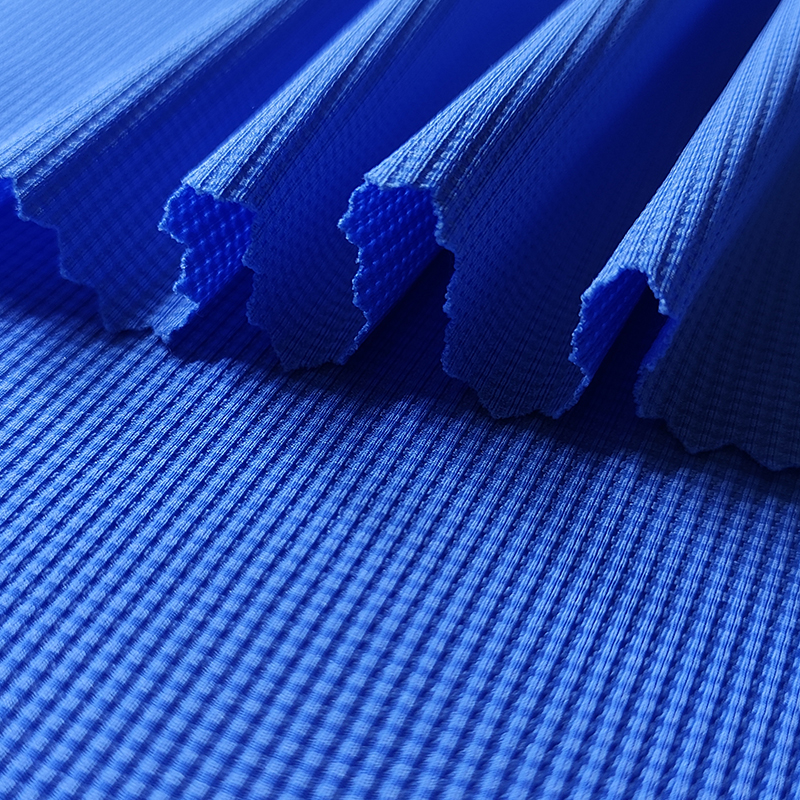
At the same time, compared with traditional polyester fibers, Marine recycled polyester adopts a special regeneration process, and its fiber structure may be more compact, thus improving the strength and wear resistance of the fiber. In addition, Marine recycled polyester also has good moisture absorption and air permeability, making the textile more comfortable and durable.
Traditional polyester is widely used in clothing, household goods, industrial supplies and other fields. Marine recycled polyester, due to its unique environmental protection and excellent performance, is gradually taking a place in the textile market. Especially in the increasing awareness of environmental protection, more and more consumers tend to choose products made of environmentally friendly materials, so Marine recycled polyester has broad market prospects.Because of the emergence of new environmentally friendly materials, we also keep up with the trend. At present, our company's recent new products are several kinds of Marine recycled fabrics, whose raw materials are yarns produced by repreve, and we also have their company's product tags.If you are interested in this, you are also welcome to come to consult, We are also committed to environmental protection, I hope we can make a small contribution to environmental protection.
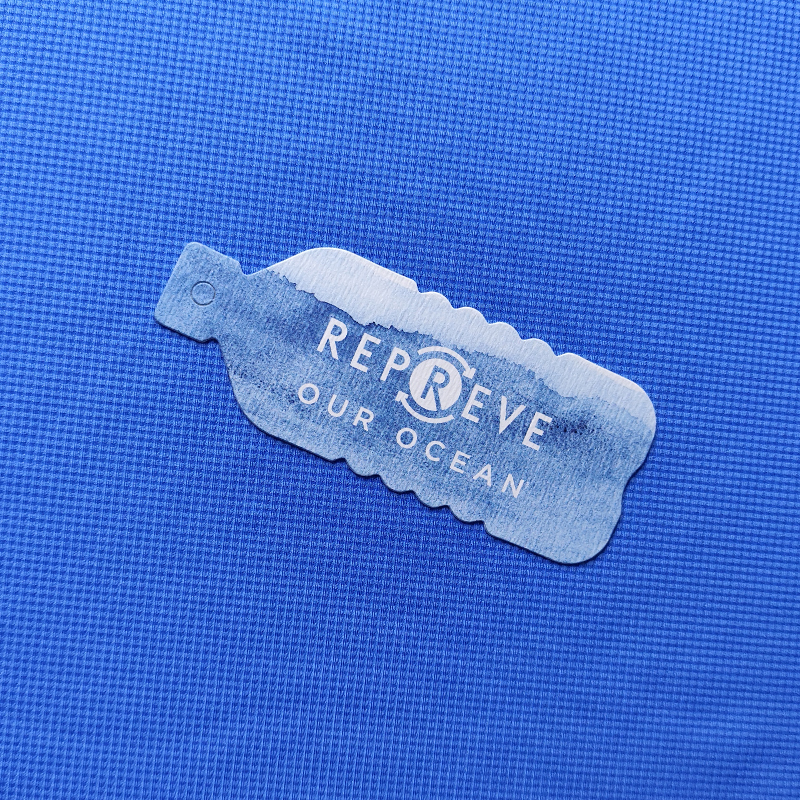
In summary, there are significant differences between Marine recycled polyester and traditional polyester in raw material sources, environmental protection, performance and application fields. As people's attention to environmental issues continues to increase, Marine recycled polyester, which is both environmentally friendly and high-performance materials, will be more and more favored by the market.
Polyester-Ammonia & Nylon-Ammonia Cycling Wear Fabrics for Mountain Trail Riding
As a fabric manufacturer specializing in polyester-spandex and nylon-spandex blends, our cycling apparel textiles are engineered to meet the rigorous demands of mountain trail riding, combining durability, flexibility, and weather resistance. These fabrics cater to both competitive off-road cyclists and recreational riders, offering solutions for high-intensity climbs, technical descents, and variable weather conditions.
polyester spandex Blends (80-85% Polyester + 15-20% Spandex): Optimized for abrasion resistance and moisture-wicking, our polyester spandex fabrics (180-220gsm) withstand rough terrain and brush contact common in mountain biking. The polyester base ensures UV protection (UPF50+), while spandex provides 4-way stretch for dynamic movements like jumps and sharp turns.
Nylon spandex Blends (70-80% Nylon + 20-30% Spandex): Renowned for softness and tear resistance, these fabrics mimic premium brands like Assos, ideal for long-distance endurance rides. Nylon’s hydrophobic properties repel light rain, while spandex maintains compression for muscle support.
Reinforced Panels: High-wear areas (knees, seat, and shoulders) feature double-layered weaves or silicone grippers to prevent slippage during aggressive riding.
Breathability & Weather Adaptability: Laser-cut mesh panels under arms and along the back enhance airflow by 25%, while DWR (Durable Water Repellent) coatings on select variants offer splash resistance without compromising breathability (20,000+ B-1 rating).
Antimicrobial Treatments: Silver-ion or aloe vera-infused finishes inhibit odor-causing bacteria, critical for multi-day trail adventures.
Jerseys & Jackets: Raglan sleeves and articulated seams accommodate cycling postures. Sublimation printing ensures fade-resistant, high-visibility patterns for safety in wooded trails.
Bib Shorts & Tights: Compression zones with flatlock seams reduce chafing, while gripper elastic hems stay secure during jumps. Reflective detailing (inspired by Proviz's REFLECT360) enhances low-light visibility.
Our fabrics meet OEKO-TEX Standard 100 and integrate 30% recycled polyester (GRS-certified) to align with eco-conscious trends. Chlorine-resistant finishes extend garment lifespan, reducing waste from frequent washes.
Professional Teams: Customizable designs with team logos and gradient compression zones for competitive edge.
Outdoor Retailers: Versatile styles for gravel riders and bike packers, emphasizing lightweight durability (≤200gsm).
OEM Partnerships: Bulk orders (MOQ: 100m) with rapid prototyping (7-10 days), catering to brands targeting Asia’s booming cycling market.
By merging trail-specific engineering with scalable production, our polyester spandex and nylon spandex fabrics empower brands to deliver high-performance cycling wear that thrives in rugged environments. For swatches or technical specifications, contact our team to explore tailored solutions.
Engineered for high-intensity sports, this lightweight fabric features a hexagonal honeycomb mesh structure to maximize airflow and keep athletes cool. The polyester blend offers quick-dry moisture management and UV resistance, essential for outdoor football matches. OEKO-TEX® certified for safety, it withstands rigorous movement without losing shape or color vibrancy. Ideal for breathable jerseys and training gear, its durable construction resists abrasion while maintaining a soft touch. Precision manufacturing ensures eco-friendly processes and consistent performance for team uniforms.
Engineered with 3D vertical mesh channels for 50% enhanced airflow (EN ISO 9237 tested), this fabric dries 3x faster than standard knits (AATCC 79). 4-way stretch retains 90% elasticity after 5,000+ cycles (EN 14704), ideal for running gear & cycling jerseys. OEKO-TEX certified UV50+ protection and anti-pilling finish ensure durability. Bulk production in 15 days via 40-ton monthly capacity.
Lightweight blend of polyester and spandex with micro-cool mesh construction for targeted ventilation and heat dispersion during high-intensity activities. Smooth, elastic knit ensures multidirectional stretch and freedom of movement, while resisting pilling and deformation. Quick-dry properties and abrasion-resistant fibers maintain structural integrity through repeated use. Ideal for performance sportswear requiring breathable comfort, adaptive flexibility, and long-term durability in demanding athletic conditions.
Blended fabric combining nylon's abrasion resistance with spandex elasticity in a yarn-dyed jacquard knit for fade-resistant patterns. Lightweight construction ensures breathability and quick drying during athletic use. Jacquard texture adds dimensional durability while retaining stretch flexibility for dynamic movements. Resists pilling and deformation, maintaining professional aesthetics for team uniforms. Suitable for high-performance sportswear requiring design longevity, moisture management, and unrestricted mobility.
Textured jacquard-knit polyester fabric designed for enhanced airflow and multidirectional stretch in high-intensity sports. Lightweight structure balances breathability with abrasion resistance, ideal for dynamic movements in basketball and soccer. Colorfast fibers resist fading from UV exposure and frequent washing. Smooth, low-friction surface minimizes skin irritation during prolonged wear. Suitable for performance jerseys requiring durable, moisture-wicking materials with customizable design versatility.
Nylon and polyester are both durable, but look for fabrics that are specifically treated to resist pilling, tearing, and fading.
Why Polyester Fabric is Cost-Effective
Polyester’s cost-efficiency stems from petrochemical-derived raw materials (PTA/MEG) with stable pricing, high-volume production efficiency (1 ton of polyester yarn costs ~15% less than nylon.), and recyclability (Existing PET bottle recycling streams cut sourcing costs by ~20%.). Its durability lowers garment replacement rates, while easy blending (e.g., with spandex) enhances functionality without major cost hikes.
Yarns are woven (plain/dobby) or knitted (single jersey/pique) on 32-inch circular machines (400+ units mentioned) for breathability/stretch.
Fangtuosi (Trade company) founed---This trading arm integrated Naqi's dyeing facilities with Sanming knitting mills to offer vertical solutions (GRS-certified recycled yarn to finished garments), targeting EU/US eco-conscious brands.
Outstanding patience and considerate service, if you have any questions please call her!
Lab Color Matching: Customized dye formulas are developed using spectrophotometers to meet client-specific Pantone standards.
Breathable polyester-spandex blend with permanent UPF50+ sun protection. Moisture-wicking jersey knit ensures quick drying during activity. Four-way stretch maintains elasticity for dynamic movements. Resists chlorine, saltwater, and UV degradation. OEKO-TEX certified for skin safety. Ideal for performance sports shirts requiring durability and sun protection.
CVC-blended fabric prioritizes cotton's natural comfort with polyester's resilience in a lightweight jersey knit. Engineered for breathability and quick-dry performance during high-intensity activities. Smooth, low-friction surface minimizes skin irritation, while reinforced knit structure resists deformation. OEKO-TEX certified for safe contact with sensitive skin. Optimized for sportswear requiring lasting shape retention and everyday wear adaptability.
Eco-conscious shoppers prioritize sustainability: mentions of “eco-friendly materials” surged post-pandemic. Brands leveraging recycled fabrics (e.g., Patagonia, H&M’s Conscious Collection) meet this demand while enhancing brand loyalty. For instance, FRONTIER’s recycled swimwear demonstrates how performance and sustainability coexist.
Recycled Materials: rPET, Econyl® nylon from ocean waste.
Low-Carbon Production: Energy-efficient processes (e.g., ILs for nanocellulose dissolution) and GRS-certifiedmanufacturing.
Integration of technology transforms fabrics into interactive systems:
Body-coupled fibersgenerate energy from movement, powering wearable sensors for real-time health monitoring (e.g., heart rate, glucose levels).
Color-changing or luminescent textilesadapt to environmental conditions, enhancing visibility in low-light settings.
Self-powered heating fabricswith MXene photothermal coatings maintain warmth in extreme cold, as seen in smart ski jackets.
Recycled Materials: rPET, Econyl® nylon from ocean waste.
Low-Carbon Production: Energy-efficient processes (e.g., ILs for nanocellulose dissolution) and GRS-certifiedmanufacturing.
Includes organic cotton(eco-friendly cultivation), Pima/Egyptian cotton (longer, softer fibers), and blends like cotton-polyester(easy-care) or cotton-spandex(stretch).
While cotton excels in comfort and eco-friendliness, its drawbacks include slower drying times and susceptibility to pilling . Innovations in textile science continue to refine its performance for modern demands.
Cotton adapts to various weaves (e.g., denim, jersey) and blends (e.g., cotton-spandex for stretch), catering to diverse needs from casual tees to formal shirts
Suitable for diverse applications:
Sportswear: Yoga pants, leggings, and cycling shorts (spandex ensures flexibility).
Casual wear: T-shirts, dresses, and outerwear (polyester offers color retention and easy care).
Underwear: Soft elasticity for comfort.
Softness: Advanced finishes like brushing or calendaring create a smooth, skin-friendly texture, crucial for sports bras and base layers.
Color Retention: Polyester holds dyes effectively, allowing vibrant prints and patterns that resist fading from sunlight or frequent washing.
Seamless Construction: The blend’s stretchability supports seamless knitting techniques, reducing chafing and improving comfort in form-fitting designs.
Nylon spandex is 30% lighter than traditional fabrics like polyester, reducing drag in swimwear. Its inherent chlorine resistance (enhanced by treatments like PBT coating) prevents degradation in pool environments, extending garment lifespan. For instance, swimsuits with 76% recycled nylon + 6% spandex blend sustainability with performance
Hiking and Trail Clothing: Ripstop nylon-spandex blends offer tear resistance for jackets and pants in rugged environments.
UV-Protective Apparel: Treated fabrics with nano-SiO₂ coatings provide sun protection for outdoor enthusiasts.
Backpacks and Tents: Lightweight yet durable nylon-spandex variants are used in gear requiring both flexibility and strength.
Product Category | Features | Example |
Yoga/Running Gear | Brushed jacquard for softness, 4-way stretch | New Balance Q Speed Tank |
Outdoor Apparel | Uv-resistant weaves.TPU-coated layers | Weatherproof hiking jackets |
Compression Wear | High-spandex blends for muscle support | Seamless jacquard leggings |
| Swimwear | Chlorine-resistant jacquard with quick-dry | Recycled polyester swimsuits |
Shape-Memory Polymers: These polymers adapt to environmental humidity, opening pores when moisture levels rise to boost breathability .
Nanotechnology: Microporous coatings (e.g., nano-SiO₂) enhance moisture transfer. For instance, Anta’s "Speed King" T-shirts use microporous polyester fibers developed by Sinopec’s Yizheng Chemical Fiber .
Brands leverage digital jacquard looms and heat-transfer vinyl (HTV) to imprint intricate designs without compromising fabric integrity. The integration of smart textiles, such as conductive threads for motion tracking, aligns with trends in wearable tech. Future advancements may include biodegradable Dry Fit variants, like Anta’s PBAT/PVA fibers, to meet sustainability demands
Brands like Tasc Performanceblend UPF50 fabrics with organic cotton or bamboo viscose, balancing eco-friendliness and performance.
Innovations such as recycled polyesterand biodegradable fibers align with global sustainability goals.
UPF50 fabrics undergo rigorous testing under AATCC 183 and AS/NZS 4399 standards to ensure they block ≥98% of UVA/UVB rays.
Lab simulations replicate extreme conditions (e.g., wet fabric) to verify durability
Healthcare: Surgical gowns, masks, and wound dressings (e.g., MRSA-resistant violacein-dyed cotton).
Sportswear: Odor-resistant socks and moisture-wicking activewear.
Consumer Goods: Antimicrobial bedding, towels, and air filters
Nanostructured Surfaces: Graphene or MXene (Ti₃C₂Tₓ) disrupt bacterial membranes via sharp edges or electrical conductivity.
Photocatalytic Materials: TiO₂-coated fabrics generate free radicals under light to degrade pathogens.
High-denier nylon or polyester fabrics resist abrasion and tearing, ideal for rugged outdoor use.
Lightweight laminates (e.g., 2.5-layer Gore-Tex) reduce bulk without compromising performance.
Pre-Treatment: Clean fabrics with pH-neutral detergents to ensure optimal coating adhesion.
Layering Techniques:
3-Layer Construction: Combines outer fabric, membrane, and inner lining for durability (e.g., Gore-Tex Pro®).
2.5-Layer Designs: Reduces weight by bonding a half-layer lining (e.g., Gore-Tex Paclite®).
Seam Sealing: Critical for preventing leaks in extreme environments.
Loose-Fit Designs:
Black, loose-fitting fabrics (e.g., Bedouin robes) create a "chimney effect," where heated air between the fabric and skin rises, promoting airflow and cooling—proven to match or outperform white tight-fitting alternatives .
Textured Fabrics:
Seersucker or piqué weaves lift fabric away from the skin, reducing contact and enhancing airflow .
PP/POE@ZnO fabrics for outdoor workwear.
From casual T-shirts and breathable underwear to luxury bedding and medical textiles, cotton adapts to diverse needs. Its ability to blend with materials like bamboo or recycled polyester expands functionality—e.g., moisture-wicking athletic wear or stain-resistant table linens.
Consumer Preference
Versatility
Used in jeans, activewear, T-shirts, and stretch denim.
Motion-sensing textiles: MXene-coated cotton/spandex yarns monitor body movements (e.g., walking, jumping) for fitness tracking.
Humidity sensors: Detects sweat levels in athletic wear using MXene’s conductivity.
Thermoregulatory clothing: Blends with phase-change microcapsules (PCM) for adaptive temperature control.
Smooth, rounded bamboo fibers minimize skin irritation, suitable for sensitive skin and baby clothing.
Synthetic fibres have been around since the early 1920s’ and slowly evolved as scientific formulas replicated to create affordable alternatives to natural fibres. Some of the most popular synthetic fibres include polyester, nylon, viscose rayon, olefin, and spandex.
Unlike natural fibres that come from plants and animals (such as cotton and hemp), synthetic fibres are made of chemical compounds, usually favoured by manufacturers over natural fibres due to their low cost, higher tenacity, and durability.
Polyester is a synthetic fibre made from petroleum-based chemicals. Its name is shortened to represent a synthetic man-made polymer and is commonly known as a PET (polyethylene terephthalate).
Polyester has a long history, dating back to the early 1900s. However, it wasn’t until the 1950s that it became widely used in textiles. It’s created by combining long chains of synthetic polymers to form a fibre that is typically used to make clothing, upholstery, and carpeting.
In the 1970s’, polyester was marketed as a miracle fabric that was wearable for over 65 days straight without ironing whilst still looking presentable. Now, polyester is one of the most common fabrics in the world and has many great qualities.
Because of polyester’s mechanical resistance, and ability to stretch and shrink; without loss of strength, the fibres are widely used for manufacturing for industrial purposes to create yarns, ropes, conveyor belt fabrics, seatbelts, plastic reinforcements, and more. Polyester is also a popular fibre for textiles, used to manufacture clothing, home furnishings, carpeting and as a mechanical reinforcement aid.
There are many positives to manufacturing with polyester fibres, including:
Polyester is popular for its incredibly high strength and durability, making it a popular choice for textile products that need to withstand daily, strong, and repeated movements, such as sportswear and uniforms.
Polyester consists of synthetic materials, so it’s usually less expensive than natural fibres, making polyester a good choice for businesses looking for budget-friendly manufacturing options.
Polyester is used in a variety of applications and is often blended with other fibres to create a more versatile product. For example, polyester-cotton blends are popular for making garments that require high strength, but also some breathability.
Polyester is a type of plastic that can be melted down and reformed into new products, making it a more sustainable choice than alternative synthetic fibres like nylon.
While polyester fibres have many great qualities, there are also some potential drawbacks to keep in mind.
Polyester is a synthetic fibre made from plastic, meaning it doesn’t absorb moisture as well as natural fibres, which can make it more prone to static and pilling.
While polyester is an excellent choice for products requiring colder temperatures, it has a tendency to retain heat. Therefore, it’s not entirely suitable for manufacturing products that need to facilitate airflow.
Polyester fibres have low absorbency, so they’re not ideal for manufacturing products that need to soak up moisture, such as activewear, towels, or bedding.
Polyester fibres are typically made from polyethylene terephthalate, a type of plastic. Although polyester is recyclable, it’s still not a completely green and sustainable option.
Designed for aquatic adventures, this flexible fabric combines nylon's durability with spandex's stretch for perfect body adaptation. Its subtle matte texture ensures a stylish finish, while chlorine resistance and quick-drying capabilities suit frequent water exposure. Lightweight yet strong, it moves seamlessly with surfers and swimmers, maintaining shape after repeated use. Breathable and moisture-managing, it offers comfort for active beachwear. Available in eco-conscious recycled options, ideal for high-performance swimsuits, bikinis, and sun-ready athletic apparel. Balces practicality with sleek aesthetics.
Crafted for soccer athletes, this breathable fabric features a unique honeycomb mesh texture that enhances airflow during intense matches. The lightweight polyester structure wicks moisture to keep players cool and dry, while resisting snags and fading. Soft, quick-drying, and stretch-friendly, it ensures comfort during high-energy play. Available in eco-conscious recycled options and certified skin-safe, ideal for durable, high-performance soccer jerseys that prioritize sustainability and athletic agility.
Crafted for yoga and high-intensity workouts, this interlock fabric features a 78/22 polyester-spandex blend with double-sided peaching for a buttery-soft feel. Its four-way stretch ensures unrestricted movement while maintaining shape retention during dynamic exercises. Breathable and lightweight, the fabric offers moisture-wicking performance and a smooth, compressive fit ideal for leggings, sports bras, and training gear. OEKO-TEX® certified for skin safety, it resists pilling and fading for lasting durability. The deep black shade stays vibrant through washes, backed by vertical production for color consistency. Perfect for sleek, functional activewear that seamlessly blends performance with everyday comfort.
Crafted for school uniforms and sportswear, this breathable polyester-spandex blend offers four-way stretch for unrestricted movement in track jackets, pants, and tops. Lightweight yet durable, the fabric wicks moisture to keep wearers comfortable during activities while resisting pilling and fading. OEKO-TEX® certified for skin safety, it retains shape through repeated wear and washes, ensuring longevity for daily use. Ideal for athletic and educational settings, the smooth interlock knit provides a polished look with functional flexibility. Vertically integrated production guarantees colorfastness and eco-conscious quality, delivering reliable performance for both sports and school apparel.
Ideal for high-intensity workouts, this breathable fabric blends stretch comfort with a unique eyelet design for maximum airflow. The lightweight knit wicks sweat efficiently, keeping you cool and dry during exercise. Soft against the skin, it resists odors and fading while maintaining shape through repeated wear. Available in eco-friendly recycled options, certified for skin safety. Perfect for gym wear, sports bras, or versatile activewear that prioritizes breathability, mobility, and sustainable durability.
Crafted for premium comfort, this fabric blends Tencel’s silky softness with plant-based fibers for lightweight, breathable wear. Naturally moisture-wicking and quick-drying, it keeps you cool during lounging or casual outings. The smooth texture resists wrinkles, while eco-conscious materials ensure skin-friendly safety. Perfect for high-quality tees, loungewear, or relaxed daily outfits, offering lasting comfort and subtle sheen. Available in sustainable options, balancing everyday elegance with effortless care.
Sportswear fabric is the unsung hero of athletic performance. Designed to withstand the rigors of intense physical activity, sports jersey fabric is engineered with precision, blending innovation with functionality to meet the diverse needs of athletes across various disciplines.
From moisture-wicking properties that keep sweat at bay to breathable materials that enhance airflow, sportswear fabric is meticulously crafted to regulate temperature and keep athletes cool and dry. Stretchable and durable, it provides the flexibility needed for unrestricted movement, allowing athletes to push boundaries without feeling constrained.
The sports fabrics on the sportswear market that qualify as athletic apparel are showing as below:
1. Polyester
2. Nylon
3. Spandex (Lycra)
4. Merino Wool
5. Bamboo
6. Cotton
7. Polypropylene
And among most fabric suppliers, the following are most commonly used
●Polyester
●Nylon
●Spandex (Lycra)
●Bamboo
●Cotton
How much of the sports fabric supplier’s market share the fabric represents depends on the overall market demand for sportswear. All of these fabrics meet the basic performance requirements of sportswear, while the cost is more cost-effective compared to other premium fabrics.
The following is a general differentiation of these fabrics
1. Polyester
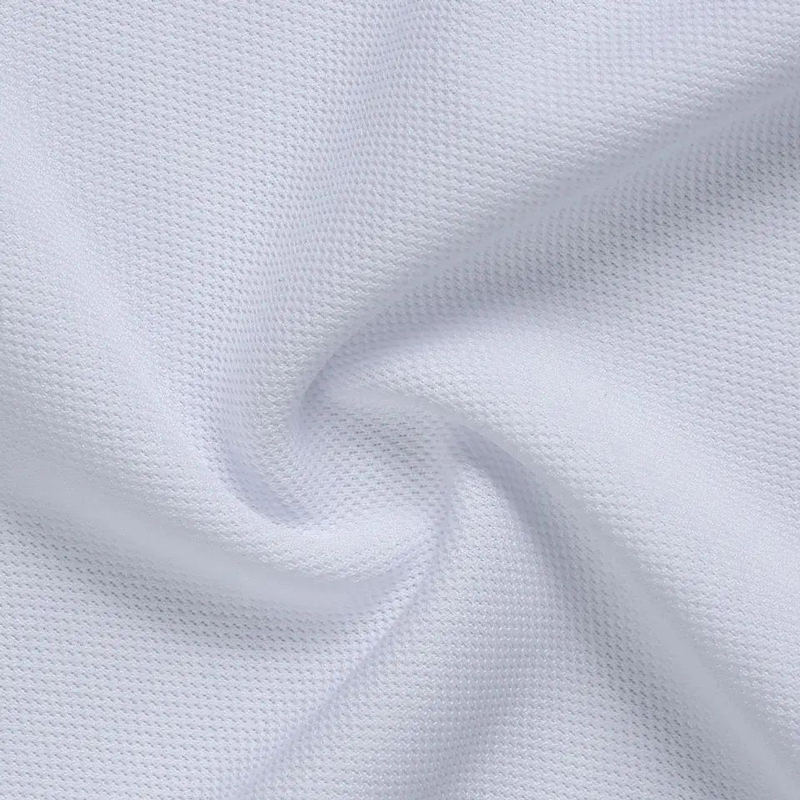
100% Polyester fabric is a synthetic material that is commonly used in sportswear due to its excellent properties that make it well-suited for athletic activities. One of the most commonly used is bird eye mesh fabric. Here are some key characteristics and benefits of polyester fabric in sportswear.
●Moisture-wicking
●Quick-drying
●Durability
●Lightweight
●Breathability
●UV protection
●Color retention
2. Nylon
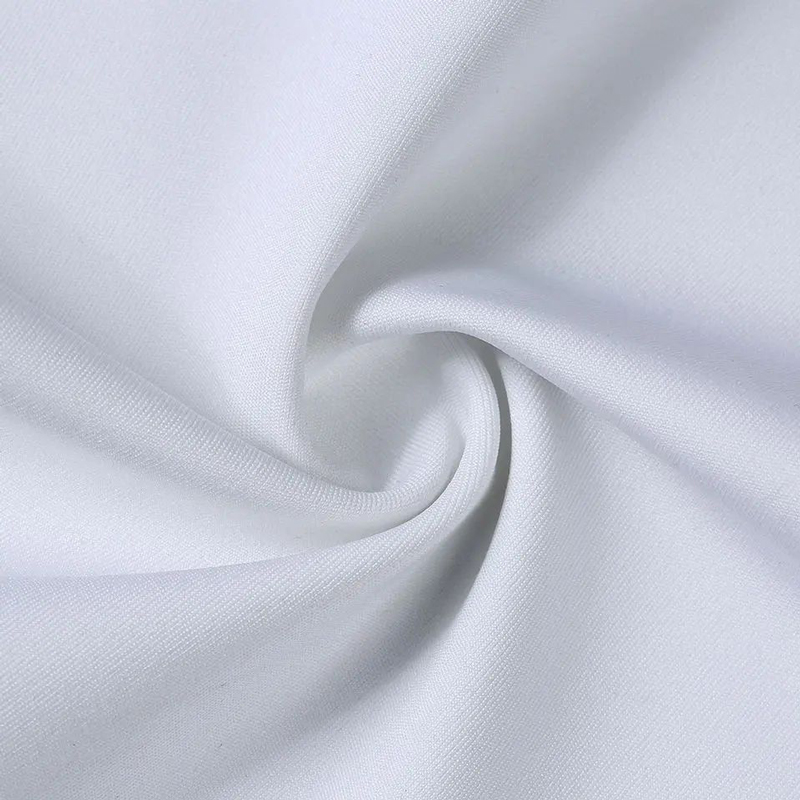
Nylon, which equal to Polymer fabrics, another synthetic fabric commonly used in sportswear.
It is known for its strength and durability, making it ideal for high-performance athletic gear. Nylon (Nylon spandex) is a synthetic polymer known for its strength, elasticity, and durability, commonly used in fabric production. Here are some key points about nylon fabric:
●Durability
●Elasticity
●Lightweight
●Moisture Resistance
Care Instructions
Washing: Nylon sportswear fabric Should be washed in cold water with a mild detergent to preserve elasticity. Avoid fabric softeners.
3. Spandex (Lycra)
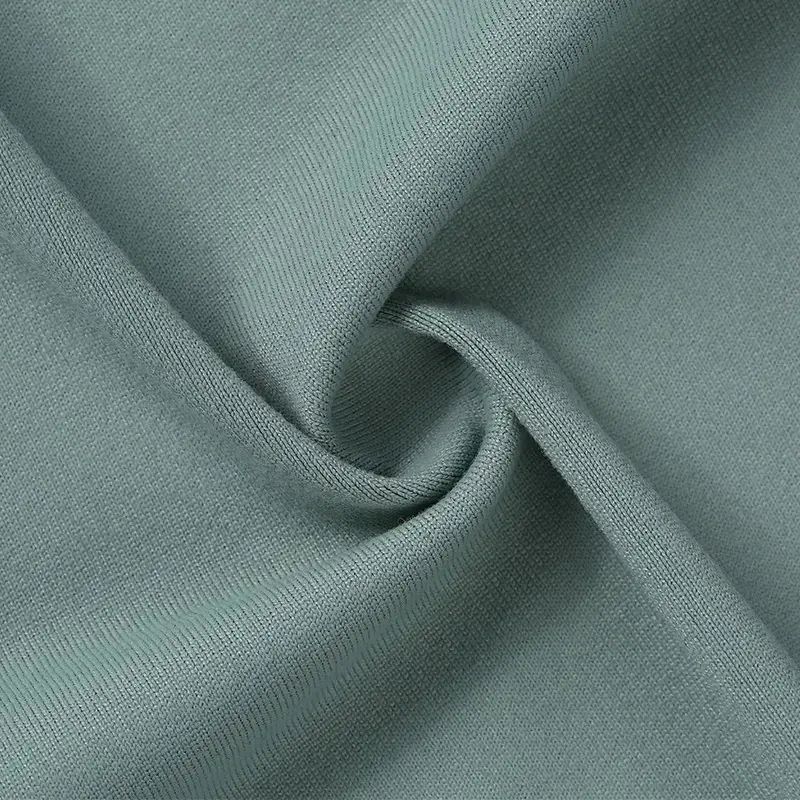
Spandex, also known as Lycra or elastane, is a stretchy fabric known for its exceptional elasticity that provides excellent flexibility and range of motion. It is often blended with other fabrics to give sportswear a snug and comfortable fit. Spandex fabric is a game-changer in the textile industry due to its unique properties that combine comfort, durability, and flexibility, making it an essential component in a wide range of garments.
Here are the key aspects of spandex fabric:
●Elasticity: Can stretch up to five times its original length, providing superior elasticity. But avoid loss of elasticity due to high temperatures.
●Recovery
●Lightweight
●Moisture Wicking
●Smooth and Soft: Provides a smooth, soft texture that is comfortable against the skin.
Care Instructions
Should be washed in cold water with a mild detergent to preserve elasticity. Avoid fabric softeners.
4. Bamboo
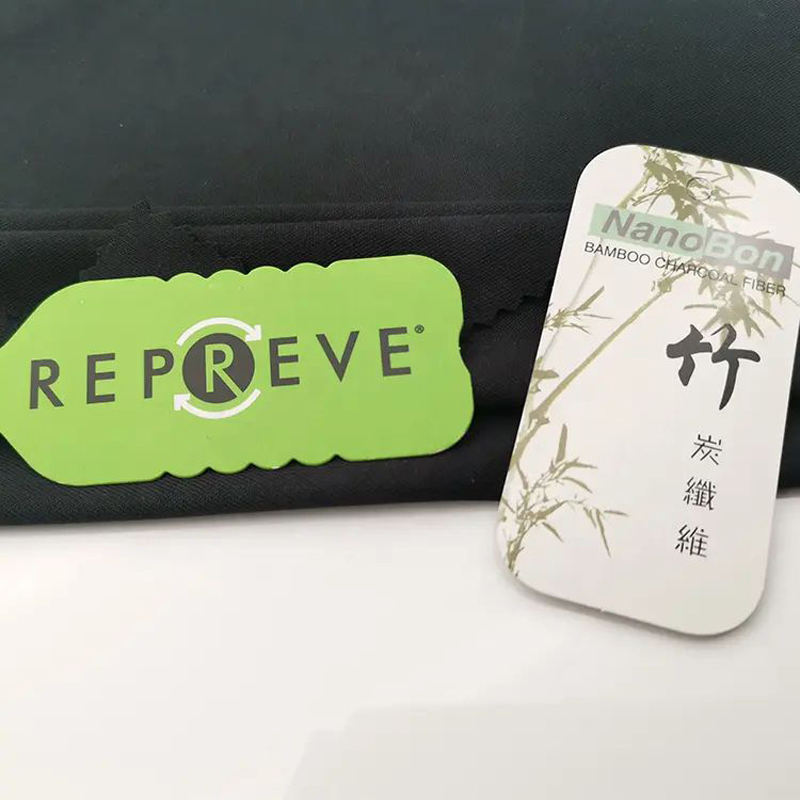
Bamboo fabric is a natural material that is soft, breathable, and moisture-wicking. It is eco-friendly and offers natural UV protection, making it a popular choice for sportswear.
Bamboo fabric, made from the fibers of the bamboo plant, is gaining popularity due to its eco-friendly properties and versatility. Here are the key aspects of bamboo fabric:
Composition and Properties.
●Natural Fiber:
●Softness
●Breathability
●Moisture-Wicking
●Antibacterial
●Hypoallergenic
●Biodegradable
●Care Instructions
Attention
Typically machine washable on a gentle cycle with mild detergent. Avoid using bleach.
5. Cotton
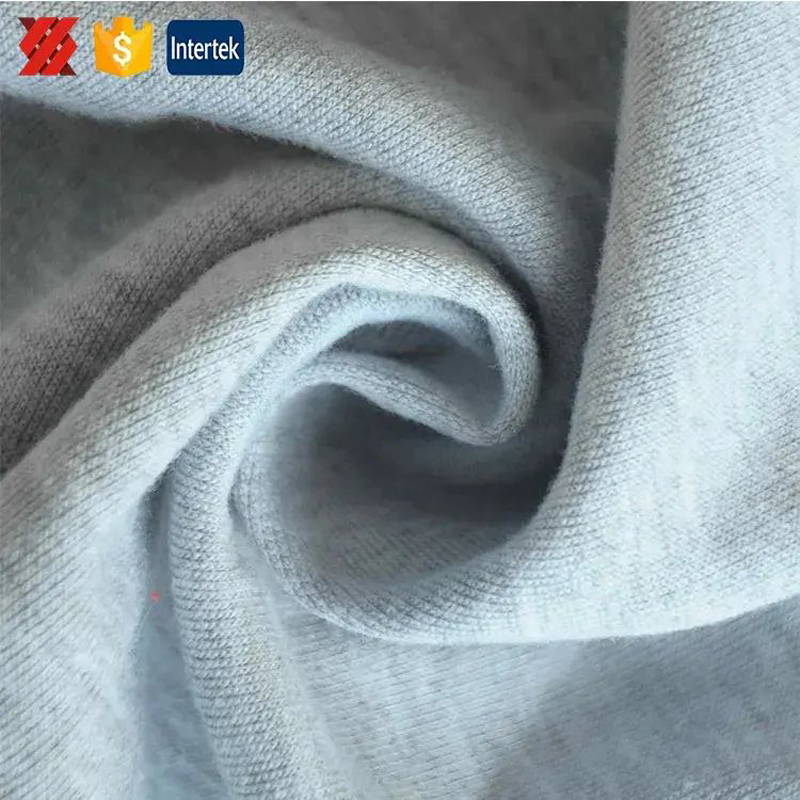
While not as commonly used in high-performance sportswear, cotton is still used in some athletic clothing for its comfort and breathability. However, cotton tends to absorb moisture and can become heavy and uncomfortable during intense physical activity.
Cotton fabric is one of the most widely used and versatile textiles globally, known for its comfort, breathability, and natural origin. Here are the key points about cotton fabric
●Natural Fiber
●Softness
●Breathability
●Moisture Absorption
●Hypoallergenic
●Durability
●Biodegradable
Care Instructions
Washing: Machine washable in warm or cold water. Pre-shrunk cotton items have less risk of shrinking.
Cotton fabric’s natural comfort, versatility, and durability make it a staple in the textile industry. Its wide range of applications, from everyday clothing to specialized medical textiles, highlights its importance and adaptability. Choosing organic cotton can further enhance its eco-friendly benefits, making it a responsible choice for environmentally conscious consumers.
6. Polypropylene
Polypropylene is a moisture-wicking fabric that is lightweight and breathable. It is often used in base layers for sports that require intense physical activity.
It is also known for its various functional properties and is widely used in numerous applications. Here are the key aspects of polypropylene fabric:
●Lightweight
●Durability
●Moisture Resistance
●Chemical Resistance
●Breathability
●Non-toxic and Hypoallergenic: Safe for use in medical and hygiene products, which is the characteristic that distinguishes it from other fabrics.
Care Instructions
Can generally be machine washed with cold water; avoid high-heat drying.
As a fabric manufacturer and semi-finished garment supplier, our 100% polyester football/soccer jerseys prioritize performance, durability, and customization flexibility, catering to professional teams, clubs, and retail brands. Below is a detailed breakdown of this category:
Our jerseys utilize 100% polyester fabrics (150-190gsm weight range), specifically engineered for high-intensity sports. Key fabric subtypes include:
Breathable Mesh: Open hexagonal or diamond-knit structures enhance airflow by 30% compared to standard knits, critical for heat dissipation during matches.
Moisture-Wicking Variants: Hydrophilic polyester fibers rapidly absorb sweat and disperse it across the fabric surface, accelerating evaporation.
Sublimation-Ready Fabrics: Optimized for dye-sublimation printing to achieve fade-resistant team colors and intricate designs.
Thermal Regulation: Laser-cut ventilation zones and mesh panels target high-sweat areas (underarms, back) to maintain core temperature stability.
Abrasion Resistance: Reinforced seams and double-needle stitching withstand frequent contact and washing cycles, extending garment lifespan.
Lightweight Construction: At ≤180gsm, the fabric reduces drag while retaining tensile strength, ideal for speed-focused players.
OEM Services: Customizable elements include team logos, player names/numbers, and color schemes via digital heat transfer or embroidery.
Advanced Printing Techniques:
Dye-Sublimation: For vibrant, all-over prints resistant to cracking.
Silk-Screen Printing: Durable localized graphics for sponsor logos.
Eco-Certifications: Select fabrics meet GRS (Global Recycled Standard) and OEKO-TEX Standard 100, ensuring safe, recycled content (up to 30% post-consumer polyester).
Quality Assurance: ISO 9001-certified production lines guarantee colorfastness (4-5级) and dimensional stability after 50+ washes.
Our jerseys serve:
Professional Teams: Customized designs for league matches.
Youth Academies: Sizes ranging from 120cm (children) to 5XL (adults).
Retail Brands: White-label options for e-commerce platforms.
By merging technical precision with scalable production, we empower clients to balance athletic performance and branding needs seamlessly. For tailored solutions or fabric swatches, contact our OEM team to discuss project specifications.
Spandex polyester mesh fabric is a high-performance textile combining polyester's durability with spandex's elasticity (typically 5–20% spandex). Its porous mesh structure enhances breathability and moisture-wicking, ideal for sportswear, activewear, and swimwear. The blend offers exceptional stretch (up to 500% elasticity) while maintaining shape recovery, ensuring comfort during dynamic movements. Lightweight yet durable, it resists wrinkles and abrasion, suited for yoga pants, compression gear, and outdoor apparel. Innovations include UV protection, antimicrobial treatments, and eco-friendly recycled variants. Widely used in Asia and Western markets, it balances functionality, modern aesthetics, and adaptability to diverse climates.
Jacquard-knit polyester fabric with integrated sports mesh panels for targeted airflow and rapid moisture dispersion. Lightweight, textured weave enhances breathability while maintaining durability for high-intensity training. Four-way stretch ensures unrestricted movement, and abrasion-resistant fibers resist pilling during repeated use. Quick-dry properties and smooth surface optimize comfort in prolonged wear. Suitable for performance sportswear requiring strategic ventilation, structural flexibility, and long-lasting resilience.
EN 14704 tested 4-way stretch with 92% elastic recovery after 50+ industrial washes. Micro-porous weave reduces surface temperature by 3°C during activity (ASTM D1518 verified). OEKO-TEX certified anti-pilling finish maintains appearance through 200+ cycles. Ideal for daily sports uniforms & training gear with UV50+ protection. Custom school logos/colors accepted.
Blended fabric combining nylon's lightweight durability with spandex elasticity in a smooth single jersey knit. High-stretch construction supports dynamic movements while retaining shape through repeated wear. Breathable structure enhances airflow during intense activity, and abrasion-resistant fibers resist pilling. Quick-drying properties and chlorine resistance ensure longevity in active environments. Ideal for sportswear prioritizing flexibility, comfort, and long-term performance. OEKO-TEX certified for safe skin contact.
Cationic-dyed polyester fabric ensures vibrant color retention and resistance to fading, paired with jacquard-knit textures for dynamic visual appeal. Lightweight, breathable structure supports moisture management during high-intensity play. Four-way stretch enhances mobility, while abrasion-resistant fibers withstand rigorous movement and repeated washing. Ideal for football jerseys requiring bold designs, durability, and athletic performance. OEKO-TEX certified for skin-safe wear.
Specialized performance fabrics with UV-protective treatments (UPF-rated fabrics), such as polyester, nylon, and certain blends.
Polyester can be blended with other fibers like cotton, wool, or elastane, giving it a range of properties depending on the intended use to create hybrid materials with the best features of each fiber.
Jet dyeing with disperse dyes (130°C for colorfastness), followed by anti-pilling/UV-resistant coatings (OEKO-TEX certified chemicals).
New knitting factory in Sanming founded---Equipped with 400+ circular knitting machines, the factory achieved 15000-ton/month capacity for seamless athletic wear, supporting Fujian's textile cluster modernization.
Positive work attitude, after-sales service is very secure, so that customers can rest assured that orders
Dyeing Vat Process: 12 dyeing lines achieve ≤0.8% color deviation with OEKO-TEX certified chemicals for eco-compliance.
Advances in recycling tech address traditional limitations.
Standardization: Lack of unified protocols for durabilityand data security.
User Acceptance: Balancingcomfortwith technical complexity, especially for aging populations.
AI-Driven Evolution: Integration with machine learningfor predictive health analytics and IoT-enabled smart environments.
Tailored solutions address niche demands:
Antimicrobial treatments (e.g., SuperSilva™ with silver ions) combat odor-causing bacteria in high-sweat scenarios.
Waterproof-breathable membranes (e.g., e-PTFE microporous films) block rain while allowing vapor escape, critical for mountaineering.
Compression technologyimproves blood flow and reduces muscle vibration, boosting endurance in athletes
Standardization: Lack of unified protocols for durabilityand data security.
User Acceptance: Balancingcomfortwith technical complexity, especially for aging populations.
AI-Driven Evolution: Integration with machine learningfor predictive health analytics and IoT-enabled smart environments.
Polyester is affordable, and even small spandex additions (e.g., 5%) significantly improve functionality without drastically increasing costs.
Traditional polyester relies on petrochemicals, but recycled polyester (rPET) from plastic bottles and bio-based spandex are emerging to reduce environmental impact. Certifications like OEKO-TEX and GRS ensure safer, eco-friendly production processes.
Vibrant Color Retention: Nylon holds dyes exceptionally well, resisting fading from sunlight or repeated washing.
Textured Finishes: Options like ribbed or double-knit surfaces add visual interest and tactile softness
Compression Socks and Bandages: The fabric’s elasticity aids in improving blood circulation and supporting injured muscles.
Orthopedic Braces: Combines comfort with structural support for medical applications.
Digital looms now replace punch cards, enabling intricate, customizable designs with computer programming.
Sustainability: Brands use recycled nylon, organic cotton, and eco-friendly dyes to reduce environmental impact.
Microwave-Convection (MWC) Drying: Effective for removing free water from fabrics, MWC ensures uniform drying with minimal shrinkage, outperforming traditional hot-air methods .
Heat-Pump Dryers: Optimize energy efficiency by balancing drum rotation speed and airflow, preserving fabric integrity .
Global demand for performance wear drives brands to adopt Dry Fit as a competitive differentiator. Israeli manufacturer Polaris prioritizes Dry Fit for military gear due to its moisture-wicking reliability, while retailers like New Balance emphasize recycled polyesterversions to appeal to eco-conscious consumers
UPF50 clothing reduces cumulative UV damage, lowering risks of skin cancer and photoaging.
Recommended for high-risk groups (e.g., children, outdoor workers) due to its reliable, chemical-free protection.
Hybrid Fabrication: Combines fiber modification and post-treatment. For example, copper-based metal-organic frameworks (MOFs) are integrated with graphene oxide to enhance stability and dispersion on cotton.
Result: Sustained copper ion release ensures long-term antibacterial action.
Softshell fabrics with stretch properties (e.g., Storm Cotton) combine mobility with urban-friendly designs.
Luxury adaptations (e.g., Loro Piana’s Storm System) integrate waterproofing into wool or cashmere for refined outerwear.
Waterproof Standards: ISO 810 (hydrostatic pressure >20,000 mm).
Environmental Compliance: Bluesign® or OEKO-TEX® ensures chemical safety and low-carbon production.
Natural Fibers:
Linen and cotton allow unrestricted airflow and absorb moisture without trapping heat, ideal for dry climates . Bamboo-PU blends add antimicrobial properties while maintaining breathability .
Eco-Friendly Treatments:
Fluorine-free DWR (Durable Water Repellent) coatings and recycled polymers (e.g., TPU) reduce environmental impact without compromising cooling performance .
Breathable designs for extreme heat.
Over 70% of shoppers actively seek 100% cotton for its perceived quality and sustainability. Its timeless appeal bridges generations, with innovations like graphene-infused cotton for thermoregulation ensuring relevance in modern performance wear.
Environmental Footprint
Technological Integration
Resists wrinkles and retains shape after washing.
Automotive interiors: Elastic upholstery fabrics for car seats and headrests.
Protective workwear: Reinforced blends for gloves or safety suits requiring stretch and durability.
Home textiles: Stretchable bed linens and sofa covers that resist pilling.
| Criteria | CVC (≥60% Cotton) | TC(≥60% Polyester) |
| Primary Fiber | Cotton (≥60%) | Polyester (260%) |
| Key Properties | Soft, breathable, hypoallergenic Moderate wrinkle resistance Higher moisture absorption | Wrinkle-resistant, durable Quick-drying. stiff texture Poor moisture absorption |
Strengths | Natural comfort, skin-friendly Better heat retention | Shape retention, low shrinkage Cost-effective, easy maintenance |
| Weaknesses | Prone to shrinkage/pilling Requires ironing | Static buildup, attracts dust Less breathable |
Common Uses | Casualwear (T-shirts, jeans) Medical textiles | Uniforms, workwear Industrial fabrics |
Dyeing & Color | Natural dyes, muted tones Moderate colorfastness | Bright, vibrant colors Superior color retention |
Static Charge | Low (cotton-dominant) | High (polyester-dominant) |
Burn Test | Charred residue (cotton-like) | Melts with black smoke (plastic-like) |
| Price | Higher (due to cotton content) | Lower(synthetic dominance) |
Blocks 99% of harmful UV rays, while cotton-bamboo blends enhance fabric strength and longevity.
Mesh cloth is a versatile and breathable fabric that is commonly used in various industries, especially in clothing, home textiles, and industrial applications. It is often referred to by several names depending on its weaving style and post-processing, including weft-knitted flat jersey, bleaching jersey, fine jersey bleaching, singeing mercerized jersey, plain jersey, jersey printing, color stripes jersey, navy stripe jersey, blended single jersey, silk jersey, acrylic jersey, polyester jersey, and ramie jersey. Each type brings subtle differences in texture, weight, and application.
Mesh cloth specifically refers to fabrics that have structured, open apertures — a pattern of small holes throughout the fabric. These holes allow for exceptional airflow and lightness, making mesh fabric highly sought after for hot and humid conditions. The apertures can vary in size and shape depending on the machinery and techniques used in production, resulting in different styles of mesh for different needs.
Mesh cloth can be manufactured through two main processes: woven mesh and knitted mesh. Woven mesh is created using traditional weaving techniques with white or dyed yarns and can include intricate patterns such as jacquards. Knitted mesh, on the other hand, is more flexible and stretchable, making it ideal for garments that require ease of movement.
Advantages:Mesh cloth’s greatest strength lies in its air permeability. The structured openings between the yarns allow for excellent ventilation, keeping the wearer cool even in hot temperatures. After dyeing and finishing, the fabric often feels fresh, soft, and breathable. Its lightweight and refreshing quality make it perfect not only for summer clothing but also for home items like curtains and mosquito nets, where airflow is essential.
Disadvantages:Despite its many strengths, mesh cloth is not suitable for warmth. Due to its open construction, it lacks insulation properties and is relatively translucent. As a result, it may not be ideal for winter wear or situations where privacy is necessary unless it is layered with other materials.
Mesh cloth is an incredibly adaptable fabric. Its breathable nature makes it ideal for summer apparel such as sportswear, activewear, casual t-shirts, and even stylish dresses. Beyond fashion, its uses extend into the home and industrial sectors.
For household purposes, mesh fabric is perfect for making curtains, mosquito nets, storage bags, and laundry hampers, providing utility without sacrificing airflow. Industrial uses include safety vests, office chair backs, tent windows, and various filtration applications.
The versatility of mesh fabric largely depends on the weaving equipment and techniques used, allowing manufacturers to create diverse types of mesh that meet specific functional and aesthetic needs.
Bird’s Eye Cloth, also known as honeycomb fabric, is a specific type of knitted mesh fabric distinguished by its unique pattern resembling the eye of a bird. It is primarily made from polyester, but can also incorporate cotton or blended fibers for different qualities.
The structure of Bird’s Eye Cloth provides small, uniform cavities across the surface, greatly enhancing its moisture-wicking and breathable properties. After weaving, dyeing, and finishing processes, Bird’s Eye Cloth becomes an ideal material for sportswear, casual apparel, and textiles requiring moisture management.
Some variations of Bird’s Eye Cloth even include a small percentage of spandex, providing stretchability and making the fabric even more versatile. This allows it to be used for performance-oriented garments where flexibility and freedom of movement are crucial, such as sports uniforms, yoga wear, and fitted t-shirts.
Popular types of Bird’s Eye Cloth include:
Sports Bird’s Eye Cloth: Optimized for performance, offering maximum breathability and sweat evaporation.
Moisture-Wicking Bird’s Eye Cloth: Specialized in drawing moisture away from the skin.
Apparel Bird’s Eye Cloth: Used for stylish, casual garments.
T-shirt Bird’s Eye Cloth: Lightweight and breathable, ideal for everyday wear.
Bird's Eye Cloth continues to grow in popularity due to its adaptability and functional advantages, especially in the ever-expanding world of athleisure and performance apparel.
Designed for water enthusiasts, this lightweight mesh fabric offers breathable comfort and lasting durability. The polyester-spandex blend resists pool chemicals while wicking moisture, keeping wearers cool during surfing or swimming. Its stretchy mesh structure ensures unrestricted movement, adapting to active beachwear and swimsuits. Soft against the skin with quick-drying properties, it maintains vibrant colors through repeated use. Available in eco-friendly recycled options, ideal for high-performance swimwear and casual water sports apparel. Combines practicality with all-day comfort.
100% polyester cube mesh fabric is a lightweight, breathable textile featuring a three-dimensional cube-like woven structure, combining durability with enhanced airflow. Ideal for sportswear and activewear, it offers moisture-wicking, quick-drying properties, and UV resistance for outdoor performance. The geometric cube pattern adds texture while maintaining flexibility and stretch, ensuring comfort during dynamic movements. Its abrasion-resistant surface resists pilling and retains shape after repeated washes. Suitable for jerseys, linings, and athleisure, it can incorporate recycled polyester (rPET) for sustainability. The semi-rigid yet soft texture allows creative applications in technical apparel or decorative panels, balancing functionality with aesthetic versatility. Machine-washable and colorfast, it prioritizes low-maintenance practicality.
Crafted for yoga and activewear, this interlock knit fabric combines 78% polyester and 22% spandex for a luxuriously soft, four-way stretch that moves seamlessly with your body. Lightweight yet durable, it offers breathable comfort, moisture-wicking performance, and superior shape retention during high-intensity workouts. OEKO-TEX® certified for skin safety and made with eco-conscious processes, the fabric resists pilling and fading for long-lasting wear. Ideal for yoga leggings and compression wear, its smooth, interlocked structure ensures a flattering, second-skin fit. Vertically integrated production guarantees consistent quality and vibrant color options.
Perfect for active lifestyles, this stretchy fabric blends lightweight comfort with breathable flexibility for workouts, running, or casual wear. The soft, moisture-wicking knit keeps you dry while resisting odors and fading. Rich, long-lasting colors add vibrancy to sportswear designs. Available in eco-friendly recycled options, certified skin-safe for sensitive skin. Ideal for athletic apparel that balances everyday comfort, durability, and sustainable performance.
Ideal for daily comfort, this fabric blends cotton’s softness with Sorona’s moisture-wicking technology to stay cool and dry. The ribbed texture enhances breathability, perfect for tees or casual loungewear. Gentle on the skin, it resists shrinking and pilling, maintaining a smooth finish wash after wash. Available in eco-friendly options, it combines sustainability with durability for versatile, all-season wear. Lightweight and easy-care, designed for effortless style and lasting comfort.
Solve problems on the front line and focus on breakthroughs. Youxi County focuses on the pain points and difficulties in the construction of enterprise development projects, adheres to the front-line work method, and promotes the speed and efficiency of project construction.
In Fujian East Xinwei Textile Technology Co., Ltd., the staff of the County Development and Reform Bureau is having a discussion with the person in charge of the company to guide the enterprise to apply for the regulation work. A brief symposium exchange to solve the pressing problems of the enterprise.
East Xinwei Textile Project is located in Chengnan Park of Youxi Economic Development Zone. It is a key provincial construction project with a total investment of 380 million yuan. It belongs to the project that was introduced, constructed and put into production in that year. Due to the short construction time, enterprises have accumulated a lot of problems in the registration application and development. Yang Gen, deputy director of the County Development and Reform Bureau, said that in the next 100-day work in the county, it is necessary to strengthen responsibility, go to the front line in a timely manner, understand and sort out some problems existing in enterprises or projects, and form ledger management. Immediately study the problems that have been sorted out, do it immediately, and forcefully break through the problems.
Everything revolves around tackling, and everything revolves around tackling. In recent days, our county has set off a wave of “hundred-day attacking fortifications” in an all-round way. Officials of the government have settled down at the grassroots level and penetrated into the front line, focusing on urban development and construction, transportation infrastructure, industrial projects and park platforms, and rural revitalization. The project solves problems and promotes high-quality economic development. The county’s urban “five difficulties” governance and rectification, urban infrastructure construction, poverty alleviation, rural revitalization demonstration and establishment, industrial platform construction, cultivating enterprise regulations, and Puyan Expressway (Xinyang Section) construction and other specific work accelerated. Up to now, the county has 277 “five batches” projects in the library, including 98 new projects this year; 28 provincial and municipal key projects have completed an investment of 1.949 billion yuan this year, accounting for 74.81% of the annual plan. 8.14 percentage points.
Cotton spandex single jersey fabric is a lightweight, breathable knit composed of 95% cotton and 5% spandex. Its 4-way stretch ensures flexibility and shape retention, ideal for activewear, T-shirts, and underwear. The single jersey structure features a smooth face and textured back, offering softness and durability. Moisture-wicking and hypoallergenic, it provides comfort in warm climates while resisting wrinkles and pilling. Common in seamless designs, it adapts to body contours without chafing. Eco-friendly variants may include recycled fibers or OEKO-TEX certifications. Machine-washable at 30°C, it maintains elasticity and color vibrancy over time
Blended fabric combining polyester's durability with spandex elasticity in a knit jersey base, integrated with butterfly mesh panels for targeted ventilation. Lightweight structure promotes airflow and rapid moisture dispersion during intense activity. Ergonomic stretch supports dynamic movements while resisting pilling and deformation. Chlorine/saltwater-resistant fibers ensure longevity in active environments. OEKO-TEX certified for skin safety. Suitable for sportswear requiring breathability, strategic cooling zones, and long-term wear resilience.
functional fabric with antimicrobial treatments, or synthetic blends treated with odor-resistant finishes.
Post-consumer waste is shredded → depolymerized into BHET → re-polymerized (closed-loop for GRS certification).
In 2021, the company wascertified as a National High-Tech Enterprise for meeting criteria like R&D investment ratios, intellectual property ownership, and tech talent density, while also being recognized as a Tech SME Giant for achieving 20%+ annual growth, industry-leading innovation, and advanced R&D systems
High-Stability Setting: Stabilize fabric dimensions and enhance functional properties (e.g., UV resistance) through controlled heat.
For Activewear: Choose blends with 5–10% spandex for optimal stretch and recovery (e.g., yoga pants).
For Daily Use: Opt for brushed or ribbed finishes to enhance softness and warmth in loungewear.
Sustainability Focus: Seek GRS-certified recycled polyester or plant-derived spandex alternatives.
High-Impact Gear: Leggings, cycling shorts, and sports bras (20% spandex for maximum stretch).
Swimwear: Chlorine-resistant knits with quick-drying properties.
Casual Activewear: Joggers and hoodies with brushed finishes for warmth and softness
Nylon spandex fabric (typically 80–85% nylon + 15–20% spandex) has become a gold standard for swimwear and athleisure due to its unmatched combination of stretch, durability, and functional versatility. Here’s a detailed breakdown of its performance advantages:
Brands are adopting recycled nylon (e.g., from ocean plastics) and bio-based spandex to reduce environmental impact. Certifications like OEKO-TEX and GRS ensure safer chemical standards and eco-conscious production.
Form-Fitting Dresses and Jerseys: The blend’s stretch and wrinkle resistance make it ideal for bodycon dresses and athletic-inspired streetwear.
Undergarments: Soft, breathable variants are used in lingerie and shapewear for comfort and durability
Recycled Materials: Brands like New Balance use100% recycled polyester in quick-drying apparel, reducing environmental impact .
Biodegradable Fibers: Innovations like PBAT/PVA composite fibers(Anta) combine quick-drying properties with biodegradability .
Recyclable materials like TPU replace PVC to reduce environmental impact.
Bio-based membranes (e.g., eVent BIO) align with eco-conscious manufacturing trends.
Nikwax TX.Direct® Spray: Restores DWR (Durable Water Repellency) without heat, extending garment lifespan.
Wash Care: Use mild detergents and avoid fabric softeners to preserve waterproof coatings.
Fabrics meeting OEKO-TEX® or Bluesign® standards ensure chemical safety and thermal efficiency, critical for prolonged wear in extreme conditions
Fluorinated resins enhance cooling durability.
Wicks sweat while maintaining soft texture.
Decomposes naturally within 180 days without microplastic pollution, aligning with circular fashion principles.
Crafted for swimwear and casual wear, this nylon-spandex blend resists pool chemicals while offering natural stretch. The smooth, breathable fabric dries quickly and retains shape through swimming or surfing. Soft against the skin with fade-resistant colors, it’s ideal for bikinis and beach tees. Available in eco-conscious recycled options, meeting global safety standards. Perfectly balances durability and comfort for sun-to-sea activities.
100% polyester mini eyelet mesh fabric is a lightweight, breathable textile characterized by tiny, uniform mesh apertures for enhanced airflow. Its knit structure combines durability with flexibility, ideal for sportswear, athletic linings, and casual apparel. The fabric wicks moisture efficiently, dries quickly, and resists wrinkles and abrasion, maintaining shape and color vibrancy after repeated washes. UV-resistant and machine-washable, it supports functional treatments like antimicrobial coatings or recycled polyester (rPET) for sustainability. The mini eyelet design balances stretch and compression, ensuring comfort in dynamic movements. Suitable for diverse climates, it merges technical performance with low-maintenance practicality.
Crafted for eco-conscious performance, this GRS-certified fabric utilizes REPREVE® recycled polyester to deliver durability and a soft, stretchable texture perfect for leggings and activewear. Its four-way stretch ensures freedom of movement, while moisture-wicking properties keep you dry during workouts. OEKO-TEX® certified for skin safety, the fabric resists pilling and retains shape through repeated use. Ideal for yoga pants, sports bras, and gym wear, it combines sustainability with high-performance functionality. Vertically integrated production ensures colorfastness and eco-friendly processing from yarn to finish.
Engineered for active lifestyles, this fabric blends nylon's durability with spandex flexibility for full-range movement in cycling, gym workouts, or casual wear. The textured knit design enhances breathability while wicking moisture to keep you cool. Soft, fade-resistant, and quick-drying, it maintains shape through intense activity. Available in eco-conscious recycled options, certified skin-safe and perfect for sportswear, tees, or jerseys that balance performance with stylish, everyday comfort.
Crafted for everyday comfort, this fabric combines modal’s silky softness with spandex stretch for a smooth, breathable feel. The lightweight knit resists wrinkles and holds its shape, ideal for casual tees or relaxed-fit tops. Gentle on sensitive skin, it wicks moisture naturally and stays cool in warm weather. Available in eco-conscious recycled options, certified for safety and durability. Perfect for effortless styles that prioritize comfort and sustainable versatility.
Polyester is a chemical fiber, and its raw materials are polyethylene terephthalate and ethylene glycol, which mainly come from petroleum, coal, and natural gas. It is a very practical synthetic fiber, widely used in fields such as textile and clothing manufacturing, bringing us a lot of convenience and comfort in our daily life.
Because of the polyester fiber made by spinning and post-processing, which has the advantages of good chemical resistance, heat resistance, thermoplasticity, light resistance, good elasticity and strong recovery ability, durability and wrinkle resistance. The disadvantage is that its dyeing, moisture absorption, and melt resistance are relatively poor, and it is also prone to pilling.
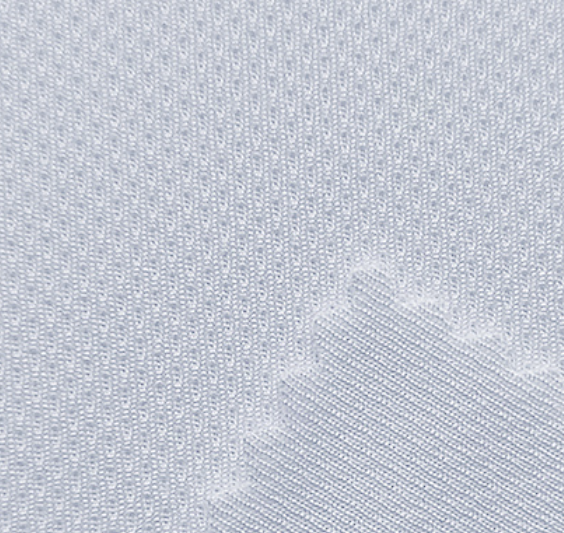
There are many advantages to polyester fabric, and the most representative one is its good chemical resistance, minimal damage caused by acid and alkali, and no fear of mold and insect infestation. It also has good heat resistance and thermoplasticity, similar to acrylic kfabric in light resistance, high strength and good elasticity, strong recovery ability, and the characteristics of firmness, durability, and wrinkle resistance.
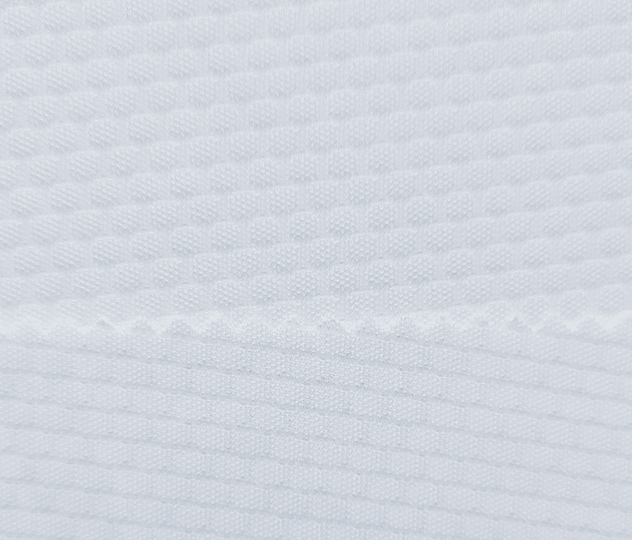
In the field of clothing, polyester fabric is often used to make casual wear, sportswear, outdoor clothing, etc. Due to its lightweight, comfortable, and durable characteristics, polyester fabric has been widely used in clothing production in these fields. At the same time, due to the relatively low price of polyester fibers, the manufacturing cost of polyester fabrics is also relatively low, making the price of polyester fabrics for clothing relatively affordable.
100%polyester knitted fabric have a lot kind of category,according to the different patterns, there are many types that can be distinguished,such as eyelet mesh fabric,honeycomb mesh fabric,sports jersey fabric etc.You can choose different styles to make clothing according to your needs.For example, if you need to make football jerseys, it is recommended to use100% polyester fabric,at a lower price, It has good breathability and water absorption,of course, we can also achieve this by adding additives.Meanwhile, 100%polyester fabrics are also suitable for sublimation printing.Our main product in the factory is also 100%polyester fabric, and we can customize according to your requirements to get the product you want.
100% polyester knitted fabric is an excellent product with affordable prices and a wide range of fabric uses.When you need to make football jerseys, t-shirts, and sportswear, you can consider using it to produce.Welcome to contact us, we have excellent products and can also provide you with good and high-quality service.
On May 9th, in the weaving workshop of Fujian Youxi Dongfang Xinwei Textile Technology Co., Ltd., a provincial key project, 99 weft knitting machines were fully equipped for uninterrupted production, and 3 production lines could produce 10 tons of clothing fabrics per day.
East Xinwei Textile Project is located in Chengnan Park, Youxi County Economic Development Zone, with a total investment of 380 million yuan, and will build 30 garment fabric production lines. After the project is fully put into production, the annual output value will reach 1.2 billion yuan. In less than 10 months, East Xinwei has completed the construction of a workshop of 18,000 square meters for texturing and weaving. Up to now, it has completed an investment of more than 170 million yuan.
The rapid advancement of East Xinwei project is a microcosm of Youxi County’s major projects to lead the development of industrial clusters. Only in the Chengnan Park of the Economic Development Zone, there are 9 key projects in provinces and cities under construction, with a total investment of 6.08 billion yuan. Behind the boom in project construction is the fruitful result of Youxi County’s efforts to advance the construction of the project. This year, 28 projects in Youxi have been included in the provincial and municipal key projects, and 308 projects have been included in the “five batches” projects.
Everything serves the project, and everything opens the way for the project. Youxi County’s industry and information, power supply, taxation and other departments have carried out in-depth “visiting enterprises, solving problems, and promoting ‘six stability’” service activities. A total of 145 “five difficulties” problems have been collected, involving 85 enterprises, and 118 of which have been solved. item.
At present, various departments at all levels in Youxi County have made great efforts to promote the construction of key projects. In order to solve the problem of electricity consumption in the construction of East Xinwei project, State Grid Youxi County Power Supply Company added outgoing lines from the 110kV Xingming substation, and built a new 10kV line with 960 meters of cables connected to the East Xinwei power distribution room. , to provide power security for enterprises, and the next step will also help enterprises to increase power consumption.
In order to hedge the impact of the epidemic on the economy, Youxi County seized the opportunity of early approval and the first batch of declarations for local government special bonds, and made declarations for new central investment reserve projects. Stream speed.
As a fabric manufacturer specializing in polyester-ammonia and health-enhancing blends, our running apparel textiles are engineered to cater to both thick winter gear and lightweight summer wear, balancing thermal regulation, durability, and athletic performance.
Thick Winter Running Gear:
Polyester spandex Blends (Polyester-Ammonia): Comprising 80% polyester + 20% spandex, these fabrics prioritize insulation and compression, ideal for cold-weather runs. The tight weave traps body heat while maintaining breathability through micro-perforations.
Health-Enhancing Blends: Infused with natural antimicrobial agents like aloe vera or silver ions, these fabrics inhibit odor-causing bacteria, ensuring freshness during long-distance runs.
Lightweight Summer Apparel:
100% Polyester: Engineered for rapid moisture-wicking and UV resistance (UPF30+), these fabrics (140-160gsm) feature honeycomb-knit structures to enhance airflow by 30%.
Polyester spandex Variants: Blending 85% polyester + 15% spandex, these offer 4-way stretch for dynamic movements, paired with chlorine-resistant coatings for gym-to-track versatility.
Thermal Regulation: Laser-cut ventilation zones in thick fabrics target high-sweat areas (lower back, underarms) to prevent overheating.
Abrasion Resistance: Reinforced seams and double-needle stitching in winter gear withstand friction from layering, while lightweight variants use flatlock seams to minimize chafing.
Moisture Management: Hydrophilic polyester fibers in summer fabrics absorb sweat 50% faster than cotton, accelerating evaporation for a dry feel.
Winter Styles: High-neck jackets with adjustable hoods and thumbhole cuffs for wind protection; brushed inner layers for added warmth.
Summer Styles: Sleeveless tops with racerback cuts and mesh panels; breathable shorts with ergonomic gussets for unrestricted strides.
All fabrics meet OEKO-TEX Standard 100 and incorporate 30% recycled polyester (GRS-certified). Dyeing processes use eco-friendly pigments to reduce water consumption by 40%.
Professional Athletes: Customizable compression zones and sublimated team logos for competitive wear.
Outdoor Enthusiasts: Reflective detailing on winter gear for low-light visibility; UPF coatings for trail runners.
By merging advanced textile engineering with eco-conscious practices, our running apparel fabrics empower brands to deliver season-adaptive, high-performance solutions. For swatches or OEM partnerships, contact us to explore tailored innovations.
Blending cotton's natural softness with modal's silky smoothness, this jersey fabric delivers exceptional breathability and moisture-wicking comfort for everyday wear. Perfect for casual tees and underwear, the lightweight, four-way stretch knit ensures a flattering, non-restrictive fit while resisting shrinkage and pilling. Hypoallergenic and skin-friendly, its airy structure keeps wearers cool in warm climates. Ethically crafted with OEKO-TEX® certified materials, the fabric retains its buttery-soft texture through repeated washes. Ideal for eco-conscious apparel brands seeking durable, luxurious basics that balance comfort and sustainability.
Polyester, nylon, and other moisture-wicking synthetics tend to dry faster than natural fibers.
Vertical control from recycled flakes to finished fabric (72-hour lead time);
12 dyeing lines with ≤0.8% color deviation (ISO 9001);
Custom functional finishes (e.g., moisture-wicking, chlorine resistance) tailored to sportswear brands.
we were selected as one of the key enterprises in manufacturing industry in Sanming City, and in the latter year, we passed ISO9001 Quality Management System, GRS Global Regeneration Certification and Innovative Small and Medium Enterprises Recognition, and were awarded AAA credit rating. ISO14001 Environmental Management System Certification, and we have successfully created a national-level green factory.
Final Inspection: Automated sensors and visual checks detect defects (e.g., pilling, color shifts) to ensure 99.98% compliance.
Polyester-spandex blends (typically 80–95% polyester + 5–20% spandex) have become a cornerstone of activewear production due to their unique synergy of performance, durability, and cost-efficiency. Here’s an in-depth analysis of their suitability:
Polyester-spandex fabric excels in sportswear by merging stretch, durability, and moisture control. While challenges like breathability and sustainability persist, advancements in textile engineering and eco-friendly practices continue to refine its role in performance apparel. For athletes and manufacturers, prioritizing high-quality blends and certifications ensures optimal functionality and reduced environmental footprint
Feature | Jacquard Fabric | Printed Fabric |
Pattern Durability | Woven-in, fade-resistant | Prone to fading over time |
Texture | Raised, tactile designs | Flat surface |
| Versatility | Reversible and season-adaptable | Limited by print technique |
In summary, Jacquard fabric combines artistry, durability, and adaptability, making it a staple in luxury fashion, interior design, and functional textiles. Its evolution from 19th-century innovation to modern sustainable practices underscores its timeless appeal
Meets international standards (e.g., ISO 810, AATCC 100) for waterproofness and breathability, ensuring reliability.
Triboelectric Nanogenerators (TENG): Waterproof fabrics integrated with energy-harvesting tech for self-powered sensors (e.g., WPF-MTENG).
Graphene-Enhanced Textiles: Improve thermal regulation and antibacterial properties while maintaining waterproofness.
PFAS-free with cooling nanoparticles.
These innovations blend advanced materials and sustainable tech for performance-driven apparel. For details, refer to cited sources.
Avoid hot water to prevent shrinkage/pilling.
Bamboo processing emits 1/3 the CO2 of synthetic fibers, with 98% chemical recovery rates in eco-certified production.
Ideal for sun-intensive activities, this fabric provides UPF50+ protection while ensuring all-direction flexibility. The nylon-spandex blend combines a soft matte finish with chlorine resistance, perfect for swimwear and surfing gear. Its interlock knit structure offers durability and shape retention, adapting to vigorous movements without losing form. Quick-drying and lightweight, it ensures comfort during water sports or casual wear. Available in eco-friendly recycled options, meeting global safety standards for skin-friendly athletic apparel. Balances sun protection with everyday versatility.
Engineered for precision movement, this jacquard-knit fabric combines polyamide nylon’s durability with spandex’s four-way stretch for a sculpting, second-skin fit. The breathable structure wicks moisture and resists odor, ideal for high-intensity yoga and gym sessions. OEKO-TEX® certified for skin safety, it maintains shape through repeated wear while offering subtle compression. Intricate jacquard patterns add style without sacrificing flexibility, perfect for leggings and performance wear. Crafted with eco-conscious processes and vertical production control, it ensures colorfastness and long-lasting quality.
Ideal for cyclists, this lightweight fabric blends nylon's durability with spandex stretch for flexible, long-lasting performance. The breathable knit wicks sweat and dries quickly, ensuring comfort during intense rides or workouts. Soft against the skin, it resists odors and fading while maintaining shape through repeated use. Available in eco-conscious recycled options, certified skin-safe for sensitive skin. Perfect for cycling gear, sportswear, or versatile apparel that demands breathability, mobility, and sustainable quality.
Nylons are white or colorless and soft; some are silk-like. They are thermoplastic, which means that they can be melt-processed into fibers, films, and diverse shapes. The properties of nylons are often modified by blending with a wide variety of additives.
At the very beginning, in the 1930s, Entered the market with toothbrushes and women's stockings.
As more was developed, Many kinds of nylon are known. One family, designated nylon-XY, is derived from diamines and dicarboxylic acids of carbon chain lengths X and Y, respectively. An important example is nylon-6,6. Another family, designated nylon-Z, is derived from aminocarboxylic acids of with carbon chain length Z. An example is nylon.
Nylon polymers have significant commercial applications in fabric and fibers (apparel, flooring and rubber reinforcement), in shapes (molded parts for cars, electrical equipment, etc.), and in films (mostly for food packaging).
There are many types of nylon polymers.
• nylon 1,6;
• nylon 4,6;
• nylon 510;
• nylon 6;
• nylon 6,6.
And this article focuses on nylon 6.6 and 6, which used in textile industry. If interested in any other type, can click More Details.
This versatile and affordable nylon is lightweight and tough, making it ideal for activewear, undergarments, and carpeting. It's also moisture-wicking, but can absorb moisture, which can affect its dimensional stability.
This nylon is known for its durability and strength, and is often used in sportswear, outerwear, and industrial textiles. It's also waterproof and resistant to heat, making it a good choice for swimwear, tents, backpacks, and sleeping bags.
Nylon fabric has a significant presence in the sportswear market due to its unique properties that cater to the demands of athletic and active lifestyles.one of the most commonly used fibers in the textile industry.
• Strength and Durability: Nylon is known for its high tensile strength, making it extremely durable and resistant to wear and tear. This property makes it ideal for use in products that require high durability, such as ropes, parachutes, and military supplies.
• Elasticity: Nylon has excellent elasticity, allowing it to return to its original shape after being stretched. This makes it suitable for use in activewear, hosiery, and swimwear.
• Lightweight: Despite its strength, nylon is lightweight, making it comfortable to wear and easy to handle in various applications.
• Resistance to Chemicals: Nylon is resistant to many chemicals, oils, and greases, which contributes to its durability and longevity.
• Moisture-Wicking: Nylon fibers can wick moisture away from the body, making it a popular choice for sportswear and outdoor apparel.
• Abrasion Resistance: It is highly resistant to abrasion, which helps in maintaining the appearance and integrity of the fabric over time.
1. Athletic Apparel: Used in the production of shorts, leggings, tank tops, sports bras, and t-shirts due to its stretch and moisture management properties.
2. Activewear: Popular in yoga pants, gym wear, and other active lifestyle clothing because of its comfort and flexibility.
3. Compression Wear: Essential in compression garments that support muscles, enhance blood flow, and improve performance and recovery times.
4. Swimwear: Common in swimsuits and swim trunks due to its resistance to chlorine and saltwater, combined with quick-drying capabilities.
5. Outdoor Gear: Utilized in hiking, climbing, and cycling apparel where durability and weather resistance are critical.
1. Blended Fabrics: Combining nylon with other fibers like spandex or polyester to enhance specific properties such as stretch, comfort, and moisture management.
2. Microfiber Technology: Using finer fibers to create softer, more breathable fabrics without compromising on durability.
3. Anti-Microbial Treatments: Incorporating treatments that prevent odor-causing bacteria, enhancing the hygiene and lifespan of sportswear.
4. Eco-Friendly Nylon: Development of recycled nylon from post-consumer waste like fishing nets and fabric scraps, reducing environmental impact.
• Sustainability: Increasing consumer demand for eco-friendly sportswear is driving innovation in recycling and sustainable nylon production methods.
• Athleisure: The blending of athletic and leisure wear continues to grow, with nylon being a favored fabric due to its versatility and comfort.
• Smart Fabrics: Integration of technology into nylon fabrics to create smart sportswear that can monitor vital signs, track performance metrics, or provide enhanced comfort through temperature regulation.
• Customization: Advances in manufacturing allow for greater customization of nylon sportswear, catering to specific athletic needs and personal preferences.
The consumption share of nylon in apparel fabrics is a key metric that highlights the importance and prevalence of this synthetic fiber in the textile industry. To give consumers a more concrete understanding of nylon trends. Here's an overview of the consumption share and its context within the broader apparel fabrics market
• Overall Market Share: Nylon accounts for a significant portion of the synthetic fibers used in the apparel industry. While exact percentages can vary, nylon typically represents about 10-15% of the total synthetic fiber consumption in textiles.
• Synthetic Fiber Market: The synthetic fiber market is dominated by polyester, which constitutes around 55-60% of the market share. Nylon, being the second most common synthetic fiber, holds a substantial but smaller share in comparison.
• Comparison with Natural Fibers: When considering the entire apparel fabrics market, which includes both synthetic and natural fibers, nylon's share is lower due to the dominant presence of natural fibers like cotton, which makes up about 25-30% of the total fiber consumption.
• Activewear and Sportswear: Nylon is heavily used in activewear and sportswear due to its durability, elasticity, and moisture-wicking properties. In these segments, nylon can account for up to 30-40% of the fabric consumption.
• Lingerie and Hosiery: Nylon is a primary fabric for lingerie and hosiery, representing a significant share, often around 70-80%, due to its smooth texture, strength, and elasticity.
• Outdoor and Performance Gear: In outdoor apparel, such as jackets, pants, and gear designed for hiking or climbing, nylon is preferred for its abrasion resistance and lightweight properties. It constitutes approximately 20-30% of fabric consumption in this niche.
• Fashion and Everyday Apparel: For everyday fashion items like dresses, blouses, and pants, nylon is often blended with other fibers. Its share in this segment is lower, typically around 5-10%, due to the preference for natural fibers and other synthetics like polyester.
The consumption share of nylon in apparel fabrics highlights its critical role in the textile industry. While it holds a smaller overall share compared to polyester and natural fibers like cotton, its importance in specific segments such as activewear, lingerie, and outdoor gear underscores its versatility and unique properties. Trends in sustainability, technological advancements, and regional consumption patterns will continue to shape the role of nylon in the apparel fabrics market.
On April 12, the provincial key project Youxi East Xinwei textile fabric production project was built from the construction site. The workers were installing the internal lighting system, and the production equipment was successively entering the factory for debugging.
This project is located in Chengnan Park of Youxi County Economic Development Zone. It is an upstream and downstream inspection project of warp knitting dyeing and finishing industry, which plays an important role in extending the Youxi textile industry chain. The total investment of the project is 380 million yuan. After it is completed and put into production, it can provide more than 200 jobs, with an annual output of 20,000 tons of clothing fabrics, an annual output value of 1.2 billion yuan, and a tax revenue of 30 million yuan. At present, the project has completed an investment of nearly 300 million yuan, and completed an investment of 39 million yuan in the first three months, accounting for 39% of the annual plan.
The rapid advancement of the East Xinwei project is the epitome of a key project in Youxi County, striving to achieve a “good start” in the first quarter. Since the beginning of this year, Youxi has optimized its project services. Through special handling, pre-examination for vacancies, and joint examinations, Youxi provides whole-process “nanny-style” services such as holiday appointments, get off work delays, and proactive door-to-door visits. Use the “monthly consultation” system to promote early project completion and early start. Actively promote project tackling, implement the working mechanism of “one project, one leading leader, one service class, and one task plan”, and follow the work arrangement of “one coordination per month, one inspection per quarter, and one review every six months”. Work out the work list, responsibility list and timetable, and go all out to promote the construction of key projects.
In 2022, 28 projects in Youxi will be included in the city’s key projects, with a total investment of 16.415 billion yuan and an annual planned investment of 4.534 billion yuan. In the first quarter, an investment of 1.225 billion yuan was completed, accounting for 27.02% of the annual plan, and 2.02 percentage points of the out-of-sequence progress; 20 The project was listed as a provincial key project, with a total investment of 13.637 billion yuan, and the annual planned investment of 3.879 billion yuan. The investment completed in the first quarter was 1.081 billion yuan, accounting for 27.88% of the annual plan, and the progress was 2.88 percentage points out of sequence.
Polyester & Custom-Blended Polo Shirt Fabrics for Leisure & Golf Apparel
As a fabric manufacturer specializing in 100% polyester and custom-engineered blends (e.g., cotton-polyester or polyester-nylon-ammonia mixes), our polo shirt textiles are designed to meet the demands of both casual wear and high-performance golf apparel. Leveraging advanced weaving techniques and functional treatments, these fabrics combine durability, comfort, and style for modern consumers.
100% Polyester Fabrics: Ideal for quick-drying and wrinkle-resistant polo shirts, our polyester variants (160-200gsm) feature moisture-wicking properties to keep wearers cool during outdoor activities. With UV-resistant finishes (UPF30+), they protect against sun exposure during golf rounds or leisure outings.
Custom Blends:
Cotton-Polyester Mixes: Blending 65% cotton with 35% polyester enhances breathability while retaining shape stability, reducing shrinkage and pilling common in pure cotton.
Polyester-Nylon-Ammonia: Combining 70-80% polyester/nylon with 20-30% spandex, these fabrics offer 4-way stretch for unrestricted movement, critical for golf swings. The ammonia content ensures elasticity recovery, preventing sagging after repeated wear.
Anti-Pilling & Chlorine Resistance: Polyester-based fabrics undergo anti-friction treatments to maintain a smooth texture, even after frequent washing. For golf apparel, anti-chlorine coatings protect against pool chemicals during post-game relaxation.
Breathable Structures: Inspired by honeycomb-knit piqué, our fabrics incorporate laser-cut ventilation zones under arms and along seams, improving airflow by 25% for heat dissipation.
Casual Styles: Subtle textures (e.g., brushed finishes) and matte colors cater to everyday wear, pairing seamlessly with jeans or chinos.
Performance-Driven Golf Designs: Moisture-wicking linings, reinforced seams, and ergonomic cuts align with athletic needs. Sublimation printing ensures fade-resistant logos and patterns, ideal for branded team uniforms.
Our fabrics adhere to OEKO-TEX Standard 100 and GRS certifications, with 30% recycled polyester options available. Dyeing processes utilize eco-friendly AVITERASE® pigments to minimize water and energy consumption.
Leisurewear: Lightweight, anti-wrinkle polo shirts for urban commuting or casual gatherings.
Golf Apparel: High-performance designs with compression zones and UV protection for tournaments.
By merging technical precision with aesthetic flexibility, our polo shirt fabrics empower brands to cater to both fashion-conscious consumers and athletic enthusiasts. For swatches or OEM inquiries, contact us to explore tailored solutions.
Engineered for breathability, this lightweight polyester bird eye mesh fabric features micro-eyelet texture to enhance airflow in sportswear and athletic T-shirts. The stretchable, open-knit structure ensures quick-dry performance and a featherlight feel during high-intensity activities. Ideal for modern athletic designs, it combines durability with a subtle sheen for stylish sportswear. OEKO-TEX® certified for skin safety, the fabric resists snagging while maintaining shape. Perfect for performance tees and training tops, its integrated manufacturing process guarantees color consistency and eco-conscious quality.
Recycled polyester (rPET), organic cotton, and fabrics made from renewable resources like bamboo or hemp.
The project "Development and Industrialization of Nylon and Ammonia Functional Fabrics" won the First Prize of "Five Little Things" Innovation Competition for One Million Employees in Fujian Province in 2024. Advancing Fujian's textile innovation through industrial collaboration
Auto Packing: Robotic systems package finished fabrics with barcode labeling for traceability and rapid logistics.
Polyester-spandex blends are a cornerstone of modern sportswear due to their unique synergy of elasticity, durability, and functional performance. Here’s an in-depth analysis of their role in activewear:
Nylon spandex fabric (typically 80–85% nylon + 15–20% spandex) is a versatile material prized for its durability, elasticity, and functional adaptability, making it a staple in multiple industries. Below are its primary applications:
Dry Fit fabric has revolutionized performance apparel by merging advanced material science with user-centric design. From sportswear to outdoor gear, these innovations prioritize comfort, durability, and sustainability. Here’s why it remains indispensable for brands targeting athletes and active lifestyles:
Includes OEKO-TEX® certified or recycled blends
Crafted for dynamic water sports, this breathable fabric combines stretch flexibility with lasting comfort. The polyester-spandex blend ensures quick-drying performance and vibrant, fade-resistant prints, ideal for sublimation designs. Lightweight yet durable, it adapts to surfing, swimming, or casual wear while maintaining shape. Skin-friendly with moisture-wicking properties, it meets international safety standards. Available in eco-conscious recycled options, perfect for high-performance swimwear and active beach apparel. Balances freedom of movement with everyday versatility.
Nylon Spandex Lycra Dri-FIT Fabric combines nylon’s durability and abrasion resistance with spandex’s high elasticity (up to 500% stretch), ideal for form-fitting swimwear and activewear. The blend ensures two-way stretch, shape retention, and quick-drying properties, enhanced by Dri-FIT-like moisture-wicking technology to keep wearers dry during intense activities. Its lightweight, breathable structure supports dynamic movements while resisting wrinkles, chlorine, and UV degradation. Commonly used in performance swimsuits, athleisure, and compression gear, the fabric balances comfortable compression with a smooth, soft texture. Eco-friendly variants may integrate recycled nylon or OEKO-TEX-certified fibers for sustainable production. Machine-washable and colorfast, it merges athletic functionality with everyday practicality.
Designed for cyclists, this breathable mesh fabric combines stretch flexibility with a lightweight, cooling feel. The textured Jacquard design enhances airflow during intense rides while wicking moisture to keep you dry. Customizable patterns add style without sacrificing durability. Soft against the skin and quick-drying, it resists fading and maintains shape over time. Ideal for high-performance cycling jerseys or versatile activewear that demands both comfort and innovative design.
In an era where sustainability is becoming more and more critical, eco-consciousness is gradually making its way into the consumer market and people are beginning to realize the importance of environmental sustainability. In order to cater to the changing market and mitigate the environmental impact caused by the apparel industry, recycled fabrics have emerged, blending the need for innovation and recyclability into the fashion world.
This article focuses on what recycled fabrics are so that consumers can be more informed.
What is recycled fabric? Recycled fabric is textile material, made from reprocessed waste products, including used garments, industrial fabric scraps, and post-consumer plastics such as PET bottles. The primary aim of recycled fabrics is to reduce waste and environmental impact by reusing materials that would otherwise be discarded. Rpet Fabric can be derived from both natural and synthetic sources and are transformed into new textile products through various recycling processes.
It is further categorized into these types:
1. Recycled Polyester (rPET)
2. Recycled Cotton
3. Recycled Nylon
4. Recycled Wool
5. Recycled Textile Blends
Click on the links to view specific products.
Understanding the characteristics and advantages of recycling can be better utilized, the most prominent of which is the environmental attributes that are in line with the slogan of sustainable development of the society. Such as Reduced Waste--Made from post-consumer and post-industrial waste materials, recycled fabrics help decrease landfill accumulation. Or Lower Carbon Footprint--The production process for recycled fabrics typically uses less energy and water compared to virgin fabrics, resulting in a smaller carbon footprint.
Also, his quality is worth mentioning;
1.Durability: Advanced recycling processes ensure that recycled fabrics retain high durability and strength, often comparable to or exceeding that of virgin fabrics.
2.Include Softness and Comfort: Innovations in recycling technology allow for recycled fabrics to be as soft and comfortable as their non-recycled counterparts.
It is also due to this that he is widely used in the garment industry.
Once you've read the information above and really understand recycled fabrics, the next thing you need to do is to find the perfect way to use them in your business.
Fisrtly, you must get the authentication of the certificate and standards.
1.Global Recycled Standard (GRS): Ensures the recycled content, social and environmental practices, and chemical restrictions.
2.OEKO-TEX Certification: Confirms that the fabrics are free from harmful substances.
Here two systems are more authoritative. And the recycled brands more commonly known to consumers are REPREVE, that specializes in products that combine environmental protection and functionality, and is part of the American UNIFI Corporation.
Then, find your the main direction of your product so that you can accurately use their characteristics for your product. Recycled fabrics can be used in garments in various ways, catering to different types of clothing and fashion needs. Here's a detailed guide on how recycled fabrics are utilized in the garment industry:
1. Casual Wear
Recycled Fabric T-Shirts and Tops
●Recycled Cotton: Used for making soft, breathable Recycled Fabric T-shirts and tops.
●Recycled Polyester: Often blended with cotton to create durable and comfortable tops with moisture-wicking properties.
Jeans and Denim
●Recycled Cotton and Denim: Old jeans and fabric scraps are reprocessed to create new denim fabric, reducing the need for new cotton and minimizing waste.
2. Activewear and Sportswear
Leggings, Shorts, and Tops
Recycled Polyester (rPET): Commonly used in activewear due to its durability, flexibility, and moisture-wicking properties. It’s ideal for making leggings, sports bras, and athletic tops.
Recycled Nylon: Used in performance swimwear and sportswear due to its strength and resistance to wear and tear.
3. Outerwear
Jackets and Coats
Recycled Polyester and Nylon: These materials are used in making insulated jackets, raincoats, and windbreakers, providing warmth, water resistance, and durability.
Recycled Wool: Used for making stylish and warm winter coats and jackets.
4. Formal and Office Wea
Dresses, Skirts, and Blouses
Recycled Polyester Blends: Used to create elegant and professional attire such as dresses, skirts, and blouses. These fabrics can be tailored to have a smooth, wrinkle-resistant finish.
5. Underwear and Loungewear
Bras, Panties, and Loungewear
Recycled Nylon and Polyester: Used for making comfortable and durable underwear and loungewear. These fabrics offer excellent elasticity and softness.
Recycled Cotton: Ideal for breathable and soft loungewear and underwear.
6. Accessories
Bags, Hats, and Scarves
Recycled Polyester and Nylon: Used for making durable and stylish accessories such as backpacks, hats, and scarves.
Recycled Cotton and Wool: Used for softer accessories like scarves, beanies, and tote bags.
7. Children’s Wear
Clothing and Baby Products
Recycled Cotton and Polyester: Used to create soft, safe, and durable clothing for children. These materials are often chosen for their hypoallergenic properties and ease of cleaning.
8. Specialty Clothing
Eco-Friendly Fashion Lines
Designer Collections: Many fashion brands and designers are creating eco-friendly lines featuring garments made entirely from recycled fabrics, highlighting sustainability in high fashion.
Examples of Brands Using Recycled Fabrics in Garments;
Patagonia: Uses recycled polyester and nylon in their outdoor gear and clothing.
Adidas: Incorporates recycled ocean plastic into their sportswear and footwear lines.
H&M Conscious Collection: Features clothing made from recycled cotton and polyester.
Nike: Uses recycled polyester in their performance apparel and footwear.
Eileen Fisher: Focuses on sustainability by using recycled materials in their collections.
Hopefully the above points will serve you well.
Recycled fabric represents a significant step towards sustainable textile production, offering both environmental and economic benefits. Despite challenges in quality control and supply chain management, advancements in recycling technology and growing consumer demand for sustainable products are driving the adoption and innovation of recycled fabrics in the fashion and textile industry.
Premium Cotton Fabric Portfolio for Casual Apparel
As a fabric manufacturer our diverse range — including 100% cotton, organic cotton, bamboo-cotton, cotton blends, and Tencel™ cotton — is engineered to deliver unmatched comfort, sustainability, and style for casual wear like T-shirts, polo shirts, and long-sleeve tops.
100% Cotton: A timeless choice for breathability and softness, our 160-200gsm fabrics use premium long-staple cotton (e.g., Giza 96 or Pima cotton) for enhanced durability and reduced pilling. Ideal for everyday basics, these fabrics feature double-needle stitching and reinforced collars to prevent stretching.
Organic Cotton: Certified by GOTS and OEKO-TEX Standard 100, our organic cotton eliminates pesticides and synthetic fertilizers, reducing water consumption by 91% compared to conventional cotton. Perfect for sensitive skin, it offers hypoallergenic properties and a softer hand feel.
Bamboo-Cotton Blends: Combining 70% bamboo fibers with 30% cotton, these fabrics naturally resist odor-causing bacteria (via “bamboo kun”) and provide UV protection (UPF50+). The honeycomb structure enhances moisture-wicking by 40%, making it ideal for activewear.
Cotton-Rayon Blends: Blending 60% cotton with 40% rayon creates a silky drape and improved elasticity, mimicking luxury fabrics like silk while maintaining cotton’s breathability.
Tencel™ Cotton: Merging Tencel’s lyocell fibers (from sustainably harvested wood pulp) with cotton, this blend offers thermoregulation and a 50% reduction in water usage during production. Its smooth texture rivals premium linen.
Charcoal-Infused Cotton: Infused with activated bamboo charcoal, this fabric neutralizes odors and absorbs moisture 30% faster than standard cotton, suited for gym or travel apparel.
Our production adheres to Global Recycled Standard (GRS) for recycled cotton blends and Cradle-to-Cradle certification for circularity. Organic cotton variants support regenerative farming, while Tencel™ uses closed-loop processes to recycle 99% of solvents.
Classic T-Shirts: 100% cotton fabrics (24s-40s yarn) with tubular knit construction ensure minimal shrinkage and colorfastness after 50+ washes.
Fashion-Forward Styles: Rayon-cotton blends enable burnout effects or digital prints, while Tencel-cotton offers a luxe matte finish for elevated loungewear.
Athleisure: Bamboo-cotton’s 4-way stretch and anti-microbial properties make it suitable for performance tees and yoga apparel.
Eco-Conscious Brands: GOTS-certified organic cotton aligns with brands targeting carbon-neutral collections.
Fast Fashion: Cotton-polyester blends (65/35) reduce costs while maintaining durability for high-volume orders.
Luxury Labels: Tencel-cotton and bamboo blends cater to premium lines emphasizing silky textures and ethical sourcing.
By integrating advanced fiber technology with eco-responsible practices, our cotton fabric portfolio empowers brands to create versatile, high-quality casualwear that balances consumer demand for comfort, style, and sustainability. For swatces or bulk orders (MOQ: 100m), contact us to explore tailored solutions.
Crafted for eco-driven athletes, this fabric blends Repreve® recycled polyester with spandex for sun-ready durability in swimwear, yoga gear, and leggings. The chlorine-resistant, UPF-enhanced knit offers four-way stretch and quick-dry performance, ideal for both water and land activities. OEKO-TEX® certified and GRS-compliant, its lightweight compression supports high-intensity movement while resisting pilling and fading. Sustainably processed with vertical integration, it ensures color vibrancy and shape retention for versatile activewear. Perfect for seamless designs that prioritize planet-friendly innovation without compromising on comfort or style.
Warehouse & Dispatch: GRS-certified成品仓 integrates ERP for real-time inventory tracking and global shipment preparation.
Property | Benefit |
4-Way Stretch | Adapts to multidirectional movements (e.g.. yoga, swimming) |
Moisture Wicking | Keeps skin dry by rapidly evaporating sweat |
Chlorine Resistance | Withstands pool chemicals,extending swimwear lifespan |
Lightweight | Reduces drag in swimwear and enhances comfort in activewear |
| Color Retention | Maintains vibrancy despite UV exposure and frequent washing |
Engineered for mountain biking, this eco-friendly fabric combines Repreve’s ocean-bound plastic with spandex for flexible, durable performance. The breathable knit wicks sweat and resists odors, keeping you dry during intense rides. Soft, quick-drying, and stretchy, it maintains shape and color vibrancy through repeated use. Certified skin-safe and part of sustainable initiatives, ideal for high-performance cycling gear that blends comfort, style, and planet-conscious innovation.
What is polyester?Polyester fabric has become a cornerstone of the modern textile industry, renowned for its durability, versatility, and affordability. In this blog, we’ll explore the fascinating world of polyester, diving into its history, production process, benefits, common applications, and tips for care and maintenance.
The History of Polyester

Polyester was first synthesized in the early 1940s by British chemists John Rex Whinfield and James Tennant Dickson. Their discovery paved the way for the commercial production of polyester fibers, which began in earnest in the 1950s. The fabric quickly gained popularity due to its resilience and ease of care, revolutionizing the fashion and textile industries.
Polyester fabric is a synthetic material made from polymer fibers, primarily derived from petroleum-based substances. It’s one of the most commonly used fabrics worldwide due to its durability, wrinkle resistance, and affordability. Here are some popular aspects of polyester fabric:
Durability: Polyester is highly resistant to wear and tear, making it ideal for items that undergo frequent use. Such as polyester fabric clothing(polyester fabric shirt, polyester fabric dress), polyester bag fabric,etc.
Wrinkle Resistance: Unlike natural fibers, polyester retains its shape and resists wrinkling, making it low-maintenance.
Moisture-Wicking: Polyester’s hydrophobic nature allows it to wick moisture away from the body, making it perfect for activewear. Such as the polyester fabric shirt,polyester fabric dress,So polyester fabric is good for summer.
Quick Drying: The fabric dries quickly, which is beneficial for both apparel and home textiles.
Affordability: Polyester is cost-effective, providing a cheaper alternative to natural fibers without compromising on quality.
Color Retention: The fibers hold dyes well, ensuring vibrant and long-lasting colors.
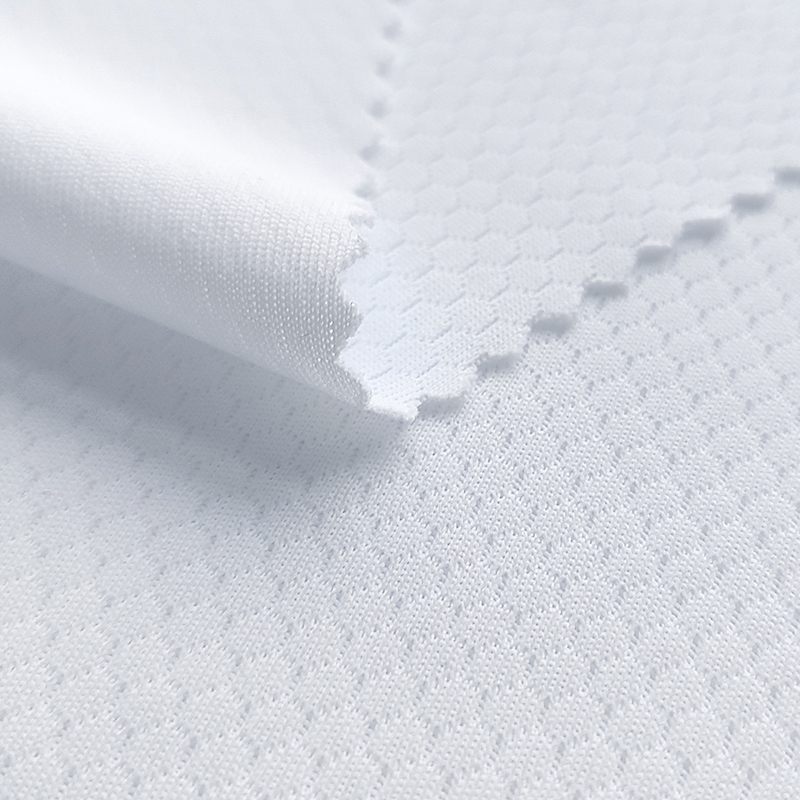
Fashion: From everyday polyester fabric clothing to high-performance sportswear. Any apparel items for business, formal or casual wear can be made from polyester. From socks and underwear to suits and everyday shirts, polyester is a staple in the fashion world. In addition to 100% polyester fabrics, He can also be combined with other fabrics to make more fabric types and can be used to make anything cotton fibers. as like polyester nylon fabrics, polyester spandex fabrics, polyester mesh fabrics, 60 cotton 40 polyester fabrics, and so on. polyester fabric has endless applications in apparel.
there are the other industry that polyester fabric refer to;
1. Home Textiles: Polyester fabric is widely used in home textiles for various purposes due to its numerous beneficial properties. Here are some common applications of polyester fabric in home textiles. Such as the Bedding: bed sheets(pillowcases, comforters, and blankets),
Curtains and Drapes, Table Linens, Rugs and Carpets.
2. Industrial Applications: The fabric is employed in making ropes, safety belts, and other industrial products that require strength and resilience.
3. Outdoor Gear: Polyester is favored for tents, backpacks, and outerwear because of its weather-resistant properties.
4. Bottles and Packaging: Beyond textiles, polyester (in the form of PET) is used extensively in the packaging industry, particularly for beverage bottles.
Polyester is found in several products and industries. Its durability makes it ideal for various items ranging from clothing to consumer products and industrial applications.Polyester’s versatility is reflected in its widespread use across various industries.
Caring for polyester fabric is relatively straightforward, and following these tips can help maintain its appearance and longevity:
Machine Washing: Polyester fabrics can typically be machine washed in warm water. Use a gentle cycle and mild detergent to avoid damaging the fibers. Avoid using bleach, as it can weaken polyester fabric and cause discoloration.
Cold Water Rinse: After washing, rinse polyester fabric in cold water to remove any remaining detergent and help prevent wrinkling.
Drying: Polyester fabric dries relatively quickly, either on a low heat setting in the dryer or by air drying. Avoid high heat settings, as they can cause shrinkage or damage to the fabric.
Ironing: Polyester is naturally wrinkle-resistant, but if ironing is necessary, use a low to medium heat setting. It’s best to iron polyester fabric while it’s still slightly damp or use a pressing cloth to avoid direct contact with the iron.
Storage: Store polyester garments or textiles in a cool, dry place away from direct sunlight to prevent fading and degradation of the fabric. Avoid hanging polyester items on wire hangers, as they can cause stretching or distortion.
Stain Removal: Treat stains promptly by blotting with a clean cloth and mild detergent or stain remover. Avoid rubbing, as it can push the stain deeper into the fabric. Rinse thoroughly with cold water after treating the stain.
Avoiding Abrasion: Polyester fabric can pill or develop fuzziness with repeated friction or abrasion. To minimize this, turn garments inside out before washing and avoid washing polyester items with abrasive materials like denim or garments with zippers or Velcro.
Dry Cleaning: Some polyester items, especially those with delicate embellishments or linings, may be labeled as dry clean only. Follow the care instructions on the garment’s label to avoid damaging the fabric.
By following these care tips, you can keep your polyester fabric looking its best and prolong its lifespan.
Polyester has a significant impact on various industries, especially the fashion industry, the development of polyester fabric in fashion has been marked by innovation, versatility, and adaptation to changing consumer preferences and industry trends. As technology continues to advance and sustainability becomes increasingly important, polyester will likely continue to play a significant role in the fashion landscape.
And more details can get through the article: What Is Polyester? A Complete Guide
Room 3130, Area A, 15th Floor, Comprehensive Building, Fuzhou Free Trade Zone, Fujian Province (within the Pilot Free Trade Zone)
Cotton Terry & Brushed Fleece Fabrics for Hoodies and Sweatpants
As a fabric manufacturer, our fabrics are engineered to deliver unparalleled comfort, warmth, and durability for hoodies, sweatpants, and athleisure wear. Designed for both casual and athletic use, these materials balance breathability, softness, and eco-conscious production practices.
Cotton Terry Loop:
Structure: Featuring a looped pile weave (300-400gsm), our terry fabrics trap air for thermal insulation, making them ideal for transitional seasons.
Breathability: Natural cotton fibers ensure moisture-wicking properties, keeping wearers dry during workouts or outdoor activities.
Durability: Reinforced double-needle stitching and anti-pilling finishes maintain fabric integrity after repeated washes.
Brushed Fleece :
Texture: Mechanically brushed on both sides to create a plush, velvety surface (250-350gsm), this fabric offers exceptional softness and warmth for winter wear.
Thermal Regulation: The raised fibers enhance heat retention while maintaining lightweight flexibility, perfect for layering.
Moisture Management: Cotton’s hydrophilic properties absorb sweat efficiently, while terry loops accelerate evaporation.
Eco-Friendly Options: Fabrics incorporate 30% recycled cotton (GRS-certified) or OEKO-TEX Standard 100 dyes, reducing water and chemical usage.
Design Flexibility:
Hoodies: Raglan sleeves and adjustable drawstrings accommodate dynamic movements; kangaroo pockets with brushed linings add practicality.
Sweatpants: Elastic waistbands with silicone grippers and reinforced knees ensure durability for high-intensity activities.
Athleisure Brands: Customizable designs with sublimation printing for logos or gradient patterns, catering to yoga, gym, or streetwear markets.
Retail Partnerships: White-label solutions for eco-conscious lines emphasizing organic cotton or recycled blends.
Our production adheres to OEKO-TEX Standard 100 and supports initiatives like the **+Cotton Project**, promoting sustainable farming practices in Latin America. Chlorine-free treatments extend garment lifespans, aligning with circular fashion trends.
By merging traditional craftsmanship with modern textile engineering, our cotton terry and brushed fleece fabrics empower brands to create versatile, high-quality apparel that resonates with today’s eco-aware consumers. For samples or bulk orders (MOQ: 100m), contact us to explore tailored solutions.
Engineered for modern activewear, this lightweight mini eyelet mesh fabric combines breathability with a sleek aesthetic. The ultra-fine perforations enhance airflow, making it ideal for yoga tops, running sleeves, and layered sportswear designs. Crafted from durable polyester, the fabric retains its deep black hue through washes while resisting snags and fading. OEKO-TEX® certified for skin-friendly safety, its stretchable structure ensures comfort during dynamic movements. Perfect for fashion-forward athletic apparel, it balances functionality with a subtle textured finish. Vertically integrated manufacturing guarantees color consistency and eco-conscious production processes.
Certifications: GRS, ISO 9001, OEKO-TEX. Markets: Asia, North America. Strength: End-to-end control from yarn to shipment, 72-hour rapid prototyping.
Ideal for cyclists, this lightweight fabric combines cooling nylon and spandex for breathable, all-day comfort. The four-way stretch design ensures unrestricted movement during rides or workouts, while moisture-wicking properties keep you dry. Soft, quick-drying, and odor-resistant, it maintains shape and color vibrancy through repeated use. Eco-friendly recycled options available, certified skin-safe for sensitive skin. Perfect for high-performance jerseys or activewear that demands flexibility, durability, and sustainable innovation.
Knitted fabrics are created by intermeshing loops of yarns using knitting needles. Depending on the direction in which the loops are formed, knitted fabrics may be broadly categorized into two types—warp knitted fabrics and weft knitted fabrics. By controlling the loop (stitch) geometry and density, a wide variety of knitted fabrics can be produced. Because of the looped structure, the maximum fiber volume fraction of knitted fabric composites is lower than that of the woven or braided fabric composites. Generally, weft knitted fabrics are less stable and, hence, stretch and distort more easily than warp knitted fabrics; thus they are also more formable. Owing to their looped structure, the knitted fabrics are more flexible than the woven or braided fabrics. In order to enhance the mechanical properties, straight yarns can be integrated into the knit loops. In this way, fabric can be tailored for stability in certain directions and conformability in other directions.
Address: No.111 Xinyang Village, Chengnan Industrial Zone, Chengguan Town, Youxi County, Sanming City, Fujian Province 365100, China.
Email: sale@xinweiknitting.cn
Tel: 13328699855
100% polyester rib fabric is a textured, stretchable knit featuring raised vertical ribs, ideal for collars, cuffs, and activewear due to its durable elasticity and shape retention. Known for wrinkle resistance, quick drying, and colorfastness, it offers lightweight comfort with a soft yet resilient feel. The ribbed structure enhances breathability and flexibility, making it suitable for sportswear, underwear, and casual apparel. Advanced variants may incorporate recycled polyester or functional treatments like UV resistance and flame retardancy. Machine-washable and low-maintenance, it balances performance and practicality for everyday and athletic use.
Address: No.116, Xinyang Village, Chengguan Town, Youxi County 365100 Sanming City, Fujian Province, CHINA
Email: sale@xinweiknitting.cn
Tel: 13328699855
OEKO-TEX® certified polyester fabrics with Coolmax® tech for 50% faster drying; nylon-spandex blends (4D elasticity) for yoga/gym wear; moisture-wicking polyester-spandex jerseys; jacquard knits with laser-cut breathability. GRS/Bluesign® recycled options empower eco-performance.
100% polyester fabrics deliver lightweight durability, quick-dry performance, and UV resistance, ideal for high-intensity sports like football jerseys, basketball uniforms, and moisture-wicking gymwear. Enhanced with breathable textures and GRS-certified recycled options (e.g., REPREVE®), they balance cost-efficiency with eco-compliance for mass production.
Polyester spandex fabric combines polyester's durability and moisture-wicking properties with spandex's elasticity (5–20% content) for stretchable, resilient textiles. Ideal for activewear, swimwear, and casual apparel, it offers wrinkle resistance, quick drying, and shape retention. The blend adapts to body curves, ensuring comfort and flexibility, while brushed or ribbed variations enhance warmth and softness. OEKO-TEX certified options prioritize safety, and its easy-care nature suits modern lifestyles
Nylon spandex fabric combines nylon's durability and abrasion resistance with spandex's exceptional elasticity (typically 5–20% content), offering 500–700% stretchability for body-conforming comfort. Ideal for activewear, swimwear, and outdoor gear, it ensures 4-way stretch, quick-drying performance, and shape retention. Advanced blends (e.g., 77% nylon + 23% spandex) feature double-sided elasticity, moisture-wicking properties, and anti-bacterial treatments for hygiene. Lightweight and wrinkle-resistant, it supports seamless designs in yoga pants, cycling shorts, and compression wear. OEKO-TEX certified options prioritize safety, while recycled nylon innovations enhance sustainability
Jacquard fabric, originating from Joseph Marie Jacquard’s 1804 loom invention, features intricate woven patterns integrated directly into the material during production, distinguishing it from printed textiles. Known for durability and reversible designs, it uses natural or synthetic fibers like silk, cotton, or polyester. Modern advancements include digital looms for customizable patterns and eco-friendly practices like organic dyes. Widely used in luxury fashion, home décor, and smart textiles, its versatility spans traditional brocades to innovative UV-resistant or temperature-responsive fabrics. A hallmark of craftsmanship, it blends heritage with cutting-edge technology.
As a vertically integrated textile manufacturer, we specialize in producing high-performance fabrics through a streamlined 9-step process:
Recycled fabric is eco-friendly textile made from reprocessed materials like plastic bottles, discarded garments, or industrial waste. Common types include recycled polyester (RPET) and recycled cellulose fabrics (e.g., cotton/linen blends). It reduces reliance on virgin resources, cuts CO₂ emissions (e.g., 4.2 tons saved per ton of RPET), and minimizes landfill waste. Key applications: activewear, outdoor gear, workwear, and eco-bags. Certifications like GRS and OEKO-TEX® validate sustainability. Challenges include higher production costs and limited durability, but innovations (e.g., chemical recycling) enhance quality. A cornerstone of circular fashion.
Recycled Polyester Cotton Blend Fabric combines recycled PET (from plastic bottles) and cotton fibers, offering sustainability and functionality for casual T-shirts. It reduces environmental impact by repurposing waste, lowering CO2 emissions and water usage. The blend (e.g., 65% polyester, 35% cotton) balances breathability, softness, and durability, ideal for daily wear. Its moisture-wicking properties and wrinkle resistance enhance comfort, while recycled components meet eco-certifications like OEKO-TEX. Brands like Zara use such fabrics, proving its viability in stylish, eco-conscious apparel. This fabric supports circular fashion, aligning with global sustainability goals.
Engineered with REPREVE recycled ocean plastics, this high-elasticity polyester fabric offers multidirectional stretch for unrestricted athletic movement. Textured knit structure ensures shape retention and resists deformation during dynamic sports. Quick-dry properties and breathable airflow support prolonged wear in high-intensity conditions. Chlorine/saltwater-resistant fibers maintain durability, while eco-conscious material aligns with sustainable apparel goals. Optimized for performance polo shirts requiring lightweight flexibility and reduced environmental footprint.
GRS-certified recycled polyester fabric engineered for rapid moisture dispersion and breathability in high-intensity sports. Interlock-knit structure balances lightweight flexibility with abrasion resistance, maintaining shape during dynamic movements. Chlorine/saltwater-resistant fibers ensure durability in harsh conditions. Optimized for soccer/cycling jerseys requiring quick-dry performance, eco-conscious materials, and long-term wear resilience without compromising athletic mobility.
Interlock-knit fabric combining GRS-certified recycled polyester with spandex for elasticity and reduced environmental impact. Durable construction resists pilling and deformation during high-intensity activities, while interlock weave enhances breathability and moisture management. Chlorine/saltwater-resistant fibers ensure longevity in active environments. OEKO-TEX certified dyes and processes guarantee skin-safe wear. Designed for performance sportswear prioritizing sustainability without compromising stretch resilience or structural integrity.
Fabric engineered with recycled polyester (GRS-certified post-consumer sources) for reduced environmental impact. Chlorine-resistant fibers maintain elasticity and colorfastness in pool/saltwater environments. UPF 50+ protection integrated at fiber level, paired with a quick-drying, abrasion-resistant knit. Four-way stretch ensures mobility, while OEKO-TEX certified dyes guarantee skin safety. Designed for sustainable swimwear combining eco-conscious materials with performance durability.
Blended fabric merging recycled polyester (post-consumer PET sources) with bamboo-derived viscose for reduced environmental impact. Bamboo fibers provide natural antibacterial properties and biodegradability, while recycled polyester ensures durability and reduced resource consumption. OEKO-TEX certified for safety, with a soft hand feel and breathable knit structure. Suitable for eco-conscious apparel brands prioritizing circular textile economy and low-carbon production.
Recycled fabric is pivotal to sustainable fashion’s future due to its transformative environmental, economic, and social benefits. Here’s why:
Function Fabric refers to specialized textiles engineered for high-performance applications, integrating advanced features like moisture-wicking , UV resistance , 4-way stretch , and eco-friendly materials (e.g., recycled polyester , ocean-recycled nylon ). Designed for sportswear, outdoor gear, and technical apparel, these fabrics prioritize durability, comfort, and sustainability, often certified by standards like GRS . Innovations include quick-dry technology , waterproof-breathable laminates , and antibacterial treatments . Used in cycling jerseys, swimwear, and activewear, they balance functionality with environmental responsibility, addressing demands for both performance and reduced ecological impact .
Dry Fit is a high-performance synthetic fabric engineered for rapid moisture-wicking and quick-drying, primarily used in sportswear and outdoor apparel. Composed of polyester or nylon blended with spandex, its hydrophobic fibers create capillary action to pull sweat away from the skin, accelerating evaporation. Innovations like Nike’s Dri-FIT technology utilize microporous structures for breathability and lightweight comfort, ideal for running, yoga, or cycling. Unlike cotton, Dry Fit minimizes chafing, retains shape during intense activity, and often integrates UV resistance or antimicrobial treatments. Brands like Columbia and The North Face enhance it with coatings (e.g., Omni-Tech) for weatherproof versatility
UPF50+ fabric blocks over 98% of harmful UV rays (UVA/UVB), ideal for prolonged outdoor activities. Made frompolyester or nylon blendswith dense weaves, it combinesnatural UV resistance with lightweight breathability. Advanced treatments like TiO₂/ZnO coatingsor UV-absorbent finishes enhance protection without compromising airflow. Its quick-drying,abrasion-resistant properties suit high-intensity sports(e.g., surfing, hiking), while flatlock seams and multi-panel designs ensure flexibility. Certified under standards like GB/T 18830and AATCC 183, UPF50+ balances sun safety with performance durability.
Anti-bacterial fabric is a specialized textile designed to inhibit or eliminate harmful microorganisms (e.g., bacteria, fungi) through chemical, physical, or biological mechanisms. It prevents bacterial growth, reduces odors, and enhances hygiene, making it ideal for medical, sportswear, and daily-use applications
Cooling fabrics achieve thermal regulation through moisture-wicking, radiation, and evaporation. Advanced materials like PP/POE@ZnO microfibers use porous structures to reflect >90% solar radiation and emit heat via infrared, enabling daytime radiative cooling. CoolMax employs micro-grooved fibers to rapidly wick sweat, enhancing evaporative cooling (5× faster drying than cotton). Hybrid designs integrate phase-change materials (e.g., graphene) or bio-based membranes for dynamic heat absorption. Breathable, waterproof layers (e.g., 2.5-layer laminates) balance airflow and durability. Sustainable innovations include fluorine-free DWR coatings and recycled polymers. Certifications like OEKO-TEX® ensure safety and performance. Ideal for sportswear and outdoor gear.
Function fabrics are revolutionizing outdoor and sportswear by merging advanced material science with user-centric design. Here’s how they elevate performance across critical dimensions:
Our cotton fabric portfolio combines innovation and sustainability, offering versatile solutions for diverse needs. Organic cotton prioritizes eco-friendly cultivation, while artificial cotton (e.g., rayon blends) enhances affordability and softness. Cotton-bamboo charcoal integrates natural odor resistance, ideal for activewear. Cotton-polyester blends balance durability and wrinkle resistance, whereas 100% cotton delivers breathability and comfort. Cotton-spandex nylon spandex ensures stretchability for form-fitting apparel. Tencel-cotton and Modal-cotton blends elevate softness and moisture-wicking, aligning with luxury and performance demands. Each variant adheres to rigorous quality standards, from OEKO-TEX certifications to advanced finishes, ensuring functionality across fashion, sportswear, and home textiles.
100% cotton fabric is a natural fiber textile made solely from cotton plants, prized for its breathability, softness, and hypoallergenic properties. It excels in moisture absorption, making it ideal for sensitive skin and hot climates. However, it wrinkles easily, shrinks if improperly washed, and lacks elasticity. Common in apparel (T-shirts, underwear), bedding, and medical textiles, it ensures comfort and durability. Eco-friendly options feature OEKO-TEX® certification for chemical safety. To maintain quality, avoid hot water and prolonged soaking during washing
Cotton spandex is a blended fabric combining natural cotton (typically 95-98%) with spandex/elastane (2-5%). It merges cotton’s breathability, softness, and hypoallergenic properties with spandex’s high elasticity (stretches 5-8x). Ideal for activewear (jogging suits, yoga pants), casual apparel (T-shirts, jeans), and workwear (jackets), it ensures comfort and freedom of movement. The fabric resists wrinkles and wicks moisture efficiently, though it may pill or shrink if improperly washed. Advanced versions integrate MXene coatings for smart wearables or organic cotton for eco-conscious production. A versatile choice balancing durability and adaptability across climates and activities
Cotton Polyester is a blended fabric combining cotton (natural breathability) and polyester (synthetic durability). Common blends include TC (≥65% polyester, ideal for wrinkle-resistant uniforms/industrial fabrics) and CVC (≥65% cotton, prioritizing softness for casualwear/medical textiles). Benefits: durability, cost-effectiveness, and easy care (quick-drying, shrink-resistant). Drawbacks: lower moisture-wicking vs. pure cotton, static buildup, and pilling. Used widely in apparel (T-shirts, jeans), home textiles, and workwear for balanced comfort and resilience.
Cotton bamboo is a blended textile combining natural cotton with bamboo-derived fibers (via mechanical/chemical processing). Known for breathability and moisture-wicking (3.5x faster than cotton), it regulates temperature and resists odors due to bamboo’s natural antimicrobial agent, “Bamboo Kun”. Soft, hypoallergenic, and UV-resistant, it’s ideal for undergarments, activewear, and bedding. Eco-friendly: bamboo grows rapidly with minimal water, and the fabric biodegrades naturally. Blends (e.g., 95% cotton + 5% bamboo) enhance durability while maintaining comfort. Certified options (e.g., OEKO-TEX®) ensure safety
Cotton is a natural plant-based fiber derived from the seed hairs of the cotton plant (Gossypium species). It has been cultivated for millennia, with origins traced to ancient India and Mesoamerica .
Cotton is generally considered high-quality for clothing due to its natural properties and versatility, but its quality depends on factors like fiber type, processing, and blend ratios. Here's a detailed benefits of cotton for clothing:
Explore our performance-driven apparel engineered for every sport: From chlorine-resistant swimwear with UPF50+ protection to moisture-wicking football/basketball jerseys featuring dry fit inspired breathability . Yoga leggings and bras prioritize 4-way stretch for unrestricted movement, while cycling wear integrates compression zones. Our GRS-certified hoodies and joggers blend eco-conscious materials with thermal regulation, complemented by casual tees using odor-control fabric. Certified OEKO-TEX and ISO compliant, each category delivers sport-specific functionality without compromising style—aligning with our "Quality First, Excellence Always" ethos for global athletes.
East Xinwei Textile pioneers high-performance sustainable fabrics for sportswear brands. Specializing in GRS-certified recycled polyester, OEKO-TEX® compliant nylon-spandex blends, and GOTS organic cotton, we engineer fabrics that merge eco-conscious innovation with athletic excellence. Our UPF50+ swimwear materials resist 200+ chlorine hours, while 4D-stretch yoga fabrics endure 10,000+ motion cycles. Advanced tech like graphene thermoregulation and phase-change microcapsules powers functional textiles for cycling, hiking, and competitive sports. Partnering with SGS-certified labs, we deliver AAATCC/ISO-tested durability, transforming 8M+ plastic bottles annually into premium activewear. Redefining sportswear sustainability, one thread at a time.
We are a diversified enterprises, we have knitting factory, dyeing factory and import & export trading company.
we are located in Sanming city, Fujian Province, welcome to visit our factory!
Knitting Factory: Fujian East Xinwei Textile Technology Co.,Ltd.
Dyeing Factory: Fujian Naqi Textile Technology Co., Ltd.
Trading Company: Fuzhou Fangtuosi Textile Materials Ltd.
Sure! We can provide A4 size sample, You just need to pay some shipping cost. Please send your address and phone number to me, I will help you to check the cost for it. If you need some meter samples, please let me know!
For some type, we have color cards. and we usually custom the color based on Pantone color number or physical color sample, we will make lab-dip ( small color sample, size: 5*5cm) for each color.
Pls pick up the Pantone color number from it, Pantone website :
https://connect.pantone.com/#/picker?pantoneBook=pantoneFhCottonTcx
Usually MOQ is 500KG/type, If lower than the MOQ, we can help you to do smaller quantity, Just need to charge some extra cost.
We have OEKO-TEX, GRS, ISO, SGS certificates etc.
Usually: T/T, 30% deposit paid before production, 70% balance paid before shipping.
Partner with Fujian East Xinwei Textile for premium sportswear and sustainable fabrics. Contact us today to customize your textile solutions with quality, innovation, and reliability you can trust.
The page you're looking for couldn't be found.
It looks like this was the result of either a mistyped address or an out-of-date bookmark.
East Xinwei is an advanced clothing fabric manufacturer. We specialized in producing heated gear including sportswear fabric, recycled fabric, as well as function fabric. Welcome to click the left or the below to find more that you may be interested in.
This website collects information from our users at several different points on our website in order to process reservations and better serve you with pertinent information. This website is the sole owner of the information collected on this site. We will not sell, share, or rent this information to any outside parties, except as outlined in this policy. Information collected includes name, shipping address, billing address, telephone numbers, e-mail address, and payment information such as credit card. Your username and password are to remain confidential and you should not share this information with anyone. This page Privacy and Security Policy is part of this Agreement, and you agree that the use of data as described in the Privacy and Security Policy is not an actionable breach of your privacy or publicity rights. These website information practices are further described in its Privacy and Security Policy.
East Xinwei is an advanced clothing fabric manufacturer. We specialized in producing heated gear including sportswear fabric, recycled fabric, as well as function fabric. Welcome to click the left or the below to find more that you may be interested in.